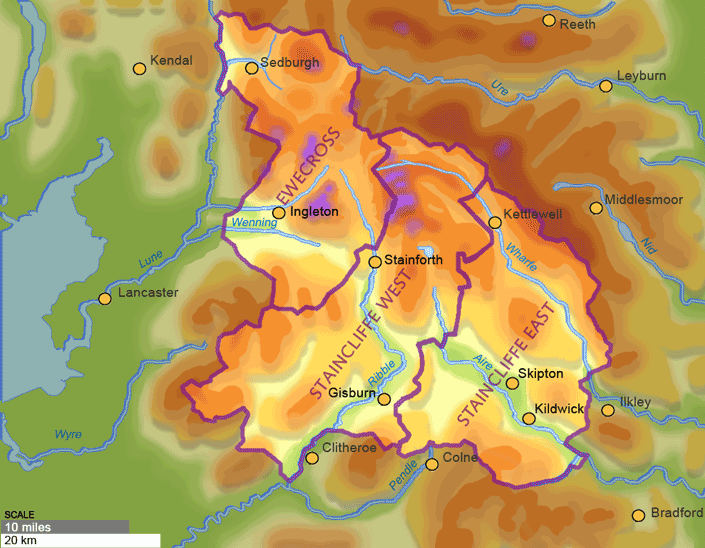 |
The Hissem-Montague Family  |
 |
The Hissem-Montague Family  |

While I believe that the Hissem family of America got their surname while residing in the village of Heysham, in Lancashire, the connection to northern England that I can prove is to the East Yorkshire family of Heesom [Hi Nicolette!].
| When Did Our Family First Come to Yorkshire?
This period covered the era of the Rhenish Bell Beaker people and their migration into Britain that replaced some 90% of the island's male population. These people, named for their inverted-bell shaped drinking vessels, settled at several points, including East Yorkshire. So, it is conceivable that our family is original to Yorkshire. I don't think, however, that necessarily blows up my theory of migration through or from the village of Heysham, in Lancashire. A 2016 study, "Beaker People in Britain" by Pearson, et al, claimed to find evidence of "a considerable degree of mobility between childhood and death, most probably within Britain. The strontium isotope results show that almost a third of the sampled population were buried in a geological region different to that in which they grew up."
It should be noted that the great majority of the Bell Beaker people were not members of the Hissem/Heesom G2a haplogroup. However, Bell Beaker sites, such as those excavated in Mokrin, in northeastern Serbia, the Lech valley of Bavaria, and Ciry-Salsogne, in northern France, include a minority of G2a people that were probably remnants of the previous Neolithic culture. I have assumed the same would be found with the Bell Beaker in England, though there is, so far, no evidence of this. |
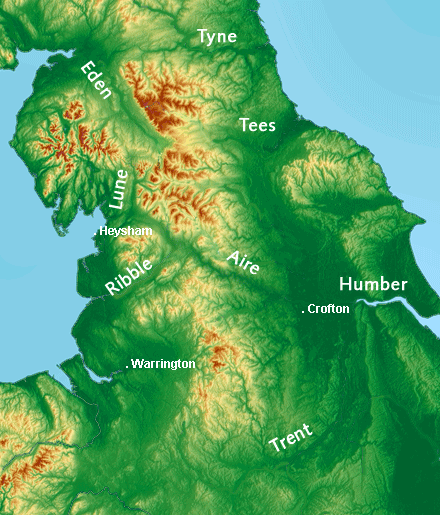
The unresolved question is the relationship, if any, between the Heesoms of East Yorkshire, those of Cheshire/South Lancashire, and the Heyshams of Lancaster. It seems probable to me that they are cousins, but I've found no point where their descents merge. By the mid-16th century, when records first become available, there were already multiple households in Cheshire, at Frodsham and Northwich, and in Yorkshire, at Barnsley and Royston, in addition to the Heysham line in Lancaster. This argues that the families had been settled in their respective shires for a couple of generations at least, arriving no later than, say, the mid-15th century. That being the case, only DNA analysis can resolve the degree of kinship.
GeographyOne of the things I'm trying to understand right now is how geography, climate and ecomonics affected internal migration, and the splits in the family just mentioned. The Pennine mountains, often called the backbone of the northern England, create a formidable barrier to east-west movement. I'm only at the beginning of this research, but it seems to me that the geography of the Yorkshire Dales, to the north, and the Peaks District, to the south, funneled eastward migration out of Heysham/Lancaster into the Bradford/Leeds region where the ancestors of the East Yorkshire family arose. Crofton was the home of John Heesom, the emigrant to America from whom my family is descended. Migration south was similarly funneled into the Cheshire Plain. The Heesoms of Cheshire are focused today around the town of Warrington.
The map to the right shows the limited east-west routes across northern England. In the north, the Tyne Gap identifies the valley between the northern Pennine mountains and the Scottish uplands. This is where the Roman's built their great wall. The next passage available, through a valley between the southern and northern Pennine mountain range, is the Aire Gap. It is a wide break in hills near Skipton at the southern edge of the Yorkshire Dales. The River Aire flows down the eastern side of the gap, while the Ribble drops down on the western side. In the Gap, a traveller need not climb above 558 feet following the Aire Gap through Craven from the River Ribble to the Vale of York. The Liverpool to Leeds canal uses this route. The next easily navigated passage east is not available until the Trent river basin in Derbyshire.
"The Aire Gap was of great topographic significance for the historic North of England for it provides a low-altitude pass through "the backbone of England". It was the Pennine transport corridor from Cumbria and Strathclyde to the Vale of York. Even Neolithic long-distance trade is proved by many finds of stone axes from central Cumbria . . . A Pennine traverser does not have to climb above 558ft following the river Aire . . . to the river Lune." - from WikipediaAnd the fact that the easiest route east from Lancaster is in the north leads me to believe that the family split at Lancaster, during the Medieval, then moved separately into Yorkshire and Cheshire. That is, the Yorkshire family are cousins, not descendents of, the Cheshire line.
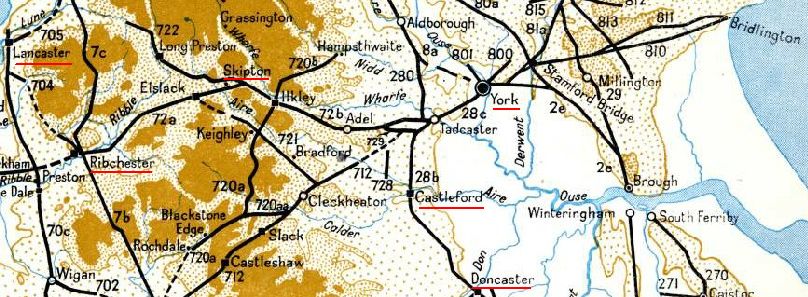 Here's another conjecture, a slight variation on the above: There was a paved Roman road from Lancaster to Ribchester, in the Ribble river valley, and another from there to York. The road to York went through the Aire pass at Skipton, then through today's Leeds. Before reaching York, just west of Tadcaster, another road crossed the York road, heading south to London and north to the wall. Going south, it crossed a ford of the Aire river at today's Castleford, where the Roman fort of Lagentium was sited, then on to Doncaster, where the Roman fort Danum guarded the crossing of the Don river. The map to the left shows the known and suspected Roman roads in northern England. Castleford is just 3 or 4 miles north of the Crofton/Ackworth villages where the Heesom family is found in the 17th century. A Roman milestone associated with the road was found near Sandy Gate lane, at the northeastern corner of Ackworth parish. Sounds like an easy route to take circa 1400 AD. A well preserved example of a Roman road exists at Blackstone Edge, on the Lancashire-West Yorkshire border, see below. It's no super-highway, but it would have provided a clear, straight path through the most manageable terrain into Yorkshire.
Here's another conjecture, a slight variation on the above: There was a paved Roman road from Lancaster to Ribchester, in the Ribble river valley, and another from there to York. The road to York went through the Aire pass at Skipton, then through today's Leeds. Before reaching York, just west of Tadcaster, another road crossed the York road, heading south to London and north to the wall. Going south, it crossed a ford of the Aire river at today's Castleford, where the Roman fort of Lagentium was sited, then on to Doncaster, where the Roman fort Danum guarded the crossing of the Don river. The map to the left shows the known and suspected Roman roads in northern England. Castleford is just 3 or 4 miles north of the Crofton/Ackworth villages where the Heesom family is found in the 17th century. A Roman milestone associated with the road was found near Sandy Gate lane, at the northeastern corner of Ackworth parish. Sounds like an easy route to take circa 1400 AD. A well preserved example of a Roman road exists at Blackstone Edge, on the Lancashire-West Yorkshire border, see below. It's no super-highway, but it would have provided a clear, straight path through the most manageable terrain into Yorkshire.
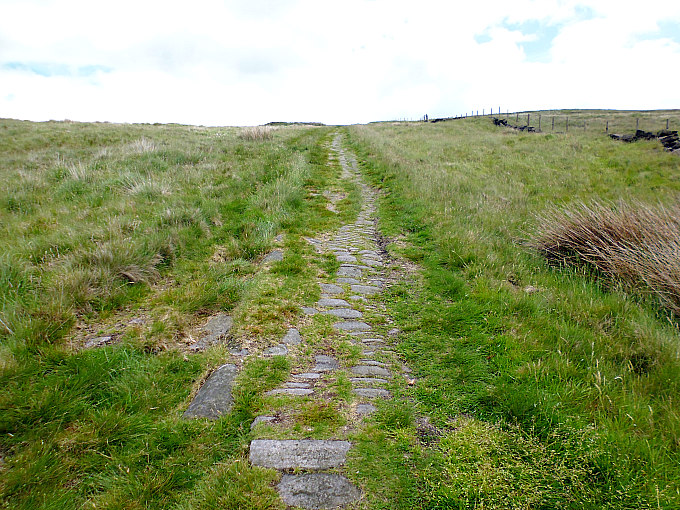
Another aspect of geography to be considered is the nature of the ground at the southern end of the Vale of York, or what is known as Humberhead. This whole region had been a vast waterlogged terrain of small trees and shrubs fed by rivers from the north and tidal flow from the Humber estuary. In the map of Roman roads, above, see the large blank area just east of Castleford. It may be that the Heesoms settled along a line from Barnsley to Pontefract because that was the limit of dry land. The wetlands only began to be drained during the Norman period through a system of ditches and embankments. This opening of new lands would have induced farmers to move east, especially those that lived on poor land, like that in Lancashire.
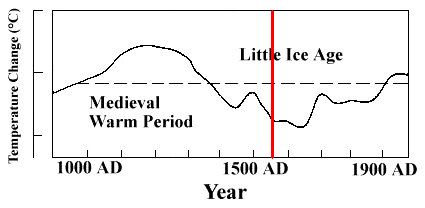
We've already discussed the climate change early in the 14th century that resulted in colder winters and adversely impacted the carrying capacity of the land. The centuries-long Little Ice Age pushed people out of marginal lands in the north into the warmer regions to the south, and the economically more advanced regions to the east. The Heesom family of Yorkshire came into the records about 200 years later, in about 1550.
The increase in border raiding by the Scots during this period should not be underestimated in forcing the populace to flee south. People on the move were pulled into the emerging urban zones by an economic inflation, starting in the second half of the 15th century, that increased prices sixfold over the next 150 years. Unable to keep up, those that could moved into the emerging craft/merchantile centers where wages most closely tracked costs. Yorkshire is due east of Lancashire and would have been a magnet of migration with its great city of York, seaport of Hull, and burgeoning manufacturing industry around Leeds and Sheffield.
I've divided those who may be part of our family int the following groups.
Heyshams in the City of York
Heyshams of the West Riding
Heyshams of the East Riding
The surname of Hesham/Hesesham first appeared in York in 1349, coincident with the arrival of the Black Plague. The latter would kill between a third and a half of the population. The number of new names added to the Register of Free Men of York at this time was indicative of the ravages of the plague. The theory here is that craftsmen from Lancashire, including some from the village of Heysham, were drawn to York by the opportunity created by the death of so many of the city's resident craftsmen.
At about this time in Lancashire, Nicholas, son of Thomas de Heysham, was a witness to a grant in Over Heysham, and John de Heseham held a messuage in Middleton, south of Heysham. The difference between the family lines in Lancaster and York, is that records fail in the former for the next hundred years, while for York records are abundant. After about 1450 records also die out in York, with both coming back into history in the 1550's. However, I don't currently see the York Hesham's, who were craftsmen and merchants, as being forebears of the Barnsley/Crofton Heesom's, who were farmers.
A note on spelling: The surname and village of Heysham, no matter what their English spelling, were normally rendered in latin as Hesham. Heseham was a variant seen as a surname in York, though I have seen it used several times for the village as, "Heseham near Lancaster" and for the parish church. This spelling was also seen in Christopher Saxton's Map of Lancashire, dated 1577, and John Speed's map of 1610.

| York
The ancient city of York was founded in 71 AD by the Roman's as their administrative capital for northern Britain. It was known as Eboracum and was the birthplace of the Empereor Constantine. In the 7th century it was known as Eoferwic, the chief city of the Anglo-Saxon kingdom of Northumbria. When the Danes conquered the city in 866 they called it Jorvik. The city lies at the confluence of the Ouse and Foss rivers, at the center of the county of Yorkshire. Traditionally the city included only that area within the city walls. The area outside the walls was known as the Ainsty. Located in a flat, marshy region, the city is subject to severe flooding. The castle was a Norman motte-and-bailey fortification built in 1068. It was rebuilt on an enlarged motte after being destroyed in the anti-Jewish riot of 1190. The wooden keep blew down in a gale in 1228 and was gradually rebuilt in stone between about 1245 and 1270. The outer wall of the castle perimeter enclosed not only the motte-and-bailey but halls and other buildings. Damming of the Foss river created an additional defence on the outer perimeter, in the form of a lake. The city walls were also rebuilt in stone at this time, often on top of the old Roman walls. In 1328 Edward III had married Philippa of Hainault in the great cathedral of York Minster. By 1400 the city was at the height of its prosperity and power. The city was the seat of Edmund, a son of Edward III and the head of the nascent House of York. They famously fought John of Gaunt's House of Lancaster for supremacy and the throne in the War of the Roses. In the mid-14th century the city's population was probably between 14,000 and 15,000 making it the largest city in the north and second only to London in importance. The rapid rise of the merchant class and exansion of the craft guilds during this period overthrew the old landed patrician oligarchy of the previous centuries. See History of Medieval York for more information. |
While I believe it possible that these men were from the village of Heysham, and so were called "of Heysham" as a surname, there are a number of villages and regions in England that bear names that could be confused with Heysham. Hexham, 20 miles west of Newcastle, and Halsham, southeast of Hull, are often mistranscribed as Hesham or Hasham. I've recently begun to wonder if there's more to the story than that, however. Was Hexham sometimes purposefully written as Hesham? The old English ballad, the Battle of Flodden, relates that,
"With striplings strong from Stainmoor side,"Hesham-Leven" refers to a levy of men from Hesham. We know from dispatches of Lord Dacre that he was leading men of Tynedale and Redesdale, not Lancashire. - from "The Hawick Tradition of 1514" by R. S. Craig and Adam Laing. Also, the Battle of Hexham in 1463, during the War of the Roses, is sometimes called the Battle of Hesham.
And Austin-Moor-men marched even,
All those that Gilsland grave did hide,
With horsemen light from Hesham-Leven.
All these did march in Dacres' band,
All these ensued his banner broad
No lustier lord was in the land,
Nor more might boast of birth and blood."
The town of Horsham is sometimes rendered as Hasham or Haasham [see Samuel Haasham of Boston, Massachusetts, as an example]. Nicholas Heseham, a merchant trading with the Hanseatic League, below, had his name rendered as Hassham in at least one reference. Hailsham [Hailesham, Haylesham], further south in Sussex, may provide its own confusion.
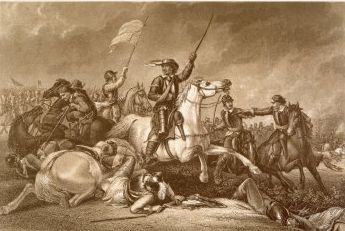 Hessam moor could be another alternative origin of the York surname. It lies 3 miles from the city of York, on the Ouse river, more frequently known today as Marston moor. A decisive battle of the English Civil War was fought there in 1643.
Hessam moor could be another alternative origin of the York surname. It lies 3 miles from the city of York, on the Ouse river, more frequently known today as Marston moor. A decisive battle of the English Civil War was fought there in 1643.
For whom was this moor named?
"A widely extended heath, called Hessam Moor, extended for upwards of six miles between Poppleton, Red-house, Monckton, and Marston." - from the "Memoirs of Prince Rupert, and the Cavaliers" edited by Eliot Warburton
". . . known in various parts of it by the names of Marston, Tockwith, Hessam, and Monkton Moors." - from "Macmillan's Magazine" edited by David Masson, George Grove, John Morley, Mowbray Walter MorrisThe moor was also known by the name Hessom in contemporary accounts of the battle, "In this time, affter the battaile of Hessom Moore, when the blessed King Charles had by treachery lost the field, . . ." I recently found it called Hesham Moor as well, in "In Memoriam, Sir. W. Bryan Cooke, Bart. of Wheatley" by William Cooke, 1852, and in "The Great and Close Siege of York, 1644" by Leslie Peter Wenham, 1970. This may more directly relate to the naming of the Hesham's and Heseham's of York.
How, I wonder, was Hessam moor pronounced? With the long e of Heesom, or the short e of Hess?
There is today a village in the vicinity named Hessay [in Domesday, Esdesai or Hesdesai], in the parish of Moor Monkton, between Poppleton, to the east, and Tockwith, to the west. Hessam itself does not appear to relate to any particular village, but may be an amalgamation of several of their names. I've also found a reference where it's called "Hessay Moor" - from "Atlas of the English Civil War" by P.R. Newman. Perhaps Hessam was a mistranscription?
Of course, I still favor the village of Heysham, in Lancashire, for the place of our surname origin. It cannot be ignored that the variations in the spelling of that village's name in the 17th century so closely match how the spelling of our surname varied in the same period. There is no such coincidence for Hexham, Hessam moor, or the village of Hessay.
I am grouping family members by occupation on the assumption that sons would take the trade of their fathers. This was not always the case, of course. Note especially that any tradesman might become a merchant of his own craft items, just as the Tailors Guild became the Merchant Tailors.

Historical Timeline: Reign of Kings
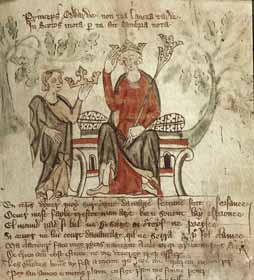 1307-1327 Edward II
1307-1327 Edward II
A weak King considered incompetent and frivolous by his father and by the people. A particularly slanderous portrait of him is given in Mel Gibson's movie "Braveheart." He was deposed and murdered by his own queen, Isabella - also known as the she-wolf of France - and her lover, Roger de Mortimer. Edward died a particularly awful death, the particulars of which are best left unstated in a "family" website. Queen Isabella was the daughter of Philip IV of France and it was through her that her son, Edward III, got his claim to the French throne that led to the disastrous Hundred Years War. Its been pointed out that one of the reasons England developed its democratic institutions was that it was rarely ruled by two good/strong kings in a row. It was during the reigns of these "incompetents" that the rising middle-class made their power grabs. 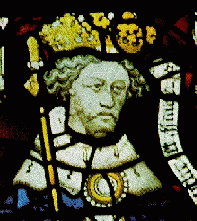 1327-1377 Edward III
1327-1377 Edward III
He was another powerful King. Because his mother was a daughter of the French King, when that throne became vacant Edward pressed his claim. Not surprisingly the French nobles could not bear the idea of an English King on their throne and, instead, picked one of their own number to take the crown. This began the 100 Years War with France. This was a turbulent era. The dawning century saw the climate begin to cool in what became known as the Little Ice Age. The growing season shortened and marginal regions could no longer support their populations. Torrential rains from 1315 to 1317 ruined the crops and created the Great Famine. The Hundred Years War began in 1337 and ran, intermittently, to 1453. This diverted the King's attention and drained his treasury. In 1348 the Black Plague reached England and killed between and third and a half of the population. |
Tailor. The following indicates that John was a Master tailor who probably ran his own shop starting at this time.
1349, 24 Edward III, The Freemen of York: "Johannes de Hesham, taillour" - from "Register of the Freemen of the City of York: From the City Records ... 1272-1759" by Francis Collins.I've assumed that John gained the franchise at the age of 30, and I do so for all those below as well. That may be on the young side. I need to do more research to ascertain whether 40, say, was a more reasonable age to become the Master of a craft.
1349 was the year that the bubonic plague reached York. It has been conjectured that so many new men were entered in the Register of Freemen at this time because the plague had wiped out so many of the older tradesmen, making room for men from the country - and perhaps from Lancashire. While I think it probable that John de Hesham of Lancaster was a descedent of the Lord of Heysham manor - he was a prominent citizen who became chief bailiff [mayor] of the town - the Hesham's/Heseham's of York could easily be ex-serfs, the plague having broken the cycle of their servitude on Heysham manor.
At this time Thomas de Dacre, Joan Gernet de Dacre's grandson, owned Heysham manor. Thomas de Hesham lived in Over Heysham. Lawrence de Hesham was the rector of Tatham, which is just east of Gressingham. David de Hesham lived in Lancaster. Geoffrey de Hesham, a couple of generations earlier than Johannes, had perhaps left descendents in the vicinity of Bath, in Somerset.
| Register of the Freemen of York
This document was recorded from 1 Edward I, 1272, to the present day. It listed the names of all the people who took up the freedom of the city. The first of six registers covers the period 1272 to 1671. It includes, in addition to the register of freemen, the officials of the city on their election to office and matters relating to the government of the city. In York a man had to be a freeman before he could trade or become a master craftsman and join one of the many guilds. The charters of the Freemen are the charters of the City of York. The first Royal Charter was dated 1154-8. Freemen are anxious that those eligible by birth, and those indentured to and who have served apprenticeships with Freemen should take up their Freedom without delay otherwise their rights may be lost. Those who can claim the privilege are proud to do so. - from "York Freemen Through the Ages" By Harry Ward. Where a man earned his freedom by patrimony, that is based on his father's status as a freeman, both the name of the son and the father are included. Where a man obtained his freedom by purchase, or servitude as an apprentice, the price is shown. Note that Latin and English spellings are used together. Often a man's name is rendered in Latin while his occupation is in English. Frequently a man's name is rendered in English while his father's is in Latin. Freedom of the CityAnyone, man or woman, who wanted to carry on trade in the City was required to take up the franchise. The Freedom of the City could be obtained in three ways. First by servitude, in which the applicant would serve his full time as an apprentice before his enrollment, that is, he would first become a Master of his trade. Secondly by patrimony, in which the children of freemen could claim their freedom by their heritage. Thirdly by redemption, an order of the Mayor or Court of Aldermen obtained usually by purchase or as a reward. An oath of fealty to the King and the City was also required. Once having obtained the franchise the way was open to the highest posts of honor in the City. A man who moved to another city lost the franchise and would have to regain it, probably through purchase, if he chose to return. Guilds
Commencing in the 1370's the guilds staged performances of the York Mystery Plays, of which there were 48, detailing the Biblical story from Creation to Doomsday. The guilds were known as "mysteries," hence the name of the play cycle. Each play was presented on a pageant-wagon stage, drawn through the streets of York from one 'playing station' to the next. The Litsters [Dyers] performed "Christ's Trial before Herod," the Sporiers [Spur makers] did "Christ with the Doctors in the Temple," the Merchant Taylors did "The Ascension," and the Weavers did "Appearance of our Lady to Thomas." In 1397 they performed for the King. |
| The Effect of the Plague on a Rising Middle Class
The number of craftsmen and traders made freemen of York increased from a norm of 50 a year to 212 in 1350-51 as new freemen were created to replace the many who died. After bubonic plague's first terrible onslaught in 1349, it returned to York in 1361, 1369, 1375, 1378 and 1390. Judged from the poll tax returns, York had a population of perhaps 15,000 by the mid-14th century, making it larger than other regional cities like Bristol, Coventry and Norwich. After the Black Death this figure could have dropped to fewer than 10,000. York's appallingly high mortality rate meant it was reliant on the immigrants from the surrounding countryside to survive. Might sons of the Heysham's of Lancaster line, or common laborers of the village of Heysham, have emigrated to York, lured by the opportunities of the larger, more vibrant city, and by the openings in the trades caused by the plague? |
Tailor. Edmund may be the son of John de Hesham. The dates work well enough and they share the same trade as tailors, however Edmund did not earn his Freedom by patrimony making this relationship uncertain.
1386, 9 Richard II, The Freemen of York: "Edmundus de Hesham, taillour" - from "Register of the Freemen of the City of York: From the City Records ... 1272-1759" by Francis Collins.The following may be the same man, this time using the Heysham spelling of the surname.
1411, 13 Henry IV, The Freemen of York: "Ed. Heysham, taillour" - from "Register of the Freemen of the City of York: From the City Records ... 1272-1759" by Francis Collins.
An Edmund Heceham [sic] was in a List of Persons in the York Bridgemasters' Accounts, meaning, I think, that he was a bridgemaster, an official of the city. This position was a stepping stone to more important offices, see below. Heceham may more accurately be considered a variant of Hexham. Edmund and his brother Adam Heceham are shown below in a document of 1415-1416 dealing with the Ouse [Use] river bridge.
"Recordum seisine Leverton.Robert Dunnyng was also in a list with (11) Adam de Hesham (c1355).
Universis Christi fidelibus presentes literas inspecturis vel audituris, Johannes Northeby, niaior civitatis Ebor', salutem in Domino. Noverit universitas vestra quod decimo die mensis Februarii, anno regni regis nunc tercio (1415-16), venerunt in camera consilii super pontem Use in civitate predicta, domini Kobertus Dalby, Kobertus Gammyll, Willelmus de Burton, capellani, necnon Rogerus de Burton, clericus communis dicte civitatis, Johannes Axiholme, Thomas Wardale, glover, Johannes Hebbe, saddler, Ricardus Bradeshagh, Edmundus Heceham, Thomas Carleton, Johannes (fo. 179, b.) Clegg, Robertus Dunnyng, Thomas Barbour, Willelmus Brukeshagh, Thomas Greteham et Johannes Munckgate, cives Ebor', et expresse ibidem recognoverunt et dixerunt quod personaliter presentes, videntes et audientes fuerunt sextodecimo die mensis Januarii, anno regni regis predicto, unacum multis aliis quando Johannes Boydon de Ebor', coureour, et Katerina uxor sua, consanguinea et heres Johannis Stokton, quondam civis Ebor', in bona et sana memoria existentes, liberarunt et dederunt possessionem et seisinam Thome Lyverton et Ade Heceham, civibus Ebor', unius mesuagii cum tribus shoppis et solariis supra edificatis in fronte ejusdem mesuagii cum suis pertinenciis in Walmegate, in parochia Sancti Dionisii in Ebor'" - from the "York Memorandum Book"
A Ralph Hornby of the city of York died in 17 October 1378. Later a writ mandamus was issued to correct an abuse of discretion in the handling of his estate. An inquisition post mortem was held on 13 October 1428 by 16 jurors,
"Jurors: William Hoveden, vynter; John Bowland, mercer; William Holbek, mercer; Richard Stowe, vynter; Robert Thresk, Walker; Richard Neuland, draper; Edmund Heseham, taillour; William Jonson, Walker; John Huthwayt, taillour; John Chaumbr, senior ; Thomas Forester, taillour; John Dalton, skynner; Robert Holderness, lytster; Thomas Welburn, Baker; John Salter, Barker; and William Kendale, lytster." - from Mapping the Medieval CountrysideRalph Hornby had held 34 messuages, a tenement, and an advowson in York. The jurors found that these estates should revert to "Sir William Lax, vicar of Hornsea in Holderness. He and no other is Ralph's kin and right heir as the son of Thomas son of Robert older brother of Ralph." The escheator was William Bowes.
1430. "County: York, Case Type: debt, Plaintiff: Neusom, John, esq, executors of; (Clervaux, John, of York, knight & sheriff; Margaret, his wife, formerly wife of Testator), Defendant: Heseham, Edmund, of York, tailor; Heseham, John, of Kyngeston upon Hull, Yorks, merchant" - from Henry VI, 1430: CP40no677, by Rosemary Simons
The following may be our Edmund, though quite old at this time, though the phrase "lately in the tenure of" may imply Edmund's death.
1435. "Account of William Abyrford and John Watton wardens of Use [Ouse] Bridge in the time of Thomas Kirkeham mayor of the City of York of all receipts, fines and rents of the said city appertaining to the said bridge. And for all repayments, payments outlays and expenses made thereon from the feast of the Purification of the Blessed Virgin Mary, in the thirteenth year of the reign of Henry the sixth after the conquest of England until the same feast in the following year for one whole year.Walmegate was a ward in the parish of St. Dionysius, in York. The street of Walmgate still exists, an eastern continuation of Fossgate, but which lies entirely on the east side side of the River Foss; see also the map above of medieval York. The main medieval features in Walmgate were St Deny's Church, St Margaret's church and Walmgate Bar. The Walmgate Bar, below, is the most easterly gateway into York.
RECEIPTS.
. . .
Walmegate Fysshergate.
. . .
And for a tenement on the corner opposite the Church of Saint Denys lately in the tenure of Edmund Heceham for the aforesaid terms this year [Sum of money faded]." - from the "York Bridgemaster's Accounts"
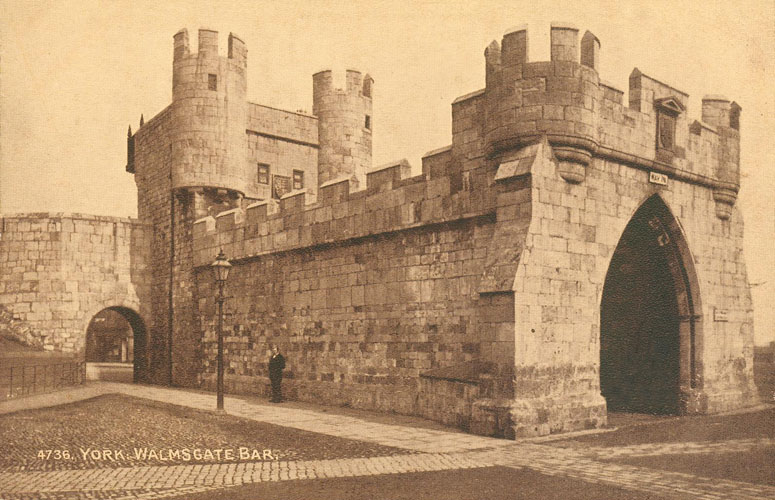
1437. "Account of John Whyryg and Richard Robynson [the Freemen's Register has Richard Chapman as the second bridgemaster; YCA, Register of Admissions to the Freedom of the City, D1, fo.323 recto] wardens of Use Bridge in the time of William Bedale mayor of the City of York for all receipts, farms and rents of the said city appertaining to the said bridge . And for all repayments, payments, outlays and expenses made thereon from the feast of the Purification of the Blessed Virgin Mary in the fifteenth year of the reign of King Henry the sixth after the conquest of England until the same feast in the following year for one whole year.
RECEIPTS.
. . .
Walmegate. Also they respond for a vennel of Holy Trinity in Walmegate by [Dominus] William Ottelay, Chaplain, for the aforesaid terms this year 2s.
And for a tenement on the corner of the church of Saint Denys lately in the tenure of Edmund Heceham for the aforesaid terms this year 2d." - from the "York Bridgemaster's Accounts"
| A Scarborough Stray
Johanni Hesham (c1368) From the will of Johannis Wawan, a "burgensis villae de Scarbebourgh", made on "Secundo dei mensis Septembris, Anno Domini MCCCXCVIII [1398]" "Item do et lego Johanni Hesham servienti meo unum gardinum cum pertinentiis, jacentem in le Tollergate in Scardebourgh."Tollergate is a street in the old town of Scarborough, which is on the North Sea coast of North Yorkshire. |
Historical Timeline: Reign of Kings
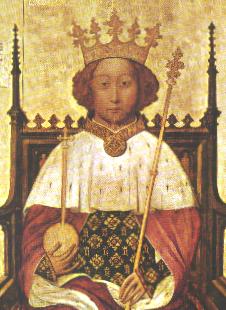 1377-1399 King Richard II
1377-1399 King Richard II
He was the son of the Black Prince, who had predeceased his father, Edward III. His frivolous manners reminded too many of Edward II. The 100 Years War continued, but at a slackened pace. In 1377 a census of principal towns in the kingdom was taken. No Lancashire towns were shown. The census stated, "that Lancashire contains no town thought worthy of particular mention." That probably meant that Lancaster's population had fallen below 800 by this time. In 1381 John of Gaunt, the Duke of Lancaster and the King's uncle, advised him to triple the tax. Watt Tyler led 60,000 people in a 'Peasants' Revolt'. Rebels converged on London and pillaged the Savoy palace, John of Gaunt's London home. The Mayor of London killed Watt Tyler, below, when he becomes abusive in a confrontation with the young King and the Rebellion collapsed. 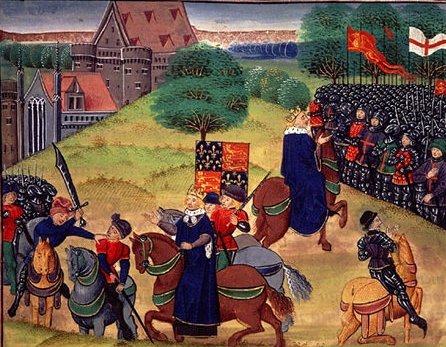 Richard was deposed by his cousin, Henry Bolingbroke, in 1399. |
Tailor. There are references to an Edward and Edmund Heseham, which I have treated as one man; they may in fact be two. Note that both men, if there were two, were involved with the Fosse river bridge while the Edmundus de Hesham, above, was associated with the Ouse river bridge. Edward had a wife, Emma.
23 Henry VI, 1445. John Coupland, tanner, and John Dale, sauce-maker, wardens.
"FOSSE BRIDGE:
. . .
And for 15s. for the farm of a tenement hence demised to Edward Heseham at the same terms [for the Pentecost and Martinmas terms this year]
. . .
Expenses of Houses:
. . .
And for a modius of plaster worked in the camera of Dominus Richard Kyghley, chaplain, Thomas Henrison and Edward Heseham 6d.
. . .
And paid for repair of two hearths in the tenement of Robert Stodeley and Edward Heseham with stone 7d."
"FOSSE BRIDGE. And for Emma Heseham for the sixth tenement there for the aforesaid terms 15s."
1447. "Roll containing the descent and alliances of the families of Brus, Fauconberg, Perehay, Saxron and Darcy (18th century); on the reverse of the roll is: "The account of Edmund Hesham and John Fissher, collector of the rents and keeper of the Bridge of Fosse, 25-26 Hen. VI." - from Rools, 6, "Calendar of Charters and Rolls Preserved in Bodleian Library."
The will of an "Heseham, Edmund, York, tailliour, Oct. 20, 1463" has a date of (? 1463) in Vol. 2 Fol. 591 of the "Index of Wills in the York Registry A.D. 1389 to 1514" by Francis Collins, E. W. (Ely Wilkinson) Crossley.
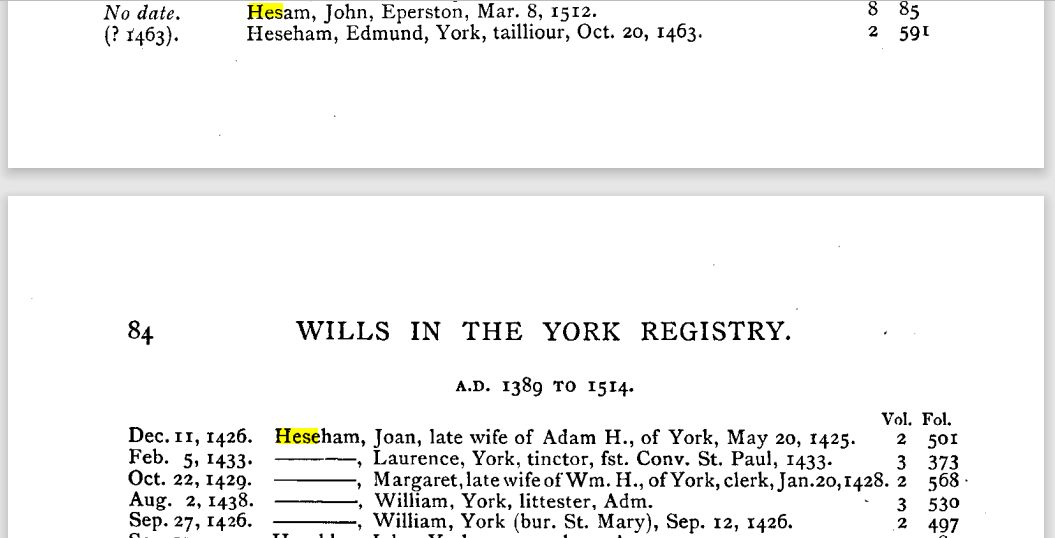
Historical Timeline: Reign of Kings - House of Lancaster
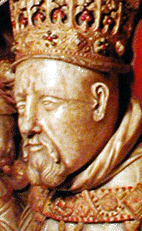 1399-1413 Henry IV
1399-1413 Henry IV
He was called Henry Bolingbroke, for the place of his birth. The son of John of Gaunt, the Duke of Lancaster. He rebelled against Richard II when the King attempted to seize his inheritance upon John of Gaunt's death. The 100 Years War in France continued, but Henry was forced to spend all of his energies holding on to his throne. Richard II's supporters revolted upon his deposition in 1400. In Wales, Owen Glendower led a national uprising that lasted until 1408. The Scots waged continual warfare throughout the reign. The powerful families of Percy and Mortimer, who possessed a stronger claim to the throne than Henry himself, revolted from 1403 to 1408. Richard Scrope, Archbishop of York, proclaimed his opposition to the Lancastrian claim in 1405. |
Tailor. 1432-3, 12 Henry VI, The Freemen of York: "Johannes Heceham [sic], taillour" - from "Register of the Freemen of the City of York: From the City Records ... 1272-1759" by Francis Collins.
The will of a John Hesam, of Eperston, with no date, is in Vol. 8 Fol. 85 of the "Index of Wills in the York Registry A.D. 1389 to 1514" by Francis Collins, E. W. (Ely Wilkinson) Crossley. There is an Epperstone in Nottinghamshire, just northeast of Nottingham.
Historical Timeline: Reign of Kings - House of Lancaster
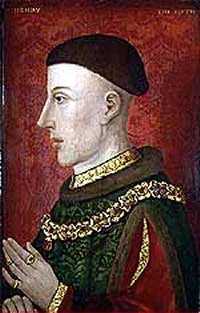 1413-1422 Henry V
1413-1422 Henry V
Living a dissipated life as a young man, as famously depicted in Shakespeare's plays Henry IV, Parts I and II, he became one of England's greatest martial Kings upon assuming the throne. He returned to France and the 100 Years War with new vigor. The victor of the battle of Agincourt in which the longbow, as at Crecy, decimated the French knighthood. Cannon finally became effective weapons, knocking downs the walls of fortified cities. Henry conquered France and married the daughter of the deposed French King, but he died young. The French King, unfortunately, was subject to fits of madness, a trait passed down to Henry's son, the new King Henry VI. |
 Or Sporrier/Spurrier, a maker of spurs.
Or Sporrier/Spurrier, a maker of spurs.
1373, 49 Edward III, The Freemen of York: "Robertus de Heseham, sporyer" - from "Register of the Freemen of the City of York: From the City Records ... 1272-1759" by Francis Collins. If Robert were related to John, above, would they necessarily have the same trade?
Dyers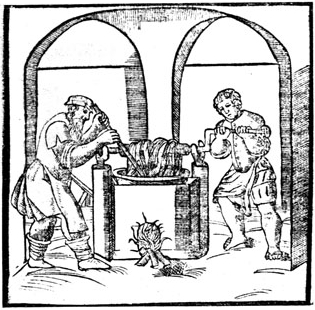 Tinctors, Litsters and Dyers were all the same trade. See Medieval Dyeing for more information. The Hesham's of this line appear to have been the most successful, prominent men of their town and giving birth to merchant adventurers in later generations.
Tinctors, Litsters and Dyers were all the same trade. See Medieval Dyeing for more information. The Hesham's of this line appear to have been the most successful, prominent men of their town and giving birth to merchant adventurers in later generations.
Dyer. I believe that (11) Laurencii Heseham (c1365), a dyer, may be a brother. Another possible member of the family, (11) Edmundus de Hesham (c1355), was a tailor.
1383-4, The Freemen of York: "Adam de Hesham, tinctor" - from "Register of the Freemen of the City of York: From the City Records ... 1272-1759" by Francis Collins.An Adam Hesham, Litster [a dyer], was a Warden of Foss Bridge, in the city of York, in 1392.
"Bond by William Wadman, merchant, Adam Heseham, John Heseham, Robert Dunnyng and John Sutton, litsters, citizens of York, to Godfrey Rust of Duredraght, merchant, for a loan of 100l, of which 50l shall be repaid on the feast of S. Peter's chains (1 August) next and 50 l, the following Martinmas . . . " - from "York Memorandum Book" by Maud Sellers, Joyce W. Percy
Adam and his brother [?], Edmund, Heceham are shown below in a document of 1415-1416 dealing with the Ouse [Use] river bridge.
"Recordum seisine Leverton.See Thomas Lyverton again, below.
Universis Christi fidelibus presentes literas inspecturis vel audituris, Johannes Northeby, niaior civitatis Ebor', salutem in Domino. Noverit universitas vestra quod decimo die mensis Februarii, anno regni regis nunc tercio (1415-16), venerunt in camera consilii super pontem Use in civitate predicta, domini Kobertus Dalby, Kobertus Gammyll, Willelmus de Burton, capellani, necnon Rogerus de Burton, clericus communis dicte civitatis, Johannes Axiholme, Thomas Wardale, glover, Johannes Hebbe, saddler, Ricardus Bradeshagh, Edmundus Heceham, Thomas Carleton, Johannes (fo. 179, b.) Clegg, Robertus Dunnyng, Thomas Barbour, Willelmus Brukeshagh, Thomas Greteham et Johannes Munckgate, cives Ebor', et expresse ibidem recognoverunt et dixerunt quod personaliter presentes, videntes et audientes fuerunt sextodecimo die mensis Januarii, anno regni regis predicto, unacum multis aliis quando Johannes Boydon de Ebor', coureour, et Katerina uxor sua, consanguinea et heres Johannis Stokton, quondam civis Ebor', in bona et sana memoria existentes, liberarunt et dederunt possessionem et seisinam Thome Lyverton et Ade Heceham, civibus Ebor', unius mesuagii cum tribus shoppis et solariis supra edificatis in fronte ejusdem mesuagii cum suis pertinenciis in Walmegate, in parochia Sancti Dionisii in Ebor'" - from the "York Memorandum Book"
I also have
". . . sheriffs of York, William Muston, Adam Heseham . . ."Also as "et Ade Heceham, civibus Ebor'."
". . . Thomas Lyverton, William Wadman, Robert Lonesdale, Adam Heseham Date: York 11 May 6 Henry V [1418] Seals 15.
Quitclaim Parties, property and witnesses as in no. 40 above Date: York, Saturday, Christmas Eve 1356 Seal 42.
Grant William de Grantham, citizen and mercer. . ." - from "Borthwick Texts and Calendars."
A year later there is another mention of William Wadman in a loan made for 100 L.
1419. "Bond by William Wadman, merchant, Adam Heseham, John Heseham, Robert Dunnyng and John Sutton, litsters, citizens of York, to Godfrey Rust of Duredraght, merchant, for a loan of 100 L, of which 50 L shall be repaid on the feast of S. Peter's Chains (1 August) next and 50 L the following Martinmas.
Seals. 15 April, 5 Henry v. (1417). Acknowledged before John de Bedale, mayor, 20 June, 1419, 7 Henry v. The bond shewn by Henry Enghebert, attorney of the said Godfrey." - from the York Memorandum Book
I have another section from the "York Memorandum Book," in Latin, which states,
"Universis Christi fidelibus presentes literas inspecturis, Johannes de Bedale, maior civitatis Ebor', Robertus Middilton et Johannes Baynbryg, vicecomites ejusdem, salutem in Domino. Mandatum domini Regis in hec verba recepimus :
(Writ of certiorari to send to the chancery, record of the following assise ; dated 1 July, 7 Henry (1419.)
Nos igitur volentes informari super veritate premissorum cepimus inquisicionem virtute brevis predict! , die Jo vis in vigilia nativitatis beate Marie Virginis, 7 Henry v. (7 September, 1419), in gilda aula dicte civitatis, per sacramentum Johannis Sharrowe, senioris, Ade Heseham, Willelmi Neuland, Henrici Dubber, Ricardi Neuland, Willelmi Semer, Willelmi Coupeland, draper, Johannis Waghen, cutler, Ricardi Broghton, Dionisii Westerdale, Johannis Huthwayt, Willelmi Coupeland, taillour, Roberti Ketyll, Johannis Coucher et Johannis Preston, bukkrmaker, qui dicunt super sacramentum suum quod Johannes de Ripon et Willelmus Tundue, in predicto brevi nominati, nuper arrainiaverunt coram Thoma Graa, nuper maiore Ebor', et Willelmo Sallaye et Johanne de Hewyk, nuper vicecomitibus ejusdem civitatis, quandam assisam frisce forcie sine brevi domini regis secundum consuetudinem dicte civitatis, versus Johannem Alkebarewe, Willelmum Wortelay, Roger Shalford, Thomam Emlaye et Willelmum de Braweby, in predicto brevi nominates, de quodam tenemento cum pertinenciis in Stayngate in Ebor', modo in tenura Roberti Chaundeler, et per eandem querelam dictum tenementum recuperaverunt. In cujus inquisicionis testimonium. tarn sigillum officii maioratus civitatis predicte quam sigilla dictorum juratorum presentibus sunt appensa. Datum apud Ebor', vij mo die Septembris, (7 Henry v.)"
The first wife of Adam Heseham was Joan whose act of charity was recorded:
" . . . women associated with cottage accommodation in Micklegate, Hamerton Lane and Rotten Row are conspicuous in the city's Ouse Bridge rentals, and in 1425 Joan Heseham bequeathed clothing to a group of eight women said to be living in the thistles ['in thystels'] next the suburb of Bootham." - from "Towns and Townspeople in the Fifteenth Century" by John A.F. ThomsonHer will:
"Dec. 11 1426 Heseham, Joan, late wife of Adam H. of Yorks, Mary 20 1425." - from the "Index of Wills in the York Registry" by Francis Collins, E. W. (Ely Wilkinson)Adam's next wife was Mary. Her will:
"Dec. 22 1436 Heseham, Mary [garbled], late wife of Adam H. of York, May 20, 1435." - Ibid"(12) John Hesham (c1380)
Dyer. 1412-13, The Freemen of York: "Johannes Heceham [sic], litster" - from "Register of the Freemen of the City of York: From the City Records ... 1272-1759" by Francis Collins. I have a John Hesham, Litster [a dyer], who was a Warden of Foss bridge, York, in 1419.
| Bridgemasters
Four bridgemasters, two for each bridge and all freemen of the city, managed these estates and were empowered to collect rents and pay for the expenses arising from these properties and the expenses of running St William's Chapel on Ouse Bridge. A survey indicates that the post of bridgemaster was attained an average of 19 years after earning the franchise, that is, it was the pinnacle of their civic career. No man could rise to the office of chamberlain or sheriff without first having been a bridgemaster. Like all official offices in those days election to this office required the individual to contribute some amount on taking up the office. When the King entered the city he was greeted by a procession, the Mayor and Aldermen in scarlet and the council, the bridgemasters, and other chief citizens in gowns of red. See York Bridgemasters' Accounts for more information. |
I also have the following reference to an otherwise unknown Hesham,
1450. "County: London, Case Type: debt, Plaintiff: Lambard, John, of London, mercer; Howell, Philip, of London, mercer, Defendant: Lov---(?), William, of Sandwich, Kent, tailor; de Clyfton, Gervase, of Hoddyshoke, Notts, knight; Byll, Thomas, of Asshewell, Herts, merchant; Hesham, John, of Pountfrett, Yorks, drover" - from Henry VI, 1450: CP40no758, by Rosemary SimonsA drover is in charge of a herd or flock of animal. (13) Willelmus Heseham (c1395)
Dyer. Possibly a son of Adam or John. 1424-5, 4 Henry VI, "Willelmus Heceham [sic], lytster" - from "Register of the Freemen of the City of York: From the City Records ... 1272-1759" by Francis Collins.
The following is a case of debt against William Heseham.
1430. "County: York, Case Type: debt, Plaintiff: Gars, Thomas, junior, of York, merchant, Defendant: Heseham, William, of York, dyer; Hudson, Richard, of Milnebek, cumbld, yeoman" - from Henry VI, 1430: CP40no677, by Rosemary SimonsI belive that Thomas Gars is the son of Thomas del Gare, below, the brother-in-law of (12) Thomas Heseham. While the latter was a merchant, he was the son of of dyer, Lawrence Heseham. I'm not sure if that has any special meaning, but it's curious.
The will of a William Heseham, York, littester [? garbled], has a date of 2 August 1436 [or 1438, hard to read] in Vol. 3 Fol. 530 of the "Index of Wills in the York Registry A.D. 1389 to 1514" by Francis Collins, E. W. (Ely Wilkinson) Crossley.
The following appear to be cases where the estate of William Heseham, as represented by his administrators, was sued for debt.
1440. "County: York, Case Type: debt, Plaintiff: Bolton, John, of York, merchant, Defendant: Heceham(?), William, of York, dyer, administrator of; (Parde, John, of York, dyer; with Richemond, John, of York, chaplain; Gyrsyngham, Thomas, of York, dyer)"(14) Willelmus Heseham (c1425)
1440. "County: York, Case Type: debt, Plaintiff: Bolton, John, of York, merchant, Defendant: Heceham, William, of York, dyer, administrator of; (Richemond, John, of York, chaplain; with Grysyngham, Thomas, of York, dyer; Parde, John, of York, dyer)"
1440. "County: York, Case Type: debt, Plaintiff: Bolton, John, of York, merchant, Defendant: Heteham, William, of York, dyer, administrator of; (Gyrsyngham, Thomas, of York, dyer; with Richemond, John, of Northallerton, chaplain; Parde, John, of York, dyer)" - from Henry VI, 1440: CP40no717, by Rosemary Simons
1480. "Plea: debt, County: York, Plaintiffs: Thrysk, John, of Lincoln, merchant, executor of; (York, Richard), Defendants: Baynthorp, John, of Salmanby, Lincs, yeoman; Dove or Dowe, Thomas, of Lincoln, chaplain; Heseham, William, of Lancastre, Lincs(?), clerk, son of Heseham, William, of Lincoln, dyer" - from CP40/871: Hilary Term 1480 by Vance Mead
(13) Thomas Heseham (c1395)Dyer. Possibly a son of Adam or John. 1427-8, 7 Henry VI, "Thomas Heseham, lytster" - from "Register of the Freemen of the City of York: From the City Records ... 1272-1759" by Francis Collins.
(11) Laurencii Heseham (c1365)Dyer. I make the assumption that Laurence was a younger brother of (11) Adam de Hesham (c1355), above, another litster.
1393, "Laurencius de Heseham, littester" - from "Register of the Freemen of the City of York: From the City Records ... 1272-1759" by Francis CollinsI'm listing Laurence with three sons, Nicholaus and Thomas from the Register, and Henrici because he's a merchant like his supposed brothers.
The will of a Laurence Heseham, York, occupation tincter, has a date of 5 [garbled] 1435 in Vol. 3 Fol. 373 of the "Index of Wills in the York Registry A.D. 1389 to 1514" by Francis Collins, E. W. (Ely Wilkinson) Crossley.
Historical Timeline: Reign of Kings - House of Lancaster
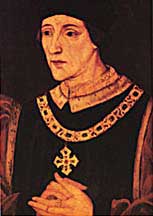 1422-1461, 1470-1471 Henry VI
1422-1461, 1470-1471 Henry VI
Henry became King while still a child. During his minority his uncles ran the war in France, and lost the country to Joan d'Arc. Henry VI was subject to fits of madness, as was his grandfather, the King of France. During his reign, upset by his mismanagement, the House of York rebelled, starting the War of the Roses. Returning soldiers from the defeat in France turned to robbery to survive. In 1453 Constantinople, the last vestige of the Roman Empire, fell to the Turks. Scholars fled to Europe where they helped fuel the start of the Renaissance. Historical Timeline: Reign of Kings - House of York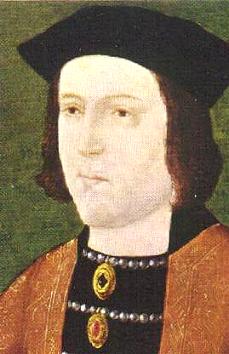 1461-1470, 1471-1483 Edward IV
1461-1470, 1471-1483 Edward IV
The grandson of King Edward III and, as Duke of York, the head of the House of York. He rebelled against Henry VI and was victorious. He confined Henry to the Tower of London. Henry was later murdered and his son and heir was killed in battle. Edward caused dissension in the royal family by marrying a woman of lower birth. |
Laurencii Heseham's sons were,
(12) Nicholaus Heseham (c1390)
(12) Thomas Heseham (c1390)
(12) Henrici Heseham (c1380)
 Merchants
Merchants
At right is the portrait of Richard Whittington, an English merchant, 1358?-1423, and Lord Mayor of London. He wears the dress typical of the era.
(12) Nicholaus Heseham (c1390)Heseham, Hessham, Hassham, Heesham, Hesham, Hisham, Hysham, Isham and Gare [?]. Merchant and brother of Thomas Heseham, below.
1419-20. "Nicholaus Heseham, merchant, fil. Laurencii Heseham, lyttester" - from "Register of the Freemen of the City of York: From the City Records ... 1272-1759" by Francis Collins.This indicates that Nicholas earned the Freedom of the City by patrimony. Note that the son's name is in English and the father's in Latin. Note also that we have a clear case of a son changing professions from that of his father. My guess would be, however, that Nicholaus did not go that far afield. I expect he traded in dyed cloth.
Nicholas was prominent in the Baltic trade between the ports of Yorkshire and those of the Hanseatic League. He was appointed as the Governor of merchant relations with Prussia and the Hanseatic states from at least 1432 to 1435.
"Yorkshiremen appear to have taken over the leadership of the English merchants in Prussia. Nicholas Hassham of York is named as governor in 1432 and remained in that post at least until the breakdown of trade in 1435 [page 169] . . . "He probably served in this role as a representative of the Company of Merchant Adventurers, a gild headquartered in London, but which had affiliated members from York, Norwich, Exeter, Ipswich, Newcastle, Hull and other places.
- from "England and the German Hanse, 1157-1611" by T. H. Lloyd
| Merchants' Governor
"In 1391 the king [Richard II] confirmed the appointment of a "governor" who had been elected by the English merchants trading with Prussia and the Hanseatic cities. In 1407 "governors" were set up with similar authority to procure agreement among the English merchants in cases of disputes, to arrange differences between them and the foreign traders, and to apply for redress of injury on their behalf for the British trade in Holland, Zeeland, Brabant, and Flanders." - from "The Development of International Law" by Geoffrey G. Butler and Simon Maccoby. 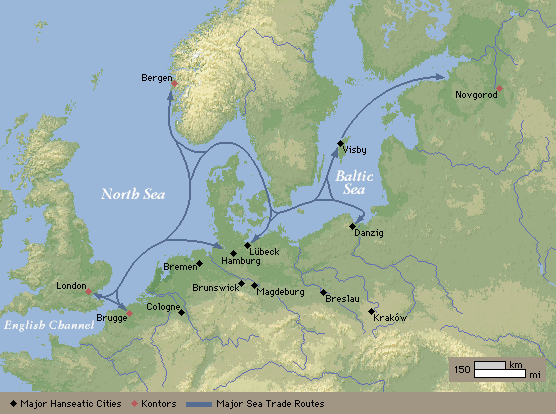 Major Cities of the Hansa |
There is another similar reference, undated,
"The English negotiators were Nicholas Hessham alias Gare, merchant of York, and William Brakley, merchant of London." - from "The English Historical Review"
A German source has,
1433. "C. Nachtragliche Verhandlungen.This snippet view also contains a reference to Thomas Beaufort, admiral of England. Thomas was the youngest natural son of John of Gaunt and half-brother of Henry IV, who appointed him the Admiral of England, Ireland and Acquitaine in 1411. He continued in that office until 1426.
Der Hockmeister Paul von Rusdorf quittiert uber den Empfang von 838 Noblen, welche Nikolaus Hassham, anders genammt Gar, Aeltermann [guild master, head of chamber of commerce], Johann Hennaye, Thomas Byerton, Wilhelm Assilay, Johann Berton, seniories mercatores de Anglia [senior merchants of England]. . . "
- from "Hanserescesse von 1431-1476"
"Nicol. Hessham, gen Gare, Kaufmann zu York" was also referenced in the "Regesta Historico-Diplomatica Ordinis S. Mariae Theutonicorum, 1198-1525" by Erich Joachim and Walther Hubatsch.
"In 1436 Nicholas Hisham of York had license to sail to Prussia with four ships in quest of woods for spears and bows, there being a scarcity of such wood in England." - from "Archery" by Charles James Longman, Henry Walrond, Alice B. Legh.
Westminster, 1436. ". . . ; ersucht daher die mit vier Schiffen nach Preussen [with four ships to Prussia] fahrenden Nikolaus Hassham aliter Gare, Kaufmann aus York [merchant of York], unde Wilhelm Brakley, Kaufmann aus London, freundlich zu behandeln (et haberi sinceriter recommissos); . . ." - from "Hanserescesse von 1431-1476"Nicholas was provided with a letter of introduction from the King.
"In August [1436] Henry VI notified the Grand Master that he would not molest any German merchants who came to England and asked him to protect the four ships coming with his letter. The leader of this expedition was Nicholas Hassham, alderman of the English merchants, and his licence from the crown refers to a current scarcity of bowstaves and wainscot in England [page 148] . . ."
- from "England and the German Hanse, 1157-1611" by T. H. Lloyd
I have another reference to Nicholas in 1439. "M.-R. Thielemans montra que les ambassadeurs designes par le roi d'Angleterre pour les conferences de l'ete 1439 presentaient des profils differents selon qu'ils furent charges de prendre en charge les aspects commerciaux ou politiques des discussion. Les premiers furent traites par William Sprever, docteur en droit, et deux marchands, Robert Brampton et Nicolas Hysham; . . ." - from "Ambassadres et Ambassadeurs de Philippe le Bon, Troisieme duc Valois de Bourgogne" by Anne-Brigitte Spitzbarth.
Nicholas may still have been governor of the English merchants as late as 1442.
"Meanwhile, on 11 June 1442 the Danzig city council had summoned Nicholas Hassham of York and six other merchants of Hull, Lynn and London to be examined about the complaints made in parliament. This group, doubtless under pressure, disavowed the agitation in England, saying that they and their fellows had no claims against their host city [page 177] . . ."To explain the situation mentioned above, the Merchant Adventurers had begun to break into the Baltic trade in the 1350's, a move strongly resisted by Prussia; the chief bone of contention being access to the port city of Danzig. Various treaties had been signed, and abrogated, leading to a trade war. In 1442 English merchants petitioned Parliament to pressure Prussia to recognize rights granted them under the most recent treaty, signed in 1437.
- from "England and the German Hanse, 1157-1611" by T. H. Lloyd
| Prussia & Danzig
In the wake of Teutonic conquests large numbers of German settlers moved east to settle these regions. The European Gernet family was one of these, eventually becoming great land-owners around Talinin, in Estonia. The Prussia we know from the 18th and 19th centuries was created in the 16th century when the Grand Master of the Teutonic Order, who was also the Margrave of Brandenburg, became a Lutheran and secularized Teutonic Prussia. His family continued, as Margraves, to be electors of the Holy Roman Empire, while as Dukes, and later Kings, of Prussia existing outside the rules and regulations of the Empire. DanzigThis city had originally been part of Polish Pomerania, but after the conquest, completed in 1308, was settled mainly by German emigrants. |
A Nicholas Heesham owned lands in Northamptonshire. This may be our Nicholas and his brother, Thomas, is found in Newark about this time as well.
- 13 July 1445. "M aft F of St Thomas, M 23 Hen VI, "Grant by John Wittilbury, of Milton, esquire, to Edmund, Lord de Grey, Knt., Richard Welby, Thomas Sutton, esquires, and Nicholas Heesham, of his manors of Milton and Marham, and all other his lands, etc. in Milton, Marham, Castre, Thorpe, Paston, Wiryngton [Werrington] and elsewhere in Northamptonshire, with the advowson of Marham church."
The following undated citation calls Nicholaus Isham, citizen/merchant of York, to be the same man as Nicholaus Hesham, merchant of Newerk. I've expanded my search of this document in hopes of extracting its meaning and/or date.
". . . Aan het gerechtshof van de Exchequer maken Thomas Babham en twee andere personen van Londen bekend, dal een aantal kooplieden van Londen, Boston, York, Newark en Lynn een groote hoeveelheid wolvellen met een schip van Lynn naar Vere zonden, zonder dat de verschuldigde customs en subsidies waren betaald (quod Ricardus Bye, alias dictus Ricardus Bee, nuper de Londonia, mercator, Willelmus Dokette de Londonia, mercer, alias dictus Dukette, Johannes Baxster de villa de Boston in comitatu Lincolnie, mercator, Nicholaus Isham, nuper de civitate Eboraco, mercator, alias dictus Nicholaus Hesham de Newerk in comitatu Nottingham, mercator, et Johannes Seyllesdene de villa de Lenne Episcopi in comitatu Norfolkie, mercator, sexto die mensis Augusti ultimo preterito in portu dicte ville de Lenne quandam navem, vocatem le Gost de Lynne, unde predicti Ricardus Bye et Willelmus Dokette adtunc fuerunt magistri et possessores, precii navis et apparatus ejusdem 600 M., cum 50.000 pellibus lanutis, vocatis stapulware, precii cujuslibet centene 4 £ 3 s. 4 d., carcarunt et frettarunt ac easdem pelles extra portum predictum duodecimo die Augusti tune proximo sequente in navi predicta usque quendam locum, vocatum Caumfere in Se landia, non custumatas nee cokettatas nee cum collectoribus. . ." - from Rijks Geschiedkundige Pulicatien: Groote Serie - Volume 66," pg 749This appears to be in both Dutch and Latin.
By 1463 Nicholas had died.
- 26 Jan 1463. "2 Edw IV, "Feoffment by Edmund de Grey, Knt., Richard Welby, esq. and Thomas Sutton, esq. to Margaret Grene, wife of Henry Grene, esq. sometime wife of John Wittilbury, esq., deceased, of the manors of Milton and Marham, with lands, etc. the advowson of the church and the cemetery of Marham, which they had by feoffment of the above John Wittilbury, jointly with Nicholas Heesham, deceased." - from the UK Archives, "Fitzwilliam (Milton) Charters, Northamptonshire Deeds"(12) Thomas Heseham (c1390)
Heseham, Hesham, Hescham, Hersham, Hysham, Iseham, Issham, and Hissem. Merchant and brother of Nicholas Heseham, above.
1419-20, "Thomas Heseham, merchaunt, fil. Laurencii Heseham, lyttester" - from "Register of the Freemen of the City of York: From the City Records ... 1272-1759" by Francis CollinsThere was also a "Thomas Heseham, lystster" in the Freemen of York, 1427-8. I don't know if this was our Thomas, perhaps taking over his father's business, or another Thomas, the son of another of the the Heseham dyers.
Note that if a man left the City he lost his Freedom. If he returned he had to regain it somehow, perhaps by paying for it. The Thomas Hesham below paid for his freedom.
1439, The Freemen of York: "Thomas Hesham, merchant, vj s. iiij d." - from "Register of the Freemen of the City of York: From the City Records ... 1272-1759" by Francis CollinsA footnote reads,
"Reconciliati sunt ad libertatem civitatis prout patet supra capita"that is, a restoration of freedom of the city that had been previously granted.
Note in the following citation that Thomas was granted administration for the goods of Thomas del Gare. Note that Nicholas Heseham, above, was known as "Nicholas Hessham alias Gare, merchant of York." What was the relationship between these two families? Did Nicholas perhaps assume the name of a patron, del Gare, by whom Thomas Heseham was recognized below?
"Thomas del Gare, senior, died intestate, and on the 26th April, 1439, administration of his goods was granted to Ellen his relict, Nicholas Bedford and Thomas Heseham, of York, merchants. Of these the former was admitted Freeman in 1432, and the latter in 1419, as "Thomas fil Laurence Heseham, lyttester." (or dyer)" - from "Reports and Papers" Volume 33Thomas Gare senior was admitted a Freeman in 1384 as "Thomas del Gare, filius Willelmi del Gare, mercer." He was a wool and cloth merchant, alderman and twice lord mayor of York. He had a brother, Johannes del Gare and, perhaps, uncles, Nicholaus and Robert del Gare. The will below indicates that Thomas Gare senior's sister was Katherine Heseham. This was probably Thomas Heseham's wife.
"Thomas Gare was admitted a Freeman of York in 1418, as "Thomas Gare, jun., fil. Thomas Gare, sen." His father was Lord Mayor in 1420, and died in 1439 intestate. A copy of his Administration Act was given in a previous paper. The son became Sheriff in 1429, and Lord Mayor in 1434. His [Thomas Gare senior's] will (translated) reads : In the name of God, Amen. The first day of December in the year of our Lord 1438, I Thomas Gare, of York, Alderman, being sound of mind and of perfect memory, establish ordain and and make my Will in this manner. In the first place I give and bequeth my soul to God Almighty, the blessed Virgin Mary, and All Saints, and my body to be buried within the parish church of All Saints on the Pavement in York, next the entrance of the choir of St. Thomas the Martyr there, and I bequeath to the said church for the devotion of my burial 13s. 4d. Also I bequeath to the Rector of the said churh for my forgotten tithes and offerings 6s. 8d. Also to my parish chaplain 6d., and to every other chaplain regularly celebrating therein 4d., to my parish clerk 4d., and sub-clerk 2d. Also I bequeath in candles and torches to burn at my exequies according to the will and discretion of my executors below named, of which I will that two shall . . ." pg 62John Bedford, a merchant of Kingston upon Hull, was Thomas Gare senior's father-in-law. In his will of September 1438, Gare remembered his father-in-law with a gift and promised the reversion of certain land in Calais to Bedford's younger son, Nicholas. Master John Gare was a second son of Thomas Gare senior.
". . . the said tenement shall remain to Anne, my daughter, and the heirs of her body lawfully begotten. And if the said Anne shall die without such heir, then I will that the said tenement in Over Ousegate shall remain to Master John Gare during his life, but so that after his decease I will that the said tenement shall remain to the right heirs of me. . . " pg 64
"with the said Helen, my wife, John Bedford, the said Master John Gare, and Helen Ormeshed to do and perform all the foregoing matters in manner and form aforesaid
Codicil. In the name of God, Amen. In the year of our Lord 1438, month of December, and fourth day. I Thomas Gare, alderman of York, sound of mind, but knowing how weak is human memory at the best, having considered, do establish and add this Codicil to my Will, sealed by my hand, by that which follows, under the tenor, namely, that I give and bequeath to Thomas and John, sons and lawful issue of my body, a certain waste piece of land lying if not in the walls within the town of Calais, and belonging to me as in certain deeds thereof made to me plainly appears except one tenement built thereupon. Which parcel of land with the tenement above specified I will shall be devided [sic] into two parts by equal portions, and the moiety of land not built on shall remainn to Thomas, my said son and the heirs of his body lawfully issuing, and the other moiety of land, with the tenement built on a certain part of that moiety to John my said son and the heirs of his body lawfully issuing. And if either of my said sons shall die without heir of his body lawfully issuing. Then I will that the moiety without the tenement or with the tenement of that one dying shall remain to the other surviving son and the heirs of his body lawfully issuing. And if it happen the same Thomas and John to die without heir of their bodies lawfully issuing, then I will that the said two moieties shall remain by equal portions to Elizabeth and Anne, my daughters, and the heirs of their bodies lawfully issuing. And if the same Elizabeth and Anne shall happen to die without such heir, then I will that the above messuages shall wholly remain to the above Nich. Bedford and the heirs of his body lawfully issuing. And for default of such heirs I will that the said tenements shall wholly revert and remain to the right heirs of the said John Bedford, father of the same Nicholas for ever. And for default of heirs of . . . But if either of them shall die without heir of her body lawfully issuing, then I will that the moiety of that daughter so dying shall remain to the other daughter surviving and the heirs of her body lawfully issuing. And if it shall happen both my said daughters to die without heir of their bodies lawfully issuing. Then I will that the said moieties shall remain to Nich. Bedford, son of John Bedford, of Kingston-upon-Hull, merchant, and the heirs of his body lawfully issuing. And if it happen the said Nicholas to die without such heir, then I will that the whole of the said piece of land shall revert and remain to the right heirs of the above John Bedford, for ever. And for default of heirs of the said John Bedford, I will that the said piece of land shall wholly remain to the right heirs of Katherine Heseham, my sister, for ever. Also I give bequeath and grant to Thomas, my said son, all my other tenements being within the town of Calais, called Shewes. To have and to hold to the same Thomas and the heirs of his body lawfully begotten. And if it happen the same Thomas to die without such heir, then I will that the said tenements shall wholly remain to John, my son, and the heirs of his body lawfully issuing. And if it happen him to die without such heir, I will that the said tenements shall wholly remain to Elizabeth and Anne, my daughters, and the heirs of their bodies lawfully issuing. And if the same Elizabeth and Anne shall happen to die without such heir, then I will that the above messuages shall wholly remain to the above Nich. Bedford and the heirs of his body lawfully issuing. And for default of such heirs I will that the said tenements shall wholly revert and remain to the right heirs of the said John Bedford, father of the same Nicholas for ever. And for default of heirs of the same John Bedford, I will that the said tenements called Shewes shall revert and remain to the right heirs of the said Katherine Heseham, my sister, for ever. To hold from the chief lords of that fee by the services therefor due and of right accustomed for ever. Also I give bequeath and grant to Alice Bardsay, my kinswoman, a certain yearly rent of forty shillings to be taken yearly so long as she shall live from all the lands and tenements which I have within the Kingdom of England into whosoever's hands they may come in the future.Probate granted 1st October, 1445, to Helen, the relict." pg 66, - from "Reports and Papers of the Architectural and Archaeological Societies of the Counties of Lincoln and Northampton" 1919
Thomas, under the name Hissem, apparently traded with the Baltic, like his brother Nicholas, including the Hanseatic city of Lubeck.
There is also the following, also from Lubeck."Lubsche Sammlung. Sie is von dem H. Maler Milde zu Lubeck von Siegelmarken aus Urkunden entnommen, die bis zum Jahre 1338 durch seine Hande gegangen waren. Unsre Erlauterungen betreffen den Namen, die Herkunft (d.i. wenn nichts anderes bemerkt worden die Lubsche), den Stand der alphabetisch geordneten Eigner und das Jarhr des Urkunde. Die haufigen and mannigfaltigen Einfassungen der Marken in Schildes-und andrer Form sind regelmassig fortgelassen.
. . .
102. Thomas Hissem, Englander, 1440
. . ." - from "Die Haus- und Hofmarken" by Carl Gustav Homeyer
"Zwolf Englische Kaufleute erklaren, dass funf ihrer Schiffe von der im Sunde kreuzenden Flotte des Konigs Christoph und der Stadte angehalten und gegen die Hollander bemannt seien, dass ihnen jedoch von den Stadten gestattet sie, ihre gesammte Ladung nach Preussen oder wohin es ihnen sonst beliebe, zu bringen. 1440. Jun. 23.This appears to be a declaration made by twelve English merchants about their five ships loaded with goods for Prussia. The document discussed, which begins in the second paragraph, is in Dutch. Mention is also made of the towns of Lubeck, Rostock, Starlessund, and Wismar.Wij Thomas Bolte, Wilhelm Kliff, Thomas Hissem . . . " - from the "Urkundenbuch der Stadt Lubeck: 1139-1470"
Thomas Hesham was again registered
- 1442, The Freemen of York: "Thomas Hesham, mercator [another word for merchant], vj s. viij d." - from "Register of the Freemen of the City of York: From the City Records ... 1272-1759" by Francis Collins. A footnote says, "Reconciliati sunt ad libertatem civitatis prout patet supra capita." that is, another restoration of freedom of the city that had been previously granted.
Thomas' name was spelled as Hescham, or mistranscribed as such [a "c" and an "e" do look alike], in the next Lubeck/Danzig document.
"Versammlung zu Lubeck. - 1442 Sept. 1.
. . .
22. Thomas Hescham conqueritur contra eosdem de Danske, quod acceperunt sibi bona anno supradicto valoris 24 l sterl, residuum bonorum suorum retinuerunt ad dampnum ipsius 40 l." - from "Hanserecesse"
Thomas may have moved his base of operations because the next citation makes Thomas Hesham to be of Newark. This could, of course, be another man, but how many Thomas Heshams, who were merchants, could there have been on the North Sea coast? Note also that Thomas' brother, Nicholas, also moved to Newark at about this time.
Deed. "John Darrell grants to Richard Couper barbour, William Tryssher ferrour, a Messuage which he of late had jointly with Robert de Wyndesour defunct. by tradition of John Hornyngwold, lying in the street called Beaumond, between tenements of Nicholas Rouse N and Richard Wakefeld S abutting on the highway to Hawton N and on 'le lynges' E Witnesses: Alexander Lawe, Thomas Hesam, Henry Forster, John Greyngham, John Gassegryll." - from Title Deeds of the Newark Corporation, dated January 18, 21 Hen VI [1443]See Bewmond, below, for Beaumond. The Heseham's and Forster families of Newark had a close relationship.
"Thomas Dalton baxter grants to Thomas Forster and William Caleys chaplains, Thomas Heseham, William Kelstern, John Clerk and Robert Upton, a messuage in the Marketstede, between tenements of the Prior of St Catherine without Lincoln W and the Guild of the Holy Trinity E which Messuage he of late held jointly with Henry Forster deceased by gift of John de Norton gyrdeler and Isabella his wife. Witnesses Thomas de Leek, Hugh Padeley, Thomas Bryngest, John Lesyngham and Alexander Williamson." - from Title Deeds of the Newark Corporation, dated August 26 22 Hen VI [1444]
"John Martyn of Newark grants to Robert Lowe and Alexander Williamson of Newark and Richard Smythe of Benyington a Messuage and 3 Cottages, lying together in Mylnegate bet[wee]n Messuages of Robert Maye S and the Master of St Leonards Hospital N, abutting on the Trent W and the highway E. Witnesses: Thomas de Leek, Thomas Hysham, William Cresey, John Clark and William Lytster." - from Title Deeds of the Newark Corporation, dated November 8, 24 Hen VI [1445]I, of course, think it's important that the last citation used the Hysham spelling, clarifying the tie to the village of Heysham.
"Agnes Lewyn, widow grants to Richard Thyrkyll and Isabella his wife a Messuage "in Beaumond de Newerk" betw[ee]n a tenement of Nicholas Rouse N and land of Richard Wakefeld S, abutting on the highway leading towards Howton W and on a certain headland (forera) of the field called 'le lynges' E; which Messuage was given her by William Bleche her father. Witnesses: Thomas Hesham, John Clark [Clerc/Clerk?], Richard Rothwell, William Dave and John Welughbe." - from Title Deeds of the Newark Corporation, dated August 16 29 Hen VI [1457]
"Quitclaim between Richard Couper of Newark, barber and William Fissher of Newark, ferrer [farrier?]; and William Bleche of Newark, roper, of a messuage in 'Beaumond de Newerk'. Witnesses include Thomas Heseham, 6 February 1447/8." - from Records of the Newark Corporation
"Grant between William Bleche of Newark; and John Lewyn of Newark and Agnes the daughter of William Bleche, of a messuage, as above. Witnesses include Thomas Heseham, 2 December 1448." - from Records of the Newark Corporation
28 April 1451, at Westminster. "Licence, for 20 marks paid in the hanaper, for John Burton, vicar of the church of St. Mary Magdalene, Newerk, doctor of sacred theology, Thomas Forster, chaplain, Thomas Hesham of Newerk, 'marchaunt,' John Clerc and William Boson of Newerk to found in honour of the Holy Trinity and St. Mary a chantry of a chaplain to celebrate divine service . . . " - from the "Patent Rolls"Hanaper was an office in the court of chancery in which writs were kept. Newerk probably refers to Newark-on-Trent, Nottinghamshire, which is located between Lincoln and Nottingham.
| Newark-on-Trent
Newark-on-Trent is located where the Great North Road meets the Fosseway on the banks of the river Trent, in Nottinghamshire, just across the border from Lincolnshire. |
Here is another citation dealing with Thomas' founding of a chantry in Newark.
"There was a fourth chantry founded at the Altar of Holy Trinity, known as Foster's chantry, the founders being John Burton, sometime Vicar of Newark, Thomas Foster, Thomas Hersham, John Clerc and William Boson, for one priest to celebrate Mass at the Trinity Altar, to pray for the founder's soul and for the brotherhood and sisters of Trinity Guild . . . The King's licence is as follows:--A.D. 1451. The King to all, etc., greeting. Know ye that we, of our special grace and for the peculiar and inward devotion which we have to the holy and undivided Trinity and to the glorious and inviolate Virgin Mother of God, Mary, and for twenty marks paid to us in our Treasury, have granted to John Burton, Vicar of the Church of the Blessed Mary Magdelene, of Newerk, Doctor of Sacred Theology, Thomas Forster, chaplain, Thomas Hersham, of Newerk, merchaunt, John Clerc, and William Boson [Boston?], of Newerk, that they may found, etc., etc., to the honour of the Holy Trinity and of the blessed Mary, a certain perpetual chantry of a priest celebrating Mass daily at the Altar of the Holy Trinity, in the aforesaid Church, for our good estate and that of our dearest consort, Margaret, Queen of England, while we shall be living, and for the aforesaid John, Thomas, Thomas, John and William, while they shall be living, etc., etc." - from Cornelius Brown's History of Newark volume I, page 219-220
A year later Thomas was again referenced as "of Newerk."
23 November 1452, at Westminster. "Licence for the alientation in mortmain by John Burton, vicar of the church of St. Mary Magdalene, Newerke, doctor of sacred theology, Thomas Forster, chaplain, Thomas Hesham of Newerk, 'marchaunt,' John Clerc and William Boson of Newerk, to Thomas Seward, chaplain of 'Forster Chaunterie' in the said church, of 6 messuages in Newerk, extended at 40s a year and not held in chief, as was found by an inquisition taken before John Westnes, late eschetor in the county of Nottingham; to hold to the value of 4 marks a year in part satisfaction of the 12 marks of lands and other possessions which he has licence to acquire by letters patent dated 28 April last." - from the "Patent Rolls"And circa 1452,
Bundle 18. "John Brian and Mabel his wife; Thomas Iseham (or Heysham), of Newark; Money matters; Notts." - from "Lists and Indexes of Early Chancery Proceedings," volume I, 1901Bundle 18 was addressed to John, cardinal archbishop of York, Chancellor of England 28-31 Henry VI [1450-1452].
I am unable to decipher the date in the following.
"aus Preueen nach England; Empfehlung zugleich fur Thomas Hysham aus Nottingham. Westminster 28. Febr. anno r. nri. 17. Or. Pgt. S. ab." - from "Regesta historico-diplomatica Ordinis s. Mariae Theutonicorum, 1198-1525" by Erich Joachim and Walher HubatschI guess this means, "from Prussia to England; Recommend at the same time for Thomas Hysham of Nottingham, [at] Westminster, 28 Feburary . . ." This must show a relationship with Nicholas Heseham, merchant of York, above, who led a mission to the Hanseatic towns of old Prussia.
Thomas died in 1457.
"5 May 1457 Heseham, Thomas, V. of Newerk, Merchant, adm: 20 269" - from "Index of the Wills and Administrations Entered in the Registers of the Archbishops of York"From a transcript of a rental roll of the Bishop of Lincoln in Newark, held in the National Archives, probably of the time of Edward IV (1461-1483), is listed,
"Bewmond.A selion was a "mediavel open strip of land or small field used for growing crops, usually owned by peasants." Bewmond appears to relate to property owned, at one time, by the Beaumont fammily. Could this be Thomas' son? I also have, also under the Bewmond title,
. . .
Thos. Hesham for a selion lately [of] William Husmondthorp's. . . the prior of St. Katerline's for a garden. . . - from Cornelius Brown's History of Newark volume I, page 164
"Thos. Issham for a selion lately in the tenure of Simon Treysmer . . ." - from the "History of Newark-on-Trent" by Cornelius Brown.
I have a Katherine Heseham of Newarke, Notts, widow, who, with Robert Clay of York merchant, were defendants against John Fell of York, merchant, plaintiff for debt in 1450.
(13) Thomas Heysham (c1420)I have several references to Thomas, the son of Thomas Heysham/Hesham. In each the son is of the church, either called a rector or a clerk.
Of York. "Letters Dismissory "Thomas Heisham, M.A., of York diocese, clerk, 10 March 1452/3" - from "York Clergy Ordinations 1450-1474" edited by David M. Smith, 2018This letter would have sent Thomas from one church assignment to another. Four years later,
A.D. 1456: "15 November. Commission to Thomas Hesham, rector of Alyngton [West Allington, co. Lincoln], Lincoln diocese, to administer the goods of his father, Thomas, intestate. Inventory by 16 May." - from the "Canterbury and York Society, volume 54," page 179If we assume the citation above means that an inventory, that is the completion of the administration, is due by 16 May 1457, that lines up well with the administration of the estate Thomas Heseham of Newark, Merchant, on 5 May 1457, above. Allington is about 10 miles south of Newark, in Lincolnshire. The parish church is dedicated to the Holy Trinity and stands near Allington Hall. It is of Norman origin.
1459. "Ordination celebrated in the conventual church of the Carmelites, York, on 22 September 1459 by Richard, bishop of Dromore, the suffragan
. . .
Priests
. . .
M. Thomas Heisame, rector of Alyngton*, to t. of his benefice.
*Alyngton has not been identified within the York diocese. Of course it may be that Thomas Heseham was a native of York diocese but his benefice was elsewhere and the location not noted by the registry clerk. It might possibly be the rectory of West Allington, Lincs." - from "York Clergy Ordinations 1450-1474" edited by David M. Smith, 2018.
Two cases of debt that Thomas prosecuted on behalf of his father, the deceased merchant. Note that young Thomas is shown with a Master of Arts, probably a degree in divinity.
1460. "Case Type: debt, Plaintiff: Heseham, Thomas, of Newerk, York diocese, merchant, administrator of; (Heseham, Thomas, Master of Arts), Defendant: Halton, Hamo, of Lincoln, vintner, son of William Halton, of Lincoln, vintner"In the 15th century a Bachelor of Arts was for the teaching of the trivium and the Master of Arts for the quadrivium. This means that Thomas Jr. was probably a graduate of Oxford or Cambridge University.
1460. "County: Notts, Case Type: debt, Plaintiff: Heseham, Thomas, of Newerk, Yorkshire diocese, merchant, administrator of; (Heseham, Thomas, Master of Arts), Defendant: Halton, Hamo, of Lindoln, vintner & son of William Halton, vintner." - from Henry VI, 1460: CP40no796 by Rosemary Simons
The following reference is for a clerk and son of a Staple merchant. The court case referenced below was against a gentleman of York, and Thomas Sr. was mentioned in the same Chancery records, above - that's as conclusive as things get for the 15th century. The reference dates to 1460-1465 and relates to the administration of Thomas Sr's estate; again the timing is appropriate.
"Thomas Heysham, clerk, son and administrator of Thomas Heysham, merchant of the staple at Calais. v. John Hemelsey, gent., late of York, servant to Thomas late lord Roos.: Attachment of goods at Calais for a pretended debt.: Calais. Chancery pleadings addressed to [George] Neville. Date range: 1460 - 1465." - from The Court of Chancery: Six Clerks OfficeA similar statement is in "Lists and Indexes of Early Chancery Proceedings," volume I, 1901, but it also notes that this was from Bundle 27, addressed to George Neville, bishop of Exeter, in the period 38 Henry VI to 5 Edward IV. George Neville was Chancellor 25 July 1460 to 22 August 1463, 25 October 1463 to 9 April 1464, and 14 May 1464 to 14 March 1465.
A similar case, from the same bundle, was by "Thomas Heysham, clerk, son and administrator of . . .", etc., was against "Johm Hemelsey, gent., of York, servant to Thomas late lord Roos" for an "Attachment of wools at Calais."
| Merchant of the Staple at Calais
The staple in Calais was in operation from 1363 to 1558. The Merchants of the Staple, also known as the Merchant Staplers, was an English company, or guild, which controlled the export of wool to the continent during the late medieval period. From 1314, the Crown required all wool for export to be traded at a designated market, called 'the staple'. This allowed the Crown to monitor the trade and levy tax on exports. Calais was the staple from 1363 when a group of twenty-six traders was incorporated as the Company of the Staple at Calais. In exchange for its cooperation in the payment of taxes, the company was granted a total monopoly on wool exports from England. The company was important to the English crown, both as a source of revenue, and through its role in the defence of Calais against the French. The monopolists drove up wool prices to enrich themselves which in turn drove up the price of cloth manufactured in Europe. While England had not previously manufactured much cloth, the effect of the staple was to make European cloth more expensive and made domestic manufacture more profitable. The staple monopoly in Calais thus gradually became irrelevant. As domestic cloth production increased the power of the Staple Merchants diminished. In 1558, with the loss of Calais to the French, the staple was transferred to Bruges where the Merchant Staplers continued to enjoy their monopoly on exports. However, in 1614, export of raw wool was banned entirely during the Cockayne Project of William Cockayne and wool was traded only in domestic staples. The project failed however, because the Estates-General of the Netherlands banned the import of cloth from England. In 1617 the English lifted their ban, but the Dutch ban remained in place. The Merchant Staplers continued to exist, but only in local markets. |
| Sir Thomas Roos, Lord Roos
9th Lord Roos of Helmsley, Yorkshire. He succeeded in 1430 when his father, Thomas Roos Sr., a Privy Councillor, drowned trying to cross the river Marne with the army of the Duke of Bedford. Thomas Jr. was an ardent Lancastrian in the War of the Roses. He fought at the 1st Battle of St. Albans in 1455, the Battle of Wakefield in 1460, and at 2nd St. Albans in 1461. He was at the Lancastrian defeat at Towton in 29 March 1461 and fled to Scotland with Henry VI. He was attainted by Parliament on 4 November 1461. He returned in 1464 and was captured and beheaded. The lordship lapsed with his death. |
Of York. His profession is unknown, but since it was not noted below, I suspect he was probably a merchant like his son and that makes it possible for him to be a son of Laurence, the father of the other two York merchants, Nicholas and Thomas Heseham.
(13) Johannes Heseham (c1400)
Heseham, Hesham, Hescham, Heceham. A merchant of York and Newark. The followinng may actually record three different men, but for now I'll keep it as one. This may be similar to the case above in which Thomas Heseham reregistered as freeman three times. The first notation is for a man earning his Freedom via patrimony of his father, Henry, the second by completing service as an apprentice, and the third by purchase.
- 1429, The Freemen of York: "Johannes Heceham, merchaunt, fil. Henrici Heceham" - from "Register of the Freemen of the City of York: From the City Records ... 1272-1759" by Francis Collins.
- 1432, The Freemen of York: "Johannes Heceham, mercator" - from "Register of the Freemen of the City of York: From the City Records ... 1272-1759" by Francis Collins.
- 1439, The Freemen of York: "Johannes Hesham, merchant, vj s. iiij d." - from "Register of the Freemen of the City of York: From the City Records ... 1272-1759" by Francis Collins.
Below as John Heseham, mercer of Newark.
1438. "Thomas Blaunkeney of Newerk, son and heir of Thomas Blaunkeney of Brandoun, to Master William Duffeld clerk, John John (sic) de Boston of Newerk, Henry Alderston chaplain and John Heseham, their heirs and assigns. Charter with warranty of a capital messuage in 'Cartergate' [mediaeval town gate] Newerk and 4 acres of arable land lying dispersedly in the fields of 'Northgate' by Newerk, the said messuage lying between a messuage of Henry Pierpount knight on the north and a messuage sometime of Roger de Chaumbre on the south. Witnesses: William Crescy, Henry Forster, Robert Lowe, John Daunet, John Clerk of Newerk. Dated Newerk, 26 March 16 Henry VI."Also,
1439. "Thomas Blankeney (as above) to Master William Duffeld clerk, John de Boston of Newerk, Henry Alderston chaplain and John Heseham, their heirs and assigns. Quitclaim with warranty of a capital messuage in 'Cartergate' Newerk and 4 acres of arable land in the fields of 'Northgate' by Newerk (as above). Dated Newerke, 6 February 17 Henry VI." - from "Calendar of Close Rolls, Henry VI: Volume 3, 1435-1441" originally published by His Majesty's Stationery Office, London, 1937
The following is the same conveyance as above, but with more detail.
"Thomas Blaunkeney [Blankeney] of Newerk, son and heir of Thomas Blaunkeney of Brandoun, to Master William Duffeld clerk, John John [sic] de Boston of Newerk, Henry Alderston chaplain and John Heseham, their heirs and assigns. Charter with warranty of a capital messuage in 'Cartergate' Newerk and 4 acres of arable land lying dispersedly in the fields of 'Northgate' by Newerk, the said messuage lying between a messuage of Henry Pierpount knight on the north and a messuage sometime of Roger de Chaumbre on the South. Witnesses: William Crescy, Henry Forster, Robert Lowe, John Daunet, John Clerk of Newerk. Dated Newerk, 26 March 16 Henry VI [1438]." - from "Calendar of the Close Rolls" of 1933, page 280Brandoun, now Brandon, is a village in Lincolnshire, about 8 miles southeast of Newark. John de Boston was a mercer of Newark who died in 1443.
Rod Neep, a researcher of that family, writes in Rootsweb:
"There is even a tantalising reference to a William Nepe on 17 June 1449 who died at Newark without leaving a will. In his administration his goods were granted to "William Heseham [sic], mercer of Newark, and William Crecy of the same place"However, in a later entry Rod mentions,
Tantalisingly, I know nothing more than the record which is preserved at the Borthwick Institute in York: "On 17 June 1449 the Administration of the goods of William Nepe, late of Newark, deceased intestate, was granted to John Heseham, mercer of Newark and William Crecy of the same place"I think the first reference to a William Heseham was a typo - Rod was perhaps thinking of his relative William Nepe as he wrote. Newark-on-Trent is a market town in Nottinghamshire. The rivers Trent and Devon run through the city, as do the Great North Road and Fosse Way. At the end of the 14th century the town's population was about 1,200.
The followinng is the administration of William Nepe's estate.
"William Nepe, of Newerk,Newark Strays - Wives
17 June 1449.
[Administration granted to John Heseham, merchant, of Newark and William Cray, of the same.]" - from Cornelius Brown's History of Newark volume I, page 350
The following are probably wives of the Heseham men of Nottinghamshire.
(12) Margaret Heseham (c1390)Of Newark. Margaret was mentioned in the following will, but no bequest was noted. The residue of Katherine Forster's estate when to Thomas Forster, chaplain, who was mentioned above, with Thomas Heseham, in the founding of Forster's Chantry. Was Katherine the chaplain's mother? This implies a close relationship between the Forsters and the Hesehams. John Clerk [Clerc], see also above with the chantry, was one of the executor's.
"Katherince Forster, of Newerk, widow(15) Jenett Hesome (c1490)
26 March 1450.
To be buried in Newerk Church, viz. in the Chapel of St. Nicholas.
. . .
Alice Diconson. Margaret Heseham." - from Cornelius Brown's History of Newark volume I, page 357
"Apl. 19, 1559 [date of probate]. Hesome, Jenett, Eperstone (Notts.), widow, May 16, 1558 [date of will]." - from "Index of Wills in the York Registry." Epperstone is about six miles southwest of Newark-on-Trent.
The following are follow-on residents of Nottinghamshire.
Thomas Hesam (c1500)
"17 July 1534. Epperstone. Edward Cawod, county coroner.
Jurors: John Walker, William Marcyall, Ralph Bariet, all of Epperstone; Thomas Hesam, Thomas Gawyn, William Wryght, all of Calverton; Nicholas Foster, John Gawyn, William Schipman, all of of Gonalston; Robert Baryet, Richard Foster, , Thomas Marcyall, all of Lowdham." - from "Calendar of Nottinghamshire Coroner's Inquests" by R. F. Hunnisett.
Calverton is about 15 miles west of Newark.
(11) Willelmus de Hesham (c1365)
The following is a craft closely associated with both the tailors and dyers.
1397, The Freemen of York: "Willelmus de Hesham, wever" - from "Register of the Freemen of the City of York: From the City Records ... 1272-1759" by Francis Collins.This entry for another a William Hesham earning his Freedom 13 years after another William Hesham appears to indicate that there were at least two Hesham families living in York at the time. I also have a will for a William Heseham, York with a date of 27 September 1436 in Vol. 2 Fol. 497 of the "Index of Wills in the York Registry A.D. 1389 to 1514" by Francis Collins, E. W. (Ely Wilkinson) Crossley. The will mentions a Mary, undoubtedly his wife. Clerks
(11) Willelmus de Hesham (c1355)
The following may indicate that William was an educated man.
1384, The Freemen of York: "Willelmus de Hesham, clerk" - from "Register of the Freemen of the City of York: From the City Records ... 1272-1759" by Francis Collins.A large number of clerks were required to support city government, the ecclesiastical offices of the Archbishop of York, and the occassional residence of the national government while the King was campaigning in Scotland.
William lived on castle hill - though I haven't seen that there was much of a hill here.
"He held jointly with John Alwent, chaplain, and John de Morton, who are still living, by enfeoffment of Henry Nessefeld, a messuage upon Castelhill, which William Heseham now inhabits, together with all shops, tenements, gardens and dovecotes between the said messuage and the bridge of York Castle ; worth by the year, beyond reprises, . . ." - from the "York Memorandum Book" by Maud Sellers and Joyce W. PercyYork castle was at the south end of the old town, where the rivers Foss and Ouse met. The next reference, though too abbreviated for me to translate, appears to indicate that William lived in the parish of St. Mary Castlegate. Castlegate street is today a short, narrow lane that leads to York castle.
"Testamentary Burials. 12 Sept., 1426. Willelmus Heseham de Ebor [of York].--Sep. in cim. eccl. mea pa. Beatae Mariae in Castelgate, ex parte australi prope murm dictae eccl.--Wife Margaret, sole executrix . . . The testator was clerk of the castle of York." - from "The Yorkshire Archaeological Journal" by the Yorkshire Archaeological SocietyA footnote says that "He was clerk in the castle, and in 1421 was admitted with his wife, Margaret, into the Corpus Christi Guild.' Also referred to an "Will. Heseham morabatur super Castelhill." Another source shows "Will. Hesam, de castro," of the castle, and "Margareta uxor ejusdem," his wife.
From the same source, "Margareta Heseham, nuper uxor Will. Heseham de Ebor, clerici.--Sep. in eccl. mea par. B.M. in Castelgate,--juxta corpus Will. Heseham, nuper viri mei." followed her husband on 20 January 1428-9. In a footnote as "20th January, 1428-9. Margaret Heseham, late wife of William Heseham, of York, clerk. To be buried near her husband in the church of St. Mary, in Castlegate [Pro. 22nd October, 1429]." - from "Index of Wills in the York Registry A.D. 1389 to 1514" by Francis Collins, E. W. (Ely Wilkinson) Crossley and "The Publications of the Surtees Society."
| Corpus Christi Guild
A number of religious brotherhoods, similar to craft guilds, were founded in England in the 14th century. The Black Death had struck terror into the hearts of the people, leading to a widespread revival of religious life. These organisations generally bore the names of saints or churches, hence such names as Corpus Christi Guild in York. "Although esablished for religious purposes, the York Corpus Christi Guild, in particular, created a social network which included the upper lay and clerical echelons of York society, and indeed, of northern society . . . In the York Corpus Christi Guild, merchants played a prominent part in the more routine guild affairs, often serving as one of the six keepers . . . According to one historian: "The membership of larger fraternities was so dominated by the local town oligarchy that they could well be described as the corporation at prayer," but in York, merchants were only one amongst many categories in the Corpus Christi Guild . . ." - from "Medieval Merchants" by Jenny Kermode. While it did good works, the guild is mainly remembered today for its annual pagaent. |
19 Richard II [1396] a licence was granted to found the Gild of St. Christopher and a chantry. The Gild maintained common gildhall and various stone bridges and roadways in and around the city, as well as providing relief to the poor. A number of bequests were made to the Gild, including the following:
- BIHR PR 2 497r 1426 "William Heseham clerk of the parish of St Mary Castlegate: 2s [to the Gild of Corpus Christi]."
- BIHR PR 2 568r-v 1429 "Margaret Heseham widow of William of St Mary Castlegate: 2s [to the Gild of Corpus Christi]."
". . . In the latter year he came to the house of Wm. Heseham (clerk to the castle) and arrested and imprisoned a woman, as the house was within the jurisdiction of the Castle. The Mayor demanded her release as the house was within the city boundary. It was arranged that a conference be held at the adjacent priory, when it was agreed that the house was within the City Liberties." - from "An Account of the City and County of the City of York" by George Benson.
LawyersIts hard to know where the following fit, but, as educated men, I am inclined to believe that the first three are very likely sons and/or grandsons of "Willelmus de Hesham, clerk," above. Below is a panorama of York in the 15th century.
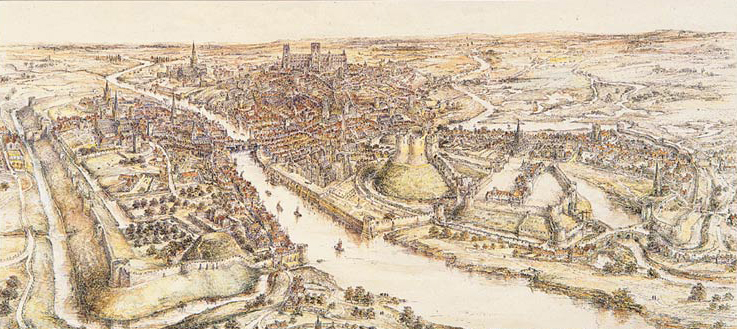
Circa 1407. Attorney. Willelmum de Hesham attornatum. - from "Record Series" by the Yorkshire Archaeological Society.
He was cited as a witness in the parliamentary returns mentioned below in response to a writ, 12 Henry IV, 1411.
"Between Edmund Sanford, sheriff of York, of the one part, and William Halgate, attorney of Ralph [Neville, 1st] Earl of Westmoreland [c1364-1425]; William de Rillyngton, attorney of Lucia [daughter of Barnabas, Duke of Milan, widow of Edmund de Holland, Earl of Kent] Countess of Kent; William Hesham, attorney for Peter Lord de Mauley [Willelmum Hesham attornatum Petri domini de Malo Lacu]; William de Barton, attorney of William Lord de Roos [Baron of Kendal]; Robert Queldale, attorney of Ralph Baron de Graystock [in Westmorland]; William de Foston, attorney of Alexander de Metham, Chivaler; and Henry de Preston, attorney of Henry de Percy Chivaler [son of Sir Thomas Percy, 3rd son of the 1st Earl of Northumberland. Henry's cousin was the more famous Henry, Baron Percy, known as "Hotspur"], common suitors annually to the county of York every six weeks [that is, they were required to attend court every six weeks], of the other part . . . Witnesseth that proclamation having been made by the said sheriff in the county court, by virtue of a certain writ directed to the same sheriff for holding a parliament of our lord the king at Westminster . . . the aforesaid attorneys by unanimous assent and will, in the said county court then being . . . have chosen two fit and discreet knights, etc." - from "Ancient Parliamentary Elections" by Homersham Cox.Here William was a substitute for Lord de Mauley, to do duty for him as an elector. Neville and de Roos were friends of the King, in opposition to the party around his son, the future Henry V. I assume the two "chivalers" noted above were the two "discreet knights" chosen for Parliament.
William's position is somewhat clearer in the following text.
The men named in the last section above are apparently the chiefs and their representatives. From the same text, but in a different source, we have:". . . the actual power of election was vested in the representatives of the regular suitors.
Who were then these tenants-in-chief who were regularly in the county court? At the election of 1407, there were present the attorneys of Edmund, earl of Kent; Ralph, earl of Westmorland; Ralph, baron of Greystoke; William baron of Hilton; Peter, lord Maulay; William, lord Roos; Alexander de Metham; and Henry Percy of Athol. With certain variations they or their successors were represented so long as this method of election persisted. Certain other important suitors who appear later were not represented in 1407. The archbishop of York, Richard Scrope, had been executed for his part in the rebellion of the Percies, but from 1414 the attorney of his successor, Henry Bowet, was present. On the restoration of Henry Percy to his grandfather's earldom of Northumblerland, he is also represented, while from 1414 appears the attorney of John Mowbray, the earl Marshal, who had recently had livery of his estates on coming of age; and from 1423 the attorney of John de Etton of Gilling castle. These were the persons regularly represented at the elections; other persons appear once or twice but in general it may be said that the electors were the attorneys of the same tenants-in-chief time after time.
That they are represented as tenants-in-chief, and not because of their personal importance, is shown by the fact that on several occasions their widows are represented after their death, and on one occasion William de Hesham was present as . . . "
. . .
"Wm, Baron [of Hilton] Peter, Lord [Mauley]
John de Burne Wm de Hesham" - from "Record Series, Volume 91"
". . . Willelmum de Rillyngton attornatum Willelmi domini de Roose, Willelmum de Hesham, attornatum Petri domini de Malo . . ." - from "The Parliamentary Representation of the County of York 1258-1832" by Arthur Gooder
| The de Mauley's
He left a son Peter, who succeeded him, and was followed by six others of the same name. The last succeeded his grandfather in 1383. Peter de Mauley (1378-1415) married Maud, daughter of Sir Ralph Neville. Peter died without issue and the barony fell into abeyance. The present Lord de Mauley is a modern creation, though he descends from the old barons in the female line. The 13th century castle of Mulgrave, above, is today a ruin. |
| Heysham's Who Took Holy Orders
The following were several priests who may have been relatives, but who had no progeny. (13) The Reverend Doctor William Heseham (c1400)Of York. From documents of the Medieval Carmelite Priory at York: Hesham [Heseham, Heselam] William. A Carmelite who probably joined the Order at York and later studied at Oxford university where he was awarded a doctorate. There exist the title and incipits of two sermons preached by Thomas Netter at the vesperies of "William Hesham and John Upton." These must have taken place at Oxford University sometime before 1430. [Bodl. Libr., Ms. Bodley 73, fo. 204v]. Note that the Carmelite Friary was located next to the Foss Bridge where other members of the Heseham family apparently lived. For more information about the Carmelite house, see The Medieval Carmelite Priory at York. In the will of William Barton, fishmonger, dated 22 Aug 1438, there occurs a bequest of 3s.4d. to 'Doctor William Heseham of the Carmelite house in York'. [Borthwick Inst. Hist. Research, Prob. Reg., 536V: information from Ms. Tessa Frank]. A second bequest occurs in the will of Thomas Clynt, merchant, dated 9 April 1439 of 6s.8d. to 'Master Heselam, Carmelite'. [Borthwick Inst. Hist. Research, Prob. Reg. 3, 567V: information from Ms. Tessa Frank]. While somewhat repetitive, there is also this, "HESHAM (Heseham, Heselam) William A Carmelite, who probably joined the Order at York and later studied at Oxford university where he was awarded a doctorate. There exist the title and incipits of two sermons preached by Thomas Netter at the vesperies of "William Hesham and John Upton" I also have a snippet, "William Hesham (vicar 1454 - 1476) was before the court for omitting to say Mass between February 4th and the first Sunday in Lent, 1461. He was ordered to occupy, during the offices and in all processions, the place of a deacon, and to stand during the singing of Matins, Mass and Vespers, robed only in surplice, and without cope or other mark of the office of a vicar. Robert . . ." - from "Life in a Medieval College: The Story of the Vicars-Choral of York Minster" by Frederick Harrison. The vicars choral was a member of the clergy in a cathedral who sang certain parts of the service. They also performed the marriage ceremony. (14) William Heseham (c1430)Of the Franciscan friary of York. A member of the church. "Ordination celebrated in the conventual church of the Franciscans, York, on 18 December 1451 by Br. J[ohn], bishop Philopolensis, the archbishop's suffragan(14) John Hesam (c1420) Of York. A member of the church. "Ordination celebrated in the conventual church of the Carmelites, York, on 12 March 1456/7 by J[ohn], bishop Philopolensis, the suffraganWatton Priory was a priory of the Gilbertine Order at Watton in the East Riding of Yorkshire, England. (14) John Hesam (c1425) Of Pontefract. A member of the church. "Ordination celebrated in the conventual church of the Franciscans, York, on 17 March 1463/4 by William, bishop of Dromore, the suffragan |
Or Hysame. Of York.
"Weddings in Anno D'ni 1594This church was in the same parish as the Minster and considered to be a fashionable place to be married.
. . .
John Hesame & Anne (blank) was maryed the 7 of februarye [1594]" - from "The Registers of St. Michael Le Belfren, York 1564-1653" in Publications of the Yorkshire Parish Record Society
The following appears to be the same incident, from Paver's Marriage Licenses.
"Date: 1594. Name and Description: Hysame, John. Name and Description: Banister, Ann. Where to be Married: St. Michael-le-Belfrey, York." - from "The Yorkshire Archaelogical and Topographical Journal"Note that (15) William Heysham (c1530) of Highfield married Bridget Banister [Banester] of Barnoldswick, East Lancashire circa 1560. William's eldest son was also named John, but he married Anne Wynder. (18) William Heesome (c1647)
"Heesome, Gul . . . Trin. A.B. 1667. A.M. 1671." - from "Graduati Cantabrigienses"
(18) Mary Hesom (c1660)Of Micklegate, York.
"1684, Aug. 11. John Hick, of Abberforth & Mary Hesom, of St. Martin's par. in Micklegaite, Yorke." - from "The Register of Marriages in York Minster, 1681 to 1762" by Robert H. SkaifeMicklegate is a gate and street in York on the south side of the Ouse river; it is the southern entrance to the city.
| Dialects of Northern England
These dialects are not slang, but variants of English evincing a stronger influence of early Norse languages. While I can't vouch for its accuracy, the British TV series "All Creatures Great and Small" uses a variety of northern dialects that are almost impossible for an American ear to understand. Lancashire DialectYorkshire Dialect Standard features include H-dropping, |
Of Bishophill, York. He married Ann.
Emma Heesam (1862)The daughter of John and Ann. She was born on 10 June 1862 and baptized on 20 July 1862 at St Mary Bishophill Junior, York. This church is the oldest in York, located just behind Micklegate. The site of the church was the colonia or civil quarter of the Roman garrison of Eboracum and elements of Roman stonework can be found in the Tower. The neighborhood was in the southern part of the town, over the river Ouse. Mary Hesom, above, was from Micklegate.
Pickering is an ancient market town in the moors, in Ryedale district in northeastern Yorkshire. It is northeast of York and northwest of Bridlington.
Lawrence Hesham (c1650)He married Martha. Their daughter was Dorothy, who was christened on 7 December 1681 in Pickering, Yorkshire, England.
There was also a large Heysham family who resided in the southern wapentakes of the West Riding of Yorkshire. It is not clear, however whether they were emigree's coming directly from Lancashire or were part of the York city family, above. I suspect the former. Note that while we see the Heseham spelling in York and Lancashire, though only rarely in the latter, none of the West Riding family used the spelling.
The West Riding is now known as West and South Yorkshire and has been, since very early times, a coal mining region. It may have been this that drew the family there.
| Early Coal Mining
Coal was first discovered when it washed up on the beaches, and was thus known as Sea Coal. It has been mined in Northern Yorkshire since at least 1183 when shallow coal seams were first exploited. By the 13th century coal was an export trade. The South Yorkshire coalfield has been mined since at least 1370. The National Coal Mining Museum is located in Wakefield, near Wragby and Crofton. |
In the 17th century there was also extensive farming and a growing textile industry.
The Heysham surname variants of Heesham, Heesom, Hesom and Hesome were the ones most commonly used in this region. Note that the first member of our family to come to America, John, also used the spellings Heesom, Hesom and sometimes Heesham. He was amongst a group of Quakers from London and Yorkshire who settled the Burlington colony in West Jersey. Other Yorkshire Quakers, including Samuel Oldale, Michael Newbold and Godfrey Hancock, came from the region around Sheffield, which is also in South Yorkshire.
The Ridings of Yorkshire
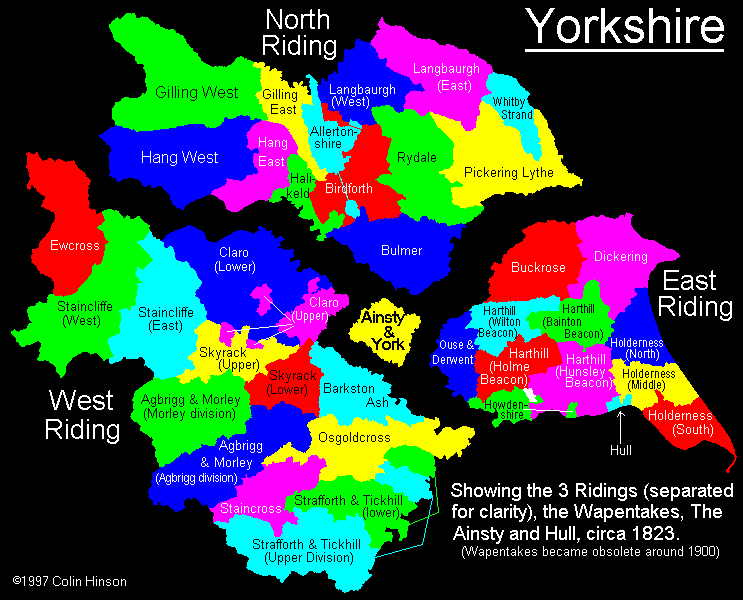 West Riding Yorkshire was divided in three Ridings, North, East and West. The word's original meaning meant "a third." The West Riding lies on the border with Lancashire, Cheshire and Derby. The towns of York and Beverley, the latter in the East Riding, had been the powerhouses of the north during the medieval period, but declined precipitously during the Tudor. This was the West Riding's gain, and it became one of the three major regions of the English cloth industry. Hull, lying at the eastern terminus of the major rivers flowing out of the West Riding, became the north's major seaport. Wapentakes of Osgoldcross and StaincrossWapentakes were a sub-division of a Riding, equivalent to the Hundred in other counties. The word was probably derived from "weapon touch," and referred to an assembley or meeting place. The wapentake of Osgoldcross included the parishes of Adlingfleet, Badsworth, Burghwallis, Campsall, Castleford, Darrington, Kellington, South Kirkby, Owston, Pontefract, Whitgift and Womersley and parts of Featherstone, Snaith and Wragby. By the way, Osgoldcross is probably a corruption of St. Oswald's Gold Cross, which was located in Pontefract. Staincross included the parishes of Felkirk, High Hoyland, Penistone, Royston, Silkstone (including Barnsley) and Tankersley and parts of Darfield and Wragby. Both wapentakes were under the lordship of the Honor of Pontefract. Today this region is known as South Yorkshire, and is further divided into the boroughs of Barnsley, Doncaster, Sheffield and Rotherham. Parishes and Villages
|
Doncaster was one of the major market towns of Yorkshire, along with Ripon and Richmond. It is due east of Barnsley.
(9) Thomas de Hesham (c1300)Thomas is the earliest Hesham I've found in Yorkshire. References for the Heseham's of York are at least a few years later. At this same time John de Hesham was living in Lancaster. Thomas' wife was Maude. I have a snippet view of Thomas,
"39. Westminster. Quindene of Easter, 20 Edward III, 1346.Maude, Agnes and Elena were apparently sisters, and heirs to the toft in Doncaster. I believe Thomas de Thwayt was a carpenter, married to Johanna, of the Villa de Tykhill [Tickhill]. Tickhill is south of Doncaster. Quer, is short for querent, one who seeks, that is the plaintiff. Def. is short for deforciant, one who keeps the rightful owner of an estate from possessing it. As previously discussed, while this looks like a lawsuit, this was how sales of land were transacted. In this case, Thomas de Thwayt was buying 2 tofts from the joint heirs of the property.Thomas de Thwayt, quer., Thomas de Hesham and Maude, his wife, and William de Atherlagh and Agnes his wife, and Elena sister of Agnes, def., of 2 tofts in Doncastre: To hold to Thomas de Thwayt and his heirs; he gave 100s. Quitclaim and warranty by the deforciants for themselves and the heirs of Maude, Agnes and Elena." - from "Record Series" of the Yorkshire Archeological Society, pg 185
I haven't yet been able to place William de Atherlagh. Atherlagh is a village in county Clare, Ireland.
| Doncaster
By 1334, Doncaster was the wealthiest town in southern Yorkshire and the sixth most important town in Yorkshire as a whole, even boasting its own banker. By 1379, it was already recovering from the Black Death and had a population of around 1,500 people, and by 1547, it had over 2,000. The town was incorporated in 1461 and its first Mayor and corporation were established. |
Note that there was a Thomas de Hesham (1260) living in Lancashire just before this time. I don't know when he died, but a writ of diem clausit extremum for "Nicholas son of Thomas de Hesham," circa 1349, would have signalled that Thomas' son died in that year.
The Black Plague reached Yorkshire in 1349. As with most regions, there is now an interruption in the records that lasts into the early 16th century, when Tudor monarchs restored order. This was the period of plague, the 100 Years War, the Great Famine and the War of the Roses. Not a pretty time, and not a time when records were well kept. Of those that were kept, many were destroyed. Note, for instance, that in the Peasant's Revolt under Richard II's reign, the first target of the mob was usually tax and land records.
Historical Timeline: Reign of Kings - House of York
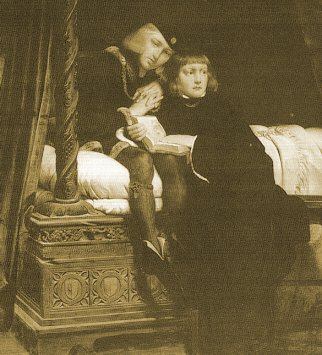 1483 Edward V
1483 Edward V
The Two Princes, young Edward and his brother, were killed in the Tower of London, supposedly by their uncle, Richard, who later became King. 1483-1485 Richard III
|
Historical Timeline: Reign of Kings - House of Tudor
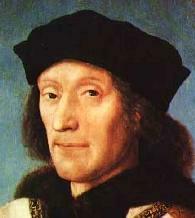 1485-1509 Henry VII
1485-1509 Henry VII
Henry Tudor, last heir of the House of Lancaster, defeated and killed Richard at the battle of Bosworth. He married Elizabeth of York, reuniting the two families. Known to be tight with money, after sixty years of bitter civil war he left his son a peaceful kingdom and a full treasury. 1492 America discovered by Christopher Columbus.1496 John Cabot maps the coast of North America under commission to Henry VII. Historical Timeline: Reign of Kings 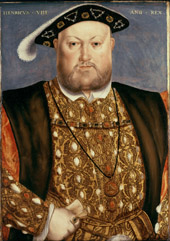 1509-1547 Henry VIII
1509-1547 Henry VIII
Henry made England a great nation that could deal on an even level with France and the Empire. However, he broke with the Catholic Church over his divorce from his first wife, Catherine of Aragon, the aunt of the Empereor. He then established the Church of England with himself as its head. Importantly, the north and west of England, being much more conservative than the cosmopolitan southeast, remained strongly Catholic in attitude and practice. Henry eventually married, and made Queens of, six women. Catherine of Aragon (the mother of Queen Mary), Ann Boleyn (the mother of Queen Elizabeth), Jane Seymour (the mother of King Edward VI), Anne of Cleves, Catherine Howard and Catherine Paar. The following rhyme tracks their individual fates: Divorced, Beheaded, Died. Divorced, Beheaded, Survived. |
Based on the advise of Nicolette Heesom, I've expanded my search into the names Easom, Eassom, Esom, etc., in Yorkshire and have been surprised at the number of findings that clearly belong to families that usually ran under the surname of Hesom or Heesom. Apparently that dropped-H thing of Pygmalion is no joke.
"Hear them down in Soho Square,
Dropping "h's" everywhere.
Speaking English anyway they like.
. . .
Hear a Yorkshire man, or worse,
hear a Cornishman converse.
I'd rather hear a choir singing flat." - from "My Fair Lady - Why Can't The English?"
| Easam
While my going in position is that Easam is simply a dropped-H, phonetic spelling of Heesom (or Heysham), I must point out that Easam has been used in other ways. It is several times used to refer to the village of Evesham, in Worcestershire. Charles I wrote a letter from Easam, meaning Evesham, in 1644 - from "Memoirs of Prince Rupert, and the Cavaliers" by Eliot Warburton. Shakespeare also used this name for the town of Evesham. Worcestershire is, however, pretty far south to have been the origin for what was mainly a surname of northern England. Easam or asam is a Celtic word, meaning to make [create] or to do. However, this appears to be pronounced with an open e, like in bell or less, as e'sam. I think the family name was predominantly pronounced with a long e, as in bee. The Easam surname appears to be most common in Northamptonshire, and rather less so in Yorkshire or Lancashire. There was a William Easam living in Cockerham, Lancashire. This is in close proximity to the Heysham of Highfield family. A surname-search website claims that this "interesting and unusual surname is of early medieval English origin, and is mainly found in northern England or Scotland . . . The surname was first found as Ayson, then Esson, and in the modern idiom has many variant spellings including: Eason, Easom, Eassom, Easun, Easson and Esson . . . The first recorded spelling of the family name is shown to be that of John Ayson, which was dated 1392, in the "Acts of the parliaments of Scotland", during the reign of King Robert 111 of Scotland, 1390 - 1406." I have noted, however, that the family name almost always ends in an "m," and rarely, except in transcription errors, in an "n." EshamThis name is a known variant of Heysham. Could it been a version of Isham? |
The Emigrant from Lancashire? Note that in 1646 Heysham parish, Lancashire, was referred to as "Hesom parish" in the House of Commons Journal. I propose that sometime during the 14th or 15th century, when times were hard in the north, a junior member of the Heysham family came over the Aire Gap to find greater opportunity in the emerging manufacturing centers in and around Wakefield.
The story I tell of this family is of an eastward migration, moving from the region around Wakefield, in the West Riding of Yorkshire, down the region's rivers, to the area around Hull in the East Riding. The red dot in the map below denotes Crofton, the birth place of the American emigrant, John Hesome.
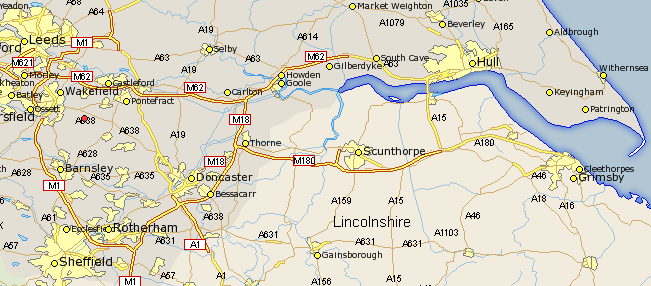
| England at the beginning of the 16th Century
1500 - The Archbishop of York died of the plague. 1529 - Cardinal Wolsey fell from power, having failed to attain a divorce for the King. 1536 - "York suffered a severe shock when eighteen of its churches and all its chapels, hospitals, and monasteries were suppressed, and their materials and revenues converted to secular uses; the priests, the nuns, the sick and the old, being all turned out of their asylums, to starve, or beg their bread. In consequence of these sequestrations, and the alteration made in the established religion, a formidable insurrection was raised in Yorkshire, by Robert Aske, of Aughton, a gentleman of great courage and influence, who, with his colleagues, professing to take up arms in the cause of religion, called their march the pilgrimage of grace, and soon collected 40,000 men under their standard. After taking York, Pontefract, and Hull, they were obliged to capitulate at Doncaster . . ." 1550 - "The Sweating Sickness, which either "mended or ended" its victims in twenty-four hours, carried off in this year many hundreds of the inhabitants of Leeds, York, and their neighbourhoods; . . ." - from "The Annals of York, Leeds, Bradford, Halifax . . ." |
The man at generation (14) had, perhaps, two sons, who, after growing up together, lived out their adult lives near each other in the adjoining towns of Barnsley and Royston. I've argued on the Heysham's of the Midlands page that the existence of two Heysham family's in seperate communties in generation (15) indicates that the family may have been in the shire for a couple of generations.
(15) Raphe Hesome (c1550), of Barnsley, the Progenitor
(15) Agnes Haysome (c1550), of Halifax, which is about 30 miles northwest of Wakefield
(15) Richard Esom (c1560), of Royston, which is just northeast of Barnsley
(15) Elizabeth Esum (c1564), of Barnsley
Historical Timeline: Reign of Kings
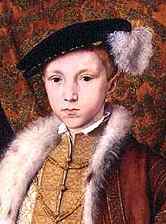 1547-1553 Edward VI
1547-1553 Edward VI
The son of Henry VIII and Jane Seymour, Henry's third wife. He was a sickly boy and, in 1553, he died. The Duke of Suffolk led an uprising to put his daughter, Lady Jane Grey, on the throne. Jane, who was in line for the throne after Henry VIII's daughters, was favored by those who feared the return of Catholicism under Mary. Elizabeth supported her sister Mary in putty down this rebellion. The elder sister of Edward VI, she was the daughter of Henry VII and Catherine of Aragon. Known as Bloody Mary, she made many martyrs in her attempt to re-establish the Catholic Church in England. She married King Philip of Spain, which led to another quickly squashed revolt in 1554. They had no children. Calais, the last English possession in France, was lost during her reign. In this defeat England was finally forced to turn away from her dreams of an empire in Europe to that of a empire of the sea. In 1558 Mary died, childless, and her sister, Elizabeth, was crowned. |
The town of Barnsley is only about 65 driving miles southeast of Lancaster. The parish registers of England began to be kept in the mid-16th century, created upon the orders of Henry VIII's Chancellor, Thomas Cromwell. This is why so many English genealogies commence at this point.
(15) Raphe Hesome (c1550)Possibly my Tenth-Great-Grandfather. The Hissem/Heesom family Y-DNA is G-Z38868.* This clade emerged in about 1100 AD, but it is predicted that our most recent common ancestor for this type was born between 1500 and 1600 AD. Those dates encompass the births of Raphe, William and George Hesome. That would mean that all the members of our family in America and Yorkshire, England are part of this clade. It is unknown if the Heesoms of Warrington are part of this group as well; I don't have a paper trail for them showing when their line branched off. If the Heyshams of Lancaster are related to us, then they would most likely have a most recent common ancestor amongst one of the ancestor clades.
*The lineage is: L497>CTS9737>Z1817>Z727>CTS2230>Z726>Z36217>Z38858I don't know where Raphe was born, the parish records for Barnsley began after his supposed date of birth. I believe Raphe was a descendent of the Heysham's of Lancashire, but DNA evidence from that family is needed to prove this point. The split in the family probably occurred early, say in the turbulent 14th century, making (14) William Heysham (c1520-1540) of Lancashire a cousin several times removed, at best. The DNA evidence does show that John Heesom of Burlington, New Jersey, the first of the Hissem family in America, came from Yorkshire. Raphe, and Richard Esom of the neighboring Royston, below, are his most most likely ancestors in this generation.
| Raphe vs. Ralph
The traditional pronunciation of the name Ralph rhymes with "safe." The "l" is silent in many English words, including, for example, calf, talk, and yolk. Oh, and I believe golf was originally pronounced as /gowf/ until we non-Scots began to mispronounce it. I believe there's a joke in the movie "Caddy Shack" about this. According to Ralph Wedgwood, USC, "The emergence of the pronunciation . . . seems clearly connected with the Great Vowel Shift, since it is around this time that people in Southern and Central England start interchangeably spelling their names both "Ralph" and "Rafe"." The name Ralph is Germanic, and means counsel of the wolf - kinda "Game of Thrones," huh? |
Known as Ralphe Hesome, Hisome, Hesum, Esum or Esume per the records of his children's baptisms. I've also seen a reference to Raphe Exum as being the same man as Raphe Esum.
Raphe Hesome married Jenet Byrkenshawe on 9 August 1576 in Barnsley, Yorkshire. The wedding probably took place at St. Mary's church where six of their children were christened. That church does not survive, the present building having been reconstructed from the old one. From the date of birth of their son, William, below, this appears to have been a shotgun wedding. A recent history I read indicated that as many as half of the brides of this period were pregnant on their wedding day.
At this time Barnsley probably had no more than 600 inhabitants.
Raphe Hesome died and was buried on 8 January 1617 in Barnsley, Yorkshire- from the "Parish Register Barnsley, Yorkshire," as provided by Kaylene Griffin.
Another family researcher, Kristopher Hissam, says the following shows Jenet's burial in 1617. I'm not sure since her married name was not used. Shouldn't it refer to Hesome?
[St Marys, Barnsley]
"Burials for the year of our Lord 1617
. . .
Jenet Birkenshaw was buried the 2 day of December" - from West Yorkshire, England, Church of England Baptisms, Marriages and Burials, 1512-1813
Jenet had several brothers, Robert, John, Thomas and Richard [Byrkenshawe, Birkinshaw, Burkynshawe]. All were having children in Barnsley in the same years as Jenet. Thomas Birkinshawe married Elizabeth Dransfeld on 15 January 1573 in Barnsley. Rychard Burkenshawe married Anne Batt [Bett] on 12 November 1574. Birkenshaw is the name of a village in West Yorkshire, northwest of Barnsley.
Burkinshaw's lived in Barnsley into the 19th century.
At this same time (16) John Easom (c1550) was having a family in Frodsham, Cheshire.
| Barnsley
A chapel-of-ease dedicated to St. Mary was built by the monks in the 12th century. The present church was rebuilt from the old one in 1821 in the Perpendicular style. The parish register starts in 1568. In 1249 the town was granted a Royal Charter with the right to hold a weekly market on Wednesdays and a four-day fair at Michaelmas. The town became the main center for the Staincross wapentake, but in the mid-sixteenth century still had only 600 inhabitants. The Industrial Revolution swept away the ancient town and little remains there of the picturesque. By 1750 there were 1,740 inhabitants and just 80 years later topped 10,000. As late as 1832 Barnsley was still relatively isolated, a regional center of the linen industry as it had been for a century; there were 4,000 hand-looms in the town, one for every adult. However in 1840, with the arrival of the railroad, the coal industry gained prominence and put an end to linen manufacture. The town became known as Black Barnsley as a coating of soot descended on the city. The economy collapsed in 1980 with the closing of the mines. Today city boosters are attempting to sell the town as a "Tuscan hill village." It has been designated a "Renaissance Town," but that has the ring of "most improved" about it. A modern view of the Dearne river valley below. 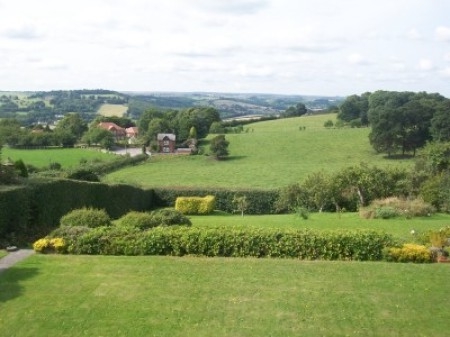 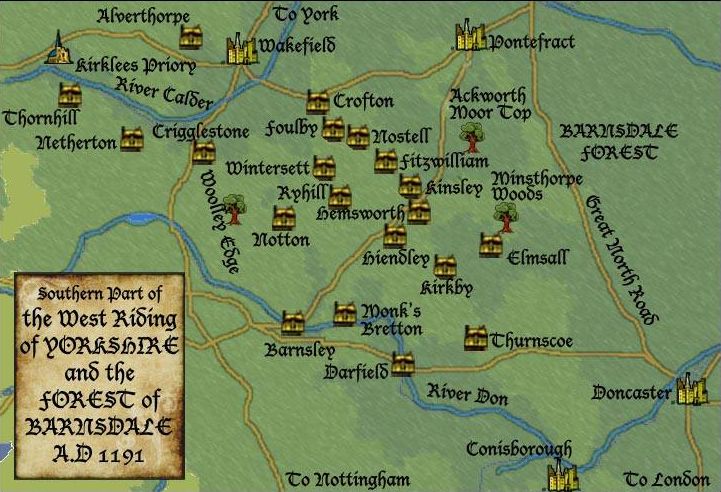
|
| Birkenshaw
"BIRKENSHAW, in the township of Gomersall, and parish of Birstall; Morley-division of Agbrigg and Morley, liberty of Pontefract; 5 miles from Bradford, 8 from Leeds, 9 from Halifax." - from GENUKI. It is northwest of Wakefield and almost in Bradford. The Birkenshawe FamilyThomas Byrkenschay born on 20 June 1539 in Rothwell, Yorkshire, the son of Thomas (c1510). However, they seem to have stayed there. There was a Jane Byrkynshawe, the daugther of John, baptized there on 16 July 1542. Rothwell is a market town southeast of Leeds. Elezabet Byrkyngshay was baptized in September 1550 in Kirkburton, Yorkshire, the daugthter of Wyllmi (c1520). Robert Byrkyngshay was also having children (5) in Kirkburton at this time. Kirkburton is a village 5 miles southeast of Huddersfield. Henry Birkenshaw was born in about 1549 in Swillington, Yorkshire, the son of unknown. Swillington is near Leeds. Henricus Burkynshawe was baptized on 2 February 1556 in Halifax, Yorkshire, the sone of Omfridi. Halifax is near Calderdale. Of Barnsley: John Byrkensawe (c1550) Thomas Birkinshawe/Byrkenshawe/Burkynshawe (c1550) Rychard Burkenshawe Jenet/Jane Byrkenshawe married Raphe Hesome on 9 August 1576 in Barnsley. Helena Byrkenshawe married Robert Cardinall on 4 September 1598 in Barnsley. Birkinshaw's were living in Barnsley in 1851 |
Raphe and Jenet's children were, of whom, only William's line survived.
(16) William Hesome (1576), who died young
(16) William Esom (c1577), the Surviving Line
(16) John Hisome (1578), who died young
(16) John Esum (1580), who died young
(16) John Esume (c1585), male line dies out in generation (17)
(16) Raphe Esum (1581), the sailor
(16) Dorythie Esum (1585)
(16) Sara Hesum (1587)
Historical Timeline: Reign of Kings
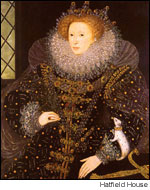 1558-1603 Elizabeth I
1558-1603 Elizabeth I
Called Gloriana. She was one of the greatest monarchs of all time, and was so attested by even her great enemy, the Pope. She brought the realm good government, good coinage, and, most importantly, peace. Her rule created the basis for the country's great leap forward in economics, military power and artistic achievement. After the execution of Mary, Queen of Scots, the Spanish King, Philip, sent the great Armada to subdue England and bring the country back to the Catholic faith. This force was destroyed in a series of fleet actions and by bad weather. The populace was exhilarated by this achievement. The first attempts were made to colonize America, but without success. In 1570 the population of England and Wales is estimated to be about 4 million. |
| The Theater in England
The Hesome family of Barnsley might have journeyed the short way to Wakefield to attend the Wakefield Mystery Plays, a series of thirty-two mystery plays performed around the Feast of Corpus Christi. These were performed from the late Middle Ages until 1576, when they were censored by an aggressive Protestant church. The Tudor Theater before Shakespeare In the middle of the 16" century there were companies of strolling actors and musicians who performed in town-squares, inn-yards and manor houses. However, in 1572 Queen Elizabeth issued a decree against vagabonds, so many of these companies enlisted as servants of some peer and began to settle down. In 1576 the company of the Earl of Leicester's Men built the first playhouse, in London, and called it "The Theatre," using the Greek word for the first time in England. Most of the early plays have been lost. Titles like "The Cruelty of a Stepmother" and "Crack Me This Nut" indicate why they might not have been saved. An early influence on English theater were the comedies of Terence and Plautus. Their humor tended to be broad, the plots often included mistaken identities, and they used stock characters: Senex, the miserly father, Miles Gloriosus, a boastful but cowardly soldier, Erronius, a befuddled old man, and Pseudolus, the false and cunning slave. University students began to put on their plays early in the 16th century. The earliest English play was "Ralph Roister Doister," written in 1552. It was based on the earlier Roman comedies and included stock characters, a brutal physical comedy, and a moralizing conclusion. The giants of Elizabethan theater were Christopher Marlowe (1564-1593), Ben Jonson (1573-1637) and William Shakespeare. |
The son of Ralph Hesome. He was christened on 28 December 1576 in Barnsley, Yorkshire, England. He died on 11 February 1577.
(16) William Esom (c1577)
My Ninth-Great-Grandfather. While I have no record of his birth or christening, I suspect he was Raphe's child, named in honor of his deceased older brother, who had died so soon before his birth. We know of him through the baptismal records of his children. Their surnames included Esam, Esom, and Esum. These dropped-H versions of our surname were common in Yorkshire. Alternately he could have been a son of Richard Esom of Royston [Raphe's brother?]; Barnsley and Royston lie next to each other.
William made his home in Normanton, which is in the Wakefield region.
| Normanton
"In Normantune there are 10 carucates for geld, which 5 plows can plough. 2 thegns had 2 manors there T.R.E. Now, in the King's hand there are 6 villeins there, and 3 bordars, a priest, and a church, with 3 ploughs, 3 acres (12,000 m2) of meadow. Pasturable wood (land) 6 furlongs in length and 1 in breadth. The whole of this land lies in the soc of Wachefelt, except the Church. T.R.E. it was worth 12s: now (it is worth) 10s." - from the Domesday BookNormanton was originally surrounded by a moat, and in Norman times was the site of an enclosed settlement (chosen for its strategic view points across the surrounding area), and became known as 'Norman - tune', or 'Norman - ton'. - from Wikipedia.
The village remained very small until the 19th century. |
| Epidemics
Typhus was common in prisons, and in crowded conditions where lice spread easily, where it was known as Jail fever. Jail fever often occurs when prisoners are frequently huddled together in dark, filthy rooms. Imprisonment until the next term of court was often equivalent to a death sentence. It was so infectious that prisoners brought before the court sometimes infected the court itself. Following the Assize held at Oxford in 1577, later deemed the Black Assize, over 300 died from Epidemic typhus, including Sir Robert Bell Lord Chief Baron of the Exchequer. The outbreak that followed, between 1577 to 1579, killed about 10% of the English population. |
In 1593 the bubonic plague returned to England, ravaging the area around Wakefield. It returned in 1624, 1645, and 1665.
William's children were the following, of whom, only Georg's line survived.
(17) Janne Esam (1600)
(17) Ursula Esam (1602)
(17) Betteris Esam (1604)
(17) Frauncis Esom (1607)
(17) Estar Esum (1609)
(17) Thomas Esom (1611)
(17) George Hesome (c1600), the Surviving Line
Historical Timeline: Reign of Kings - House of Stuart
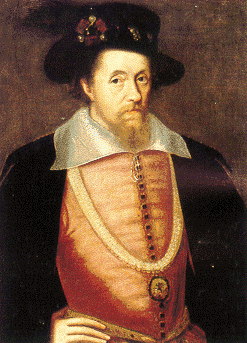 1603-1625 James I
1603-1625 James I
King of Scotland and son of Mary Queen of Scots. He gains the English throne through a sister of King Henry VIII. 1605 Guy Fawkes, a Catholic, arrested in an attempt to blow up Parliament. Severe penalties on Catholic recusants follows. 1607 Revolt in Northamptonshire, Warwickshire and Leicestershire against the enclosure of common land. At this time a belief in witchcraft was widespread and at this time the jurisdiction for such cases was moved from the church to the state. There were many cases brought forward in the midlands during the early 1600's. |
Janne [Jane], the daughter of Wyllyam Esam, was baptized on 13 July 1600 in Normanton, Yorkshire, England. Normanton is just north of Crofton.
(17) Ursula Esam (1602)Ursula, the daughter of Willia. Esam, was baptized on 6 June 1602 in Normanton, Yorkshire, England.
(17) Betteris Esam (1604)Betteris [Betty, Elizabeth], the daughter of Wm. Esam, was baptized on 26 August 1604 in Normanton, Yorkshire, England.
(17) Frauncis Esom (1607)Frauncis [Francis], the daughter of Willm. Esom, was baptized on 1 April 1607 in Normanton, Yorkshire, England.
(17) Estar Esum (1609)Estar [Esther], the daughter of Wyllyam Esum, was baptized on 16 April 1609 in Normanton, Yorkshire, England.
(17) Thomas Esom (1611)Thomas, the son of Willm. Esom, was baptized on 6 September 1611 in Normanton, Yorkshire, England.
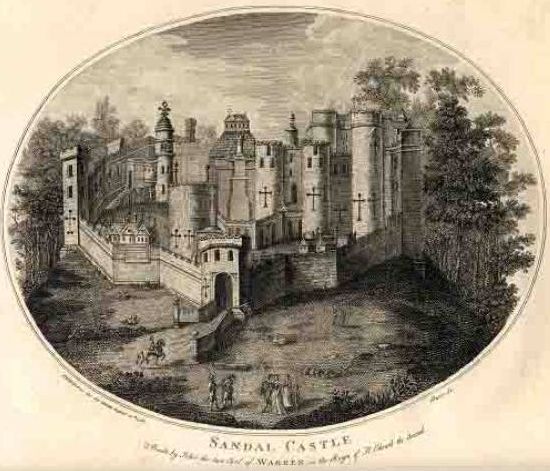
The only surviving line of (15) Raphe and (16) William Esom, above. As I show it, George Hesom, below, is the progenitor of all the Heesom's of West and East Yorkshire, and of those of America as well. DNA evidence shows that the East Yorkshire and American families share a common ancestor about 10 to 12 generations ago. I believe that ancestor was George Hesom.
(17) George Hesome (c1600) of CroftonMy Eighth-Great-Grandfather. If he was the son of William, as I believe he was, he would have been born in about 1600 in Normanton, a village just north of Crofton. George was living in Crofton as early as 1629, when his son William was born there. His children, all born in the same village to a man named George, had surnames Esom, Esum, Esume, Easom, Hesom, Hesum, Heesom, and Heysom. That being said, I think it not unlikely that George fit with the siblings surnamed above as Esam, Esom and Esum, all being born in the first decade of the 17th century. Of course, this would all work better if I could find a record of George's birth.
George was a farmer in a region of many independently owned farms. The local lord, who owned the Manor of Wakefield, exerted his authority from Sandal castle, pictured to the right, in Wakefield. George, though I think I can show he was a prosperous and respected yeoman, would have doffed his hat for such a man, and perhaps even pulled a forelock. His great-grandson in America, Thomas Hesom, would, in contrast, violently support a revolution against such a system.
George Hesam married Briget Preston on 29 August 1626 in Warmfield, Yorkshire - from England, Yorkshire, Bishop's Transcripts, 1547-1957 at familysearch.org. Warmfield is a parish-town, four miles east of Wakefield and just a couple of miles north of Crofton. Note that the first known child of George was born in 1629. Her father was probably either Walter or Robert Preston of Warmfield, both of whom were having children circa 1610.
| Crofton
The village was listed as Scroftune in the Domesday Book of 1086. In the 12th century the manor belonged to Henry de Lascy [Laci]. A grammar school was mentioned in Duchy of Lancashire records in 1373 and continued in existence at least through the reign of Queen Mary. Its Anglican church was built around 1430. There are two halls, the oldest opposite the church and the other opposite the rectory at the foot of the hill, on which the greater part of the village rests. The Ireland family owned the Crofton estate from the early 17th century to the middle of the 18th century. Crofton had minor play during the War of the Roses, in 1460, when a Lancastrian army marched out of Pontefract castle, and through Crofton, on its way to Sandal castle, near Wakefield, where they defeated the Yorkist force, and killed the Duke of York. Crofton is on the Doncaster road, which connects Wakefield and Doncaster. Wragby and Ackworth are further southeast on the same road. There was a toll gate at Crofton on the Doncaster toll road circa 1633. The majority of the West Riding family apparently lived here, and in Wragby the next village to the east. Beside being the home of the Hesom family, the village had other fames: Charlotte and Emily Bronte lived at Crofton Hall, a girls' private boarding school. The man who solved the problem of longitude, John Harrison, also lived in Crofton. 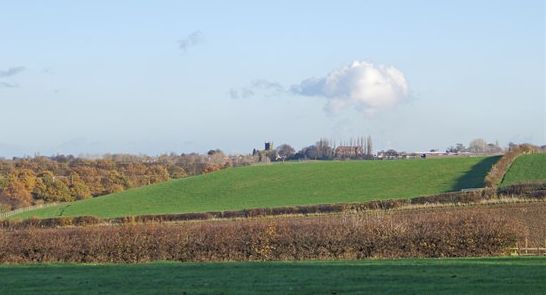 Wakefield manor was one of the largest in the country and comprised 118 towns, villages and hamlets with Halifax, Wakefield and Dewsbury being the chief towns. In 1607 the manor was under the control of the Duchy of Lancaster, which was itself owned by the crown. In 1624 Henry Rich was given the manor by Charles I, which then passed to Henry's son-in-law, Sir Gervase Clifton in 1649. In 1663 the manor was sold to Sir Christopher Clapham. Crofton was just outside the limits of the manor. 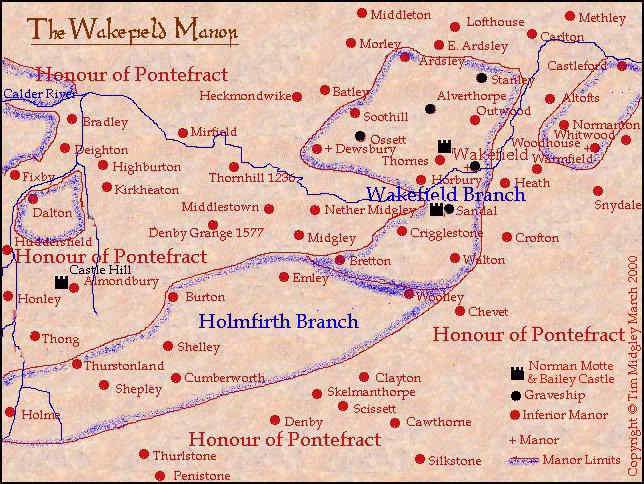 "All Saints, Crofton. Situated at the top of Stocks Lane, Crofton (a large village to the South East of Wakefield, West Yorkshire). The original churchyard surrounds the church. This has been extended to an adjacent piece of land, which is now the local authority cemetery. The records of the original churchyard were made in 1987 by Allan Pease, of Ackworth, and a handwritten copy of these is in the Yorkshire archives in Leeds. Chris Hollins of Crofton has compiled the attached records [in Findagrave.com] from these 1987 originals, visits to the graves and photographs of each gravestone. He is now working to transcribe the graves in the adjacent cemetery." (18) Edward Hesom (1642/4), his son, Mathew Hesom (1671), and his grandson, Edward Hesom (1698), are buried in the churchyard. Nostell Priory Just to the east of Crofton, and on the other side of the Doncaster road, was a priory dedicated to St. Oswald. See John Hesham (c1425), above, a priest of the York diocese, and his relations with the Nostell priory. "The priory was a 12th-century Augustinian foundation, dedicated to St Oswald, supported initially by Robert de Lacy of Pontefract, and Thurstan of York. By about 1114, Aldulf, confessor to Henry I of England, was prior of a group of regular canons at Nostell. Sir John Field, the first Copernican Astronomer of note in England, is believed to have studied at Nostell in his youth under the tutelage of Prior Alured Comwn. As part of the Dissolution of the Monasteries, the priory was closed in 1540. After the dissolution the lands of the priory came into the possession of Sir Thomas Gargrave, a High Sheriff of Yorkshire, Speaker of the House of Commons and president of the Council of the North.  |
| A Farmer in the Early 17th Century
Almost everyone kept a pig. They are the simplest, though smelliest, animal to raise, requiring no field to live in and eating scraps and human waste; the human's outhouse was usually located next to the pig pen. Pigs were also grazed in the forest, eating acorns and clearing the underbrush. In the autumn the young pig, now well grown, would be butchered. The meat was cured, either by salting or smoking, to preserve it for up to two years. Pork was the main meat of the Tudor peasant. SheepSheep were an important part of the Tudor economy. The quality of English wool was famous all over the known world and it was exported to the Low Countries, where it was spun and weaved into very fine cloth and imported back into England. Sheep were relatively low maintenance on a farm. They didn't need the top quality grazing of the cattle, they were hardy enough to stay out all year round, just brought down to lower more sheltered land in winter, a shepherd could tend a large flock, and they gave more produce than just their wool. The Tudors used more sheep's milk than cow's milk. Only the very rich would have lambs slaughtered for meat. Most people kept their sheep for the other products until they were older, then cooked and ate mutton. HorsesThe native breeds of horses in Britain are classified as ponies and despite being very strong as riding animals they are not built to pull ploughs. The heavy horse breeds were brought from the continent, from countries like France and Belgium, so they are expensive to buy. They also require better grazing to keep them in top condition and must be stabled in the winter. Oxen/cattleUnlike today when cattle are kept for milk and meat only, In Tudor times they were working animals. Oxen, generally a castrated male, were kept to pull the plough, harrow and other farming implements. Enough were kept on a fair size farm to have a few breeding cows to keep the team going. The excess milk from these was made into butter and cheese, and a small amount for the very young, very old and sick to drink. Smaller farms would have shared a team of oxen. A team of two oxen could, in a day, plough an acre, roughly the size of a Tudor field. At the end of their working life the meat was eaten and their skin turned into leather. Geese, Chicken and other BirdsLike pigs, almost everyone kept chickens. These were used to produce eggs, eat insect pests in the garden, and then eventually to be eaten. A dovecot could be kept above the henhouse for squab. Geese were also kept for eggs, meat, pest control and as useful watchdogs as the Romans knew. There were also many wild birds that were harvested, including the "four and twenty blackbirds baked in a pie." Tudor Crops WheatUntil the Americas' were discovered there were no potatoes, so the main "filler" at meal time, for every class, was bread. To raise wheat, first the field would have to be ploughed, breaking up the soil and turning it over, lifting out the weeds and turning them back under with each furrow. This would have been done by a man and his team of oxen using wooden plough, probably with a metal piece made by the blacksmith on the cutting edge. The field would then have been harrowed, using a large rake-like implement pulled by the team. It would break the large clods of earth down to a fine tilth. Finally, the seed would have been sown. The general practice was to get this done in autumn or early winter. If left to the spring the ground would be too wet and cold. As the wheat started to sprout in spring it was very often the job of the children to go out into the fields and be human scarecrows to keep the birds off the crop. Weeding by hand was done several times in the early stages of growth. A poor harvest meant that people went hungry, or even starved. The wheat of that time was different. The stems were much longer and, when dried as straw, were used for thatched roofs, bedding for animals, and, for the poorer classes, in mattresses. The harvested wheat was bundled up and put into "stooks" round the field to dry, then moved to large barns. Since it is very difficult to steal much wheat when it's kept in bundles on the stem, and it keeps better this way; the ears of corn were thrashed as and when needed. When needed, the bundles of wheat were placed on the floor of barn and beaten with flailrs - two pieces of wood loosely joined with leather so that one piece was held in the hand and the other piece could be swung around - and the grain would drop onto the floor. It was then winnowed to separate the grain from the chaff. Large wicker baskets were used to scoop the wheat off the floor, then this was thrown up in the air. The chaff, being lighter, was carried off by the breeze and the grain would drop back into the basket. The chaff was later collected to feed to the animals. The grain was then taken to the miller to be ground into flour. The local landowner owned the mill and a percentage of the flour was collected in payment and taxes. It was against the law to mill your own grain. BarleyBarley was grown to brew the ale that everyone drank from the age of four. The local water supply was generally unhealthy, being polluted with human and animal waste. This ale wasn't the strong beer we know today. The first brewing with fresh malt was the one that would be the strongest and would keep the best, this was for high days and holidays. As the malt was reused so the strength of the ale went down, and so did the length of time it would keep. The last brew was often called "small ale" and drank daily by everyone, including children. Peas and Beans Peas and beans were grown because they could be dried and kept for use during the winter. A kitchen garden provided fresh produce during the spring and summer. HayMeadows were left with the grass growing long, then in early summer - and hopefully a second crop later - the grass was cut and left to dry, being turned in the sunshine. This hay was then collected, built into a haystack and kept for feeding the livestock, like the oxen, through the winter. WoodlandWoodland would be divided up into sections with each section being harvested every 7 - 14 years. Within a certain area a few trees would be allowed to grow and mature. These were called standards. These standards would be for the timber frames of the houses and barns, ships timbers, and anything that needed long, thick trunks. The rest would be harvested when smaller to provide wood for tool handles and other small items. All the poor were allowed to run their pigs in the landowners' woodland. The pigs got fed, they fertilized the land, and ate the scrub that competed with the maturing trees. All were also allowed to collect fallen branches for cooking. It was illegal, however, to break off branches or cut down trees that were not on your land. |
George's sons included William and Edward Heysome, who are noted below as being church wardens at All Saints church, Crofton.
"The Crofton parish registers begin 22nd June, 1617, and from the first we find the names of families still existing here or in the neighborhood; whilst later occur other well-known names. I give a list in the note [D], marking in italic the surviving names, and adding a few interesting particulars."The churchwarden was an important position given to the more responsible men of the community. I assume that George, the father of these responsible men, was of a similar complexion; sober, serious, frugal, and foresquare in his religious views.
"D. Scholey, Lee, Jubge, . . . Heesome (also Esham, Hesam, Heasom, Heysome 1678), . . . William Heysome, churchwarden, buried 1678; Edward Heysome and George Firth, churchwardens, 1678." - from "Walk in Yorkshire; Wakefield and Its Neighborhood" by Willima Stott Banks, 1871
The Churchwarden of All Saints Church, Crofton
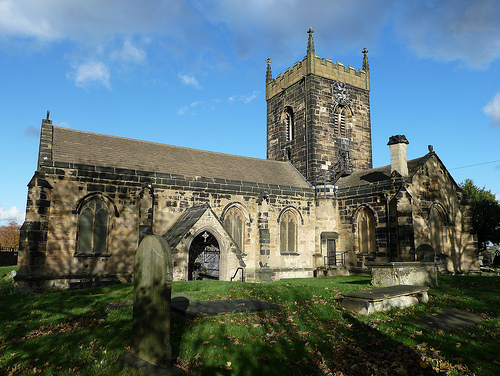
The role of the churchwarden originated in the 13th century under the title of parish procurator. They were responsible for all moneys coming into and out of the parish, including tithes, for the repair and maintenance of the church, churchyard and parish properties, as well as the vestments and sacramental vessels, and for the poor relief. In a small parish such as Crofton they would be responsible for maintaining an account of the money in hand or in deficit. This account was passed from one office-holder to the next at Easter each year. Churchwardens' accounts therefore normally run from Easter to Easter, and were summed and approved at an annual vestry meeting. Churchwardens were also responsible for collecting pew rents. Until the late 19th century church pews were sold freehold, and the remainder rented out; your position in the church reflected your status in society. The position of churchwarden was undertaken by the more well-to-do members of the parish. They were "principal parishioners," "substantial members of the community" and a "cross-section of the upper half of parish society." "Holding the office of churchwarden was a mark of status and honour within local communities that was rarely spurned."So highly was the office regarded that a William Parker bribed the rector's brother with a side of bacon in order to be made churchwarden because he "affected to be accounted somebody" in the parish. The office marked its holder as a man trusted by his neighbors. In a village it could be the highest office to which one could aspire. The duties of the churchwardens were not standardized, but evolved in relation to the needs of their community. The churchwardens were elected by the congregation on an annual basis. They were an important part in the town's self-government and represented the parishinoers in non-secular matters in a quasi-democratic fashion. In the reign of Henry VIII the churchwardens began to be assigned civic duties. These included providing arms for soldiers and relief for maimed veterans. For the purposes of the Reformation, they performed the important duty of enforcing conformity to the new religious settlement. This included the requirement to attend church and prohibiting Roman Catholic rites. These types of duties, and the fines they collected for transgressions, transformed the churchwardens from being the agents of their community to its enforcers. However, most churchwardens dealt with this conflict by concealing violators, perferring to perjure themselves rather than expose their neighbors. After the Restoration the number of men holding the office dramatically declined and the length of time they served increased; that is, long consecutive terms became common. Much of the proceeding was taken from "The World of Rural Dissenters" by Margaret Spufford. |
| The Scholey/Schooley Family
Could the Scholey family of Crofton, noted above in the parish register, have included John Scholey, who settled in Burlington, West Jersey about the same time as did John Heesom? Or of Robert Schooley, of Hemsworth, just south of Ackworth, who arrived in Burlington on THE SHIELD in 1678? John Scholey's will was proved on 29 March 1695. His sons were John and Thomas. This man, however, was of Aughton, Aston parish, South Yorkshire [6 miles from Rotherham, 8 from Sheffield]. Or, born in 1609 in Rotherham, Yorkshire, England. He married Elizabeth Fletcher on 13 Apr 1633 in Rotherham. John second married Isabelle Hancock, on 25 February 1659/60 in Sheffield. Handsworth Parish. Mahlon Stacy was also of Handsworth. "John Scholey, a near relative, if not a brother of Robert and Thomas, and the founder of the branch at present under consideration, came from Aughton"Thomas Scholey, of Aston, came to Burlington in the Flie Boat MARTHA in 1677. Robert Scholey, of Hemsworth, came in the SHIELD in 1678. Thomas and Robert purchased a large tract of land on the west side of the Delaware, in Bucks county, Pennsylvania. They relocated to Burlington between 1680 and 1685. John Scholey arrived from England in 1680. Robert Scholey's will was probed on 19 March 1688. His widow was Sarah. At least one branch of the family had connections to the region around Hemsworth and Ackworth. ". . . in 1441 a William Scolaye of Horncastle Lincolnshire had expressed in his will a desire to be interred in the Chantry of Hemsworth Church. Yorkshire. At this point the American Schooleys should be recalling that one of the original migrants to America, Robert Scholey (Schooley), was born in Hemsworth. The Scholeys and Hemsworth Church were firmly connected, Hunters History of South Yorkshire lists the Rectors of Hemsworth and gives John Scolaye as being the Church Patron and on 24th May 1506 he became Incumbent of the Chantry of St Thomas of Hemsworth.Could this John be the man identified as from Aston?
Scholey's of Crofton included:
|
Historical Timeline: The Stuarts:
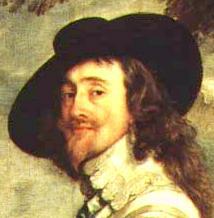 1625-1649 Charles I
1625-1649 Charles I
Religious conflicts accelerated. Charles was an ineffective King, stubborn when he should be conciliatory, irresolute when he should be strong. Unable to work effectively with Parliament, the King dismissed them. Charles I's period of personal rule included his many attempts to raise taxes through old and new means.
The Virginia colony was loyal to the King, but a fleet loyal to Parliament forced it to acquiesce. 1645 Sir Thomas Fairfax and Oliver Cromwell's Parliamentary troops defeated King Charles' army at the battle of Naseby.1647 Folk dancing and bear bating banned by Puritan Parliament. Feasts of Christmas, Easter and Whitsun abolished. Levellers push to abolish monarchy. |
I don't have any evidence of George's birth nor direct ties with either Barnsley or Normanton, other than that Crofton lies between them. However, William Esom of Normanton was the only man with the right surname having children at the right time and at the right place to be George's father. If not his father, William was at least an uncle or cousin.
Two of George's sons, William and Edward, were churchwardens in Crofton. This was an elective position, voted on by the parishioners, who would have chosen men who had led sober, responsible lives to take responsibility for the care and repair of church properties. I suspect this means that William and Edward were farmers of a higher order; monetarily successful and conventional in their ideas. Since we're told that acorns don't fall far from the tree, I will suppose that George was of a similar bent.
The bubonic plague returned to Yorkshire in 1625 and then again in 1645. There was also an influenza epidemic in 1675 that killed many people in the Wakefield region.
| Religious Law
Attendance at church was compulsory and the severity of the religious laws caused much suffering. It was a serious offence to fail to attend church. At Barnsley Sessions in 1682, Thomas Cowper of Knottingley was fined £10 and, refusing to pay, was imprisoned. At the same sessions, Philip Hamerton and his wife; Henry Addison and his wife and two other couples were reported to the Court for being absent from church for three weeks. On the 4th October 1683, eleven Ossett village people were prosecuted at Wakefield for being Dissenters. Two were described as Popish Recusants and nine as Quakers. One of the latter, John Rider refused to take the Oath of Allegiance and was fined £100 and sent to York Castle until the fine was paid. In general, however, the law was obeyed without too much protest. There was still a general belief in faries, the Devil, witches, and multitudes of evil spirits. The Devil was believed to appear at times in person and to be able to take human form at will. A fear, which persisted among young women for a very long time was that they might be deceived into marrying the Devil and then find themselves in a household of "young imps." There was virtually no scientific knowledge or belief in the unchanging links between cause and effect; when things went wrong, the Devil was blamed. |
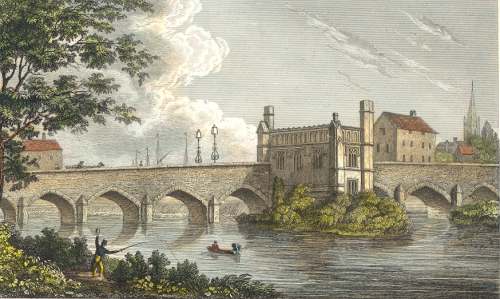
In 1642, when George was in his early 40's, a Civil War broke out between the King and Parliament which was fought in and around his home in Crofton. Parliament had its source of power in the south, especially in London, while the King had his northern headquarters in York. However, the cloth towns of the West Riding favored Parliament. George was likely a supporter of Parliament, of the working man versus the nobs, just like his neighbors, but did he take up arms against his King? The balance of power changed rapidly in the region during this early period and, as a prosperous landowner who was, moreover, "of an age," George had a lot to lose if he chose poorly.
"Popular enthusiasm for the parliamentary cause resulted in great recruiting success in the West Riding clothing towns amongst otherwise largely royalist northern rural areas . . . As the crisis of summer 1642 increasingly dominated pulpit oratory in the West Riding, many ministers, while not advocating rebellion per se, 'had armed their congregation with a clear view of where both right and responsibility lay." - from "Military Leadership in the British Civil Wars."The armies of the King and of Parliament marched back and forth across southern Yorkshire, laying siege to commercial centers and plundering the local populace. Think of the scene in "Gone With the Wind" when a Union soldier enters Tara, already stripped by previous visits, looking for loot. Early in the conflict the Royalist's seized the nearby cities of Leeds and Wakefield without opposition, but were repulsed at Bradford. Scouting patrols and foraging parties from Sandal castle, at Wakefield, would have crossed George's lands, trampling crops and confiscating supplies while he looked on, powerless to stop them.
"The Royalists in Wakefield were under the command of one Lieutenant-General Goring, who it was said was "a man without any scruples, uncertain, unprincipled, who valued neither promises nor friendships and would without hesitation, break any trust or perform any act of treachery to satisfy his passions." He also apparently drank to excess and debauched the local women virtually at will."
In January 1643 Parliamentary forces took back the city of Leeds, then, in May, made a daring night raid on Wakefield. During the extended battle that followed, did local men join in the attack, or at least provide support to the attackers?
". . . However, the Royalists were alerted to his approach and the Parliamentarian force arrived to find the defences manned and musketeers lining the hedges up Stanley Hill on the the outskirts of Wakefield at about 4am. Fairfax decided to press ahead with the attack. His infantry stormed the Royalist barricades in three places and, after two hours of fierce fighting, succeed in carrying one of them and tearing it down. Fairfax immediately led a cavalry charge through the gap and into the streets of Wakefield. Pushing too far ahead, Fairfax found himself almost alone in the market-place and surrounded by Royalist troops; he escaped by jumping his horse over a barricade to rejoin his own troops.However, a Royalist victory at Adwalton Moor, near Bradford, strengthened the King's position, forcing Fairfax to retreat to Hull. The West Riding was hard pressed and warfare continued to be waged from Bradford to Hull. Did George join the local militia to defend his home and family, waylaying foraging parties from the King's army, like the New Jersey militia would do in a later war in America?The Royalists in Wakefield were under the command of one Lieutenant-General Goring, who it was said was "a man without any scruples, uncertain, unprincipled, who valued neither promises nor friendships and would without hesitation, break any trust or perform any act of treachery to satisfy his passions." He also apparently drank to excess and debauched the local women virtually at will. In September 1642, he had been routed at Portsmouth by the Parliamentarians and had fled to Holland in fear of his life. Goring was incompetent and a liability, so Newcastle had given him Wakefield to look after in the hope that he couldn't mess up there as well. On the afternoon and evening before Fairfax's assault on Wakefield, Goring been at nearby Heath Hall with his officers. They spent the afternoon on the bowling green followed by a hard drinking session, so that most of them were still drunk at the time of the attack. It was reported that Goring was ill with fever, but rose from his sickbed to lead a counterattack. It is more likely that he had a hangover and that his officers were in the same incapacitated state.
In the event, the Parliamentarians succeeded in turning captured artillery to fire on the Royalists and a second charge by the Parliamentarian horse broke their resistance. By 9am it was all over and Wakefield was in the hands of the Roundheads. Fairfax and his men were astonished to find that the Wakefield garrison had consisted of 3,000 infantry and seven troops of horse as well as a huge store of ammunition. Fairfax gave orders that no wrong should be done to the townspeople of Wakefield and the inevitable plundering was quickly stopped. In the engagement, Fairfax only lost seven men killed and sixty wounded. The Royalists lost about fifty killed and many wounded. Knowing his forces were too weak to garrison Wakefield, Fairfax marched back to Leeds taking Goring, 38 of his officers 1,500 common soldiers, most of whom were Walloons (Belgians), French and Irish." - from Ossett History
| Yorkshire in the Civil War
In Yorkshire, opinion about the emerging struggle between the King and his Parliament was divided. The Royalist cause was most strongly supported in York and the North Riding, that of the Parliamentary party in the textile manufacturing towns of the West Riding. The important seaport of Hull, while it had a royalist civilian population, was commanded by Sir John Hotham as military governor, and he and the garrison supported Parliament. During the summer of 1642 Charles tried to seize the ammunition stored in the city, but had been forcefully rebuffed. The Yorkshire gentry made an attempt to neutralise the county, but a local struggle ensued and the Earl of Newcastle thereupon invaded Yorkshire with a large force at the beginning of December 1642. He joined hands with the hard-pressed Royalists at York, establishing himself between that city and Pontefract. Lord Fairfax of Cameron and his son, Sir Thomas Fairfax, who commanded Parliamentary forces in Yorkshire, were forced to retire to the district between Hull and Selby, and Newcastle was free to turn his attention to the Puritan "clothing towns" of the West Riding, Leeds, Halifax and Bradford. The townsmen, however, showed a determined front. Sir Thomas Fairfax with a picked body of cavalry rode through Newcastle's lines into the West Riding to help them, and about the end of January 1643, Newcastle gave up the attempt to reduce the towns, for the time being. The Fairfaxes fought in the West Riding with such troops from the region around Hull as they had been able to bring across the Royalist lines. Newcastle, however, was patiently increasing the size of his force. An attempt was made to relieve Fairfax by bringing up the Parliament's forces in Nottinghamshire, Derbyshire, Lincolnshire and the Eastern Association, but these forces could not be maintained in the face of pressure for their return by their home counties. The Fairfaxes were left to their fate. At about the same time, Hull itself narrowly escaped capture by the Queen's forces through the treachery of Sir John Hotham, Hull's governor, and his son, the commander of the Lincolnshire Parliamentarians. The latter had been placed under arrest at the instance of Cromwell and of Colonel John Hutchinson, the governor of Nottingham Castle; he escaped to Hull, but both father and son were seized by the citizens and afterwards executed. The safety of Hull was of no avail for the West Riding towns, and the Fairfaxes suffered a decisive defeat at the Battle of Adwalton (Atherton) Moor near Bradford on 30 June 1643. They escaped back to Hull and reorganised the defence of that place, but the West Riding had to submit to the King. Meanwhile the siege of Hull had commenced. The Eastern Association forces under Manchester moved up into Lincolnshire, the foot besieging Lynn, which surrendered on 16 September 1643, while the horse rode into the northern part of the county to give a hand to the Fairfaxes. Fortunately the sea communications of Hull remained open. On 18 September part of the cavalry in Hull was ferried over to Barton, and the rest under Sir Thomas Fairfax went by sea to Saltfleet a few days later, the whole joining Cromwell near Spilsby. In return, the old Lord Fairfax, who remained in Hull, received infantry reinforcements and a quantity of ammunition and stores from the Eastern Association. On 11 October, Cromwell and Fairfax together won a brilliant cavalry action at the Battle of Winceby, driving the Royalist horse in confusion before them to Newark. On the same day, Newcastle's army around Hull, which had suffered terribly from the hardships of continuous siege work, was attacked by the garrison. They were so severely handled that the siege was given up the next day. As 1644 opened, the cause of Parliament was in the ascendant in Lancashire, Cheshire, Staffordshire, Nottinghamshire, and Lincolnshire. Resistance also revived in the West Riding towns while Lord Fairfax was again in the field in the East Riding of Yorkshire. The end of Royalist ambitions in the north occurred in July 1644 when an army led by Prince Rupert was decisively defeated at the battle of Marston Moor, west of York. In its aftermath Yorkshire troops proceeded to conquer the isolated Royalist posts in their county. The war drug on into 1645, but the north was mostly unconcerned. |
The King's forces held control of the West Riding through 1643 and George would have had to keep his head down, no matter which side he supported. However, in the beginning of 1644 Parliamentary forces out of Lancashire began making bold strikes back into Yorkshire and the Royalists quickly collapsed. Sandal castle, in Wakefield, was held for the King by Colonel Bonivant and suffered siege three times; it finally surrendered to Colonel Overton in October 1645.
The King was beheaded in 1649. After that time Oliver Cromwell ruled, until his death in 1658. See 1642: Civil War in Yorkshire.
| The Commonwealth
The Commonwealth was a republic that ruled England from 1649 to 1660. This was a period of uncertaintly. In the aftermath of regicide the Levellers wanted a more democratic government, Diggers called for absolute equality and communal ownership of land, while Fifth Monarchy Men opposed all earthly government. In a result not unexpected by students of revolution, in the end the army and their general, Oliver Cromwell, ruled, on relatively conservative lines. |
George Hesome, of Crofton, died and was buried on 8 April 1657, just three years after his last child, Jane, was born.
"George Hesome bur: April 8. [1657]" - from "Wakefield, The Parish Registers of Crofton, Co. York, 1615-1812" by William TownsendThe following widow was the relict of a Heesom who had lived in the West Riding.
"Widdow Heesom 3" - from "Yorkshire West Riding Hearth Tax Assessment Lady Day 1672" by David HeyNo Heesoms are found in the hearth tax list for Hull (1673) and the East Riding of Yorkshire for Lady Day 1672, as expected. Lady Day is the Feast of the Annunciation, 25 March, the first of the traditional four quarter days in the calendar. Before 1752 this was also New Years day. January 1st became New Years day in 1752.
| The Hearth Tax
The tax on hearths was the chief source of revenue for Charles II's government. Between 1662 and 1688 it raised about L200,000 a year. Each hearth was taxed at the rate of 2 shillings per annum, payable in two instalments at Lady Day and Michaelmas. - from "Yorkshire Surnames and the Hearth Tax Returns of 1672-3" by David Hey and George Edmonds. |
George's children were the following. The line of Edward survived, as did that of John, in America.
(18) William Hesom (1629), male line dies out in generation (20)
(18) Elizabeth Esom (1633)
(18) Anna Easom (1636)
(18) Saraye Esume (1638)
(18) George Esume (1641), male line dies out in generation (20)
(18) Edward Esume (1644), the surviving English Line
(18) Richard Esum (1646), he died young
(18) Beteres Hesum (1647)
(18) John Esume (1650), the surviving American Line
(18) Jane Heysom (c1654)
| Internal Migration
"In the late sixteenth and early seventeenth centuries, rapid population growth, periodic agricultural depression, and difficulties in England's preeminent industry of textile manufacture disrupted many lives and caused real hardship. Migration offered an obvious escape from unfavorable local conditions." - from "New England's Generation" by Virginia DeJohn Anderson "The most striking features of internal migration in the pre-industrial period were its frequency and its usually restricted geographical range. In eighteenth-century England most people changed their permanent residence at least once in their lives, though few moved more than ten miles from their place of birth." - from "Society and Economy in Modern Britain 1700-1850" by Richard Brown.
"The general laws of internal migration may be summarized . . . as follows:--
"In England internal migrations of considerable proportions preceded mass emigration to overseas countries." - from the Encyclopedia Britannica. An interesting difference between internal and external migration as it affected England was that internal migrants tended to be young and poor, whereas those migrating overseas were older and more affluent. |
Of Crofton. "William Hesom son of Georg Hesom bapt. 18 Oct. [1629]" - from Crofton Parish Records. William, or Willyam, Esume married Ann Robinson on 26 December 1651 in Crofton.
"William Heysome, churchwarden, buried 1678" - from the Crofton parish register as recorded in "Walk in Yorkshire; Wakefield and Its Neighborhood" by Willima Stott Banks, 1871Another source for the parish registers, found in Ancestry.com, shows this event as "William Heysom, Churchwarden buryed 20 Mar [1678]."
William Hesam of Crofton was the father of,
(19) Robert Heesome (1653)
(19) William Heysom (1655)
(19) Ellen Hesam (1660)
(19) Grace Heysome (1663)
(19) Elizabeth Easom (1666)
The son of William Heesome of Crofton. He was christened on 30 October 1653 in Crofton. He married Marth Litlewood on 8 May 1677 in Crofton.
Neither of his male sons appears to have lived to maturity. His children were,
(20) Anne Heysom (1678)
(20) Dorothy Heysom (1680)
(20) Michaell Heysom (1682), dies young
(20) John Heysom (1685), dies young
(20) Grace Hesom (1688)
The daughter of Robert Heysom. Anne Heysom was christened on 27 January 1678 in Crofton, Yorkshire, England. Anne Heesham was buried on 21 July 1694 in Crofton [father not named] - from Publications of the Yorkshire Archaelogical Society.
(20) Dorothy Heysom (1680)The daughter of Robert Heysom. Dorothy Heysom was christened on 25 January 1680 in Crofton, Yorkshire, England.
(20) Michaell Heysom (1682)Michaell, the son of Robert Heysom, was christened on 15 October 1682 in Crofton, Yorkshire, England. "Michael Son of Robert Heesham," was buried on 11 April 1693 in Crofton - from Publications of the Yorkshire Archaelogical Society.
(20) John Heysom (1685)John, the son of Robert Heysom, was christened on 5 April 1685 in Crofton, Yorkshire, England. "John son of Robt Heesom" was buried on 26 February 1692 in Crofton.
(20) Grace Hesom (1688)The daughter of Robert Hesom. She was christened on 28 July 1688 in Crofton, Yorkshire, England.
(19) William Heysom (1655)William, the son of William Esume and Ann Robinson, was born on 10 March 1655 and baptized on 23 March 1655, in Crofton, Yorkshire. Also as "A sonne born to Willia Esham & Anne his wife March 10 [1656], bapt: William March 23 . . ." - from the Crofton parish register. William Heysom married Frances Hall on 20 November 1683 in Crofton.
(20) Helen Heysom (1684)The daughter of William Heysom and Frances Hall. She was christened on 12 September 1684 in Crofton. "Hellen dau: of William Hesom bur: Feb: 10. [1687]" - from Crofton Parish Records.
(19) Ellen Hesam (1660)The daughter of William Hesam of Crofton. She was born on 3 May 1660 and baptized on 13 May 1660 in Crofton.
(19) Grace Heysome (1663)The daughter of William Heysome. She was christened on 17 May 1663 in Crofton. She married George Robinson on 3 August 1685 in Crofton.
(19) Elizabeth Easom (1666)Elizabeth, the daughter of William Easom, was baptized on 5 August 1666 in Crofton, Yorkshire. Elizabeth, the daughter of William Esume and Ann Robinson, who was born circa 1661 in Crofton, was buried on 24 September 1668.
(18) Elizabeth Esom (1633)Elizabeth, the daughter of George Esom, was baptized on 2 September 1633 in Crofton, Yorkshire, England.
(18) Anna Easom (1636)"Anna filia Georgij Easom Bapt: fuit vicesimo primo Feb:". That is, Anna, the daughter of Georgij Easom, was baptized on 21 February 1636 in Crofton, Yorkshire - from the Publications of the Yorkshire Archealogical Society Parish Register Section. I believe that Georgij is just a latin bawlderization of George.
"Georg base sonne of Anne Easom bur: Feb: 7." - from the Publications of the Yorkshire Archealogical Society. Does this mean George was a bastard?
Ann Easam married John Gill on 25 October 1670 at All Saints, Wakefield, Yorkshire, England.
(18) Saraye Esume (1638)Saraye, the daughter of George Esume, was baptized on 23 August 1638 in Crofton, Yorkshire.
George, the son of George Esume, was baptized on 15 August 1641 in Crofton, Yorkshire. Georg Heysom married Sarah Hepworth on 5 November 1667 in Crofton. He then moved to the next village east, which was Wragby.
| Wragby
The real Robin Hood, according to local researchers, was actually Robert Hode, a prosperous knight in the service of Sir Thomas, the Earl of Lancaster. He lived in Wragby before becoming an outlaw upon the fall of Sir Thomas. Nottingham and Sherwood forest are just to the south afterall. See Robin Hood - The Man behind the Myth for more details. Another famous son was John Harrison, the famous chronometer and clockmaker who won the Longitude prize by solving how to determine longitude on long sea voyages. A more modern reference to the village is in D.H. Lawrence's "Lady Chatterley's Lover." In my day this was the adolescent boy's book of choice, especially if the previous owner had underlined all the good parts. Note there is another village named Wragby in Lincolnshire. St. Oswald's Priory, replaced by the 18th century home of Sir Rowland Winn, would have been the most prominent building in the village. The Spread Eagle is the local pub. |
George Heesom of Wragby was buried on 9 September 1701 at St. Michael's, Wragby. Elisabeth wife of George Heesom of Wragby, a second wife?, was buried on 25 August 1747. His children were,
(19) Robert Heesome (1669), died young
(19) Katherine Heesome (1678)
(19) Richard Heesome (1679), died young
(19) George Heesome (1680)
(19) John Heesam (c1683), "John ye Son of Georg Heesam buried 17 Apr 1683" at Wragby
(19) Richard Heesum (1687)
(19) Jane Hesum (1690)
(19) Ann Heesum (1692)
(19) Elizabeth Heesom (1695)
(19) Sarah Heesom (1697)
I suspect Robert was the son of George. "Obitus Robert Heesome" 24 August 1669 - Burials Wragby St. Michael's Parish Registers.
I have a stray, "Robert Heesam buried 21 June 1717" at Wragby. This might be a later brother, named in the first Robert's honor.
(19) Katherine Heesome (1678)The daughter of George Heesome. She was christened on 5 June 1678 in Wragby, Yorkshire, England, She died on 6 June 1678.
(19) Richard Heesome (1679)The son of George Heesome. He was christened on 12 June 1679 in Wragby, Yorkshire, England. He died young, on 14 June 1679.
(19) George Heesome (1680)
The son of George Heesome. He was christened on 17 October 1680 in Wragby, Yorkshire, England. "George Hesam & Elisabeth Smith was married 14 Oct 1722" in Wragby. Elisabeth wife of George Heesom was buried on 25 Aug 1747. His children were,
(20) George Hesome (1708), died young
(20) Frances Hesome (1709)
(20) Mary Hesome (1711)
"George son of George Hesome" was christened on 4 September 1708 in Crofton. He was buried on 6 September 1708 - from Publications of the Yorkshire Archaeological Society.
(20) Frances Hesome (1709)"Frances dau: of George Hesome" was christened on 29 August 1709 in Crofton. - from Publications of the Yorkshire Archaeological Society.
(20) Mary Hesome (1711)"Mary dau: of George Hesome" was christened on 28 February 1711 in Crofton. She was buried on 4 April 1712.
(19) Richard Heesum (1687)The son of George Heesum. He was christened on 6 January 1687 in Wragby, Yorkshire, England. The following two items may go together.
"Elizabeth wife of Richard Heesam bur 03 Sep 1724" at WragbyA Richard Heesom of Wragby was buried on 15 May 1732. (20) Mary Hesom (1729)
"Richard Heesum & Ann Atkson married - October 30" 1724 at St. Michael's, Wragby
"Mary the daughter of Rich Hesom" was baptized on 8 June 1729 at St. Michael's, Wragby.
(20) Grace Heesom (1732)"Grace dau: of Rich: Heesom" was baptized on 23 October 1732. I have another reference that indicates Grace, the daughter of Rich Hesom, was baptized on 10 October 1731 at St. Michael's, Wragby.
(19) Jane Hesum (1690)The daughter of George Hesum. She was christened on 12 October 1690 in Wragby, Yorkshire, England. I have a Jane Heesam who married John Codworth on 2 June 1718 in Wragby.
(19) Ann Heesum (1692)The daughter of George Heesum. She was christened on 28 April [August?] 1692 at St. Michael's, in Wragby, Yorkshire, England.
(19) Elizabeth Heesom (1695)The daughter of George Heesom. She was christened on 16 May 1695 at St. Michael's, in Wragby, Yorkshire, England. An Elizabeth Hesam [this could be read as Heesam] married Thomas Womack on 21 January 1723 at St. Michael's, Wragby.
(19) Sarah Heesom (1697)The daughter of George Heesom. "Sarah Daughter of George Heesom baptized 11 Nov 1697" at St. Michael's, in Wragby, Yorkshire, England.
Historical Timeline: The Commonwealth Period:
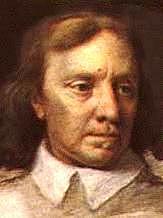 1649-1658 Oliver Cromwell
1649-1658 Oliver Cromwell
After the King was beheaded, and after a tumultuous period of Parliamentary rule, the leading general of the Puritan cause, Cromwell, was made Lord Protector. He ruled England through Parliament, but his absoute power over the Army made him a virtual dictator. 1658-1659 Richard Cromwell
|
"12 Apr 1753 George Heesam a brother of the Hospital," buried at Hemsworth. While brother sounds like a church title, I believe it refers to George as an inmate. The "hospital" at Hemsworth was a poor house, founded by the Archbishop of York, comprised of ten poor men and ten poor women, overseen by a Master. Hemsworth is in West Yorkshire, a part of the city of Wakefield. There was a school and hospital at Hemsworth.
(20) Ann Heesam (c1720)Ann Heesam married William Wadkin on 9 September 1740 at St. Michael's, Wragby, Yorkshire.
(21) Elizabeth Heesom (c1755)Elizabeth Heesom married Jeremiah [Jeremy] Oates on 17 December 1776 by William Brown, minister, at St. Michael's, Wragby. Elizabeth left her mark, that is, she could not write. Jeremiah was born in about 1755 in Silkstone, Barnsley parish, South Yorkshire. She died on 10 December 1840 and was buried in Wragby in 1840 - per Guy Hirst. Jeremiah died on 11 May 1850. They had six children.
"Edward sonne of George Esume bap: 14 Jan 1643 [1644 Gregorian]" in Crofton, West Riding, Yorkshire - from the Crofton Parish Registers. His surname is also spelled as Heysom and Heysome in the baptisms of his children. His father died when he was 13 years old. His elder brother, William, who was 15 years older, would have become his surrogate father.
Edward married at the relatively young age of 22. "Edward Easom & Mary Browne marr[ied]: Aprill 16" 1666 - from the Crofton Parish Registers.
Edward became a church warden of the All Saints church in Crofton upon the death of his elder brother, William, who had been church warden before him.
"Edward Heysome and George Firth, churchwardens, 1678." - from the Crofton parish register as recorded in "Walk in Yorkshire; Wakefield and Its Neighborhood" by William Stott Banks, 1871While Edward's brother, George, was his elder, George had moved to Wragby, leaving Edward the head of the family in the old family property in Crofton. "George Firth, Const." was listed in the "Yorkshire West Riding Hearth Tax Assessment Lady Day 1672" for Crofton.
Edward Hesome died and was buried at the All Saints church, Crofton, Yorkshire on 31 May 1708. He would have been 64 years old per his birth record, but he was noted as 66 years old in the burial record. He was interred in plot 33 in the All Saints churchyard. His tombstone,
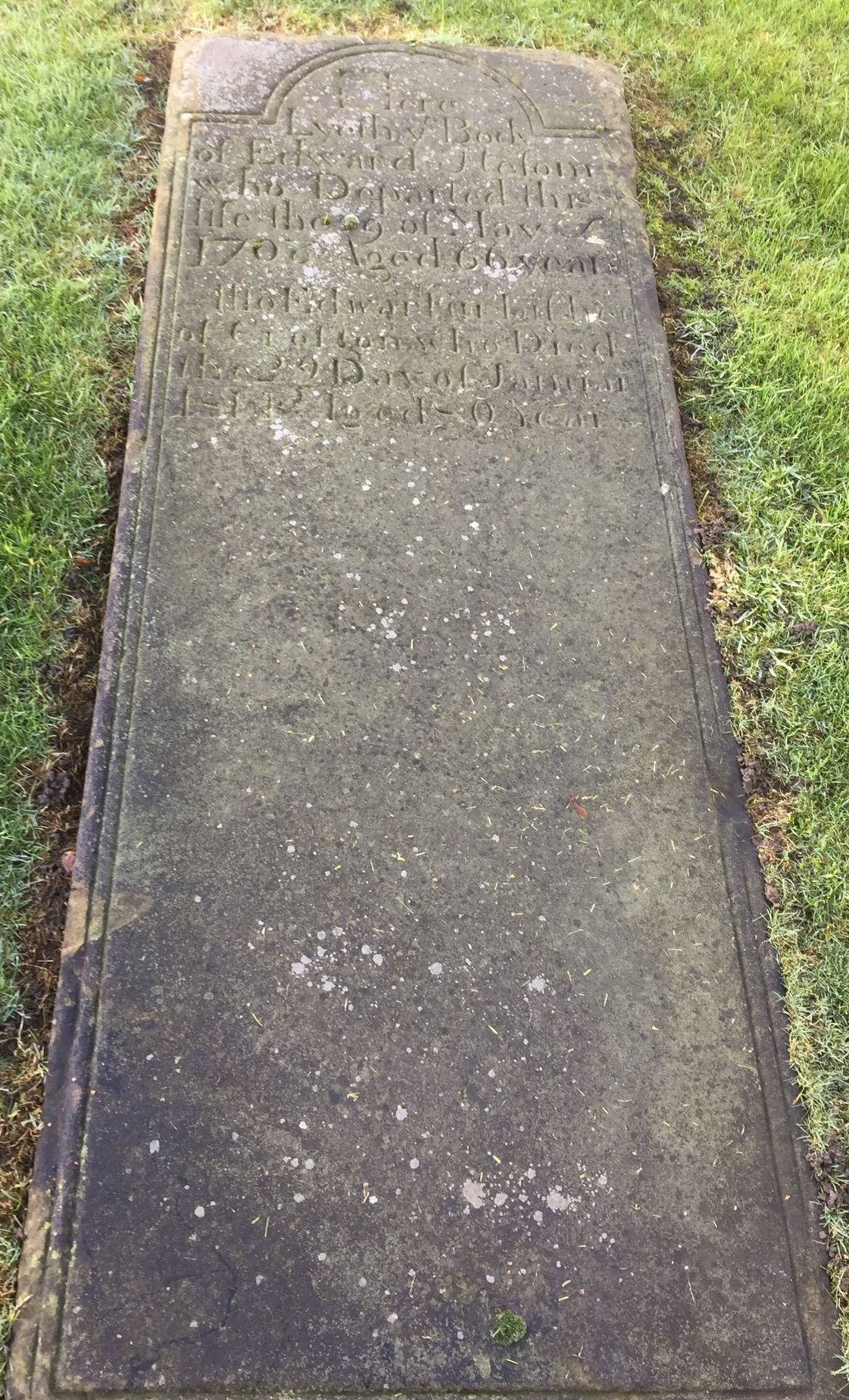
Edward Heysom(e) of Crofton was the father of the following, of whom only the line of William survived more than a few generations.
(19) Anne Heysome (1667)
(19) Jane Heysom (1669)
(19) Mathew Heysom (1671), male line dies out in generation (21)
(19) Edward Heysom (1674), no known heirs
(19) William Heysom (1677), died young
(19) Marie Heysome (1678)
(19) William Heysom (1680), the Surviving Line
(19) Frances Heysom (1683)
Also as Heasom. "Anne dou: of Edward Heasom Bap: Jan.20" and "Anne dau: of Edward Heysome Bap: Jan 20" - from the Parish Register. The daughter of Edward Heysome. She was christened on 20 January 1667 in Crofton, Yorkshire, England.
Ann Heysom married Daniell Tomlinson in April 1685 in Crofton.
Ann had, perhaps, a second marriage: "John Field of Fetherston & Ann Hesome" on 18 November 1708 at Crofton, All Saints, Yorkshire - from Publications of the Yorkshire Archaeological Society. Featherstone was just north of Crofton.
(19) Jane Heysom (1669)Jane, the daughter of Edward Heysom, was christened on 31 January 1669 in Crofton, Yorkshire, England. She died on 24 September 1671 in Crofton, at the age of 3.
(19) Mathew Heysom (1671)Mathew, the son of Edward Heysom, was christened on 9 December 1671 in Crofton, Yorkshire, England. He had a numerous family, most living in Sandal Magna.
Mathew Hesom died on 16 March 1746, at the age of 75, and was buried in plot 28 in the All Saints churchyardn in Crofton. He was noted to be the father of Edward Hesom, born in 1698, who was also buried in plot 28.
Matthew's children were,
(20) Edward Esom (1698)
(20) Mary Esom (1702)
(20) Matthew Esum (1704)
(20) Averel Esume (1707)
(20) Elizabeth Esum (1709)
(20) Anne Esum (1712)
(20) James Esum (1715)
Edward, the son of Matthew Esom, was born and baptized on 19 February 1698 in Sandal Magna, Yorkshire, England. I have a Edward Hesom who married Anne Booth on 3 April 1728 in York. It's the wrong place, but the right year for Edward to marry. He died on 22 December 1756, a Yeoman aged 58, and was buried in plot 28 in the All Saints churchyard in Crofton. The inscription on his tombstone,
"Here lyeth the body of Edward Hesom yeoman who died December 22 1756 aged 58 years
Also Mathew Hesom father of the above Edward Hesom who departed this life 16 March 1746 aged 75 years
Also Mather Furbisher son to Richard Furbisher of Crofton who died 9 February 1824 aged 77 years
Also Ann the wife of the above Mathew Furbisher who died September 22 1835 aged 79 years."
I think the following fits here. "03 May 1755 Ann the wife of Edward Heesom" was buried in Thornhill, Yorkshire. I believe the following snippet also refers to a death: "Edward Heesome from Thornhil, Mason, Dec: 25. [1757?], pg 66" - from Publications of the Yorkshire Archaeological Society Parish Register Section. Thornhill is a small village several miles west southwest of Wakefield. Did Edward perhaps reside in Thornhill, but get buried in the family plot in Crofton? There were a number of masons in this part of the family.
| Sandal Magna
Sandal Magna is west of Crofton, almost in Wakefield. The parish of Sandal was a quiet place in the 17th and 18th centuries consisting of small cottages and farms, with the church and the remains of a castle at its heart in Sandal Magna, on the banks of the Calder river. There were large areas of common land in the parish: Sandal Moor, Milnthorpe Green, Woodthorpe Hill, Pledwick Green, Humley Moor, Thurstonhaye, Newbiggin Hill, Boynehill Green, Crigglestone Cliff, Hall Green and Durkar Green. These commons were enclosed by the end of the 18th century. The castle, like that at Pontefract, was destroyed in 1648. |
Mary, the daugther of Matthew Esom, was baptized on 8 June 1702 in Sandal Magna, Yorkshire, England.
(20) Matthew Esum (1704)Matthew, the son of Matthew Esum, was baptized on 3 February 1704 in Sandal Magna, Yorkshire, England. He was a mason.
Matthew Esom married Martha Samson on 3 December 1732 in Pontefract, Yorkshire. Note that his first known child was born 9 months later.
I can only see a snippet of the following.
"Elizabeth dau: of Matthew Heesome Jun: Sep:9 [1733], pg 39
James Son of Matthew Heesome, Mason, July 17. [1744], pg 65" - from Publications of the Yorkshire Archaeological Society Parish Register Section
Matthew's children were,
(21) Elizabeth Heesome (1733)
(21) James Heesome (1744)
| Stray Yorkshire Parish Citations
I expect the following are deaths of relatives of Matthew, another mason. Frances wife of William Heesome, Mason, Sep: 20. [1726], pg 62Willm Heesome, Mason, Mar: 20. [1726], pg 62 Martha Wife of Robert Heesome, Mason, Oct: 7. [1722], pg. 62 Robert Heesome, Mason, Oct: 18. [1722], pg 63 Elizabeth Heesome, Widow, Jan: 15 [1759], pg 67" - from Publications of the Yorkshire Archaeological Society Parish Register Section |
Elizabeth, the daughter of Matthew Heesome, was baptized on 9 September 1733 in Crofton, Yorkshire.
(21) James Heesome (1744)James, the son of Matthew Heesome, was baptized on 17 July 1744 in Crofton, Yorkshire.
(20) Averel Esume (1707)Averel, the daughter of Matthew Esume, was bapized on 19 September 1707 in Sandal Magna, Yorkshire.
(20) Elizabeth Esum (1709)Elizabeth, the daughter of Matthew Esum, was bapized on 18 March 1709 in Sandal Magna, Yorkshire.
(20) Anne Esum (1712)Anne, the daughter of Matthew Esum, was bapized on 19 October 1712 in Sandal Magna, Yorkshire.
(20) James Esum (1715)James, the son of Matthew Esum, was baptized on 21 August 1715 in Sandal Magna, Yorkshire, England.
(19) Edward Heysom (1674)Edward was the son of Edward Heysom. He was christened on 18 October 1674 in Crofton, Yorkshire, England.
(19) William Heysom (1677)William, the son of Edward Heysom, was christened on 4 July 1677 in Crofton, Yorkshire, England. William the son of Edward Heysom died and was buried on 7 July 1677 in Crofton.
(19) Marie Heysome (1678)The daughter of Edward Heysome. She was christened on 29 September 1678 in Crofton, Yorkshire, England. She died on 24 August 1678 in Crofton.
Historical Timeline: Reign of Kings; Restoration of the House of Stuart:
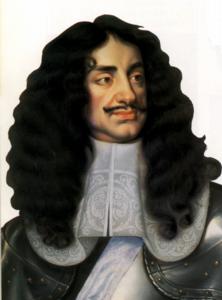 1660-1685 Charles II
1660-1685 Charles II
Charles II led a bawdy court famous for its royal mistresses. It was not famous of its intellect. Restricted in his income by Parliament, the King accepted money from France's King Louis XIV. Dutch colonies in America were seized and given to Charles' brother James, the Duke of York (hence New York city). The Pennsylvania colony was founded by William Penn as a Quaker refuge. 1665 - Bubonic Plague strikes London. 70,000 die.1665 - The Great Fire levels London (and frees the city of the plague). |
Historical Timeline: Reign of Kings, The Stuarts
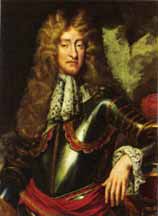 1685-1688 James II
1685-1688 James II
Brother to Charles. He publicy converted to Catholicism causing the people to fear a forced return of the Catholic religion upon his assension to the throne. The English Revolution followed the birth of a male heir to the King. The King and his household fled to France. The King's son, which the Protestant's refused to believe legitimate, became known as the "Old Pretender." |
"William son of Edward Heysom" was born on 7 July 1680 and baptized on 1 August 1680 in Crofton, Yorkshire, England.
William was a house carpenter. His uncle, John Heesom, who emigrated to America, was also a carpenter. William moved to the village of Ackworth as an adult. Ackworth is just east of Wragby and Crofton, on the Doncaster road. William Hesome of Ackworth, carpenter, married Ann before 1705.
Ackworth| Ackworth
There was a Quaker school in the village which may be significant to the story of my Quaker forebear, John Heesom of Burlington, West Jersey, who, like William Hesome, below, was a carpenter. The school was founded after my ancestor would have emigrated, but spoke to the large Quaker community in the neighborhood. The Dacre and Darling meetings were close by. There is a park, of 200 acres, originally the possession of the Laci family of the Honour of Pontefract. The parish register begins in February 1558. The plague struck Ackworth in 1645, killing 153 people, a significant portion of the village's population. The names Scholaye and Newsam are of note. |
William and Ann's children were,
(20) Elizabeth Heesom (1705)
(20) Elizabeth Hesome (1708)
(20) William Heesom (1710), no known heirs
(20) Thomas Heesome (1713), the East Yorkshire Line
(20) Unnamed Heesom (1717)
(20) Susannah Heesom (1720)
(20) James Heesom (1726), the West Yorkshire Line
The daughter of William and Anne. She was baptized on 1 July 1705 in Ackworth. She apparently died young.
(20) Elizabeth Hesome (1708)The daughter of William and Anne. She was baptized on 15 October 1708 in Ackworth.
(20) William Heesom (1710)He was the son of William and Anne. He was baptized on 31 January 1710 in Ackworth, Yorkshire. William Heesam of Ackworth married Ann Stanfield, widow, also of Ackworth, on 9 March 1753 [Gregorian 1754], at St. Cuthbert's, in Ackworth. He died in 18 October 1764. I don't know of any children. If he was 43 at his first marriage that would hardly be surprising.
Historical Timeline: Reign of Kings, The House of Orange
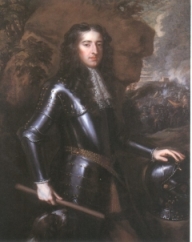 1689-1702 William & Mary
1689-1702 William & Mary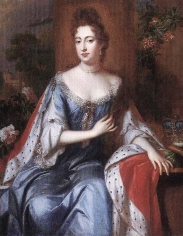
William of Orange and his queen, Mary, the daughter of James II, seized the throne without bloodshed, in part engineered by John Churchill, a forebear of William Churchill. James II fled to the court of France. This became known as the "Glorious Revolution." William was the son of William II, prince of Orange, in the Netherlands, and Mary, was the eldest daughter of King James I of England. William III led a European alliance that worked ceaselessly, and successfully, to restrict the power of King Louis XIV's France. By 1700 the population of England and Wales had grown to 6 million. |
Historical Timeline: Reign of Kings
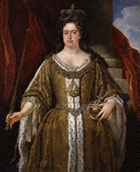 1702-1714 Anne
1702-1714 Anne
Sister and heir of Mary and daughter of James II. She died without issue. In 1704 the Duke of Marlborough, John Churchill, defeated the army of Louis XIV at the battle of Blenheim. His many victories over the French crippled the power of the Sun King in his final years on the throne and restored the balance of power in Europe. |
This part of the family split off from the Wakefield line of West Yorkshire, who had been concentrated in the small communities of Barnsley and Royston, to the south, Crofton, Wragby, and Ackworth, to the east, and Normanton to the northeast. This cadet branch moved further east, down the Aire river, first to Carlton, then to Hull on the Humber estuary.
(20) Thomas Heesome (1713)Thomas, the son of William Heesome, was baptized on 3 May 1713 in Ackworth, Yorkshire, England. Then, as a young man, Thomas moved east to Carlton, in Snaith parish, on the Aire river.
| Carlton-juxta-Snaith
Today known as Carlton in Snaith, in the old West Riding of Yorkshire, is down the Aire river from Ackworth, about half-way from Wakefield to Kingston-upon-Hull. On the other side of the river is Snaith. The long title is given to differentiate it from Carlton, just south of Barnsley.  |
Thomas married Jane.
"Thomas Hesome of Carlton, cordwainer, son of William of Ackworth, House carpenter, by Ann his wife, d. 19 May 1779 b. in the churchyard. 70 years [sic]. A slow fever." - from the Carlton Juxta Snaith parish registerThomas exaggerated his age. He was actually 66 at the time of this death.
His wife, Jane, died 5 years later.
"Jane wife of Thomas Hesome cordwainer of Carlton d. 02 Apr 1784 b. in the Churchyard. 82 years. Old age." - from the Carlton juxta Snaith parish register
| The Cordwainer
|
Thomas and Jane's children were,
(21) Elizabeth Hesome (c1737)
(21) Thomas Heesom (1744), of the East Riding
(21) Infant Heesom (1745), "An infant of Thomas Heesom's of Carleton unbapt. Nov. the 5th [1745]." - List of Burials, Royston, St. John the Baptist
The daughter of Thomas Hesom, cordwainer. She was of Carlton.
"Thomas Hindsley of Camblesforth par: Drax [the parish of Drax, just north of Snaith] & Elizabeth Hesome of Carlton mar. by banns (16 Oct 1763, 23 Oct 1763, 30 Oct 1763) 10 Nov 1763 by Joseph Fisher, Curate. Witn: Thomas Wheatley, Joseph Taylor." - from the Carlton juxta Snaith parish registerThe banns were read for three Sundays, in front of the congregation, before the marriage was performed.
The following may be the same woman, assuming a second marriage to Richard Lee.
"Elizabeth Lee (dr of Tho Hesom cord wainer & wife of Rich Lee) d. Dec: 2 [1785] b. in the Church-yard. 48 years [1737]. Fever." - from Carlton-juxta-Snaith Parish Records
| Snaith Strays
This village is about a mile south of Carlton-juxta-Snaith, on the other side of the Aire river. (21) Thomas Hesome (1713), above, lived in Carlton-juxta-Snaith. He died in died in 1779. He might have been the grandfather of William, below, though the only son of Thomas I am aware of, Thomas Jr., had moved to North Ferriby, in East Yorkshire by 1768. Below is a map of Snaith in the mid-18th century showing the enclosure of the previously common land of Snaith marsh. 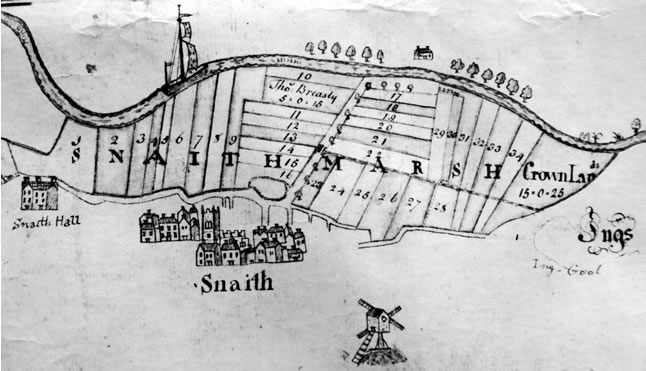 (22) William Esom of Snaith (c1774) He married Sarah Littlewood. I have a Sarah, the daughter of John Littlewood, who was baptized on 21 March 1787 in Snaith. She would have been, however, only 17 1/2 when her first child was born. I also have an Elizabeth Littlewood, of Snaith, Sarah's Aunt?, who, in 1758, married John Longstaff of Ackworth, "but discontinued because she was his wife's sister's Daughter." (23) Bessy Esem (1804)(22) William Esom of Snaith (c1774) Bessy, the daughter of William Esem, was baptized on 9 September 1804 in Snaith, Yorkshire. Elizabeth Esom married Charles Woodcock on 21 June 1830 in Snaith. (23) Catherine Esom (1813)(22) William Esom of Snaith (c1774) Catherine, the daughter of William Esom and Sarah Littlewood, was baptized on 2 May 1813 in Snaith, Yorkshire, England. A Catharine Esam married John Trate on 10 November 1836 in Sculcoates, Yorkshire, England. (23) Thomas Esom (1816)(22) William Esom of Snaith (c1774) Thomas, the son of William Esom and Sarah Littlewood, was baptized on 25 August 1816 in Snaith, Yorkshire, England. He died young. (23) Thomas Esom (1819)(22) William Esom of Snaith (c1774) Thomas, the son of William Esom and Sarah Littlewood, was baptized on 6 June 1819 in Snaith, Yorkshire, England. In the 1841 of Bentley with Arksey, Yorkshire there was a Thomas Esom, a 26 year old agricultural laborer. Living with him was his wife, Hannah, 24. (23) Ann Esom (1821/1826)(22) William Esom of Snaith (c1774) Ann, the daughter of William Esom and Sarah Littlewood, was baptized on 13 May 1821 in Snaith, Yorkshire. A second daughter, also Ann, was baptized on 5 March 1826 in Snaith. (23) Henry Esom (1822)(22) William Esom of Snaith (c1774) Henry, the son of William Esom and Sarah Littlewood, was baptized on 26 June 1822 in Snaith, Yorkshire, England. (23) George Esom (1823)(22) William Esom of Snaith (c1774) George, the son of William Esom and Sarah Littlewood, was baptized on 13 July 1823 in Snaith, Yorkshire. (23) Letitia Esom (1828)(22) William Esom of Snaith (c1774) Letitia, the daugther of William Esom and Sarah Littlewood, was baptized on 22 June 1828 in Snaith, Yorkshire. |
Of Carlton, West Riding, Yorkshire.
"Thomas son of Thos Heesom baptized 02 Sep 1744" in Carlton, West Yorkshire - from the "Parish Register of Carlton juxta Snaith" [Carlton across from Snaith]
Of Swanland, East Riding, Yorkshire.
"Thomas, son of Thomas Heesom, Wheelwright, Swanland, died Dec 24th 1792, buried Dec 25th 1792, Age 49, consumption" - from the North Ferriby parish registerThe latter would imply a birth in about 1743, or close enough to the birth year of Thomas Heesom of Carlton to warrant further examination. Nicolette Heesom believes our Thomas was the son of Thomas Hesome (1713) of Carlton. Since DNA testing has proven that my family, who are descendents of John Heesom, son of (17) George Hesome above, and Nicolette's, who are descendents of (21) Thomse Heesom of Swanland, share an ancestor, I expect this is true.
At this point I think we need to examine the East Riding and some complications with Thomas' ancestors before we continue with his life, at (21) Thomas Heesom (1744).
Heysham's of the East RidingLike the members of the West Riding family, I suspect those of the East Riding migrated out of the west, as opposed to the north, in York.
Rivers of Yorkshire
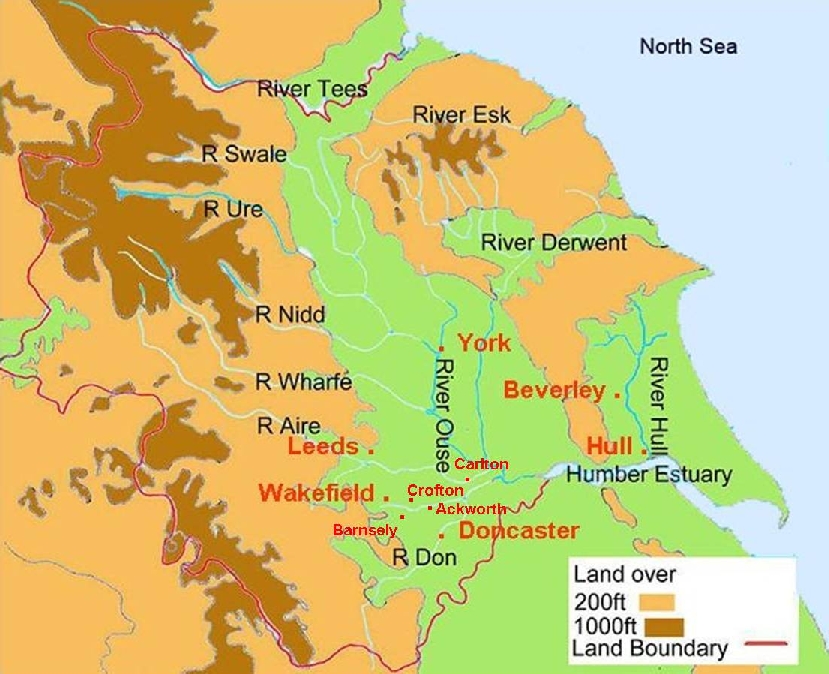
Yorkshire is drained by several rivers. The three most southerly, the Aire, Calder and Don, empty their waters into the River Ouse which reaches the North Sea via the Humber Estuary. The River Hull flows southwards to join the Humber Estuary at Kingston upon Hull. The western Pennines are served by the River Ribble which drains westwards into the Irish Sea. |
I had an interesting email from Nicolette [Heesom] Reichhold that shows a close connection between the Thomas Hissom branch of my family and the Heesom family of East Yorkshire.
"Dear SteveThe Thomas Hisam "born between 1775 and 1785" was the second son of Thomas Hissom, and the grandson of Thomas Hesom and Catherina Kleyn, of Lower Smithfield township, my direct ancestors. The Heesom haplogroup, by the way, was G2a; see Ysearch or Ybase for more information.
You may remember I wrote last year about my Heesom family in East Yorkshire. Recently my brother's Y-DNA (FTDNA) had a 35/37 match with a Hissem of America whose earliest known ancestor is a Thomas Hisam, born between 1775 and 1785 in Philadelphia, PA. Thomas Hisam's wife is unknown, his son, Thomas J. Hissam was born between 1818 and 1819 in Westmoreland Co. PA and died in West Virginia. I wonder if this fits in anywhere with your John Heesom line?
Regards
Nicolette"
| DNA Matching
The Y-chromosone is passed from father to son almost unchanged from generation to generation. DNA matching measures allele values for a number of locations on the Y chromosome. These tests may measure 12, 25, 37 or 67 locations; more measurements being better. The results can then be compared to other individuals to see how closely or distantly they may have shared a common ancestor. DNA tests are also useful to prove or disprove that variant spellings of our surname, such as Heysham, Heesom & Hissem, are linked. It is a wonderful tool to support traditional genealogical research, but it will not tell us that we are definitely descended from person A, only that we and another tested individual probably descended from a the same person X generations ago. For a 35/37 match your odds of sharing a common ancestor at the 10th generation are 80%. Those odds increase to 90% at the 12th generation, and to 95% at the 14th. At some point, of course, we all share a common ancestor. Note that chromosomes do mutate and some of these locations on the chromosome, or markers, mutate over time more quickly than others, so for a 35/37 match, if the mismatch is in fast mutating markers, then it is still possible that the individuals being compared are closely related. There are 15 Rapidly Mutating Markers on the 37 marker ydna test: DYS 385a, 385b, 439, 458, 459a, 459b, 449, 464 a,b,c,d; 570, 576, CDYa and CDYb. |
There are 10 generations between the Hissem family's first ancestor in America, John Heesom, and the American Hissem whose test results were matched above. So there is a good chance, 90% anyway, that John Heesom's grandfather was also the ancestor, in a direct line, of Nicolette Reichhold's brother. We should be careful here, however, and to understand if this is really significant I would like to see the same matching attempted with a member of the large Heesom family in Cheshire or of the Heysham family in New York. If one of those also matched at the 35/37 level, what would that mean?
The Quaker colony where John Heesom settled circa 1686 had a large Yorkshire contingent, so it wouldn't be surprising if he came from the East Riding. The town where John lived in America had originally been called New Beverley by the colonists, after the East Riding town just north of North Ferriby. It was renamed Burlington after another East Riding town, Bridlington - which in the uniquely British fashion is pronounced Burlington. To understand that, I'm told you're supposed to invert the r & i and drop the d. Don't ask why, it's "an English thang".
John Heesom would have been born circa 1650. His grandfather, therefore, would have been born circa 1590. The point, however, where I think the two families may meet is with (17) George Hesome (c1600) of Crofton.
An interesting comparison is with the Hysom family of Dorset. Their surname has also been rendered as Heysom, Haysome, and Haysham. I had always thought that the similarity in the spelling of this name to Heysham meant there was probably a family relationship, and from there through to the Heysham-variants, like Heesom. However, in comparing a DNA sample from the Hysom family of Swanage, Dorset with the Heesoms of Swanland, East Yorkshire (the repetition of the word Swan is, of course, accidental) showed only a 11/37 match. That is, there is no relationship. The Hysom haplogroup is R1b, the most common in England. The Heesom/Hissem haplogroup is G2a, which is relatively rare.
The next obvious question is, which of these two families, the Hysom's and the Heesom's, are related to the Heysham's of Lancashire, or are neither of them?
Looking back over old emails I realize I was given much of this information at an earlier date and did not realize its significance at the time. Andrew Peel wrote that he was genetically related to the American Hissem as well, but only to sharing a common ancestor within the previous 24 generations, at a 90% probability. He also mentioned a Crispin David Edwin Heesom who is at 66.71% within 24 generations. He opined that the Saxons were of Teutonic/Scythian origins, who he equates to the Sarmatians, so perhaps our family origins come from that direction.
I only recently got around to asking Nicolette how the Heesom name was pronounced and was suprised to find that the first syllable was rendered like Hess, with a short-e sound. I had assumed it was Hee, as in hee haw. That makes it easier to understand how it became Hessom or Hissom in America, but makes it more difficult to tie it to Heysham, which is pronounced Hee-sham, not Hess-ham.
Nicolette Heesom's website: The Heesom Family History. Also, National Trust frequencies for 1881 and 1998. Interestingly, there aren't enough Heyshams in either year to track. The Heesom's show up strongly in 1881 in Warrington, Lancashire, and Hull.
Looking at Heesoms in ancestry.co recently, I came across a Hans Wilhelm Hilde Heesom, born c1877, marrying an Annie Beatrice Williams in 1907, St. Marylebone. His father was Hans August Heesom, deceased. Wonder if you know anything about them? I could not find anything more in ancestry. Best wishes Nicolette
I have a snippet reference to a Robert de Esom, a juror in an inquisition upon the death of Sir John de Vescy, who resided (perhaps) in Sledmere, in the East Riding.
c 1289. "Inquisition taken before the same Thomas de Normanville at Wyntringham, on Wednesday before the feast of St. George the Martyr, 17 Edw. (20 April 1289), by John de Meningthorpe, William de Kenerthorpe, Richard Lovel of Langton, Robert de Kayton, Robert de [Esom], John Pucerl of Sledmere, Peter de Briddale of the same, William Dringe of Neuton, William Mangevilayn of the same, Robert de Langtoft of Schireburne, Wiliam West of Thurkelby, and Adam de Duggelby who say by their oath that John de Vescy lately deceased held on the day of his death L8 gs. 3d. annual rent at Martinmas and Pentecost in the manor of Wyntringham, which Alan Buscel and Ivetta his wife hold for life, and is held in chief of Sir Edmund de Mortimer, by what service is not known. The same John held in Duggelby . . ." - from "Yorkshire Inquisitions" in the Record series By Yorkshire Archaeological Society"Sledmere, situated in a spacious vale, in the centre of the Yorkshire Wolds, may he considered as the ornament of that bleak and hilly district." This is in the northern end of East Yorkshire, between Bridlington, on the coast, and York.
A merchant of Kingston upon Hull in East Yorkshire. Note that merchants of York regularly shipped goods to the continent via Kingston upon Hull.
1418. "County: Yorks, Case Type: debt, Plaintiff: Mungell, John, of York, executors of; (Forest, William, chaplain; Seriant, William; Matilda, his wife, formerly wife of Testator), Defendant: Heseham, John, of Kyngeston upon Hull, Yorks, merchant" - from Henry V, 1418: CP40no629, by Rosemary Simons
The following citation indicates a relationship between our John and (11) Edmundus de Hesham (c1355), a tailor of the city of York. As such he may be a son of Johannes de Hesham. As a merchant, however, he may fit better as a son of Laurencii Heseham, the dyer, whose sons were Nicholaus, Thomas and, perhaps, Henry.
1430. "County: Yorks, Case Type: debt, Plaintiff: Neusom, John, esq, executors of; (Clervaux, John, of York, knight & sheriff; Margaret, his wife, formerly wife of Testator), Defendant: Heseham, Edmund, of York, tailor; Heseham, John, of Kyngeston upon Hull, Yorks, merchant" - from Henry VI, 1430: CP40no677, by Rosemary SimonsSir John Clervaux, Knight, of Croft, was the eldest son of John Clervaux, Esquire, of Croft, and Isabella de Richmond. High Sheriff of Yorkshire in 1430. He married Margaret Lumley, the daughter of Ralph de Lumley, 1st Baron Lumley, and Eleanor de Neville, the daughter of Baron John Neville, of Raby. Sir John Clervaux died circa 1443. I think that Sir John and his wife were the executors for John Neusom, Margaret's first husband.
The following may be our man, though I currently have him as Johannes Heseham, of Newark, above.
1450. "County: Notts, Case Type: debt, Plaintiff: Nepe alias Knype, William, of Newerk, merchant, administrators of; (Hesham, John, merchant; Cresy, William of Newerk), Defendant: Heuster, Walter, of Derby, Derbs, heuster" - from Henry VI, 1450: CP40no758, by Rosemary Simons
| Kingston-Upon-Hull
For England, this is a relatively new city. It is located at the point where the Hull river enters the Humber estuary and was originally an outlying part of the hamlet of Myton, and was sparsely settled, being low and marshy ground. In the late 12th century it was chosen by the monks of Meaux Abbey to develop as a new town which they named Wyke upon Hull, after John Wyke, Archbishop of York. The locals refused to call the town Wyke and used Hull, the name of the river, instead. The river Hull was a good haven for shipping whose main trade was in the export of wool from the abbey. The Humber Estuary formed a conduit for vessels ranging from the rivers Trent in Nottinghamshire to the Ouse and Aire in the north and west of the county. In 1293 the town was acquired by Edward I, who later granted the town a royal charter, dated 1 April, 1299, that renamed the settlement King's town upon Hull, or Kingston upon Hull. The charter remains preserved in the archives of the city's Guildhall. In 1440, a further charter incorporated the town and instituted local government consisting of a mayor, a sheriff, and twelve aldermen.
The town prospered by exporting wool and woollen cloth and importing wine. Hull also established a flourishing commerce with the Baltic ports as part of the Hanseatic League. Sir William de la Pole was the town's first mayor. A prosperous merchant, de la Pole founded a family that became prominent in government. Another successful son of a Hull trading family was bishop John Alcock, who founded Cambridge University's Jesus College and was a patron of the grammar school in Hull. The increase in trade after the discovery of the Americas and the town's maritime connections are thought to have played a part in the introduction of a virulent strain of syphilis through Hull and on into Europe from the New World. The town prospered during the 16th and early 17th centuries and Hull's affluence at this time is preserved in the form of several well-maintained buildings from the period, including Wilberforce House, now a museum documenting the life of William Wilberforce. During the English Civil War, Hull became strategically important because of the large arsenal located there. Very early in the war, on 11 January, 1642, the king named the Earl of Newcastle as governor of Hull while Parliament nominated Sir John Hotham and asked his son, Captain John Hotham, to secure the town at once. Sir John Hotham and Hull corporation declared support for Parliament and denied Charles I entry into the town. Charles I responded to these events by besieging the town. This siege helped precipitate open conflict between the forces of Parliament and those of the Royalists. See The Hull Citadel for an excellent history of the town. |
Another early member of the family I've found living in the East Riding was William Heseham, a man of some distinction in the town of Beverley. He was probably a member of the medieval York family of dyers and merchants.
I don't know where the following fits, but Bridlington is close to Beverley.
1437. "County: Yorks, Plea: trespass, Plaintiffs: White, Robert, Defendants: Fosse, Robert, of Brydlyngton, yeoman; Pratte, Thomas, of Brydlyngton, yeoman; Hesham, William, of Brydlyngton, yeoman; Story, Roland, of Brydlyngton, yeoman; Ledale, Thomas, of Brydlyngton, yeoman." - from CP40/705: Easter Term 1437 by Vance Mead
A member of the Dyers' Guild. Of the East Riding, though I suspect he was born in York, part of the dyer and/or merchant family of that town, and relocated to Beverley to find a less crowded market. He was one of the Keepers or Governors of Beverley, serving perhaps three terms, 1452-3, 1456-7 and 1459-60. The town of Beverley is in the East Riding, about 10 miles northwest of Hull.
Keepers or Governors until 1573.Keepers or Governors were later known as Aldermen. They served for one year and their possible re-election was closely controlled. "A minority of the keepers was regularly recruited from the merchant group as well as from certain families, comprising an elite within the oligarchy and making it possible for the remaining eight or nine keepers to be recruited from a variety of occupations as make-weights. Individuals with such occupations as butcher, baker, weaver, dyer and tailor held office as keeper from time to time." - from "Medieval Merchants: York, Beverley and Hull in the Later Middle Ages" by Jenny Kermode.
"1452-3. James Conpis, William Heseham (1459-60), John Potter, John Quail, John Wilforth, John Williamson" - from "Lists of Officers, A History of the County of York East Riding," Volume 6: The borough and liberties of Beverley."
| Beverley
Cloth production kept its place as the town's major craft throughout the Middle Ages. In 1366-7 Beverley supported three dyers. In 1456 there were 4 dyers, 9 fullers, and 22 weavers, and in the late 15th century the town had 8 dyers and 42 weavers. - from British History Online. In the 15th century, like many East Yorkshire towns, Beverley went into decline, mostly because of competition from up and coming towns in West Yorkshire such as Bradford and Sheffield. By the early 16th century a visitor noted the "great ruin and decay," and by the end of the 17th century the population of the town had declined to 3,000. |
During this period the Master of the Beverley Gramamar School was William Harding [Hardinges]. He also served as one of the governors of the town of Beverley. The following is from a history of the Beverley Grammar School and records the election of 1456.
25 April 1456.
"Schoolmaster again elected a Governor of Town.
[Do 107 b.]
Electio.
Roger Rolleston, Thomas Whyte, Johannes Couton, Johannes Myddilton, Willelmus Hundesworth, Jacobus Johannes Quale, Willelmus Heseham, Johannes Potter, Johannes Asheton, Antonius Nuttyll, Willelmus Rud, Ricardus Thorp, Willelmus Thebald, Thomas Lawe, Robertus Byrde, Johannes Wilkynson, Ricardus Lyng, Magister Willelmus Hardynges, Henricus Polyngton, Willelmus Johnson, Robertus Thomson, Johannes Kirkham, Willelmus Garthorn." - from "Early Yorkshire Schools" by Arthur Francis Leach.
1455. "County: Yorks, Plea: debt, Plaintiffs: Routh, John, esq, Defendants: Heseham, William, of Beverley, dyer; Raper, William, of Magna Dryffeld, chaplain; Benson, Richard, of Magna Dryffeld, miller; Raper, John, of Magna Dryffeld, servant" - from CP40/776: Hilary Term 1455 by Vance Mead.
Apparently William was a leader of the Dyer's Guild of Beverley, a possible link with his relatives in York. It was the Dyer's job to dye the wool after it had been woven and fulled.
"In like manner, June 1, 1456, William Hoseham [sic] was warned in the Gild Hall to put down 40s. because the players of the pageant of the Dyers' craft were not ready to play their pageant in the first place at the North Bar. The money was returned, he promising that it should not occur again." - from "Some English Plays and Players, 1220-1548" in "An English Miscellany" by William Paton KerThe North Bar, below, referred to one of four gates of the town of Beverley, the others being Norwood Bar, Keldgate, or South Bar, and Newbegin Bar. The North Bar, rebuilt in brick in 1409, survives to today.
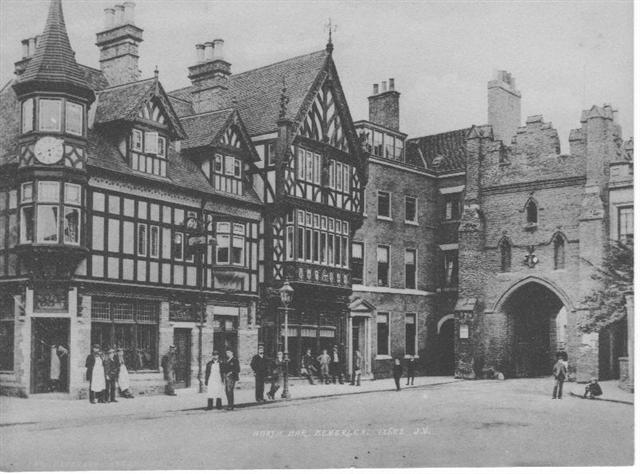
| The Guild Plays of Beverley
"The Corpus Christi plays and pageants mounted by the craft guilds of Beverley were presented "in the fashion and form of the ancient custom of the town of Beverley, to play in honour of the Body of Christ." The pageants had been initially noted in a document of 1377, only a year later than the first reference to the York plays." - from "Festivals and Plays in Late Medieval Britain" by Clifford Davison. |
The following probably refers to our William since it occurs in the East Riding and involves a role of some importance and a familiarity with the powerful.
"Robert Clifton, brother of Sir Gervase, was archdeacon of the East Riding . . . On Aug. 27, 1467, adminstration to his [Robert Clifton's] effects was granted to Robert Hill and William Heseham." - from "Testamenta Eboracensia: Or, Wills Registered at York, Illustrative of the History, Manners,..." by James Raine, John William ClayRobert Clifton died intestate so William's job would have involved inventorying Robert's estate and papers, and a certain delicacy would probably be required. Robert's father, Sir Robert of Clifton, would have wanted someone for this role who could keep secret what needed to be kept secret. I haven't been able to locate any information about Robert Hill.
| Robert Clifton, of Clifton
Sir Robert Clifton was high sheriff of Nottingham and Derby in 29 and 38 Henry VI, and 7 Edward IV. He had two sons, Gervase, his heir who became high sheriff of Nottingham and Derby in his turn, a rubbing from a brass depicting him is to the left, and Robert, who was archdeacon of the East Riding, in com. Ebor., from 1464 to 1467. Robert Clifton was collated, or granted a benefice, to the stall of North Muskham at Southwell on 3 May 1454. North Muskham is a village in Nottinghamshire, north of Newark-on-Trent, in the parish of Southwell. I'm not sure what a stall is, though clearly it's a job. On 28 May 1463 he was collated to the prebend at St. Michael's altar at Beverley. There were two prebends at St. John's church in Beverley, St. Andrew's and St. Michael's. A prebendary was a medieval church administrator who received a portion of the church's revenues. Robert was collated archdeacon of the East Riding on 13 March 1464. At this time he was still only an acolyte, his benefices being granted more for the pay than for any service he could provide. On 12 September 1464 he was given leave to proceed to the higher orders. He died on 17 June 1467, intestate. The archdeacon held his post under the diocese of York. Robert predeceased his father, Sir Robert, by 11 years. - from "The Baronetage of England" & "Testamenta Eborancensia or Will Registered at York" by James Raine. The Sheriff of Nottingham and Derby
The Sheriff of Nottingham was, of course, the sheriff made notorious by Robin Hood. Lincolnshire is directly south of the East Riding, and to its west are Nottinghamshire and Derbyshire. A Gervasius de Clifton, of Clifton Hall, was the sheriff in 1290 and 1345, during the long reign of Edward III. After 1449 each shire got its own sheriff.
|
Of Beverley. A member of the church.
"Ordination celebrated in the conventual church of the Dominicans, York, on 19 May 1459 by Richard, bishop of Dromore, the suffraganWatton Priory was a priory of the Gilbertine Order at Watton in the East Riding of Yorkshire, England. (14) William Hesam (c1430)
. . .
Acolytes
. . .
John Heseham of Beverley."
"Ordination celebrated in the conventual church of the Austin friars, York, on 22 December 1459 by Richard, bishop of Dromore, the suffragan
. . .
Subdeacons
. . .
John Hesam of Beverley to t. of Watton priory." - from "York Clergy Ordinations 1450-1474" edited by David M. Smith, 2018.
Of Beverley. A member of the church. I wonder if the citation below got the given name wrong. This could easily be for a John Heseham.
"Ordination celebrated in the conventual church of the Franciscans, York, on 21 March 1460/1 by Richard, bishop of Dromore, the suffragan(15) Thomas Heesom (c1560?)
. . .
Deacons
. . .
William Hesam of Beverley to t. of Watton priory." - from "York Clergy Ordinations 1450-1474" edited by David M. Smith, 2018.
Perhaps a brother of (16) John Hesame (c1565) of York? Mill owner of Welton, circa Elizabeth I.
Hi Steve, Just been looking through a collection of family papers, which a relation found in their attic and found a comment that I suspect will interest you:Welton is a village in the East Riding, just west of Swanland. There is a defunct mill pond to the north of the village.
In a letter written by my father, he mentions that in 1930, his father Edwin and grandfather, James, went to Yorkshire to research the Heesom ancestors. In some unnamed record office they found a record for a 'Thomas Heesom who owned a mill at Welton in the time of Elizabeth 1'. Possibly this is the father or grandfather of the Thomas Heesom, who married 'Isabell Glendall' on 17 April 1620 (marriage record in the North Ferriby parish Registers Collection found for me by Pauline Alden, a professional genealogy researcher). In 1960, my father looked for the record of the millowner Heesom, but could not find it. However, he says that 'it is possible that the name was not spelt Heesom, but something that later turned into Heesom, as H was uncommon North of the Trent'. I think this means that he only searched for surnames beginning with an H."
- Nicolette Heesom
Thomas would be a contemporary of Raphe Hesome, of Barnsley, and Richard Esom, of Royston. This argues for a split in the family, which we now know is related, to the 14th generation or earlier. What this doesn't clarify is the descent from these two early Thomas Heesom's to (21) Thomas Heesom (1744), below. Records of birth, marriage and death were fairly well kept starting in the 17th century, so why haven't we been able to find these links?
(16) Thomas Heesom (c1590)According to what Nicolette Heesom wrote me, a Thomas Heesom married Isabell Glendall in 1620 - from the marriage register, North Ferriby Parish Register Collection, discovered by Pauline Alden.
"Hi,Nicolette also related that the North Ferriby parish register recorded the marriage of a Thomas Heesom to Marie Knight on 5 September 1636. This could be a second marriage for the same man or a first marriage for Thomas' son.
I am a Heesom from England, who has enjoyed reading your Hissem-Montague family site. I have recently researched my Heesom ancestors from the East Riding and have additional information for the Heesom family in Welton. My public member tree in ancestry is called Heesom family. It looks as if the Heesom family were living in this area in the early 17th century, as I found a Thomas Heesom marrying an Isabell Glendall in 1620 in the North Ferriby register.
Regards N.Heesom"
If the prior citations are correct, and I've not seen either one, then the East Yorkshire and American Heesom/Hissem's may descend from these men rather than those of the West Yorkshire villages of Crofton and Ackworth. However, my sticking point is, where are the descendents at generations 16 through 20 that result in (21) Thomas Heesom, below? By the late 1600's and early 1700's the records of birth were well kept. Why can't we find any births, deaths or weddings for them? Was there an historical loss of records for the East Riding?
| Welton Parish
A parish in the wapentake of Howdenshire, East Riding, in the borough of Kingston upon Hull, about 10 miles west, that is, up the river Humber, from the city of Hull. Howdenshire borders Osgoldcross in the West Riding which may indicate that the family below are connected the West Riding clan described above. Townships of Welton parish are Melton, Swanland and North Ferriby. North Ferriby
"North Ferriby . . . in the reign of Charles I, Robert Bacon had a handsome seat at this place, and possessed considerable estates both here and in Hessle and Swanland. This gentleman, who was a Roman Catholic, being with his brother and three of his sons in the royal army at the siege of Hull, his estates were confiscated, and his whole property seized on account of his loyalty to his sovereign . . . North Ferriby is a pleasant village, delightfully situated at the foot of the hills, and not far from the shores of the Humber, to which there is a gentle descent. It is adorned by the elegant mansions of Sir Henry Etherington, Bart., Robert Carlisle Broadley, Esq., and others, who are, or have formerly been, merchants at Hull. |
The (16) Thomas Heesom (c1590) of North Ferriby, above, may be an outlier. It is also possible that the Heesom's of Ferriby & Swanland, below, emigrated from the west where a Heesom line had been moving north and east, through Barnsley, Royston, Crofton, Wragby, Ackworth, and Carlton, starting with Raphe Hesum as early as 1576.
Timeline: The Reign of Kings, The House of Hannover
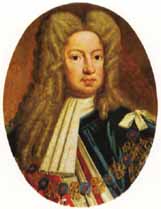 1714-1727 George I
1714-1727 George I
George was the Elector of Hanover and the first of the Hanoverian line of British rulers. He spoke only German. His mother, Sophia, was the granddaughter of King James I of England. 1715 - First Jacobite rebellion. From Jacobus, the Latin name for James, the deposed King James II of England. The Jacobites wanted James II's son, James Francis Edward Stuart, known as the "Old Pretender," to be King. He was a Roman Catholic. |
Historical Timeline: Reign of Kings
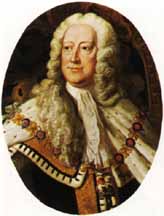 1727-1760 George II
1727-1760 George II
The Seven Years War in Europe, called the French & Indian War in America. 1745 - Second Jacobite rebellion. James II's grandson, Charles Edward Stuart, known as the "Young Pretender" or "Bonnie Prince Charlie", leads an attempt to overthrow Protestant rule. In 1750 the population of England and Wales has grown to 6.5 million. |
Now back to Thomas Heesom of Swanland, whoever his ancestors may have been.
(21) Thomas Heesom (1744)Of North Ferriby and Swanland. "Thomas, son of Thomas Heesom" per his death notice and born circa 1743. Nicolette Heesom believes Thomas was the son of Thomas Hesome (1713) of Carlton. Since DNA testing has proven that my family, who are descendents of John Heesom, son of (17) George Hesome above, and Nicolette's, who are descendents of (21) Thomse Heesom, share an ancestor, I expect this is true.
"Thomas son of Thos Heesom baptized 02 Sep 1744" - Carlton juxta Snaith [Carlton across from Snaith] Parish RegistersJust down the Aire river from Carlton are the villages of North Ferriby and Swanland, on the north shore of the Humber estuary. Note that Thomas Sr. had moved to Carlton from Ackworth, probably as a young man. Carlton is about 15 miles east of Ackworth.
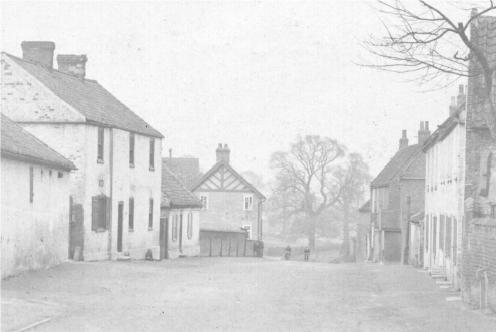 Our Thomas became a wheelwright. Normally I would assume a man would take the trade of his father, but Thomas Sr. was a cordwainer and his father, William, was a carpenter, so there was no pattern of following in a father's footsteps in this family.
Our Thomas became a wheelwright. Normally I would assume a man would take the trade of his father, but Thomas Sr. was a cordwainer and his father, William, was a carpenter, so there was no pattern of following in a father's footsteps in this family.
"Thomas Heesom married Rebecca Sergesson 2nd June 1768 both of this parish by licence by Isaac Thompson witnesses by Robert Newmarch and George Perrot." - from the North Ferriby parish register. Rebecca Sergeson had been born in the parish, she was baptized on 8 February 1743 in North Ferriby - per the parish registers. Her father was Isaac Sergeson. Isaac may have married Ann Bonsil at the church in nearby Kirk Ella.
"Kirk Ella. A.D. 1743. Sept. 17. Isaac Sergeson & Ann Bonsil both of N. Ferriby [parish] by Licence granted by W. Huntingdon Clerk" - from "The Register of Kirk Ella"I will assume that, rather than Rebecca being born illegitimate, the IGI had corrected for the change to the Gregorian calendar and the publication of the parish register had not. That would still mean that Rebecca was a miracle baby, of course.
"Thomas, son of Thomas Heesom, Wheelwright, Swanland, died Dec 24th 1792, buried Dec 25th 1792, Age 49, consumption." - from the North Ferriby parish register. That would imply a birth in about 1743. His son, Thomas Jr., would have been just 19 years old at this time. To the right is Swanland's Main street.
| Swanland
The township is partly in North Ferriby parish and partly in Welton parish. "The village is situated on the east side of the Wolds, in the midst of some beautiful scenery. It stands on an acclivity, one mile north from Ferriby, and seven miles west from Hull." - from Bulmer's. 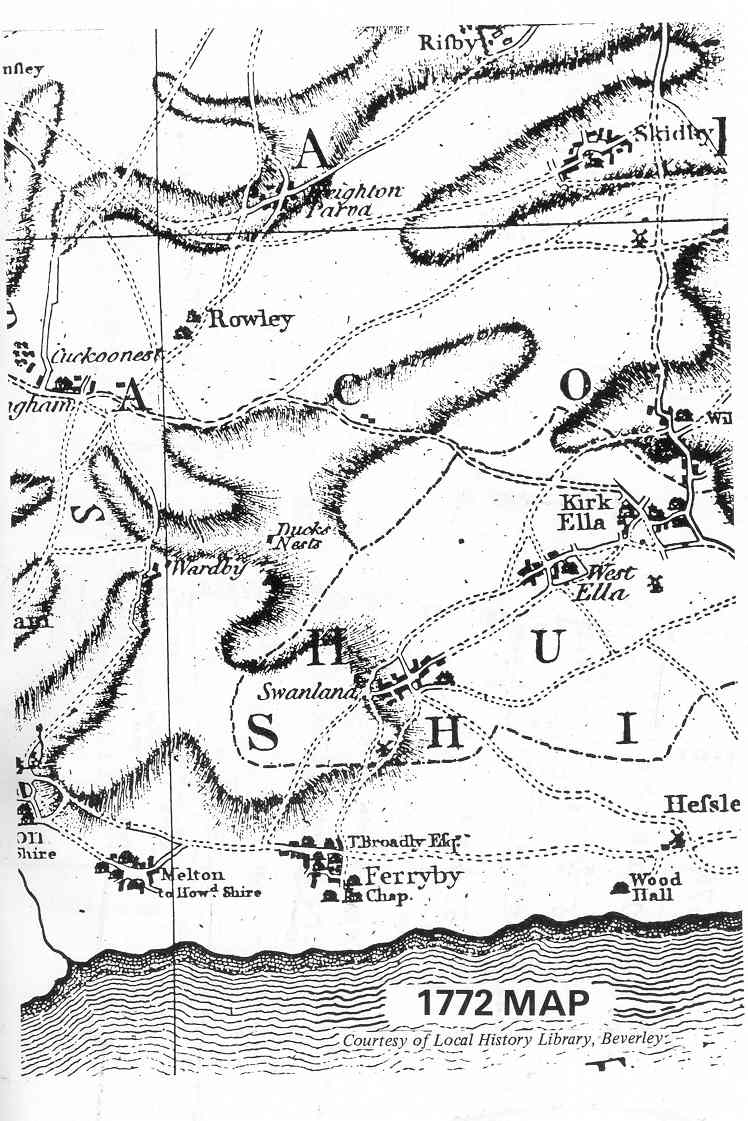 |
Thomas and Rebecca's children were,
(22) Jane Esam (1771)
(22) Thomas Heesom (1773)
Historical Timeline: Reign of Kings
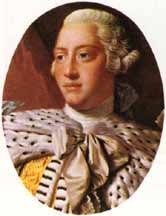 1760-1820 George III
1760-1820 George III
The American & French Revolutions. Napoleanic Wars. During the King's fits of madness the Prince of Wales ruled as Regent (the Regency period). Also Elector, later King, of Hanover. By 1800 the population of England and Wales had exploded to 16.3 million. |
Jane, the daughter of Thos. Esam, was baptized on 2 June 1771 in North Ferriby, Yorkshire, England - from the Parish Registers. According to Nicolette Heesom, Thomas was further described as "of Swanland, Wheelwright" making the correlation complete.
Jane had two illegitimate chidren.
(23) Rebecca Heesom (1795)"Rebecca Heesom, illegitimate, mother Jane, daughter of Thomas Heesom, Swanland. Born Oct 16th 1795, Baptised Nov 8th 1795." - from "England and Wales Christening Records 1530-1906." Rebecca died in 1805, only 10 years old. "Heesm Rebecca, d. of Jane Heesom, Swanland, 20. 5. 05 Convulsions." - from "Yorkshire Burials 1805."
(23) Mary Leake Heesom (1802)Mary was born on 4 July 1802 and baptized on 15 December 1805, at the age of 3, at North Ferriby, Yorshire. Her mother was Jane Heesom, whose father was Thos. Heesom.
Eight years after Mary's birth, Jane apparently married Mary's father. 20 May 1810: "John Leak bach, married Jane Heason spr." - from Sculcoates Parish Records. Sculcoates is just southwest of Swanland, on the south side of the estuary. I also have it as "Jane Heesom married John Leake on 20 May 1810 at Sculcoates, Yorkshire, England" - IGI.
(22) Thomas Heesom (1773)Thomas, the son of Thomas Easam [Easom], was baptized on 29 November 1773 in North Ferriby, Yorkshire, England.
Thomas Heesom married Frances (Fanny) Skane [Skein] on 20 January 1795 at North Ferriby, Yorkshire, England. Nicolette Heesom has, "Thomas Heesom married Frances Skane, both of this parish, married in this church by banns, 30th [sic] January 1795." There was a Frances Scain, the daughter of John, baptized on 6 November 1774 at Market Weighton, Yorkshire. This town is in the East Riding, about 20 miles northwest of Hull. John's wife was Alice Hugh, whom he married on 22 November 1758 in Shipton by Thorpe, in the Deanery of Weighton, Yorkshire. Frances was the last in a line of many children.
Sometime between 1813 and 1817, Frances died. Thomas Heesom then married Elizabeth Bewley, on 12 July 1817 at Welton With Melton, Yorkshire, England. They lived in North Ferriby and Welton - per Pauline Alden. They may have had one child, Maria.
In the 1841 census of Welton parish, Yorkshire as Ths Heesom, a 65 year old "Ag Labor" living at a house called Pool Bank, owned by David Wood, Nurseryman. In the same census, but on a different page, are Eliz Heesom, 55, and Hanh [Hannah], 25.
Thomas died in 1847.
In the 1851 census . . .
In the 1861 census of Welton parish, Yorkshire as Elizabeth [Bewley] Heesom, a 77 year old widow, of Willesby [Willerby], Yorkshire. Living with her was her step-daughter, Hannah, a 47 year old spinster, of Welton.
The following are the children of Thomas and Frances,
(23) Rebecca Heesom (1795)
(23) Isaac Heesom (1799), he died young
(23) Isaac Heesom (1803), the Welton/Sculcoates Branch
(23) Thomas Heesom (1805), suspect he died young
(23) John Heesom (1808), the Hull Branch
(23) Jacob Heesom (1810), the Australian Branch
(23) Hannah Heesom (1813)
The following is the child of Thomas and Elizabeth,
(23) Maria Heesom (1819)
Rebecca was born on 23 December 1795 and baptized on 3 January 1796 at the Swanland Independent Chapel. She married James Andrew. "15 Feb 1824: James Andrew otp Gainsborough and Rebecca Heesom spinster otp married by banns 15th Feb 1824" - from Holy Trinity church, Hull parish register.
There was an Andrew family of Swanland, beginning with a William Andrew, born about 1700 in Swanland, who married Margaret Blackburne in 1734 in Kirk Ella. I haven't found a James Andrew, but the family remained in the village through the 19th century. See The Beginning in Swanland.
(23) Isaac Heesom (1799)Isaac Heesom was christened on 22 October 1799 at Independent, Swanland, Yorkshire, England. He was the son of Thomas and Fanny Heesom. He apparently died young. Independent probably referred to the Swanland Independent Chapel, which was of the Congregationalist faith, a nonconforming, or dissenting church. Note that while many early baptism records were in Swanland Independent Chapel, Marriages and Burials had to take place in the Parish Churches in Kirk Ella, North Ferriby and Rowley.
Nicolette Heesom says that Isaac died on 19 March 1802, aged 2, in Welton, Yorkshire. Her transcription from the burial records of the parish register notes that he was buried on 21 March 1802.
Heesom Isaac
Son of Thomas Heesom Labourer Welton
21.3.02 aged 2
Swanland
21 March 1802
| Swanland Independent Chapel
Non-conformists, or dissenters, had been persecuted since Elizabeth's day, but this increased after the Restoration and those who would not conform to the Episcopal prayer book were forced to worship in secret. Those caught could be fined, imprisoned or transported. One of the sites of these secret services was the old Swanland Chantry. It had been founded in 1332, a Chapel at Ease to the Priory of North Ferriby. It fell out of use when the priory was put down by Henry VIII. The vicars of Ferriby, Hessle, South Cave and Cottingham refused to abide by the new strictures and were ejected from their livings. The vicar of Ferriby moved to Elloughton and preached there and in the surronding villages, probably including at the Swanland chantry. The Swanland Independent Chapel was first recorded in 1688 by the administrators of the more tolerant William III, of Orange. The Independent Church was officially founded in 1693. By 1715 membership numbered 460, attesting to the strong non-conformist viewpoint of the region. A new chapel was built on the site of the old in 1803. Baptisms were recorded at the Independent chapel, but marriages and burials had to take place in the parish church. 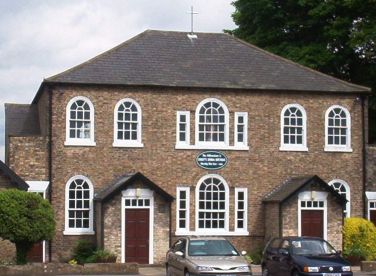 |
Isaac Heesom was born on 19 July 1803 and christened on 19 August 1803 at the Swanland Independent Chapel, Swanland, Yorkshire, England. He was the son of Thomas and Fanny Heesom. The later census returns indicate Isaac thought he was born in 1806.
Nicolette Heesom provides an interesting story about Isaac.
"In the memoirs of his nephew, James, Isaac is described as 'a man of six feet', known as 'a great athlete' when he was young. His hair was 'black as coal', and his beard was 'long and black, appearing to hang in small ringlets about his face'. As a young man, someone challenged him to leap over a wagon for a bet of five pounds. He managed the leap, but caught his shoe heel on a screw, as he was landing and broke his leg. He won the bet, but was left with a slight limp for the rest of his life." - from Nicolette Heesom
Isaac Heesom married Mary Craike [Crake] on 09 September 1826 at Welton With Melton, Yorkshire, England. She was born in 1807 in Welton and christened on 4 April 1807, the daughter of John Crake and Sarah Hawton.
In the 1841 census of Welton parish, Yorkshire as Isaac Heesom [Husom in Ancestry.com], a 35 year old sawyer, that is, he sawed logs into boards. Living with him were his wife, Mary, 30, and children Thos, 13 , John, 11, Fanny, 6, William, 4, and Sarah, 2.
I have an Isaac Heheesom, of Hull, on the marriage register for the 4th quarter 1846. I don't know who his wife might have been. If that was our man, then he and this wife had no children.
Mary died and Isaac the married Eliza Rebecca Hutty in January-March 1851, in Sculcoates. In the 1851 census of Welton parish, Yorkshire as Isaac Heesom [Neesom in Ancestry.com], a 47 year old woodman, of Swanland. Living with him were his wife, Eliza, 28 [the old goat found a young wife], and children, Thos, a 22 year old blacksmith, and William, 14, of Welton.
In the 1861 census of Welton parish, Yorkshire as Isaac Heesom, a 55 year old woodman. He was a widower, of Swanland, Yorkshire, residing at Welton Dale, a private cottage. Living with him were his childen, Polly, 9, George, 6, James, 3, and Sherwood, 5 months, all of Welton. I wonder if Isaac might have held a position on the Welton Dale estate?
In the 1871 census of Welton as Isaac Heesom, a 69 year old woodman "out of employ." He was a widower, of Swanland. Living with him were his children, Mary, 19, James, 14, and Sherwood, 10, all of Welton.
Isaac Heesom, who was born in about 1801, died on 26 August 1871 in the Sculcoates district, Yorkshire, at the age of 70. Nicolette Heesom provided the following from the deaths column of the York Herald of 2 September 1871,
"Mr. Isaac Heesom, joiner, Welton on the 26th aged 70."
The children of Isaac and Mary were,
(24) Thomas Heesom (1827)
(24) John C. Heesom (1829)
(24) George Heesom (1831), he died in 1841
(24) Fanny Heesom (1834)
(24) William Heesom (1836)
(24) Sarah Heesom (1839)
(24) George Heesom (1841), he died in the same year [?]
The children of Isaac and Eliza were,
(24) Mary "Polly" Heesom (1852)
(24) George Heesom (1855)
(24) James Heesom (1858)
(24) Sherwood Heesom (1860)
Thomas Heesom was christened on 31 October 1827 at Welton With Melton, Yorkshire, England, the son of Isaac Heesom and Mary Craike.
In the 1841 census of Welton parish, Yorkshire as Thos Heesom [Husom in Ancestry.com], 13. In the 1851 census of Welton parish, Yorkshire as Thos Heesom, a 22 year old blacksmith, living at home.
Thomas Heesom, 29, married Emma Gibbard in January-March 1856 and, as some point, moved west. In the 1861 census of Hemsworth, Yorkshire as Thomas Heesom [Husom in Ancestry.com], a 33 year old police officer, of Welton. Living with him were his wife, Emma, 33, of Wellingboro, Northamptonshire, and children, Thomas E., 3, of Hull, and Ada C., 10 months, of Hemsworth. Hemsworth today forms a part of the city of Wakefield.
| The Bobby: The Police Man of England
Early Victorian police worked seven days a week with only five days unpaid holiday a year for which they received £1 per week. Their lives were strictly controlled. They were not allowed to vote and required permission to get married and even to share a meal with a civilian. To allay the public's suspicion of being spied upon, officers were required to wear their uniforms both on and off duty. |
In the 1871 census of Barnsley, Yorkshire as Thomas Heesom [Hersom in Ancestry.com], a 43 year old police officer, of Welton. Living with him were his wife, Emma, 43, of Wellingborough, and children, Thos. Ed., 13, of Hull, Ada Constance, 10, of Hemsworth, Alice Rosa, 7, of Hemsworth, and Frederick Wm., 1, of Barnsley.
Emma died in January-March 1880 in Barnsley. In the 1881 census of Notton [near Barnsley], Yorkshire as Thomas Heesom, a 53 year old police sergeant, of Welton. He may have resided at Staincrofs, a nearby village. Living with him were his children, Thomas Edwd, a 23 year old Former and Wheelwright, of Hull, Ada Constance, a 20 year old housekeeper, of Hemsworth, and Frederick William, 11, of Barnsley.
Thomas Heesom, a 50 year old blacksmith, the son of Isaac Heesom, deceased, married Harriet Towers, 45, the daughter of Cornelius Gibbard, deceased, on 3 June 1883 in Barnsley, Yorkshire. They were married in the presence Thomas' sons, T. E. Heesom and John C. Heesom. Harriet was the younger sister of Thomas' first wife, Emma.
| The Gibbard Family of Northampton
(23) Cornelius Gibbard (c1797) Cornelius Gibbard married Susannah Lander on 31 July 1818 in Daventry, Northampton. As you'll see below, the family had one large christening in 1830 for all but two of their children. In the 1841 census of Daventry, Northamptonshire as Cornelius Gibbard, 44. In the 1851 census of Daventry as Cornelius Gibbard, 54. In the 1861 census . . . In the 1871 census of Daventry, Northamptonshire as Cornelius Gibbard, 75. Living with him were his wife, Susannah, 75, and his grandwon, John Wadsworth, 29, of Abbington, Berhkshire. Cornelius Gibbard died and was buried on 29 February 1876 in Daventry, at the age of 80. His children were, (24) William Gibbard (1830)William Gibbard was christened on 6 July 1830 in Daventry, Northampton, the son of Cornelius and Susanna Gibbard. (24) Anne Gibbard (1830)Anne Gibbard was christened on 6 July 1830 in Daventry, Northampton, the daughter of Cornelius and Susanna Gibbard. (24) Emma Gibbard (1828)Emma Gibbard was christened on 6 July 1830 in Daventry, Northampton, the daughter of Cornelius and Susanna Gibbard. Per the 1841 census, she was probably born in 1828. In the 1851 census of Wellingborough, Northamptonshire as Emma Gibbard, a 25 year old servant. Thomas Heesom, 29, married Emma Gibbard in January-March 1856. Emma died in January-March 1880 in Barnsley. (24) Elizabeth Gibbard (1830)Elizabeth Gibbard was christened on 6 July 1830 in Daventry, Northampton, the daughter of Cornelius and Susanna Gibbard. (24) Mary Gibbard (1830)Mary Gibbard was christened on 6 July 1830 in Daventry, Northampton, the daughter of Cornelius and Susanna Gibbard. (24) Sarah Gibbard (1832)Sarah Gibbard was christened on 25 January 1832 in Daventry, Northampton, the daughter of Cornelius and Susanna Gibbard. (24) Harriet Gibbard (1838)Harriet Gibbard was christened on 26 March 1838 in Daventry, Northampton, the daughter of Cornelius and Susanna Gibbard. In the 1871 census of Willaston, Cheshire as Harriet Towers, 33, of Daventry. Living with her was her husband, John Towers, 38, of Daventry. Thomas Heesom, a 50 year old blacksmith, the son of Isaac Heesom, deceased, married Harriet Towers, 45, the daughter of Cornelius Gibbard, deceased, on 3 June 1883 in Barnsley, Yorkshire. They were married in the presence Thomas' sons, T. E. Heesom and John C. Heesom. |
In the 1891 census of Broomfleet, Yorkshire as Thomas Heesom [Hersom in Ancestry.com], a 63 year old living on his own means, of Welton [Walton in Ancestry.com]. Living with him was his wife, Harriet, 63, of Port [garbled] Daventry. Broomfleet is further east, back towards Welton, on the Humber estuary.
Harriet died and was buried in St. Marys churchyard in Broomfleet, Yorkshire.
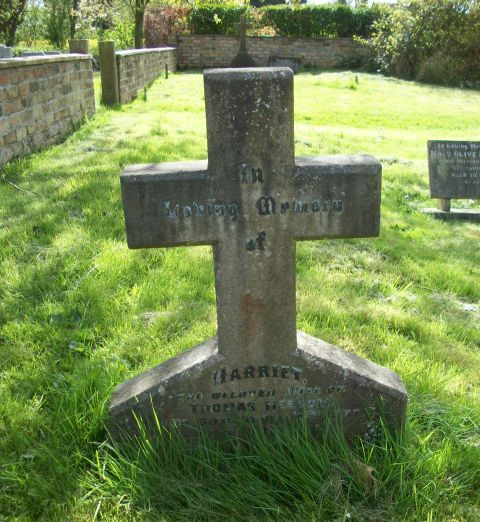
Interestingly, a "Heesom Thomas, dalekeeper, Welton Dale cot[tage]" was listed in Bulmer's Directory of Welton for 1892. Dalekeeper, like a grounds keeper, was probably a position with Welton Dale estate. Remember that in 1861 Isaac Heesom, Thomas' father, was residing at Welton Dale, a private cottage.
Thomas Heesom married Mary Ann Oates in July-September 1899 in Lancaster. In the 1901 census of Poulton, Bare, and Torrisholme, Lancashire as Thomas Heesom, a 73 year old retired police sergeant, of Welton. Note that his brother, John, below, had moved to Poulton, Lancashire in 1881. Living with Thomas were his wife, Mary A., 50, and his sister, Mary, a 49 year old domestic servant. Poulton is in the far west of Lancashire.
Thomas Heesom, 77, died in the 3rd quarter 1904 in Morecombe, Lancashire. This is a village just north of Heysham. His children were,
(25) Thomas Edward Heesom (1858)
(25) Ada Constance Heesom (1860)
(25) Alica Rosa Heesom (1863)
(25) Frederick William Heesom (1870)
Thomas Edward Heesom was born in the 1st quarter 1858 in the Sculcoates district, Hull, Yorkshire. In the 1861 census of Hemsworth, Yorkshire as Thomas E. Heesom, 3, of Hull. In the 1871 census of Barnsley, Yorkshire as Thos. Ed. Heesom, 13, of Hull. Thomas Edward, the son of Thomas and Emma Heesom, was baptized on 8 February 1863 in Hemsworth, Yorkshire. Interestingly Thomas' two younger sisters were also baptized in 1863, though all in different months. Perhaps this had to do with joining a new church.
In the 1881 census of Notton [near Barnsley], Yorkshire as Thomas Edwd Heesom, a 23 year old Former and Wheelwright, of Hull.
Thomas Edward Heesom, a 24 year old Joiner and Wheelwright, of Staincross, the son of Thomas Heesom, Police Serjeant, married Emmeline Birkinshaw, 18, the daughter of John Berry Birkinshaw, on 2 April 1882 in Barnsley. This may be the Birkinshaw family of Jenet Byrkinshawe, who married Raphe Hesome in Barnsley in the 16th century. They were married in the presence of Thomas' sister, Ada Constance, and Emmeline's father, John Birkenshaw.
In the 1891 census of Darton, Yorkshire as Thomas Ed Heesom, a 33 year old unemployed joiner, of Hull. A joiner was a kind of carpenter who created joints without the use of nails. He was living with his mother-in-law, Mary Ann Birkinshaw, and his wife, Emmeline, 27, both of Darton.
In the 1901 census of Darton, Yorkshire as Thomas E. Heesom [Hersom in Ancestry.com], a 42 year old wagengate [garbled] proprietor, of Hull. He was living with his mother-in-law, Mary A. Birkinshaw and his wife, Emmeline, 37. They had no children.
In the 1911 census of Royston, Yorkshire as Thomas Ed. Heesom, a 53 year old carter of coal, of Hull. Living with him was his wife, Emmeline, 47, of Darton.
Thomas and Emmeline had no children.
(25) Ada Constance Heesom (1860)Ada Constance Heesom, the daughter of Thomas and Emma Heesom, was born in 1860 and baptized on 28 January 1863 in Hemsworth, Yorkshire. In the 1861 census of Hemsworth, Yorkshire Ada C. Heesom, 10 months, of Hemsworth. In the 1871 census of Barnsley, Yorkshire as Ada Constance Heesom, 10.
In the 1881 census of Notton [near Barnsley], Yorkshire as Ada Constance Heesom, a 20 year old housekeeper, of Hemsworth. Ada Constance Heesom married Thomas Mason in January-March 1889 in the East Riding.
(25) Alica Rosa Heesom (1863)Alice Rosa Heesom, the daughter of Thomas and Emma Heesom, was baptized on 22 November 1863 in Hemsworth, Yorkshire. In the 1871 census of Barnsley, Yorkshire as Alice Rosa Heesom, 7, of Hemsworth. In the 1881 census South Cave, Rowley, Yorkshire as Alice Heesom [Olive Hesom in Ancestry.com], a 17 year old housemaid, of Hemsworth. She was living in the home of the Rector of Rawley. Alice Rosa Heesom married William W. Guest on 2 June 1884, in Beverly, East Riding, Yorkshire.
Alice died in 1940 in Hull, Yorkshire.
(25) Frederick William Heesom (1870)Frederick William Heesom was born in January-March 1870 in Barnsley. In the 1871 census of Barnsley, Yorkshire as Frederick Wm. Heesom, 1, of Barnsley, the son of Thomas and Emma Heesom. In the 1881 census of Notton [near Barnsley], Yorkshire as Frederick William Heesom, 11, of Barnsley.
In the 1891 census of Darton, the Barnsley division of Yorkshire, as Fred Wm Heesom, a 21 year old coal carter, of Barnsley. He was single and a boarder at the house of Thomas Able. A coal carter drove a small horse-drawn cart loaded with . . . coal. This might have been at a mine or while delivering coal for household use.
Frederick William, a 26 year old Inn Keeper, the son of Thomas Heesom, a police serjeant, married Ruth Barnard, a 23 year old spinster, the daughter of William Barnard, a shephard, in Barnsley on 21 July 1896. They were married in the presence of Arthur Birkinshaw, an uncle?, and Lucy Barnard.
F. W. Heesom was a "beer retailer" circa 1897 at the Ferryboat Tavern in Sculcoates/Hull (Wincolmlee). Does that mean he was the publican?
| Ferryboat Tavern
The Ferryboat "was one of the larger Wincolmlee pubs, and was converted from part of a row of dwelling houses and shops. Situated south of Sculcoates Bridge, and almost opposite the end of York Street . . . The Ferry Boat Inn closed on 17 December 1936 and was later demolished." 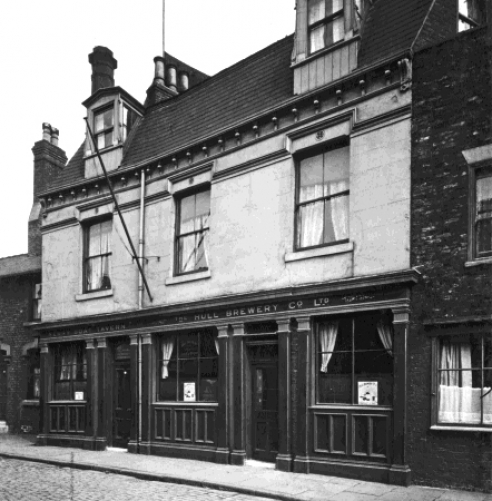 |
In the 1901 census of Sculcoates, Yorkshire as Frederic W. Heesom, a 31 year old general carter, of Barnsley. Living with him was his wife, Ruth, 28, of Staincross. They had no children.
In the 1911 census of as Fred Wm Heesom, a 41 year old [rullyman?] - wholesale grocer, of Barnsley. Living with him was his wife, Ruth, 37. They had been married 14 years.
Frederick W. Heesom, born in about 1870, died in the last quarter of 1950 in Hull, Yorkshire, aged 80. Frederick and Ruth had no children.
(24) John Heesom (1829)John Heesom, the son of Isaac and Mary Heesom, was christened on 20 September 1829 at Welton With Melton, Yorkshire, England.
In the 1841 census of Welton parish, Yorkshire as John Heesom [Husom in Ancestry.com], 11. In the 1851 census of Glusburn, Yorkshire as John Heesom, a 21 year old married [?] servant (a groom), of Welton. Who was his first wife?
John married Hannah Overend in October-December 1852 in Skipton, West Riding.
In the 1861 census of . . .
In the 1871 census of Cowling, Yorkshire as John Heesom [Hersom in Ancestry.com], a 40 year old coachman, of Welton. Living with him were his wife, Hannah, 38, of Glusburn, and children, Elizabeth, a 16 year old worsted weaver, Annie, 10, Fanny, 6, and Hannah, 3, of Cowling.
In the 1881 census of Poulton Barre and Torrisholme, Lancashire as John Heesom, a 51 year old cab proprietor, of Welton. He had a number of boarders living in the house, including a retired surgeon and a retired Lieutenant of the 24th Regiment, and their wives. Living with him were his wife, Hannah, 49, of Kildwick, and children, Annie, 20, Fanny, 16, and Hannah, 13, of Cowling.
| Cab Proprietor
|
In the 1891 census of Poulton, Bare and Torrisholme, Lancashire as John Heesom [Husom in Ancestry.com], a 62 year old cab proprietor, of Welton. Living with him were his wife, Hannah, 59, and daughter, Hannah, 23, of Kildrick, Yorkshire.
In the 1901 census of . . .
His children were,
(25) Elizabeth Heesom (1854), of Cowling. An Elizabeth Heesom was born in the 4th quarter 1854 in Skipton, Yorkshire. Skipton was where John and Hannah Heesom were married. In the 1871 census of Cowling, Yorkshire as Elizabeth Heesom, a 16 year old worsted [wool] weaver. An Elizabeth Heesom, born in about 1854, died in June 1929, aged 75, in Leeds, Yorkshire. If this was the correct woman then she never married. But, where was she in 1881 and after?
(25) Annie Heesom (1860), of Cowling. An Ann Heesom was born in the 2nd quarter 1860 in Skipton, Yorkshire. In the 1871 census of Cowling, Yorkshire as Annie Heesom, 10. In the 1881 census of Poulton, Lancashire as Annie Heesom, 20. She disappears after this.
(25) Fanny Heesom (1864), of Cowling. A Fanny Heesom was born in the 4th quarter 1864 in Skipton, Yorkshire. Named for her grandmother, Fanny Skane? In the 1871 census of Cowling, Yorkshire as Fanny Heesom, 6. In the 1881 census of Poulton, Lancashire as Fanny Heesom, 16. A Fanny Heesom married James Laytham [or William Savage] in the 1st quarter 1887 in Lancaster, Lancashire.
(25) Hannah Heesom (1867), of Cowling. A Hannah Heesom was born in the 4th quarter 1867 in Skipton, Yorkshire. In the 1871 census of Cowling, Yorkshire as Hannah Heesom, 3. In the 1881 census of Poulton, Lancashire as Hannah Heesom, 13. In the 1891 census of Poulton, Lancashire as Hannah Heesom, 23, still living with her parents, John and Hannah Heesom.
George Heesom was christened on 16 October 1831 at Welton With Melton, Yorkshire, England. The son of Isaac and Mary Heesom. He died in 1841 in Welton, Yorkshire at the age of 10.
(24) Fanny Heesom (1834)Fanny Heesom was christened on 03 November 1834 at Welton With Melton, Yorkshire, England. She was the daughter of Isaac and Mary Heesom. In the 1841 census of Welton parish, Yorkshire as Fanny Heesom [Husom in Ancestry.com], 6, living at home with her parents, Isaac and Mary Heesom. I don't see her in the 1851 census.
(24) William Heesom (1836)William Heesom was christened on 18 December 1836 at Welton With Melton, Yorkshire, England. He was the son of Isaac and Mary Heesom.
In the 1841 census of Welton parish, Yorkshire as William Heesom [Husom in Ancestry.com], 4. In the 1851 census of Welton parish, Yorkshire as William Heesom [Neesom in Ancestry.com], 14, of Welton. He was living with his father, Isaac, and his step-mother, Eliza.
In the 1861 census . . .
(24) Sarah Heesom (1839)Sarah Heesom was christened on 14 July 1839 at Welton With Melton, Yorkshire, England. The daughter of Isaac and Mary Heesom.
(24) George Heesom (1841)George Heesom was christened on 14 June 1841 at Welton With Melton, Yorkshire, England. He was the son of Isaac and Mary Heesom. He apparently died young.
(24) Mary "Polly" Heesom (1852)Mary Heesom was born in the 1st quarter 1852 in the Sculcoates district, Yorkshire. In the 1861 census of Welton parish, Yorkshire as Polly Heesom, 9, of Welton, living at home with her widowed father, Isaac. In the 1871 census of Welton, Yorkshire as Mary Heesom, 19, living at home with her widowed father, Isaac. In the 1881 census of Welton, Yorkshire as Mary Heesom, a 29 year old servant in the house of Philip James, 57.
In the 1891 census of . . .
In the 1901 census of Morecambe, Lancashire as Mary Heesom, a 49 year old domestic servant, of Welton. She was living with her brother, Thomas Heesom, 73, and his wife, Mary A., 50.
In the 1911 census of Poulton, Bare and Torrisholme [the civil parish that contains Morecambe] as Mary Heesom, a 58 year old sick nurse, of Idle, Yorkshire, working in the house of Thomas Gleave, 60.
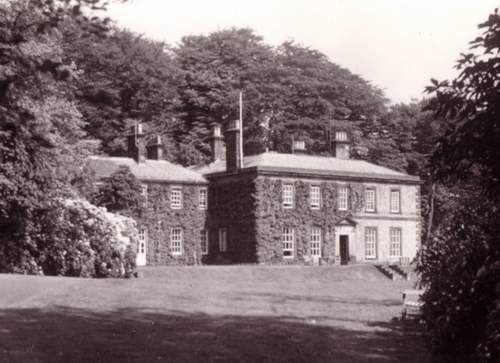 (24) George Heesom (1855)
(24) George Heesom (1855)In the 1861 census of Welton Dale, Welton parish, Yorkshire as George Heesom, 6, of Welton, the son of the woodman, Isaac Heesom. George's mother, Eliza, had died within the last 5 months.
In the 1871 census of Cowling parish, Yorkshire as George Heesom, a 16 year old stable boy, living in the house of William Wainman, "JP Do. L." George was shown as being born in Wilton [sic] Dale.
The Wainman family held the Manor of Cowling and the estate of Carr Head, right. There were many servants employed at such a great house. In the stables were the stable hands. At the top was the head groom or stablemaster. In the largest establishments there would be several grooms, trainers, stablemen and a plethora of stable boys.
| William Wainman
The Wainman family were large landowners. "The last male head of this family was the late William Bradley Wainman, of Carrhead, in the parish of Kildwick, Esq., J.P. and D.L., who died very suddenly on the 17th January 1872. Carrhead has always been the chief ancestral residence of the Wainman family." - from "Round About Bradford: A Series of Sketches" by William Cudworth. |
 Sometime after the death of William Wainman in 1872, George went into service with another family, the Palmers.
Sometime after the death of William Wainman in 1872, George went into service with another family, the Palmers.
In the 1881 census of Cefn Hall, Abenbury Fawr, Wrexham parish, Denbighshire, Wales as George Heesom, a 26 year old valet, of E.R. [East Riding], Yorkshire. He was working for the Baronet, Major General Roger Wm. Henry Palmer. He was unmarried.
Being a valet of a Baronet reminds me of Jeeves, Bertie Wooster's valet, or Sir Peter Wimsey and his man, Bunter. A valet, or gentleman's gentleman, was a male servant who acted as a personal attendant to his employer. He maintained his master's clothes, ran his bath and may have shaved him. In smaller households the butler did double-duty as valet. There was, of course, a vast gulf between a stable boy and a valet. George would have held other roles first to learn the necessary skills. He may have become a footman first, then been deputized as the head valet's assistant or served as valet for his employer's guests or sons, if he had any.
The members of the Palmer staff in 1881 were,
Richard Albert Peltat, ButlerNote the absence of a cook; perhaps she lived off the estate. At the time of the census, the only family at the house was Roger Palmer himself. He had two visitors: William Samuel MacMahon, Baronet, a retired Army Captain, and Marcus Windsor Sandys, Hon Captain Royal Wiltshire Militia.
George Heesom, Valet
Thomas Herbert Court, Footman
William Booth, Groom
Frederick Causton, Helper
Isabella McTavish, Housekeeper
Emma Richards, Laundrymaid
Dina Lloyd, Housemaid
Charlotte Hall, Kitchen Maid
Katherine Combs, Scullery Maid
| The Palmer Baronets
Sir Roger William Henry Palmer (1832-1910), of Kenure Park, county Dublin, became the the 5th Baronet of Castle Lackin in 1869. He was the son of Sir William Henry Roger Palmer. Roger was appointed Cornet (a cavalry 2nd Lieutenant) by purchase in 1853. He rode with the 11th Hussars in the charge of the Light Bridage at the Battle of Balaclava during the Crimean War in 1854, his life being saved by a Private Jowett. He joined the Life Guards 1856 and became Colonel of the 20th Hussars in 1891. He was made an honorary Lieutenant General. A Member of Parliament for county Mayo. Extensive landowners, the Palmers held 115,000 acres in Ireland, Wales and Berkshire. They had residences at Portland House, London; Kenure Park, Dublin; Keenagh, county Mayo; Cefn Park, Wrexham, Wales and Glen Island, Maidenhead, Berkshire. The 5th Baronet died on 30 May 1910 at Cefn Park, Wrexham, Wales. He had no male heirs. |
George Heesom married Geraldine Sarah Tobin in July-September 1890 in Cookham, Berkshire. Rather too close to the birth date of his son, Lionel, don't yah think? I suspect this was while he was at the Baronet's residence at Maidenhead. According to the 1901 census Geraldine had been born in Ireland. I wonder if she had been in service with the Palmers as well? The romance of the butler and the upstairs maid perhaps?
In the 1891 census of Abenbury Fawr, Denbigshire, Wales as George Hersom, married, a 36 year old Valet, of Welton, Yorkshire. He was working for the family of [Baronet] Roger Wm Henry Palmer, 58. Where was Geraldine?
In the 1901 census of Maidenhead, Berkshire as George Heesom [Hersom in Ancestry.com], a 46 year old butler, of Welton. Living with his was his wife, Geraldine, 40, of Ireland, and their son, Lionel [Leonel in Ancestry.com], 11, of Maidenhead.
In the 1911 census of St George Hanover Square, London as Geraldine Heesom, a 47 year old caretaker, married for 23 years, of Tipperary. She was married, not a widow. So, where was George? She was shown as having had 4 children, of which only one was still living. By the time of the 1911 census the old Baronet had died without a male heir. What would that mean for George? The Baronet's widow lived on until 1929 so George, the butler, probably stayed on in that capacity. The property eventually devolved to Colonel Roderick Henry Fenwick-Palmer.
A Geraldine Heesom, 74, born in about 1855, died in the 2nd quarter 1929 in Hammersmith, London.
(25) George Lionel I. Heesom (1890)George Lionel I. Heesom was born in Cookham, Berkshire in July-September 1890. Was the I for Isaac? In the 1891 census of . . .
In the 1901 census of Maidenhead, Berkshire as Lionel [Leonel in Ancestry.com] Heesom [Hersom in Ancestry.com], 11, of Maidenhead, living with his parents, George and Geraldine Heesom.
In the 1911 census . . .
George L. Heesom married Mary Hourigan in the 2nd quarter 1914 in Hampstead, London. George L. Heesom, born in about 1891, died in June 1923 in Willesden, Middlesex, England, at the age of 32.
(26) Geraldine Mary P. Heesom (1915)A Geraldine M. P. Heesom was born in 1915, mother's maiden name Hourigan, in Willesden, Middlesex. She was listed on the London Electoral Registers through the 1930's, 40's and 50's. In the 1930's she was living with a Mary Heesom, probably her mother. She died in 1958 in Willesden.
Today there is a Patrick G. Heesom, a Councillor of Flintstone, Wales. This is close by Wrexham. Is he a descendent of the Wrexham clan above or of the Heesom's of Cheshire? Patrick G. Heesom was born in the 2nd quarter June 1937 in Runcorn, Cheshire, mother's maiden name Mullaney. He married a Smith in 1972.
There is also a Patrick Glyn Heesom, a sculptor, living in Rhyl, North Wales. This could be the same man, or his son.
(24) James Heesom (1857)James Heesom was born in the 2nd quarter 1857 in Sculcoates, Yorkshire. The son of Isaac Heesom and Eliza Rebecca Hutty. In the 1861 census of Welton parish, Yorkshire as James Heesom, 3, of Welton. His mother had died by the time of this census. In the 1871 census of Welton as James Heesom, 14, of Welton, living at home with his father, Isaac.
In the 1881 census as of Welton and Melton, Yorkshire as James Heesom, a 23 year old laborer, of Welton. He was single and a boarder.
In the 1891 census . . .
In the 1901 census of Beverley, Holderness, Yorkshire as James Hessman, a 44 year old servant/cattleman on a farm, of Welton. He was working on the farm of George W. Wright.
In the 1911 census of Sculcoates, Yorkshire as James Heesom, a 53 year old farm laborer and inmate of the Sculcoates Union Workhouse, of Welton. He was single.
James Heesom died in the 3rd quarter 1920, at the age of 63, in Sculcoates, Yorkshire. I don't show that he ever married or had any children.
(24) Sherwood Heesom (1860)He was born in the Sculcoates district of Yorkshire in Oct-Dec of 1860. Sculcoates is a suburb of Hull. In the 1861 census of Welton parish, Yorkshire as Sherwood Heesom, 5 months, of Welton. His mother had died by the time of the 1861 census. In the 1871 census of Welton as Sherwood Heesom, 10, of Welton.
In the 1881 census of Welton and Melton, Yorkshire as Sherwood Heesom, a 20 year old "Engine Driver at present Agric. Laborer," of Welton. He was a lodger in the house of Joseph Sutton. An engine driver worked on a steam engine, perhaps in this case a tractor.
Sherwood Heesom, son of Isac Heesom, married Ellen Smith on 13 June 1888 at Sculcoates, Yorkshire, England.
In the 1891 census of Sculcoates, Kingston-on-Hull, Yorkshire as Sherwood Heesom, a 30 year old Lighterman Barge, of Welton Dale. Living with him were his wife, Ellen, 24, and son, George H., 1. A lighterman operated a barge on the rivers and canals. Below is a lighterman in London circa 1910.
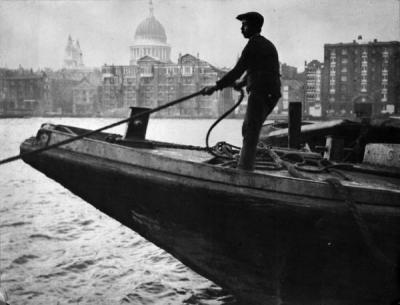
Interestingly, a Mary Jane Sherwood Heesom was born to Edmund Heesom and Jessie Irvine on 10 February 1895 in Yinnar, Victoria, Australia. Was there a connection?
In the 1901 census of Sculcoates, Yorkshire as Sherwood Heesom [Hersom in Ancestry.com], a 40 year old Lighterman. Living with him were his wife, Ellen, 37, and children, George H., 11, Mary J., 8, James, 7, and Eslie [?], 4.
In the 1911 census of Sculcoates, Yorkshire as Sherwood Heesom, a 50 year old Lighterman, of Hull. Living with him was his wife, Ellen, 47, and children, Mary Jane, an 18 year old mill hand, James Robert, a 17 year old laborer, Elsie Caroline, 14, Ellen, 4, and William Edward, a 20 year old laborer. The latter was listed as a lodger, not a son. Might he be a nephew? However, I don't see him anywhere else on this page. All were of Hull.
A Sherwood Heesom, born in about 1861, died in the 1st Quarter 1947 in Hull, Yorkshire.
His children were,
(25) George Herbert I. Heesom (1889)
(25) Mary Jane Heesom (1893)
(25) James Robert Heesom (1894)
(25) Elsie Caroline Heesom (1897)
(25) Sherwood Heesom (1899), born in the 1st quarter 1899 in Sculcoates, died in the same quarter/same year
(25) Ellen Heesom (1907)
George Herbert I. Heesom who was born in September 1889 in Sculcoates, Yorkshire. The middle initial "I" may be for Sherwood's father, Isaac. In the 1891 census of Sculcoates, Kingston-on-Hull, Yorkshire as George H. Heesom, 1, of Hull. In the 1901 census of Sculcoates, Yorkshire as George H. Heesom [Hersom in Ancestry.com], 11. He was living with his parents, Sherwood and Ellen Heesom. George's father died soon after this.
In the 1911 census of Tottenham, Middlesex, London as George Herbert Heesom, a 21 year old police constable, of Hull. He was boarding in the house of Ellen Clara Milsom and her family.
George Herbert Isaac Heesom married Lilian Lawson on 23 June 1912 in the Tottenham Holy Trinity church, Haringey. This is just north of London.
George Herbert and Lilian Heesom were in the Electoral Register of 1925 for Edmonton, Middlesex.
George moved to Hertfordshire and became the publican of the Railway Tavern in Ware. "The publican listed from 1929 through 1939 was my grandfather" - per Graham Pugh. "Mr. Heesom was born in Hull, Yorkshire on July 3, 1890 and died at Herne Bay, Kent, in 1968."
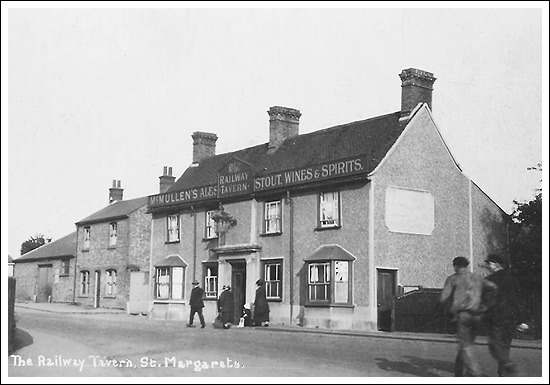
Year/Publican or other Resident/Relationship to Head and or Occupation/Age/Where Born/Source.
1929/Geo Heesom/../../../Post Office Directory
1933/Geo Heesom/../../../Post Office Directory
1937/Geo Heesom/../../../Post Office Directory
1939/Geo. Heesom/../../../Kelly's Directory of Hertfordshire
George H. I. Heesom, born in about 1890, died in 1st Quarter 1968 in Bridge, Kent. His children were,
(26) Lilian G. E. Heesom (1913)
(26) Florence N. Heesom (1914)
(26) George William Heesom (1916)
She was born in the 1st quarter 1913 in Edmonton, Middlesex. Her mother's name was Lawson. Lilian G. E. Heesom married Albert E. Pugh in the 1st quarter 1940 in Edmonton, Middlesex. Bert Pugh was born in Enfield, Middlesex on 25 Auguust 1916. Bert and Lily Pugh ran the Railway Inn (aka Railway Tavern) circa 1945-1954. The Pugh's came to America, where Bert died, in 1993, in Midwest City, Oklahoma. Lily died on 16 April 2000 in Midwest City.
(27) George Pugh (c1941)The grandson of George Heesom, above, and nephew of George William Heesom, below.
(26) Florence N. Heesom (1914)She was born in the 4th quarter 1914 in Edmonton, Middlesex. Her mother's name was Lawson. She married George Wagstaff in the 1st quarter 1940 in Ware, Hertfordshire.
(26) George William Heesom (1916)Of Edmonton, Middlesex. I believe this may be the William Heesom who was noted to be the uncle of Graham Pugh. He lived at the house to the left of the pub in the photograph above. He managed the French & Jupps maltings located behind the house.
I have a George W. Heesom who was born in the 1st Quarter 1916 in Edmonton, Oxfordshire. His mother's maiden name was Lawson. Per his death record, he was born on 11 February 1916.
George W. Heesom married Joyce W. Ford in the 2nd Quarter 1941 in Hackney, Middlesex. I have a George W. J. Heesom who lived in the borough of Tottenham, Middlesex, London in 1960-61.
George Willliam Heesom, who was born in 1916, died in June 1981 in Canterbury, Kent at the age of 65.
(27) John R. W. Heesom (1946)According to his own recollections, his grandfather was George Heesom, who was born in about 1900 in Hull, Yorkshire. The family later moved to Kent. John R. W. Heesom was born in the 2nd Quarter 1946 in Bishop's Strotford district, Leicestershire. His mother's maiden name was Ford. He was born in the same quarter as Bruce D.J. Heesom, of Runcorn, and Marjorie R. Heesom, of Stoke.
John married Ann H. Shilling in the 4th Quarter 1966 in Bridge district, Kent. J.R.W. Heesom lived in Bayswater, Kent from at least 1978 to 1982.
John has three daughters and the male line of the family ends at this point. He also has sisters, whose descendents are in America. 68 years old in 2013.
(25) James Robert Heesom (1894)He was born on 25 March 1894 in Sculcoates. In the 1901 & 1911 census of Sculcoates, Yorkshire, living with his parents. He died in the 1st Quarter 1988 in Beverly, Yorkshire, at the age of 93. His son was Peter.
(26) Peter J. Heesom (1928)Peter Heesom was born on 15 July 1928 in Sculcoates, Yorkshire. His wife was Catherine. I have a Peter J. Heesom who married Catherine A. Godfrey in the 3rd quarter 1950 in Hull, Yorkshire. I also have a Peter J. Heesom who married Pauline T. Bailey in the 1st quarter 1957 in Nottingham. Both lived together in Nottinghamshire for a number of years. He died in the 1st quarter 1996 in Beverly, Yorkshire.
(23) Thomas Heesom (1805)Thomas Heesom was christened on 04 November 1805 at the Independent church, Swanland, Yorkshire, England. The son of Thomas Heesom and Frances "Fanny" Skane. I suspect he died young.
(23) Reverend John Heesom (1808)John, the son of Thomas Heesom [Husom] and Fanny, born on 19 January 1808 and baptized on 25 January 1808 at Swanland Independent.
John Heesom married Maria Beecroft on 30 November 1829 at Holy Trinity, Kingston Upon Hull, Yorkshire, England. Maria, the youngest daughter of James Beecroft, "cow keeper," and Mary Whitehead, was christened on 3 September 1811 in Kingston on Hull. Also as Becraft. A cow keeper was probably a small dairy man. He would have several cows which he kept in, or very near the city. He would milk them daily, then drive them to a common pasture to graze while he delivered the fresh milk in the town. Think of Tevye and his milk cart, ladling milk from large churns into the customer's jug.
In the 1841 census of Welton, Yorkshire as John Heesom [Husom in Ancestry.com], a 30 year old tailor. Living with him were his wife, Maria, 25, and children Emma, 10, Eliza, 7, Edwin, 5, and James, 2.
John's son, James, wrote a memoir in 1918 in which he mentioned that his "father had been caught by the press gang in Hull, but was released by the [section missing] broken it by falling from a tree as a child."
"Unclear section in the British Dental Journal is as follows - "father had been caught by the press gang in Hull, but was released by the naval doctor who examined the recruits because one of his arms was weak (he had broken it by falling from a tree as a child)" - from Nicolette Heesom
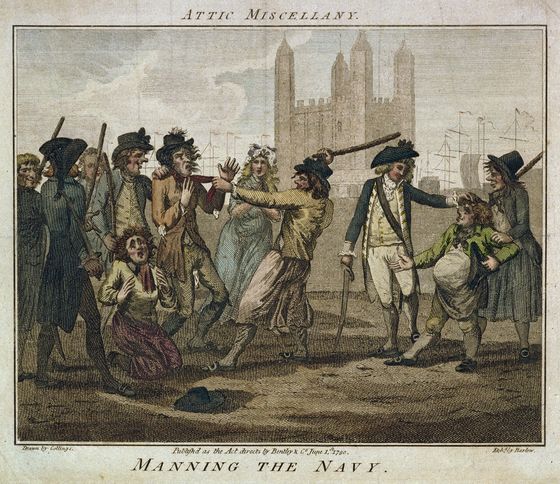
John was tragically killed, on 6 October 1841, by a steam train while he was reading his bible in the streets of Hull [though of course it's not really funny under the circumstances, but I can't resist saying, 'and they say reading is good for you!']. There is an account of his death in The Hull Advertiser on 8 October 1841, page 3.
"The BDJ story of John's death is the one that has been passed down our family, but the account in The Hull Advertiser is rather different. Apparently John had a part time job opening the gates for the train to pass at Brough, near Welton and one day his timing was wrong. In our archive we have a half-finished commentary on Luke's Gospels written by John on which his widow, Maria, has added the comment that he was writing it 'the Moment before he left the world', so it looks as if John became too engrossed in his writing to notice the time." - from Nicolette HeesomThere was a coroner's inquest and John's death was registered by the coroner at Beverley on 18 May 1842. He left a pregnant wife and four young children.
After John's death, his widow, Maria Beecroft/Heesom, married three times. First, James Mayman married Maria Heesom on 2 October 1848 at Holy Trinity, Hull. One of the witnesses was Maria's daughter, Emma Heesom. James Mayman died in 1850.
In the 1851 census of Myton, borough of Kingston upon Hull, Holy Trinity parish, Yorkshire, as Maria Mayman, a 39 year old widow and grocer. Living with her were her two youngest children, Edwin and James Heesom.
Next, Thomas Jackson married Maria Mayman [Beecroft/Heesom] on 22 May 1852 in Hull.
In the 1861 census of Myrton, Holy Trinity parish, Hull, Yorkshire as Maria Jackson, 49, of Hull. Her husband was Thomas Jackson, a 57 year old Pensioner Merchant Seaman.
Lastly, Edward Kennington married Maria Jackson [Beecroft/Heesom/Mayman] on 13 December 1866 in Hull. This wedding was witnessed by her son Edwin and his wife Christiana.
In the 1871 census of Hull, Yorkshire as Maria Kennington, 59. She was living with her husband, Edward, 49. Frederick Craghill, her daughter Eliza's son, of Paris, was staying with the Kennington's.
In the 1881 census of Buxted, Sussex as Maria Kennington, 69, living with her daughter-in-law Louisa Heesom, and her children, Edwin, Frank and Jessie. Also in the household was Maria's daughter, Emma, and her husband Thomas Biggs. Maria's last three marriages were childless.
In the 1891 census . . .
Maria Kennington died in the 2nd quarter 1897 in Hull, Yorkshire, at the age of 85.
John and Maria's children were,
(24) Emma Heesom (1831)
(24) Eliza Heesom (1834)
(24) Edwin Heesom (1837)
(24) James Ernest Heesom (1839), only he had heirs
(24) John Heesom (1841)
Historical Timeline: Reign of Kings
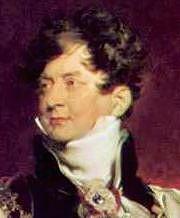 1820-1830 George IV
1820-1830 George IV
He secretly married a Roman Catholic, Mrs. Maria Anne Fitzherbert, in 1785. The marriage was declared illegal 2 years later. He then married his cousin, Caroline of Brunswick. This was an unhappy marriage. During his Regency and as King, George IV was known for his 'foppery.' His main concerns seemed to be gambling, women, his dress, and others' manners. His great friend, Beau Brummel, set the satorial stage for an ascendant empire. While George dallied, Parliament wielded the true power. 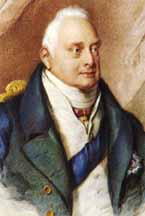 1830-1837 William IV
1830-1837 William IV
Younger brother of George IV. Known as the Sailor King. His was a popular King, appreciated for his simple ways after the flamboyance of George. However, he came to the throne already an old man and had a short reign. |
She married William Melling in Sculcoates in 1849. She later married Thomas Biggs. At the time of the 1881 census Emma and Thomas Biggs were staying with Louisa Heesom, the wife of Emma's brother, James Ernest Heesom, in Buxted, Sussex. James was in Paris at the time.
(24) Eliza Heesom (1834)Eliza, the daughter of John and Maria Heesom, was christened on 23 March 1834 at Welton With Melton, Yorkshire, England. She first married William Anderton Craighill on 9 June 1852 in Sculcoates. One of the witnesses was William Melling, her brother-in-law.
Eliza and William moved to Paris in the 1850's.
At the time of the 1871 census Eliza was staying with her brother, James Ernest, and his first wife, Emma, in St. Marylebone. Eliza was described as a perfumier. Perhaps something she picked up in Paris? Eliza's business card from 1872, as Madame E. Craighill, described her as "Successeur" to a G. Sherrell of 30, Faubourg St. Honore, Paris. The clients of the shop included "la Grande Duchesse Catherine de Russie & des Ambassades Anglaise & Americaine". Nicolette Heesom believes that Eliza was running the Paris branch, as there was also a G. Sherrell's shop in London. A Sherrell perfumier is in existence today, but they appear to sell copycat scents. That section of the Faubourg St. Honore is, today, one of the best addresses in Paris, hosting Chanel, Hermes, Givenchy, Lancome, Valentino and Yves-Saint Laurent.
Eliza's husband, William, died in Paris. She next married William Kirman Andrew, the son of her Aunt Rebecca and her first cousin. They married at the Holy Trinity church, Hull on 24 December 1883. One of the witnesses was Thomas Biggs, the second husband of Eliza's sister Emma.
(24) Edwin Heesom (1837)In the 1841 census of Welton, Yorkshire as Edwin Heesom [Husom in Ancestry.com], 5, living with his parents, John and Maria Heesom [Husom in Ancestry.com]. In the 1851 census of Myton, the borough of Kingston upon Hull, Holy Trinity parish, Yorkshire, as Edwin Heesom [Huson or Herson in Ancestry.com], a 15 year old servant, of Kingston Upon Hull. He was working for his aunt and uncle, Daniel and Martha Wilkinson, grocers. Martha was a Beecroft.
Edwin married Christiana Wilkinson in January-March 1859 in Sculcoates, Yorkshire. She was not a daughter of Daniel and Martha Wilkinson, but she was probably a second cousin, at least.
In the 1861 census of Myton, the borough of Kingston upon Hull, Holy Trinity parish, Yorkshire, as Edwin Heesom, a 24 year old painter, of Hull. Living with him was his wife, Christiana, 23, also of Hull. They were residing at 8 Temple Court.
In the Electoral Register for 1868, the united parishes of Holy Trinity & St. Mary, as "Heesom, Edwin, West parade, Spring bank." One vote of the family was cast for James Clay, the other for Charles Morgan. West Parade is a short, discontinuous street, a very small part of which crosses Spring Bank road.
In the 1871 census of Kingston Upon Hull, Holy Trinity parish, Yorkshire as Edwin Heesom [Hessom in Ancestry.com], a 34 year old Grocer and Beerseller, of Welton, living on West Parade [no number given]. Living with him were his wife, Christiana [Christian A. in Ancestry.com], 33, and Elizabeth Gibson, a 16 year old domestic servant.
The Commercial Gazette of 7 October 1875 described Edwin as "innkeeper and provision merchant" of The Dog and Partridge Inn, West-Parade, Spring-bank, Hull. He still held this position in July 1885.
| The Dog and Partridge Inn
Below, Christiana Heesom is listed in the 1881 census as at 46 West Parade, which is about a block south of there, though this may be where she resided. If this was indeed an inn at the time there may not have been room over the pub for a residence. In 1881 census records the pub as at 75 Spring Bank. I don't, unfortunately, see Edwin or Christiana on the list of owners during the period, so perhaps their inn was further south, down West Parade. This building was originally the Eagle Hotel. The tall mansard roof, which included more living accomodations, was added in 1899. The portion of the pub to the right, which used to be a butcher shop, is a modern addition. |
In the 1881 census of . . . However, I do have in the Hull census a Christian Heesom [Huson in Ancestry.com], a 44 year old married woman, who was a Grocer and Beerseller, of Hull. Living with her was Polly Bates, a 15 year old domestic servant. Christiana was living on 46 West Parade, in the North Myrton ward of Hull. Christiana wasn't a widow, so where was Edwin? I suspect if there were no children by this time, there would be no children for this marriage. North Myrton parish is that area of Hull south of Spring Bank road. The north side of the road was part of Sculcoates parish.
In the 1891 census of . . .
In Bulmer's Directory of Welton for 1892 as "Heesom Mrs. Christiana, grocer & beer retailer, 89 Waverley street." I don't see a Waverley street in Welton, though there was one in Hull. I note too that the Hull address is not too far south of Sprink Bank road.
In the 1901 census of Croyden, Surrey as Edwin Heesom, a widower and general dealer, aged 64, of Welton, Yorkshire. His age and place of birth make sense, but what was Edwin doing in Surrey? Croyden is in south London.
In the 1911 census of Holy Trinity and St Mary, Hull, Yorkshire as Edwin Heesom, a 75 year old grocer, a widower, of Welton. He died in October-December 1915 in Hull, at the age of 79. I don't believe he had any children.
Historical Timeline: Reign of Kings
 1837-1901 Victoria
1837-1901 Victoria
Victoria was the daughter of Victoria Mary Louisa, daughter of the Duke of Saxe-Coburg-Saalfeld, and Edward Augustus, Duke of Kent, the fourth son of George III. The throne of Hanover was inherited by William IV's brother Ernest Augustus. She married Alfred of Saxe-Coburg-Gotha, the Prince Consort. In 1861 Prince Albert died. In 1877 Victoria was made Empress of India. |
James, the son of John Heesom and Maria Beecroft, was born on 21 June 1839 in Welton parish, Sculcoates, the East Riding, Yorkshire. In the 1841 census of Welton, Yorkshire as James Heesom, 2, living with his parents, John and Maria Heesom. His siblings included Emma, Eliza, and Edwin.
In the 1851 census of Myton, the borough of Kingston upon Hull, Holy Trinity parish, Yorkshire, as James Heesom, the 11 year old son of Maria Mayman, a 39 year old widow and grocer, his mother had remarried. He was an errand boy. All were of Welton.
A descendent, Nicolette Heesom, says that while James was not a qualified dentist, he may have been trained as a dental assistant in Hull before he left, at age 20, to join his sister, Eliza, and her husband, William Anderton Craighill, in Paris. They had moved there in the 1850's.
On 12 March 1860 James applied for a passport. He worked in Paris until 1882, apart from visits to England in 1865 and 1870/1.
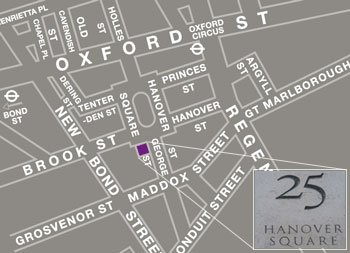 James took a job with an English dentist, a Dr. Seymour, in 1862, but soon after moved to Versailles where he worked for a French firm. In 1864 he set up his own practice, but this was apparently not successful because a year later he returned to London and joined the practice a Dr. Frederick A. Eskel, Surgeon-Dentist, as 25 Hanover Square. This is in Mayfair. No. 25 is a today a newly built office building in the clashing-styles school of architecture.
James took a job with an English dentist, a Dr. Seymour, in 1862, but soon after moved to Versailles where he worked for a French firm. In 1864 he set up his own practice, but this was apparently not successful because a year later he returned to London and joined the practice a Dr. Frederick A. Eskel, Surgeon-Dentist, as 25 Hanover Square. This is in Mayfair. No. 25 is a today a newly built office building in the clashing-styles school of architecture.
James Ernest Heesom, dentist, married Emma Sleigh on 19 December 1865 at St. Luke's church, Westminster. She was born on 30 August 1848 in Camerton, Somerset, the daughter of Aaron Sleigh, mercantile clerk, and Vashti Sage.
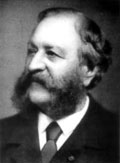 In 1865 Dr. Thomas W. Evans, left, Surgeon Dentist to Napoleon III, sent an emissary to James inviting him to join Evans' practice in Paris, which James did. Evans was an American from Phialdelphia. He had come to Paris in 1847 and, as luck would have it, Napoleon III had poor teeth. Evans quickly became the dentist of chose of the crowned heads of Europe. Dr. Evans wrote his memoirs in 1905, but he did not mention James Heesom. However, the "Memoirs of James Heesom" by D. Heesom and T. Heesom were used as footnotes in an article on Dr. Evans available online.
In 1865 Dr. Thomas W. Evans, left, Surgeon Dentist to Napoleon III, sent an emissary to James inviting him to join Evans' practice in Paris, which James did. Evans was an American from Phialdelphia. He had come to Paris in 1847 and, as luck would have it, Napoleon III had poor teeth. Evans quickly became the dentist of chose of the crowned heads of Europe. Dr. Evans wrote his memoirs in 1905, but he did not mention James Heesom. However, the "Memoirs of James Heesom" by D. Heesom and T. Heesom were used as footnotes in an article on Dr. Evans available online.
James rarely saw the Empereor, that treat being saved for Dr. Evans, but he did accompany Evans on his tour of the courts of Europe in 1867, visiting Berlin, Vienna and St. Petersburg
When Dr. Evans' practice was acrimoniously split between himself and his somewhat grandiose nephew, John Henry Evans, in 1869, James Heesom went with John Henry.
In 1870 France and Prussia went to war. Major hostilities ended at the beginning of September when the Empereor and a French army of 104,000 men were forced to surrender to the Prussians at Sedan. Napoleon III's Second Empire was overthrown by a coup in Paris two days later. In the meantime Dr. Evans took the Empress to England.
When peace negotiations between the Prussians and the new Republican government broke down, Paris was laid siege, beginning on 19 September. Just before the gates of the city of Paris were closed before the siege, James fled the capital, returning to England.
The Siege of Paris lasted until 28 January 1871. During that time new French armies, raised in the provinces, repeatedly attempted to relieve the city, but were defeated. Finally, the city starving, an armistice was signed, ending the war.
In the 1871 Census James, a 30 year old dentist, and his first wife, Emma, 22, were living at 28 Cirencester Place, Portland town, Marylebone, in the West End of London, today known as Great Titchfield Street, near Regent's Park. Today these are nice digs, but mid-century they were described as an area of "dirty shops and dingy private dwellings." Other staying at the same address included a Courier and a House Painter. James' sister, Eliza Craighill, perfumer, was visiting from Paris. Eliza had remained in Paris during the Siege and, according to the family history, had nearly starved. Emma died just months after the census, on 7 June 1871, of 'phthsis' at her mother's house in Somerset.
In 1871 James Heesom returned to Paris to work in the practice of John Henry Evans. He then married Louisa Emma Edwards sometime in 1872 at the Chapel of St. Michael, the British Embassy, Paris. Unfortunately, the marriage records for that year have been destroyed. She was the daugther of Thomas Edwards of Tenby, South Wales. Louisa was born in 1853, in London.
The following probably refers to the Legion of Honor awarded to Dr. Evans. ". . . du 22 septembre 1876. il7 Voir les memoires inedites de James Heesom, donnees en 1985 - l'University of Pennsylvania par Windley [sic] S. Heesom." - from "Les Americains et la Legion d'Honneur: 1853-1947" by Veronique Wiesinger and Alan Albright.
James, below, returned to England in 1881 and set up practice in Redhill, 2 miles east of Reigate town centre and 20 miles south of London.
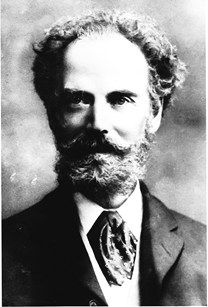 In the 1881 census of Alpine Villa, Buxted parish, Sussex as Louisa Heesom, Head, married, aged 28, born in London. Living with her were her children, Edwin, 7, and Frank, 1, both born in France, and Jessie, 6m, a girl born in Buxted. Where was James? Also living with Louisa were her mother [read mother-in-law], Maria Kennington, 69, of Hull, her sister [in-law], Emma Biggs, 49, of Hull, and her brother-in-law, Thomas Biggs, 49, of Leicester, an unemployed engraver.
In the 1881 census of Alpine Villa, Buxted parish, Sussex as Louisa Heesom, Head, married, aged 28, born in London. Living with her were her children, Edwin, 7, and Frank, 1, both born in France, and Jessie, 6m, a girl born in Buxted. Where was James? Also living with Louisa were her mother [read mother-in-law], Maria Kennington, 69, of Hull, her sister [in-law], Emma Biggs, 49, of Hull, and her brother-in-law, Thomas Biggs, 49, of Leicester, an unemployed engraver.
In 1882 James gave up practice due to illness. However, James Ernest Heesom, of Welton house, London road, Redhill, Surrey, who had registered as a dentist on 29 November 1878, and qualified to practice before 22 July 1878, was listed in the "Dentist Register" of Great Britain of 1889.
In the 1891 census of Reigate Foreign, Redhill St. Matthew, Surrey, England, as James E. Heesom, 51, a retired dentist, of Welton. Living with him were his wife, Louisa E., 38, of London, and children, Frank H., 11, of Paris, Jessie Beatrice, 10, of Buxted, Surrey, and Lena Maria, 2, of Redhill, Surrey.
In the 1901 census of Reigate, Betchworth, Surrey as James Heesom, a 62 year old dentist. Living with him was his wife, Louisa.
"The Dental Annual & Directory" of 1904 lists "Heesom, James Ernet, Welton House, London Road." He was also in the directories of 1905 and 1906, all three times just below his son, Edwin Heesom.
In the 1911 census of Brighton, Sussex as James Ernest Heesom, a 71 year old dentist, of Hull. He and his wife, Louisa Emma Heesom, 58, were visiting the seaside resort, staying in the apartment house run by Emily Rosetta Fluss.
There is a "Heesom, James Sr. Lectr" in the 1916 edition of the "Commonwealth Universities Yearbook."
James E. Heesom died on 8 February 1927 in Reigate, Surrey, at the age of 87. His will was probated on 6 July 1927 in Surrey.
"Heesom James Ernest of Welton House 89 London-road Redhill Surrey died 8 February 1927 Probate London 6 July to Louisa Emma Heesom widow Edwin Ernest Darley Heesom J.P. gentleman and Frank Hurlstone Heesom dental surgeon. Effect L4081 6s 4d."The "Memoirs of James Heesom (1839-1925)" were published by Dudley Heesom and Thomas Heesom in the British Dental Journal on 7 September 1985. There is also a Thomas Michael Anthony Heesom article in the British Dental Journal which starts, "His great-grandfather, James Heesom, was for some years in practice with Thomas Evans in Paris in the late 1860s treating royalty and heads of state."
The following was included with papers donated by Dr. T.M.A. Heesom, below. There is some confusion about James' first name. The following calls him William, but most of the references I find refer to him as James. Note the use of his elder brother's name, Edwin, for James' first son.
"Typescript copy of memoirs of William [James?] Heesom (b.1839), retired dentist of Redhill, dictated by him to his son, Edwin Heesom, on 1 Dec 1918. Includes details of the Heesom family; childhood in Welton, near Hull, and later Hull; appointment as dentist in Paris for a year, Mar 1860, and then Versailles for two years; return to Paris to set up his own practice; move to London in 1865 to take up position with Dr Eskel of Hanover Square; return to Paris to work for Dr Thomas Evans, Surgeon Dentist to Napoleon III; treatment of other members of European aristocratic and royal families; tour to see patients, mostly royalty, including Czar Alexander II in St Petersburg, early 1868; joining practice of Dr Evans's nephew, Dr John Evans, 1869; departure from Paris at beginning of Sep 1870 to escape Paris Commune of 1870-1871; stay in London until end of war before return to Paris in [Jul] 1871; move to Redhill in [1881] where he practiced for one year before retiring due to ill health." - from a summary of the typescript copy
I suspect that the following Heesom family arms were obtained by James:
"Heesom (H. Coll.). Argent, on a chevron sable, a cock, between two fleurs-de-lys or, a chief gules, thereon a rose of the field barbed and seeded proper. Mantling sable and argent. Crest--On a wreath of the colours, a dexter cubit arm erect proper, encircled with an annulet gules and holding in the hand three ears of wheat also proper. Motto--"Honos quam honores."
Son of Rev. John Heesom, of Welton, Yorkshire., b. 1809; d. 1841; m. 1830, Maria, d. of Thomas Beecroft, of Beecroft House, Kingston-upon-Hull:--
James Ernest Heesom, Gentleman, b. 1839; m. 1872, Louisa Emma, d. of Thomas Edwards, of Tenby, South Wales; and has issue--Edwin Ernest Darley Heesom, Gentleman, b. 1873; Frank Hurlestone Heesom, Gentleman, b. 1879; Jessie Beatrice Emma. Res.--Welton House, Redhill, Surrey." - from "Armorial Families: A Directory of Gentlemen of Coat-Armour" by Arthur Charles Fox-Davies
See James Ernest Heesom (1839-1927): A Yorkshire Dentist in Paris for a pdf copy of Nicolette Heesom Reichhold's biography of her ancestor.
James' children were,
(25) Edwin Ernest Darley Heesom (1873)
(25) Frank Hurlstone Heesom (1879)
(25) Jessie Beatrice Emma Heesom (1880)
(25) Lena Maria Heesom (1888), died in 1893
Edwin Ernest Darnley Heesom was born on 19 July 1873 on 12 Rue de Milan, in Paris, France, the son of James Heesom, dentist, and Louisa Emma Edwards. His birth was registered at the British Consulate. He may have been named in honor of his uncle, (24) Edwin Heesom (1837). Edwin Ernest Darnley Heesom was later baptized on 2 August 1874 at Paddington St. Peter, Middlesex, England, the son of James Ernest and Louis Emma Heesom.
"Edwin lived in Paris until he was 8 years old. When he was a little boy he had shoulder length golden curls and blue eyes and appeared in several paintings of Paris street scenes by a French Impressionist painter called Jean Beraud." - from Nicolette Heesom. I don't see a golden haired boy in any of his paintings, but Beraud painted an awful lot of those scenes.
In the 1881 census of Alpine Villa, Buxted parish, Sussex as Edwin Heesom, a 7 year old scholar, living with his mother, Louisa. Buxted is 20 miles southeast of Reigate.
In the 1891 census of 1 Frederick Place, Weymouth, Dorset as Edwin Heesom, an 18 year old dental student, apparently under the tutelage of Burt Walker, Dentist. This looks something like an apprenticeship, since Edwin was the only non-family member who was a pupil. Frederick Place is a Georgian terrace, laid out on what used to be the gardens of Gloucester Lodge, owned by Prince William Henry, Duke of Gloucester. 1 Frederick Place is today the location of a pub. I suspect in the day it was a dental office down below, and a family residence above.
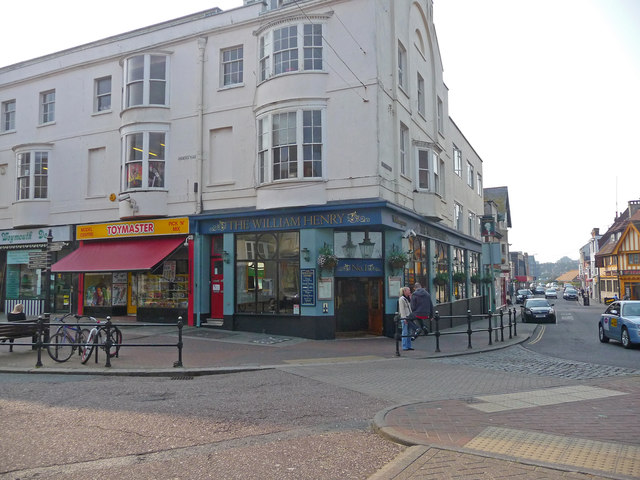
Edwin got his dental education at Guy's Hospital, pictured below. Most of his descendents did the same.
"Dental Appointments
Curator in the Dental Laboratory.--Mr. E. E. D. Heesom."
"First Year's Prizes, 1894.-- . . .
Edwin Ernest Darley Heesom, Redhill, Certificate"
"Dressers in the Gas Room.--Messrs. A. De Mierre, E. E. D. Heesom . . ."
"Calendar of Coming Events . . .
Nov. 18.--Dental Society, 4.30. Paper on the Cleft Palate by Mr. E.E. Heesom"
- from "Guy's Hospital Gazette" of 1895
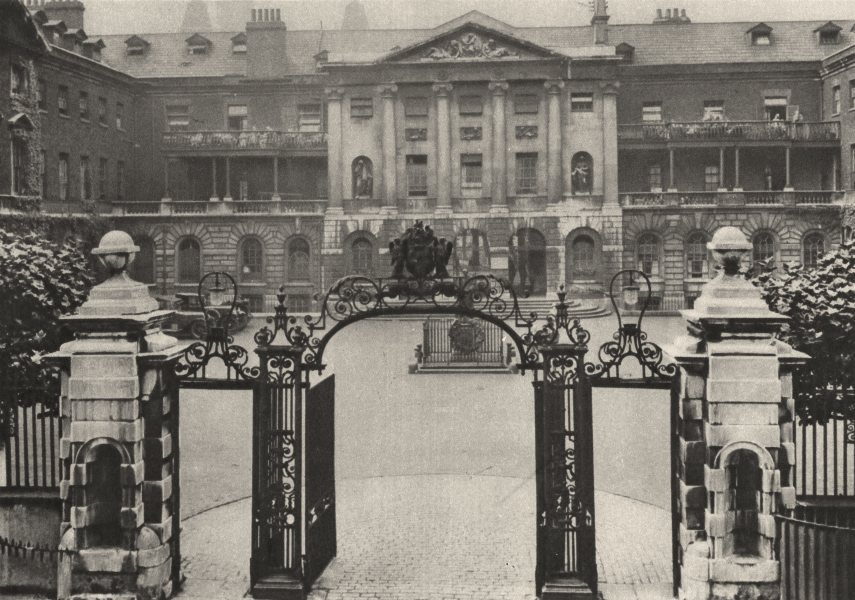
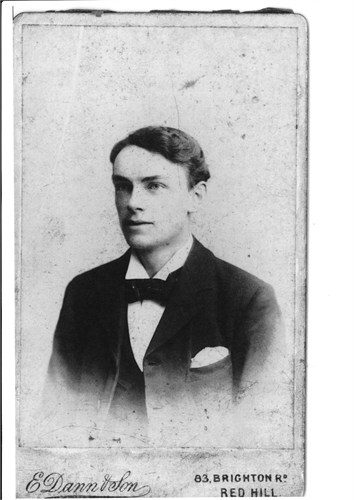 Edwin married Maude Agnes Miller at the Congregational Church in Redhill, Surrey on 7 July 1898. She was born in 1873 and died in 1956.
Edwin married Maude Agnes Miller at the Congregational Church in Redhill, Surrey on 7 July 1898. She was born in 1873 and died in 1956.
"Heeson-Miller.--On July 7th, at Redhill Congregational Church, Edwin Ernest Darley Heeson [sic], L.D.S. Eng., elder son of James Ernest Heeson, of Redhill, to Maude Agnes, eldest daughter of William Miller, of Maybury Lodge, Reigate." - from "The Lancet" of 1898
In the 1901 census of . . .
"The Dental Annual & Directory" of 1905 lists "Heesom, Edwin Ernest Darley, -L.D.S. Eng., Lowcroft, Station Road." He is just above his father, James Ernest Heesom. Edwin was also in the directory of 1906. Apparently Ernest was a successful dentist because in 1903 he was shown as a Justice of the Peace, a duty and honor given to successful men of the middle class in England.
In the 1911 census of . . . Ernest is in the City Directories of this period, living in Surrey and, later, in Somerset.
In 1927 Edwin was a Justice of the Peace.
"The Dentists Register" of 1945 lists,
"Heesom, Alan Hedley Beecroft . . . Lowcroft, Station road, Redhill . . . 1931, June 29 . . . LDS RCS Eng., 1926; MRCS Emng., 1927; LRCP Lond., 1927
Heesom, Edwin Ernest Darley . . . Lowcroft, Station road, Redhill . . . 1896, Dec. 31 . . . LDS RCS Eng., 1896
Heesom, Frank Edwin Bristow . . . 70, Greyhound lane, Streatham Common, London, s.w. 16 . . . 1941, Feb 24 . . . LDS RCS Eng., 1941
Heesom, Frank Hurlstone . . . 70, Greyhound lane, Streatham Common, London, s.w. 16 . . . 1922, July 26 . . . Dentists Act, 1921
On 2 May 1951 Edwin Heesom, aged 77 and of no occupation, and his wife, Maude, 77, arrived in London from Cape Town, South Africa on the LLANDOVERY CASTLE. I suspect they were visiting Denys. Their home in England was at Greystones, Stockland, Honiton, Devon.
Maude A. Heesom, born in about 1874, died in the 1st quarter 1956, in Honiton, Devon, at the age of 82. Edwin E. D. Heesom, born in about 1874, died in the 1st quarter 1960, in Honiton, Devon, England, at the age of 86.
"Heesom Edwin Ernest Darley of Greystone Stockland near Honiton Devon died 18 January 1960 Probate London 17 June to Gerald Chamberlain Mole solicitor Dudley Stone Heesom schoolmaster and Thomas Michael Anthony Heesom dental surgeon. Effects L19712 0s. 6d." - from the National Probate Calendar
Edwin's children were,
(26) Kenneth Ernest Heesom (1899)
(26) Alan Hedley Beecroft Heesom (1900)
(26) Dudley Stone Heesom (1903)
(26) Brian Gilford Heesom (1905)
(26) Lois Margaret Heesom (1907)
(26) Hubert Denys Alastair Heesom (1911)
Historical Timeline: Reign of Kings, The House of Saxe-Coburg-Gotha
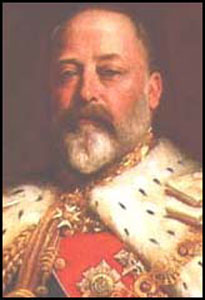 1901-1910 Edward VII
1901-1910 Edward VII
Edward's father, Prince Albert, was from the small German state of Saxe-Coburg, giving the family this un-English surname. Edward came to the throne late in life, frustrated in being kept from any important role in government during the Queen's reign. She, cruelly, blamed Edward for his father's death and never truly forgave him. One of the most significant developments during his reign was a change of affection from the German states, recently transformed into an Empire by Prussia, to France. A full-blown alliance would not occur until 1914. The House of Windsor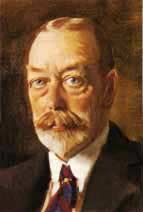 1910-1936 George V
1910-1936 George V
George V changed the name of the family during World War I in response to anti-German sentiment. The 'Great War' was the defining event of his generation and its cost in men and material beggared the empire, which never fully recovered its position. As a result, the 20th century became an American one. More significantly, the errors on the battlefield and those of state made the common man of England question anew the role of the aristocracy, whose rule he had until then accepted as in his best interests. |
Kenneth Ernest Heesom was born in the 2nd Quarter 1899 in Reigate, Surrey.
"Heesom, K.E. 2nd Lieut., R.E. [Royal Engineers] (W.) 1916" was of Pembroke College, Cambridge - from "The War List of the University of Cambridge, 1914-1918"I believe 1916 refers to the year he graduated from Cambridge. He then went into an officer training course, taking a commission in the Royal Engineers in 1918.
"Corps of Royal Engineers
. . .
The undermentioned Cadets to be temp. 2nd Lts. 23rd Feb. 1918:--
. . .
Kenneth Ernest Heesom" - from "The London Gazette" of 9 March 1918
| The Royal Engineers
The original engineers were sappers, the men who tunneled and undercut the walls of fortifications. The Engineers of World War I provided a wide variety of combat support services, including building bridges and communications systems. They also established the first army flying unit, which later became the RAF. The Corps of Engineers became Royal in 1787. Below a team of Royal Engineers establish communications on the front during World War I. 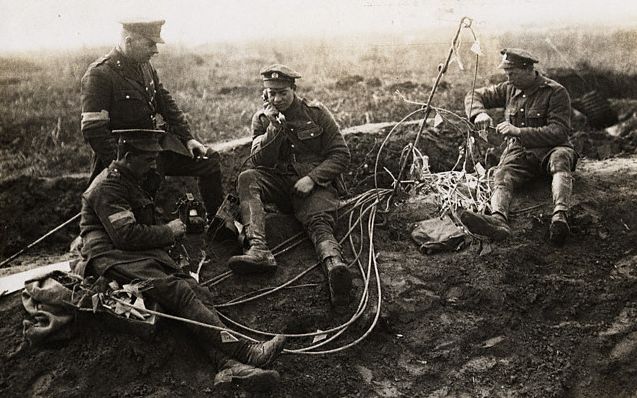 |
Sadly I recently saw three of K.E. Heesom's medals for sale on the internet; a British War Medal, Victory Medal, and 1937 Coronation Medal. But hey, the website quotes this webpage to describe Kenneth's life and service.
"Kenneth Ernest Heesom . . . was M.A. of Cambridge University, from which he graduated before the Great War. In the period 1917 to 1919 he served in the Royal Engineers. After the War Mr. Heesom went to the Royal School of Mines, which he left in 1926." - from "The Mining Magazine" of 1940The Royal School of Mines, founded in 1851, is part of the Imperial College, located in London.
Contrarily, I have,"Heesom Kenneth Ernest PEM BA23 MA26" - from Cambridge University List of Members"Kenneth Ernest Heesom, 25, a student of Lowcroft, Redhill, departed from London on 25 Jul7 1924 for Gibraltar onboard the NALDERA. - from UK Outward Passenger Lists 1890-1960
"Mr. KE Heesom, Stud, Inst. MM, has left England for South Tunisia." - from the Bulletin of the Institute of Mining and Metallurgy (Great Britain) of 1926Kenneth "left" the School of Mines, that is he didn't graduate, as the second reference makes clear, referring to him as a student.
"His first engagement was with the Dovey Valley Silica Syndicate, in Tunis . . ." - from "The Mining Magazine" of 1940Dovey [Dyfi] valley is a coal mining region in Wales. The mining syndicate was apparently founded by men with roots in that area. The company dates to 1918. Kenneth was member of the Institute of Physics and Physical Science, circa 1928.
". . . and later he was with the Nile Congo Divide Syndicate, in the Sudan." - from "The Mining Magazine" of 1940The company, headquartered at Loka, in the Congo, held mining rights in eastern Congo, northern Uganda and southern Sudan. From the next reference, Kenneth also had time while in the desert to learn to fly.
"Eqypt . . . Khartum--Heesom, K. E." - from "List of Members" by the Royal Aeronautical Society of 1928In such a remote region, and with so few roads, an airplane, and the ability to fly it, would be a great asset.
"Heesom, Kenneth Ernest (Khartoum, Sudan)." - from the Bulletin of the Institution of Mining and Metallugry of 1929.
"In 1929 Mr. Heesom joined the Government Service in the Mines Inspectorate, Nigeria" - from "The Mining Magazine" of 1940
Kenneth Ernest Heesom, a 30 year old mining engineer, the son of Edwin Ernest Darly Heesom, dental surgeon, married Ruth Mary Marston, 33, the daughter of Edward Howis Marston, civil engineer, on 5 October 1929 in the Holy Trinity church, Redhill, Reigate, Surrey. They were married in the presence of Ed. H. Marston, Edwin Ernest and Maude Agnes Heesom, Kenneth's parents, and Louisa Emma Heesom, his grand-mother. Ruth Mary Marston was born in Redhill, Surrey in 1896. They had no children that I am aware of.
"Mr. KE Heesom, Assoc. Inst. MM, has left England on his return to Northern Nigeria." - from the Bulletin of the Institution of Mining and Metallugry of 1932.I have references to Kenneth in Sierra Leone, Sudan, and Nigeria in the 1930's. He appears to have been in the Colonial Service as an Inspector of Mines.
Ernest Kenneth Heesom, 36, arrived in London from La Plata, Argentina on 12 March 1936 onboard the HIGHLAND BRIGADE.
Kenneth Heesom, aged 40, arrived in Liverpool, England from Calabar, Nigeria on 1 December 1939 onboard the ADDA, below. ADDA was part of the Elder, Dempster & Co. line of ships.
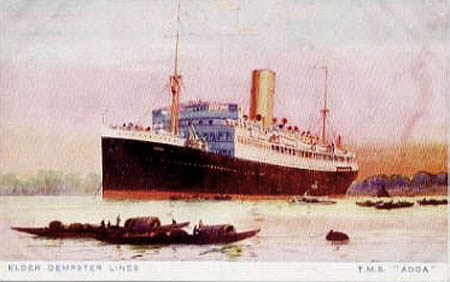
I suspect that Kenneth returned home due to an illness. He died just two months later on 11 February 1940 at Redhill.
"Kenneth Ernest Heesom, who died at Redhill on February 11, aged 40 . . . and at the time of his death was Inspector of Mines, Sierra Leone." - from "The Mining Magazine" of 1940His will was probated in December 1940.
"Heesom Kenneth Ernest of Thornilee 92 Ladbroke-road Redhill Surrey died 11 February 1940 Probate Llandudno 21 December to Ruth Mary Heesom widow. Effects L70 18s. 8d." - from the National Probate CalendarDid he go home to die, or die on a visit? Ruth died in 1983. (26) Alan Hedley Beecroft Heesom (1900)
Alan Hedley B. Heesom was born on 29 September 1900 at Redhill [Reigate], Surrey, England. His son, Thomas, was referred to as a fourth generation dentist. Note also the use of the Beecroft name, the surname of his great-grandmother. I wonder if Hedley was his mother's surname?
He was educated at Marlborough and at Guy's Hospital, qualifying L.D.S. in 1926.
"HEESOM, Alan Hedley Beecroft, Lowcroft, Redhill, Surrey (Tel. Redhill 130)--M.R.C.S. Eng., L.R.C.P. Lond. 1927; L.D.S. R.C.S. Eng. 1926; (Guys'); Dent. Surg. E. Surrey Hosp. & Redhill Co. Hosp.; Mem. B.M.A. & B.D.A.; late Dent. Ho. Sur. Guy's Hosp." - from Medical Directory of 1914"Alan Hedley Beecroft Heesom" - from "List of the Fellows and Members of the Royal College of Physicians" 1928
A.H.B. Heesom was a member of the East Surrey Amateur Operatic and Dramatic Society, where he performed, in 1921, as a member of the jury in Gilbert & Sullivan's "Trial by Jury."
Alan married Gwendoline M. Hewitt in April 1933 in Totnes, Devon.
"The Dentists Register" of 1945 lists,
"Heesom, Alan Hedley Beecroft . . . Lowcroft, Station road, Redhill . . . 1931, June 29 . . . LDS RCS Eng., 1926; MRCS Emng., 1927; LRCP Lond., 1927
Heesom, Edwin Ernest Darley . . . Lowcroft, Station road, Redhill . . . 1896, Dec. 31 . . . LDS RCS Eng., 1896
Heesom, Frank Edwin Bristow . . . 70, Greyhound lane, Streatham Common, London, s.w. 16 . . . 1941, Feb 24 . . . LDS RCS Eng., 1941
Heesom, Frank Hurlstone . . . 70, Greyhound lane, Streatham Common, London, s.w. 16 . . . 1922, July 26 . . . Dentists Act, 1921
Alan H. B. Heesom, born in about 1901, died in 2nd Quarter 1955, in Surrey, at the age of 55, while his son, Thomas, was still at Marlborough.
"Heesom.-On April 19, 1955, at his home, Berkswell House, High Trees, Reigate, Surrey, Alan Hedley Beecroft Heesom, M.R.C.S., L.R.C.P., L.D.S." - from Medical News in the British Medical Journal of 14 May 1955Also,
"Mr. A.H.B. Heesom, dental surgeon to the East Surrey and Redhill County Hospitals, died at his home at Reigate on April 19 at the age of 54. Alan Hedley Beecroft Heesom was born at Redhill on September 29, 1900, and was educated at Marlborough and at Guy's Hospital, qualifying L.D.S. in 1926 and taking the Conjoint diploma of M.R.C.S., L.R.C.P. the following year. After holding the appointment of dental house-surgeon at Guy's Hospital he joined his father, Mr. E.E.D. Heesom, in 1929, succeeding to the practice two years later, when his father retired. He was honorary dental surgeon to the East Surrey Hospital from 1934 until the inception of the National Health Service in 1948, when he was appointed senior hospital dental officer to the Redhill Group of Hospitals. He was extremely popular with all his patients and his professional colleagues, both medical and dental, as was shown by the very large attendance at his funeral service, the congregation being representative of all walks of life in the borough. He is survived by his widow and a son and a daughter." - from the British Medical Journal of 28 May 1955And,
"Heesom Alan Hedley Beecroft of Berkswell House High Trees-road Reigate Surrey died 19 April 1955 Probate London 11 July to Gerald Chemberlain Mole solicitor and Gwendoline Mary Heesom widow. Effects L22212 14s 4d." - from the National Probate CalendarHis children were,
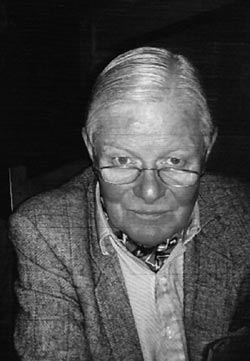 He was born on 26 February 1937 in Redhill, Surrey.
He was born on 26 February 1937 in Redhill, Surrey.
"HEESOM Tom Michael Anthony, b 26 Feb 1937. Redhill. England Dental Surgeon m, Willo Elizebeth Heesom. 23 Mar 1966. Education: Marlborough Col." - from "Men of Achievement" Volume 15, 1992The son of Alan, he attended Marlborough College in Wiltshire from 1950 to 1955. This is a boarding school for pupils between the ages of 13 and 18 - a High School in American parlance. He graduated from Guy's Hospital in 1960 and set up his own practice in Reigate. Of Norwood Hill, near Horley.
"Dr Tom Heesom represents the fourth generation of dentists within his family: his great grandfather, William [James?] Heesom, treated some of the crowned heads of Europe in Paris and St Petersburg. Dr Heesom set up practice at Berkswell House, High Trees, Reigate, in 1962. He later moved to the Wall House, where he was joined in 1974 by Stuart Averill and Chris Calder. In 1977, Jill Nightingale joined the practice, which included an annexe, Cranford, forming one of the first children's and preventive care units in the country. The expanded practice moved to purpose built premises at Ringley Park, 59 Reigate Road, in 1992, and Dr Heesom retired in 1995."Also,
"HEESOM Tom Michael Anthony, b. 26 Feb 1937, Redhill, England. Dental Surgeon, m. Willo Elizebeth Heesom, 23 Mar 1966 Education: Marlborough Col. 1950-55; Guys Hosp, London, 1955-60, BDA London, 1960; LDS, 1961, MRCS, 1979. . . ." - from "Men of Achievement 1993-1994" by Ernest Kay
Tom Heesom died suddenly on 19 August 2007, aged 70. A friend wrote of him,
"Tom was the only person I have ever known who was incapable of a malicious thought about another human being: equally no-one ever had cause to have a malicious thought about him. He was a very highly-regarded and skilful dentist, orthodontist and a leader in that field.Tom Heesom owned a 12hp 1904/5 Sunbeam. I also found him driving a 1963 Lancia Flaminia 3C 2.8 convertible in 2007. Dentistry must be good business. The second driver was a Willo Heesom, his wife. She is apparently a ceramics artist.
At school he was an enthusiastic College beagler, but in recent years his greatest joy was to be driving his 1904 Sunbeam in the Brighton Run, in agreeable company and with a well-provided picnic hamper strapped to the running board for consumption on arrival (which he always achieved). He drove with panache, great skill and huge enjoyment regardless of the weather in that car, which had neither windscreen nor hood.
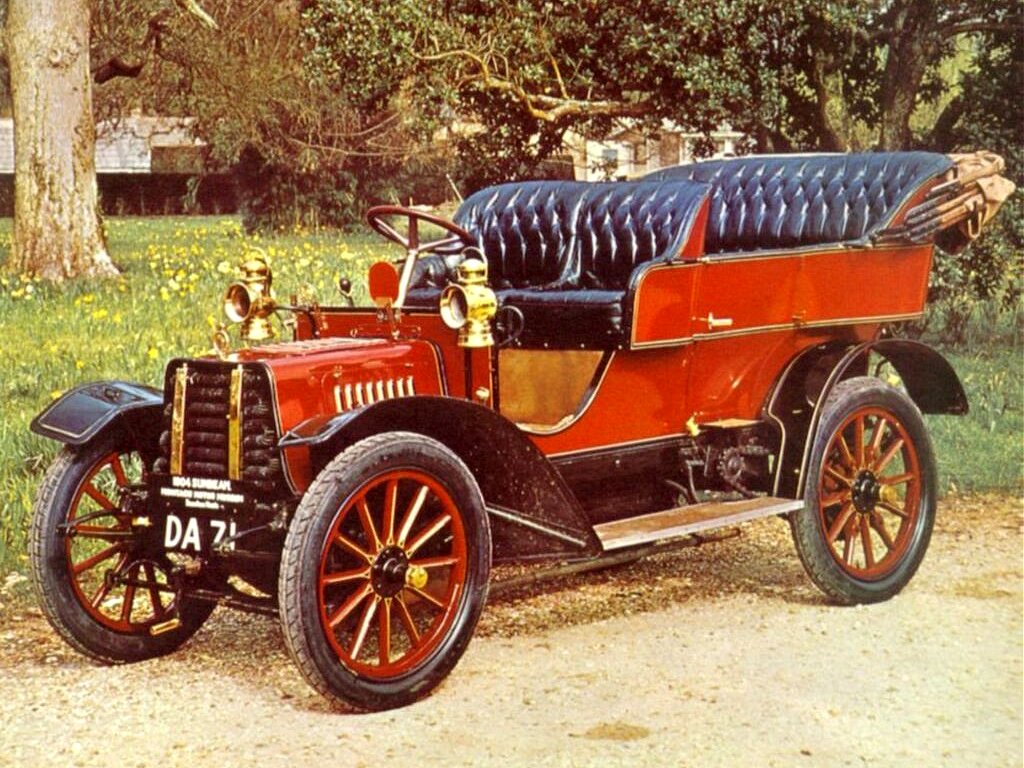
1904 Sunbeam
He was a lovely man; 450 of his friends attended his memorial concert in March 2008."
His obituary from the British Dental Journal,
"Tom Heesom, who died suddenly on 19 August 2007, aged 70, came from a long line of distinguished dental surgeons. His great-grandfather, James Heesom, was for some years in practice with Thomas Evans in Paris in the late 1860s treating royalty and heads of state.An obituary in the Telegraph:
His father Alan, who practised in Reigate, died in 1955 while Tom was still at Marlborough, so it was logical for him to set up his own practice in Reigate after graduating from Guy's in 1960. He continued to practise there until his retirement in 1995. Early in his career he developed an abiding interest in preventive dentistry, and pioneered the Children's Preventive Unit.
In 1977 Tom was one of the first dentists from the UK to visit the Pankey Institute in Miami. He was very enthusiastic to bring their high standards to the UK and as a result was a founder member of the Pankey Association UK.
Subsequently a meeting with Skip Truitt led him to explore the world of gnathology, craniofacial orthopaedics, and functional orthodontics. It was his inspiration to form the Functional Orthodontic Support Group and he devoted much time and effort to promoting greater understanding and co-operation between those who held differing opinions regarding methods of treatment.
Tom spent his life in the pursuit of excellence. A firm belief that the dental profession should aim to provide treatment of the highest standard underpinned his philosophy and practice, and his enthusiasm and dedication inspired colleagues and patients alike. He loved the countryside and enjoyed travel and walking. He was a keen gardener, a music lover and had a passion for old cars - on which he was highly knowledgeable and a skilful driver. He participated over the years in many events in his veteran, vintage and classic cars.
Tom spent his life in the pursuit of excellence...
Tom and Willo, his wife of 40 years, had an enormous circle of friends and were wonderful hosts. Privileged indeed were those able to enjoy generous hospitality in their fascinating home, or accompany him on a motoring adventure.
A fine dentist and a true gentleman, Tom will be greatly missed by all who knew him, in particular Willo, who encouraged and supported him in all his endeavours."
"Thomas Michael Anthony, retired Dental Surgeon, Reigate, Surrey, passed away suddenly but peacefully at home, August 19th 2007, aged 70. Loved and respected by all who knew him. At his request a Private Cremation has been arranged. He leaves behind his beloved wife and soulmate, Willo and his sister, Stephanie Jacobs and her family. He will be sorely missed by Willo's Canadian family and friends, his nieces, nephew, godchildren, great niece and nephews, and his many wonderful friends from all stages of his life. Donations may be made to the British Heart Foundation in Tom's name c/o Stoneman Funeral Service, Doran Court, Reigate Road, Redhill, RH1 6AZ. Tel. 01737 763456."I see no indication of children. (27) Stephanie L. Heesom (1942)
Stephanie L. Heesom was born in the 3rd quarter 1942, in Surrey, the daughter of Alan H. B. Heesom and Gwendoline Hewitt. The sister of Thomas Michael Anthony Heesom, above, per his obituary. She married Stanley Jacobs in 1967 in Hampstead, Greater London.
"Stephanie Heesom was born in 1942 in Reigate, Surrey, England. She is an actress, known for Doctor Who (1963), Adam Adamant Lives! (1966) and The Further Adventures of Lucky Jim (1967)." - from IMDb.com(26) Dudley Stone Heesom (1903)
Dudley Stone, the son of Edwin Ernest Darley Heesom and Maude Agnes Miller, was born on 11 May 1903.
"Heesom, Dudley Stone. s. of Edwin Ernest Heesom, JP b. 11 May, 1903 . . ."He attended what would pass for high school in America in Canterbury, Kent, probably boarding there (ala "Tom Brown's School Days").
". . . Junior Scholarship, November, 1917 ; Senior, June, 1919." - from the Register of Canterbury, King's SchoolKing's school claims to be the oldest continuously operating school in the world, having been founded in 597 AD. In 1920 it was a boy's secondary school, ages 13-18.
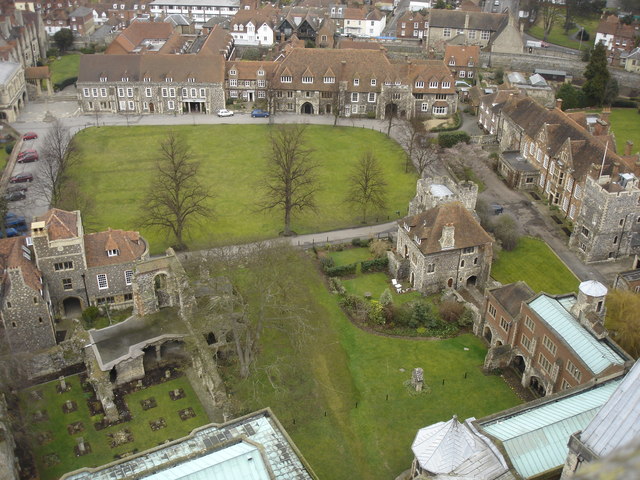
Dudley attended Cambridge, majoring in History.
1924. "Dudley Stone Heesom, St John's (Princeton)" - from "The Cambridge University Calendar"However, maybe he didn't matriculate until after he returned from America.
"Heesom Dudley Stone JN BA26 MA35" - from Cambridge University List of Members"In 1924 a D.S. Heesom, of St. John's College, Cambridge got a scholarship to Princeton University. Dudley Heesom, 21, of St. John's College, Cambridge departed Liverpool on 4 September 1924 onboard the CARMANIA, pictured below, bound for Quebec, Canada. Dudley crossed from Canada into the U.S. at St. Albans, Vermont on 10 September 1924 on his way to Princeton.
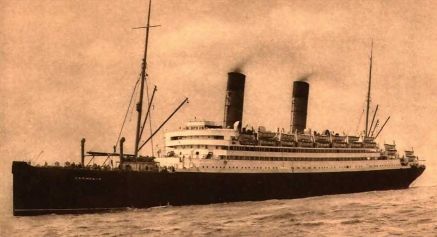
"Mr. Salmon, the Oxford Scholar last year, is succeeded by Mr. James A. Mackintosh of Balliol College, and Mr. Nettleton, last year's Cambridge Scholar, is succeeded by Mr. Dudley S. Heesom of St. John's College . . . Mr. Heesom was prepared at King's School, Canterbury, winning an Exhibition at St. John's College and also being granted one by his School. At the University he received last June a First Class in the History Tripos, rowed in his college boat, and was President of the College Theological Society. Like Mr. Mackintosh he was one of the most prominent men in his College." - from "The President's Report" of Princeton University, 1924. Tripos is an examination system, supposedly named for the three-legged stool students would sit on while being examined.
"Justin Smith, Jack Winton, and Dudley Heesom came over from Cambridge to attend the Princeton dinner held to celebrate the football season, among other things . . . Dudley is busy maintaining the intellectual supremacy of Princeston, but not so busy that he did not have time to prepare a corking good speech for us at the dinner." - from the Princeton Alumni Weekly of 1925.
Dudley returned to England in 1925, arriving in Glasgow, Scotland from New York City on 30 August 1925 onboard the ship CALIFORNIA of the Anchor Line. He graduated from Pembroke in 1925 - from the Alumini Directory of Pembroke State University. So, he attended St. John's college, Cambridge, but graduated from Pembroke college, Cambridge. How does that work?
Dudley S. Heesom married his cousin, Beatrice Jessie Marie Heesom, the daughter of Frank Hurlstone Heesom, below, in the 3rd Quarter 1933 in London. She was born on 26 December 1908.
He got his MA from Oxford in 1935.
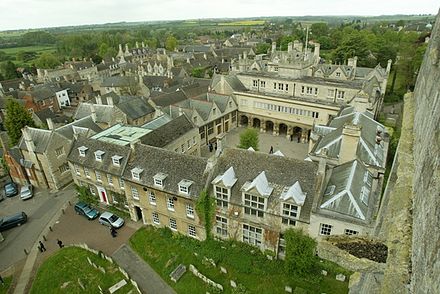 Assistant Master at Oundle school, see right, in 1947. Dudley Heesom, Bramston House, Oundle, Peterborogh was Senior History Master of the Oundle School in 1952 and 1953 - from the "British Journal of Educational Studies."
Assistant Master at Oundle school, see right, in 1947. Dudley Heesom, Bramston House, Oundle, Peterborogh was Senior History Master of the Oundle School in 1952 and 1953 - from the "British Journal of Educational Studies."
Dudley Heesom was interviewed for the book, "The Berlin Airlift" by Ann and John Tusa, published in 1998. However, he was referred to as "the late Dudley Heesom" in a book published in 1990.
Dudley died in February 1986 in Peterborough, Cambridgeshire, England. His obituary,
"Dudley Stone Heesom '25Dudley Heesom, born in Red Hill, Surrey, England, May 14 [sic], 1903, joined us in senior year as a Davidson Scholar from St. John's College, Cambridge. There he had earned First Class in Part 1 of the Historical Tripos, and had rowed in the Lady Margaret First Lent Boat in 1924.
He had a distinguished career as a schoolmaster, becoming headmaster of Oundle School.
He died at his house in East Jericho, Peterborough, Feb. 5, 1986. He is survived by his widow, Beatrice Jessie Marie Heesom, and their children, Pepita, Nicolette, James and Crispin, to whom the Class extends sympathy." - from the "Princeton Alumni Weekly"
Beatrice died in January 1990, at the age of 81, in Peterborough, England.
On 28 February 2012 Dudley was honored by his old school.
"On Saturday 25 February, the Headmaster welcomed Old Oundelians and the Heesom family to a luncheon at Cobthorne to celebrate the naming of a room in the newly refurbished Cripps Library in honour of former history master and Bramston Housemaster Dudley Heesom.
Dudley's four children were able to attend; Pepita and Nicolette, who both live in Oundle, Crispin (N 68) and James (N 61). His nephew Nicholas (B 63), who is a major donor to the Library, attended the opening with Robert Cripps in October. Among the OO donors were Hugh Allen (B 52), Roger Bradley (B 54), Henry Garrood (B 49), Tim Lacy-Hulbert (B 58), Tim Piper (B 57) and Ben Rawlings (B 58).
When the idea of naming rooms in the Cripps Library was first suggested, there was no doubt that Dudley Heesom would be among those that Old Oundelians would want to honour. Over thirty OOs contributed to the £100,000 target to name the library classroom. The new Dudley Heesom Room, which is located on the history mezzanine, is partitioned by a glass wall, and is furnished with tables and seating that can be arranged flexibly for seminars or lectures, while computer projection facilities make it suitable for class teaching, as well as group work. Glass fronted cabinets display the library's old books, OO books and a growing collection of books on caricatures. Because it is self-contained and accessible via a separate entrance, the room can be used in the evenings for society meetings.
Following a distinguished career as a Scholar at St John's College Cambridge, and a Davidson Scholarship to Princeton University, Dudley Heesom came to Oundle as one of the most distinguished and exciting masters of history the school has known. He ran the History Department from 1934 to 1960, and additionally served as a tireless and inspirational Housemaster of Bramston from 1939 to 1956, during which arose a spirited Bramston loyalty among its "Buccaneers" and "Corsairs". He took the History VI from 1927, instilling a commitment to intense hard work that was rewarded by countless Oxbridge successes over the years. Generations of Oundelians were enthralled by his scholarly and infectious enthusiasm, and are still proud to claim, "I was in History VI."
A Woodley S. Heesom forwarded a copy of the Memoirs of James Heesom to the author of an article about Dr. Evans, the dentist of Napoleon III, in 1986.
"Steve,
Another of my father's letters is to his co-writer of the article in the British Dental Journal [about Dr. James Heesom], in which he mentions that he has just sent an excerpt of James's memoirs to the Levy Library, at the Univeristy of Pennsylvania. I think it is very likely that they mistook the signature of Dudley S. Heesom for Woodley, (as an old man his writing was not very legible)." - Nicolette Heesom
His children were,
(27) Pepita M. Heesom (1938)
(27) Nicolette Heesom (1940)
(27) James Latham Hurlstone Heesom (1948)
(27) Crispin David Edwin Heesom (c1950)
Pepita M. Heesom was born in the 2nd Quarter 1938 in Wandsworth, Greather London. Mother's maiden name was Heesom.
"Just spotted, on ancestry.co.uk, that Pepita M Heesom, Nicholette's sister, married an [Stephen P.] Aris in Oundle, in Sep 1961" - Colin Heesom"Pepita Aris (Heesom 1957) and Stephen Aris" - from The Girton College Newsletter. Hmm, I have a Pepita Aris who writes French and Spanish cook books . . .
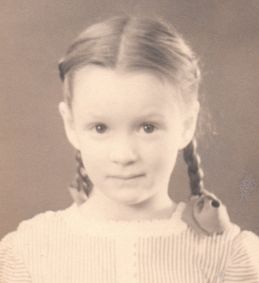 (27) Nicolette St. Osyth Heesom (1940)
(27) Nicolette St. Osyth Heesom (1940)Nicolette St. O Heesom was born in the 1st Quarter 1940 in Oundle, Northamptonshire. Her mother's maiden name was Heesom.
Nicolette, who corresponded with me, above, appears to be some kind of research biologist.
"Heesom, John Ernest, B.SC. . . 1960I don't know who John Ernest Heesom is. St. Osyth is a village in Essex, on the sea, and also a college.
Heesom, Nicolette St. Osyth, B.SC. . . 1961" - from Publications of the University of Bristol
Nicolette Heesom, a Research Assistant, resided in Boston, Massachusetts in 1964.
Nicolette has a couple of papers on the web about the production of granulomata by antigen-antibody complexes and factors influencing chronicity in inflammation of rat skin. It's all greek to me, but my wife, who is a consultant in the biotech field, would probably get it. She appears to have worked at the Department of Pathology, St Bartholomew's Hospital. Medical College, London.
She married a [Charles R?] Reichhold. Nicolette S. Reichhold lives in Peterborough, Cambridgeshire.
(27) James Latham Hurlstone Heesom (1948)The son of Dudley Stone Heesom and his cousin, Beatrice Jessie Marie Heesom, the daughter of Frank Hurlstone Heesom, below. An architect, of 1 St. Mary's Place, Stamford, Lincolnshire. He earned his BA from Cambridge in 1965 and MA in 1970.
"Heesom James Latham Hurlstone CC BA65 MA70" - from Cambridge University List of Members"I believe his wife is Helene Elizabeth Heesom, known as "Liz." Other members of his family include,
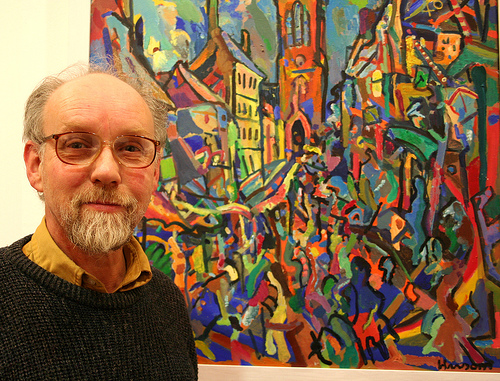 Crispin D. E. Heesom was born in the 2nd quarter of 1950 in Oundle, Northamptonshire. This is Nicolette's brother, and my cousin, about 12 to 14 times removed. His mother's maiden name was Heesom. Note that Crispin's father married his cousin, Beatrice Heesom, the daughter of Frank Hurlstone Heesom.
Crispin D. E. Heesom was born in the 2nd quarter of 1950 in Oundle, Northamptonshire. This is Nicolette's brother, and my cousin, about 12 to 14 times removed. His mother's maiden name was Heesom. Note that Crispin's father married his cousin, Beatrice Heesom, the daughter of Frank Hurlstone Heesom.
A painter, his photo and one of his works is to the left. Is there a family resemblance? It's probably just that two old men tend to look alike. From a biography on the net:
"Crispin Heesom graduated from Byam Shaw College of Art in London in 1973, and has worked full time as a painter since 1992. He has had many one-man and mixed exhibitions around the country, including a joint exhibition in 2000 with Simon Dolby and Peter Lloyd Bennett.Recent shows include the Catmose Gallery, Oakham and Stamford Art Centre, both in 2006, and the Stanley Gallery, Leonardo Centre, Uppingham School in 2007.
Crispin will be showing canvases, watercolours and woodprints related to Tunisian and local landscapes.
Crispin: "I aim to do the sort of painting 'that is infused' by nature rather than an imitation of it. I want to maintain a certain flexibility, to explore different directions and give the work an abstract independence from the form it describes. Instead of reproducing exactly what I have before my eyes I use colour more arbitrarily so as to express myself more forcefully.
For the last fifteen years I have worked as a full time painter since graduating from the Byam Shaw college of art in London. I studied etching at the City Lit and Morley College of art and am now working in King's Cliffe.
My work primarily consists of landscape painting, drawings, etchings and murals. The drawings are done on the spot as are some of the paintings. Often my work is abstract usually being related to landscape. After showing in Peterborough museum in 1984 I have exhibited widely around Britain and in Germany."
"For the last fifteen years I have worked as a full time painter since graduating from the Byam Shaw college of art in London. I studied etching at the City Lit and Morley College of art and am now working in King's Cliffe." 62 West Street, King's Cliffe, Northamptonshire.
(26) Brian Gilford Heesom (1905)Brian Gilford Heesom was born in the 1st Quarter 1905 in Redhill, Reigate, Surrey, England. I believe he went to Marlborough College, but I can't get into the reference to make certain.
Brian was an acountant and early in his career he resided in Calcutta, India. "Heesom, Brian Gilford, c/o Begg Dunlop Co., Ltd, 2 Hare Street (P.O. Box 171), Calcutta." - from The Accountant of 1931. Begg Dunlop was a large indigo, coffee and tea company which also controlled another 10 tea, 11 coal and 6 jute joint-stock companies.
Brian G. Heesom married Beatrice M. Lockwood in September 1940 in Wandsworth, Surrey.
I have a reference to Brian Gilford Heesom under "As Serving Brothers" of the Grand Priory in the British Realm of the Venerable Order of the Hospital of St. John of Jerusalem - from "The London Gazette" of 24 June 1938. This is a modern day recreation of the Knights Hospitaler.
"The Secretary reported the resignation of: Mr. Brian Gilford Heesom, A.C.A., Honiston." - from The Accountant of 1947. A.C.A. is the Association of Consultant Architects which represents architects in private practice.
He died on 15 Septemer 1960 in Exeter, Devon at the age of 55.
"Heesom Brian Gilford of Digby-Wonford Hospital Exeter died 15 September 1960 Administration (limited) London 24 November 1960 to Beatrice Mabel Cowie married woman and Dudly Stone Heesom schoolmaster. Effects L1569 14s. 7d." - from the National Probate CalendarBrian and Beatrice had apparently divorced, Beatrice going on to marry a man named Cowie in 1958. Dudley Stone Heesom was Brian's elder brother. His other elder brothers, Kenneth and Alan, had died by this time and little brother, Hubert, had moved to South Africa. Did Dudley hold this money for Brian's underage son, Paul? Brian's son was,
A noted historian and Senior Lecturer in History at the University of Durham. Paul A. J. Heesom was born in the 2nd quarter 1941, in Surrey, the son of Brian Heesom. His mother's maiden name was Lockwood.
Paul A. J. Heesom married Jill S. Foulkes in 1963 in Bournemouth, Dorset.
"Heesom, Alan John; Lecturer, Department of Modern History, University of Durham, since 1966; b 1941; m 1963; one s one d. BA(Hons) Cantab 1963 (1st cl. Hist), MA Cantab 1967. Address: Dept of History, 43 North Bailey, Durham." - from "The Academic Who's Who" of 1973.
See "Alan John Heesom Doctor of Civil Law. Durham Cathedral, 13th January 2006" for a biography.
20 December 2005: "Alan Heesom recently retired after 40 years service in the History department with experience of several senior University posts. He also receives an honorary DCL [doctorate of civil law]." Alan Heesom worked in the history department at Durham University for 40 years and retired as Deputy Dean and Dean of Social Sciences and Dean of Arts and Humanities.
His children were,
(28) Son Heesom
(28) Daughter Heesom
She married a Coates in 1933 in Reigate, Surrey, at the age of 26.
(26) Hubert Denys Alastair Heesom (1911)He was born on 31 October 1911 in Redhill, Surrey, England. He probably entered Marlborough school in 1925.
"Camb.; BA Heesom, Hubert Denys Alastair, ( B 3), b. [brother] of EED Heesom, . . ." - from "Marlborough College Register."Hubert Heesom emigrated to South Africa. See the "In South Africa" page. (25) Frank Hurlstone Heesom (1879)
He was born on 22 April 1879 on 13 Rue Bihault, in Paris, France, the son of James Heesom, dentist, and Louisa Kennington [Biggs?]. In the census of 1881 in Alpine Villa, Buxted parish, Sussex as Frank Heesom, 1, of Paris, France. In the census of 1891 of Reigate, Surrey, as Frank H. Heesom, 12, of Paris, France. In the 1901 census of Reigate, Betchworth, Surrey, a 22 year old dental student living with his parents, James and Louisa.
Frank Hurlstone Heesom, the younger son of James Ernest Heesom, of Redhill, married Beatrice Burridge, the younger daughter of W. F. Burridge of Cape Town, on 12 June 1907 at St. George's Cathedral, Cape Town, South Africa - from the Surrey Mirror of Surrey, England. Their daughter, Beatrice, was subsequently born there.
In the 1911 census of St. Marylebone, London as Frank H. Heesom, a 31 year old, indepentently employed, dental mechanic, of France. Living with him were his wife, Beatrice, 29, London, and daughter, Beatrice M., 2, of Cape Town, South Africa. From 1914 to 1946 Frank H. Heesom was living at 70 Greyhound lane, in Streatham, in south London. His dentistry may have been at 37 Percy street, London.
He may have served in the Army during World War I, so many did. However the closest match was in the Field Artillery, which doesn't much look like a dentist.
From 1921 to 1939 Frank Hurlston Heesom registered to vote in various districts of London, including Paddington and St. Marylebone, Putney and Streatham, and Wandsworth.
At the time of his father's death in 1927 he was listed as a dental surgeon.
"The Christmas in question was being spent at the home of my favourite aunt and uncle, Bea and Frank Heesom. My mother was Edith Burridge, eldest of a family of five girls and one boy, all ruled most autocratically by my Granny Burridge." - from "Web of Experience: An Autobiography" by Jack Vincent, 1988
"The Dentists Register" of 1945 lists,
"Heesom, Alan Hedley Beecroft . . . Lowcroft, Station road, Redhill . . . 1931, June 29 . . . LDS RCS Eng., 1926; MRCS Emng., 1927; LRCP Lond., 1927His children were,
Heesom, Edwin Ernest Darley . . . Lowcroft, Station road, Redhill . . . 1896, Dec. 31 . . . LDS RCS Eng., 1896
Heesom, Frank Edwin Bristow . . . 70, Greyhound lane, Streatham Common, London, s.w. 16 . . . 1941, Feb 24 . . . LDS RCS Eng., 1941
Heesom, Frank Hurlstone . . . 70, Greyhound lane, Streatham Common, London, s.w. 16 . . . 1922, July 26 . . . Dentists Act, 1921
"Also traced Beatrice M Heesom, Frank Hurlstone's daughter (born in Cape Town), living in Putney & Streatham, in 1955." - from an email by Colin Heesom. She married her cousin, Dudley Stone Heesom, above. She died in January 1990, at the age of 81, in Peterborough, England.
(26) Frank Edwin Bristow Heesom (1916)Frank E.B. Heesom was born on 10 April 1916 in Wandsworth, London, England, the son of Frank Hurlstone Heesom and Beatrice Burridge.
Frank attended the dental school at Guy's Hospital, like so many of his family.
"Agreements relating to the repayment of tuition fees by individual students of Guy's Hospital Medical School, and related letters, including agreements with F E B Heesom, May 1941" - from the Administrative Records of Guy's Hospital Medical School
In 1937-39 Frank Edwin Bristowe Heesom was living in Putney and Streatham, per the Electoral Registers. Frank E. B. Heesom continued to live in this area after the war, in 1947-48.
He became a dentist on 24 February 1941.
"Heesom, Alan Hedley Beecroft . . . Lowcroft, Station road, Redhill . . . 1931, June 29 . . . LDS RCS Eng., 1926; MRCS Emng., 1927; LRCP Lond., 1927
Heesom, Edwin Ernest Darley . . . Lowcroft, Station road, Redhill . . . 1896, Dec. 31 . . . LDS RCS Eng., 1896
Heesom, Frank Edwin Bristow . . . 70, Greyhound lane, Streatham Common, London, s.w. 16 . . . 1941, Feb 24 [the date he became a dentist] . . . LDS RCS Eng., 1941
Heesom, Frank Hurlstone . . . 70, Greyhound lane, Streatham Common, London, s.w. 16 . . . 1922, July 26 . . . Dentists Act, 1921
- from "The Dentists Register" of 1945
Soon after Frank E.B. Heesom married Elizabeth Haddon, on 27 March 1941 in Surrey Southeast, London.
And then Frank accepted a commision in the Army.
"The Army Dental Corps. The undermentioned to be Lts.:-- . . . 23rd Apr. 1941:-- . . . Frank Edwin Bristow Heesom" - from the London Gazette of 16 May 1941.
"The Army Dental Corps. War Subs. Capt. F.E.B. Heesom (181762) relinquishes his commn., 2nd Aug. 1946." - from the "Supplement to the London Gazette" of 23 August 1946
Frank died in 1982 in Berkshire, at the age of 66. Elizabeth died in 2001.
(25) Jessie Beatrice Emma Heesom (1880)She was born on 9 September 1880 and baptized on 10 October, in the village of Buxted, Sussex. In the census of 1881, 1891 and 1901 aged 1, 10, and 20, the daughter of James E. and Louisa E. Heesom. She died on 12 June 1953 in Redhill, Surrey at the age of 73.
"Heesom Jessie Beatrice Emma of Welton House 105 London-road Redhill Surrey spinster died 12 June 1953 Probate London 29 October to George Albert Pascall Bance and Walter Robert Howe Pringle solicitors. Effects L4190 2s. 9d." - from the National Probate CalendarJessie never married.
| Other Redhill or Reigate Heesom's
Nicolette Heesom says the following is not in her family. John Colin Heesom (1965)Of Godstone, Surrey. John Colin Heesom is Director, Computer Consultant for Mandant Solutions Limited, and a 25% share holder. Technical Architect at Mandant Solutions Limited, Redhill, United Kingdom.John C. Heesom married Marielle D. Pujo in August 1998 in Surrey, England. They have a daughter, Nathalie Jane Heesom, born May 1999 in Surrey, and son, James Robert Heesom, born 2001 in Surrey. |
John Heesom was born on 20 November 1841 in Welton, Sculcoates, Yorkshire. In the 1851 census of Myton, the borough of Kingston upon Hull, Holy Trinity parish, Yorkshire, as John Heesom, the 9 year old son of Maria [Beecroft] Mayman, a 39 year old widow and grocer. His brother, James Heesom, 11, was also living with his mother. All were of Welton.
John, aged 13, drowned in an ice accident on 1 February 1855 in Hull, Yorkshire.
The only surving line of Jacob Heesom's family, below, was that of John Underwood Heesom, who emigrated to Australia in 1858.
(23) Jacob Heesom (1810)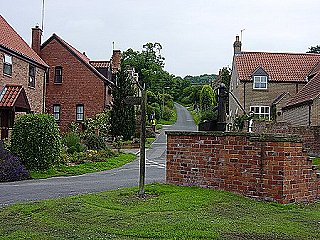 Jacob Heesom, the youngest son of Thomas Heesom and Fanny Skane, was born on 12 September 1810 and christened on 03 October 1810 at the Independent church in Swanland, Yorkshire, England. "The Story of the Heesoms" of Australia, by Ruth Place, claims the year was 1812.
Jacob Heesom, the youngest son of Thomas Heesom and Fanny Skane, was born on 12 September 1810 and christened on 03 October 1810 at the Independent church in Swanland, Yorkshire, England. "The Story of the Heesoms" of Australia, by Ruth Place, claims the year was 1812.
Jacob Heesam [sic] married Sarah Underwood at Brantingham on 6 February 1836, at the age of 25 - per Helen Heesom, an heir. Brantingham, pictured to the right, is just upriver from Swanland.
In the 1841 census of Elloughton, Yorkshire as Jacob Easom, a 29 year old joiner. Living with him were his wife, Sarah, 25, and their children, Caroline, 5, John, 3, Ann, 2, and Rebecca, 3 months.
| The Joiner
A joiner is a carpenter who builds things by joining pieces of wood, including furniture and the fittings for a house. |
In the 1851 census of Elloughton, Yorkshire as Jacob Heesom, a 40 year old joiner, of Welton. Elloughton is in Harthill wapentake, the Hunsley Beacon division, of the East Riding. This is just east of Welton. Living with him were his wife, Sarah, 37 [1814], of Brander...[Brantingham], and their children, John, 13, Ann, 11, Rebecca, 10, Sarah, 9, Thomas, 5, and Charlotte, 1, all of Elloughton.
In the 1861 census of Welton parish, Yorkshire as Jacob Heesom, a 50 year old carpenter, of Welton. Living with him were his wife, Sarah, 47, of Brantingham, and children, Thomas, a 15 year old "gardneer domestic servant," of Elloughton, and Henry, 4, of Welton.
In the 1871 census of Welton, Yorkshire as Jacob Heesom, a 60 year old wheel wright, of Welton. Living with him were his wife, Sarah, 58, of Brantingham, Yorkshire, and son, Henry, 14, of Welton.
In the 1881 census of Welton and Melton, Yorkshire as Jacob Heesom, a 70 year old laborer, of Welton. He was residing at Dale Gates. Living with him were his wife, Sarah, 66, of Brantingham, and unmarried son, Thomas, a 33 year old laborer, of Elloughton.
Jacob Heesom died in July-September 1886 in Welton, Yorkshire, at the age of 76. Sarah Heesom, who was born in about 1813, died in the 2nd quarter 1887 in Sculcoates, Yorkshire, at the age of 74.
Jacob and Sarah's children were,
(24) Caroline Heesom (1836)
(24) John Underwood Heesom (1837)
(24) Ann Skane Heesom (1839)
(24) Rebecca Heesom (1841)
(24) Sarah Heesom (1842)
(24) Thomas Heesom (1845)
(24) Charles Heesom (1849)
(24) Charlotte Heesom (1850)
(24) Emma Heesom (1854)
(24) Henry Heesom (1857)
Caroline Heesom, the daughter of Jacob and Sarah Heesom, was baptized on 6 November 1836 in Elloughton with Brough, Yorkshire. In the 1841 census of Elloughton, Yorkshire as Caroline Easom, 4, living with her parents, Jacob and Sarah Heesom. In the 1851 census of South Cave, Yorkshire, England as Caroline Esom, a 14 year old house servant, of Elloughton, Yorkshire. She was living with Ann and John Robinson. A Caroline Heesom married in the 2nd quarter 1862 in Yorkshire.
(24) John Underwood Heesom (1837)John Underwood Heesom, the son of Jacob Heesom and Sarah Underwood, was christened on 17 December 1837 at Elloughton With Brough, Yorkshire, England.
In the 1841 census of Elloughton, Yorkshire as John Easom, 3. In the 1851 census of Elloughton, Yorkshire as John Heesom, 13, of Elloughton.
| Elloughton with Brough
A parish in the wapentake of Harthill, a part in the liberty of St. Peter's; 3 miles SE. of South Cave. |
"In 1858 John Underwood Heesom married Mary Jane Sherwood at Welton, near Hull, Yorkshire. Later that same year on September 9, they left for Australia aboard the Jessie Munn from Liverpool." - per Helen Heesom.
Jessie Munn
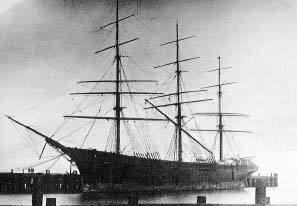
Ship: 875 tons: 142' x 29' x 23' Built: 1852 at Bathurst, New Brunswick, Canada The square-rigger Jessie Munn was one of many Canadian-built vessels sold to English owners. In 1854 on the Scandanavia/Germany to Canada run. The ship's name has been spelled "Jesse Munn" and "Jessie Munn" in different sources; however, the Liverpool registration and Lloyd's Register record the latter spelling. This three-master had one deck and a poop deck, a square stern, and a figurehead of a woman's bust. Principal owners of the ship were H. T. Wilson and John Duckitt, her master. In the 1860's she was on the Liverpool/Plymouth to Australia route. In 1868 the Jessie Munn was abandoned at St. Peter's Bank. The ship at left is the NESMITH, another 3-master on the same route. |
John and Mary arrived at Geelong, Australia, below, on 24 February 1859 and lived in a migrant center before moving to Geelong West. This was just southwest of Melbourne, in the state of Victoria. John worked on road building and other odd jobs, including running a merry-go-round and driving a Cobb & Co. coach between Geelong and Ballarat.
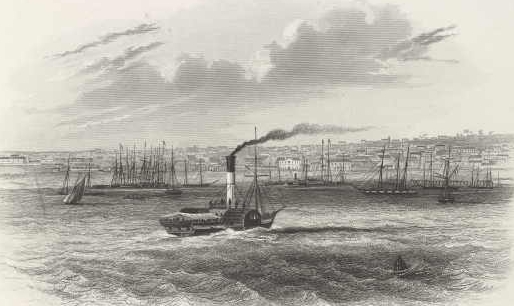
For more, go to the Heyshams in Australia page.
(24) Ann Skane Heesom (1839)Ann Skane Heesom, the daughter of Jacob and Sarah Heesom, was christened on 07 July 1839 at Elloughton With Brough, Yorkshire, England. In the 1841 census of Elloughton, Yorkshire as Ann Easom, 2, living with her parents, Jacob and Sarah Heesom. In the 1851 census of Elloughton, Yorkshire as Ann Heesom, 11.
Not in the 1861 census with her parents.
She married William Ernest in 1864, at the age of 25.
She died in October 1895 in Yorkshire, at the age of 56.
(24) Rebecca Heesom (1841)Rebecca Heesom, the daughter of Jacob and Sarah Heesom, was christened on 17 Janaury 1841 at Elloughton With Brough, Yorkshire, England. In the 1841 census of Elloughton, Yorkshire as Rebecca Easom, 3 months. She was living with her parents, Jacob and Sarah Easom. In the 1851 censu of Elloughton, Yorkshire as Rebecca Heesom, 10.
In the 1861 census of Pownall Fee, Wilmslow, Cheshire as Rebecca Heesom, a 19 year old servant, of Elloughton, Yorkshire. She was living with the family of John Beanlah [?], a farmer.
A Rebecca Heesom, of the Sculcoates district, married in the 3rd quarter 1872.
(24) Sarah Heesom (1842)In the 1851 census of Elloughton, Yorkshire as Sarah Heesom, 9, living with her parents, Jacob and Sarah Heesom. In the 1861 census of . . .
(24) Thomas Heesom (1845)Thomas, the son of Jacob Esom and Sarah, was baptized on 25 October 1845 in Elloughton With Brough, Yorkshire, England. In the 1851 census of Elloughton, Yorkshire as Thomas Heesom, 5, of Elloughton. In the 1861 census of Welton parish, Yorkshire as Thomas Heesom, a 15 year old "gardneer domestic servant," of Elloughton, living with his father, Jacob, and mother, Sarah.
In the 1871 census of Brighton, Sussex as Thomas Heesom, 24, a lodger, of Ellington [Elloughton?], Yorkshire.
In the 1881 census of Welton and Melton, Yorkshire as Thomas Heesom, a 33 year old [c1848], unmarried, laborer, of Elloughton. He was living at home with his parents, Jacob and Sarah Heesom.
Thomas Heesom married Julia Maria Suddaby in January-March 1887, in the Sculcoates Registration District, Yorkshire. "Both were Dale Keepers," of Yorkshire, England. Julia Maria Suddaby, the daugher of Samuel Suddaby and Ann Watkin, was born on 16 August 1854 and baptized on 7 September 1854 in Patrington, Yorkshire. Patrington is in East Yorkshire, on the outer reaches of the penisula that reaches into the Humber estuary.
Julia Suddaby, of Patrington, was in the 1861 census of Owstwick, Yorkshire, aged 6. Julia M. Suddaby, of Patrington, was in the 1871 census of Owtherne, Yorkshire as a 17 year old servant in the Jesse Graves' household. She was in the 1881 census of Sculcoates, Ferriby, Yorkshire as Julia Maria Suddaby, of Patrington, a 26 year old servant in the house of George Wm. Sonley.
In the 1891 census of Welton, Yorkshire as Thomas Heesom [Hersom in Ancestry.com], a 47 year old general labourer, of Elloughton. Living with him was his wife, Julia Maria, 37, of Patrington. They resided at Dale Gates. Does that mean Thomas was still a Dale Keeper?
In the 1901 census of Welton and Melton, Yorkshire as Thomas Heesom, a 56 year old general laborer, of Elloughton. Living with him were his wife, Julia, 46, of Patrington, Yorkshire, daughter, Beatrice, 18, of Hull, and his father-in-law, Samuel Suddaby, an 83 year old widower. Where was Beatrice during the 1891 census? Note that she was born several years before Thomas and Julia married. Might this indicate that Beatrice was adopted?
Thomas died before 1911.
In the 1911 census of of Melton, Wauldby and Welton, Yorkshire as Julia Maria Heesom [Heeson in Ancestry.com], a 55 year old widow and housekeeper to Francis Myers, a Grocer and Draper, of Patrington.
Julia M. Heesom, born in about 1854, died in the 4th quarter 1926 in Sculcoates, Yorkshire, England.
(25) Beatrice Heesom (1882)Beatrice was born in about 1883, which was 4 years before Thomas and Julia Marie Heesom married. There was an Annie Beatrice Hesom [sic], the daughter of Thomas and Mary Jane Hesom, who was born on 21 December 1882 in Hull, Yorkshire. Was Beatrice the daughter of an earlier marriage or liaison, and not welcome at home? Beatrice is not in the 1891 cenus with Thomas and Julia Marie.
In the 1901 census of Welton, Yorkshire as Beatrice Heesom, 18, of Hull, Yorkshire, living at home with her parents, Thomas and Julia Heesom.
Annie Beatrice Heesom married Benjamin Underwood in the 3rd Quarter 1901 in Sculcoates, Yorkshire. The Underwood connection seems to tie them to the Jacob Heesom line.
In the 1911 census of South Cave, Yorkshire as Annie Beatrice Underwood, 29, of Hull. She was living with her husband, Benjamin Underwood, a 39 year old market gardener, and children Henry Heesom [his middle name], 9, Arthur Benjamin, 8, Richard, 6, John, 4, Thomas, 2, and Ivy, 1.
Annie died in July 1911 in the East Riding, Yorkshire.
(26) Henry Heesom Underwood (1902)Henry was born on 30 January 1902 in North Ferriby, Humberside. He married Irene Gilchrist on 3 August 1929 in Hessle, Yorkshire. In 1931 he was living in Beverley, where his daughter, Betty Marie, was born.
(24) Charles Heesom (1849)Charles Heesom, the son of Jacob and Sarah Heesom, was christened 21 October 1849 at Elloughton With Brough, Yorkshire, England. Not in the 1851 census. A Charles Heesom died in July-September 1852 in Beverley, Yorkshire. Beverley is just north of Elloughton, in the East Riding.
(24) Charlotte Heesom (1850)In the 1851 census of Elloughton, Yorkshire as Charlotte Heesom, 1.
(24) Henry Heesom (1857)He was the son of Jacob and Sarah Heesom. I have a Henry Heesom who was born in April-June 1856 in Sculcoates, Yorkshire. Sculcoates was the registration district for Welton. In the 1861 census of Welton parish, Yorkshire as Henry Heesom, 4, of Welton, living with his parents, Jacob and Sarah.
In the 1871 census of Welton, Yorkshire as Henry Heesom, 14, of Welton. He was living at home with his parents, Jacob and Sarah Heesom. I lose sight of Henry after this.
(23) Hannah Heesom (1813)Hannah Heesom was born on 3 August 1813 and christened on 12 August 1813 at Independent, Swanland, Yorkshire, England. She was the daughter of Thomas and Frances Heesom. In the 1841 census of Welton parish, Yorkshire as Hanh [Hannah] Heesom, 25 [c1815]. She was living with her mother, Elz [Elizabeth], 55. Her father was living separately. Interestingly, the William Ransom family, for whom she later worked, were on the same page of the census.
In the 1851 census of Welton parish, Yorkshire as Hannah Heesom, a 36 year old servant, unmarried, of Welton. She was living in the home of the William Ransom family.
In the 1861 census of Welton parish, Yorkshire as Hannah Heesom a 47 year old spinster, of Welton. She was living with her stepmother, Elizabeth Heesom, a 77 year old widow, of Willesby, Yorkshire. A John Harper, 75, was also living with Hannah. This was the father-in-law of her little sister, Maria, below.
In the 1871 census of Welton parish, Yorkshire as Hannah Heesom [Hersom in Ancestry.com], a 57 year old with no occupation shown, of Welton. She was unmarried and living alone.
Hannah Heesom, 63, who was born in about 1813, died in the 3rd quarter 1876 in Beverly, Yorkshire.
(23) Maria Heesom (1819)A Thomas and Elizabeth Heesom were the parents of Maria, who was christened on 21 December 1819 at Welton With Melton, Yorkshire, England. In the 1841 census of Welton, Yorkshire as Mary Heesom, a 25 year old [c1816] female servant. She was living in a househould on the same page as that of her mother, Elizabeth.
Maria Heesom married Robinson Harper on 31 October 1844 at Welton With Melton, Yorkshire, England. Robinson was baptized on 16 June 1822 at St. Andrews, Kirk Ella, East Yorkshire, the son of John Harper, of North Ferriby, and Anne Robinson, of Goxhill. Maria and Robinson had seven children, all born in North Cave. Maria died after April 1861, in North Cave. Robinson died in 1895 in North Cave.
(20) Unnamed Heesom (1717)Of Ackworth. The son of William and Anne. He was baptized on 17 June 1717 in Ackworth. I assume he died young since he wasn't given a name.
(20) Susannah Heesom (1720)The daughter of William. She was baptized on 26 June 1720 in Ackworth.
This family survives in the Leeds district of Yorkshire.
(20) James Heesom (1726)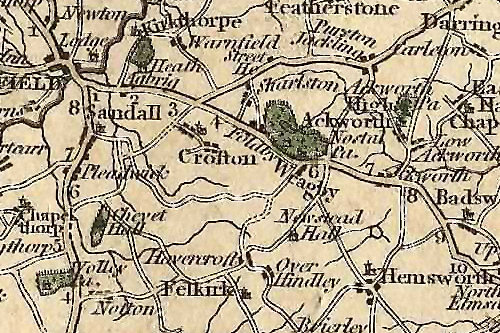 Of Low Town, Ackworth. James Heesom, the son of William Heesom, was baptized on 21 August 1726 in Ackworth, Yorkshire - from "England Births and Christenings, 1538-1975." No mother's name was given, but based on his siblings she should have been Anne. William and Anne Heesom [Heesome] had chidren baptized in Ackworth from 1705 to 1726.
Of Low Town, Ackworth. James Heesom, the son of William Heesom, was baptized on 21 August 1726 in Ackworth, Yorkshire - from "England Births and Christenings, 1538-1975." No mother's name was given, but based on his siblings she should have been Anne. William and Anne Heesom [Heesome] had chidren baptized in Ackworth from 1705 to 1726.
James Heesom married Ellen Chadbourn on 27 December 1749 in Sandal Magna. I have a reference to an
"Ellen Heesom (born Chadbourn)" who "was born in 1726, to Joseph Chadbourn and Elizabeth Chadbourn (born Ball)" - from "My Heritage" websiteI also show an,
Ellen Chadburn, the daughter of Joseph Chadbourn, baptized on 1 August 1726 in Sandal Magna, Yorkshire - from "England Marriages, 1538-1973"So James married Ellen in Sandal Magna because that was her home. Ellen Chadburn's parents:
Joseph Chadburn married Eliz Ball on 14 November 1723 in Wooley, Yorkshire - from "England Marriages, 1538-1973"Woolley is a village in West Yorkshire, south of Wakefield and due west of Royston.
James then took her back to his home, in Ackworth. All of James' and Ellen's children were baptized in Ackworth. The names Hellen is a common variant of Ellen [or is it the other way around?].
On the map to the right, see Low Ackworth on the extreme right side. Just up the road, to the left, is Wragby, then Crofton. Crofton was where (17) George Hesome and (18) Edward Esume lived. Further up, just outside Wakefield, which lies partially off the map, is Sandall [also as Sandal Magna].
In the baptismal records of his children James was noted to be a carpenter, of Low Town [Ackworth].
Towards the end of his life James moved back west, to Wragby. Note that the two villages are next door to each other. I have an Eleanora, wife of James Heesom, aged 57, who died on 24 November 1784 [born approximately 1727] and buried on the 26th at St. Michael's, Wragby. See their child, Sarah, below, for another use of the given name Eleanor, of which Ellen is a variant. James Hesom, 85 [1726], was buried on 2 October 1811 at St. Michael's, Wragby.
Their children were,
(21) Joseph Heesom (c1749)
(21) Joseph Heesom (1750)
(21) Elizabeth Heesom (1751)
(21) James Heesom (1754)
(21) Ann Heesom (1757)
(21) Sarah Heesom (1760)
(21) Ellen Heesom (1762)
(21) William Heesom (1765), the surving line of Altofts Normanton
(21) Thomas Heesom (1770)
"Joseph son of James Heesam" was buried on 23 January 1750 at St. Cuthbert's, in Ackworth, Yorkshire. James' wife, Ellen, must have been pregnant with Joseph at the time of their wedding.
(21) Joseph Heesom (1750)Joseph, the son of James and Hellen Heesam, of Low Town [Ackworth], was baptized on 23 November 1750 at St. Cuthbert's, in Ackworth, Yorkshire. James was noted to be a carpenter in the baptismal record.
(21) Elizabeth Heesom (1751)Elizabeth, the daughter of James and Hellen Heesem, was baptized on 9 February 1752 at St. Cuthbert's, Ackworth, Yorkshire - from "England Births and Christenings, 1538-1975."
I have an Elizabeth Heesom who married Jeremy Oates on 17 December 1776 in Wragby, Yorkshire. Note that between 1770 and 1784 Elizabeth's parents had moved to Wragby.
(21) James Heesom (1754)James, the son of James and Hellen Heesam, was born on 5 June 1754 and baptized on 7 July 1754 at St. Cuthbert's, in Ackworth, Yorkshire - from "England Births and Christenings, 1538-1975."
I have a James Heesom who married Ann Leach [Leech] on 27 November 1785 in Wragby [Howden?], Yorkshire. This might be our man. Notice that we've assumed, above, that James' parents, James and Ellen Heesom, had moved to the nearby village of Wragby, where Eleanora [sic] Heesom, the wife of James Heesom, was buried in 1784 and James Heesom, aged 85, was buried in 1811.
I haven't found any children.
(21) Ann Heesom (1757)Ann, the daughter of James and Hellen Heesam, was born on 12 January 1757 and baptized on 20 February 1757 at St. Cuthbert's, in Ackworth - from "England Births and Christenings, 1538-1975."
(21) Sarah Heesom (1760)Sarah, the dauther of Jeames and Eleanor Heesam, was born on 25 January 1760 and baptized on 9 March 1760 in Ackworth, Yorkshire.
A Sarah Hesom married Joseph Jackson on 15 May 1785 in Warmfield, Yorkshire. Warmfield is just east of Wakefield.
(21) Ellen Heesom (1762)Ellen, the daughter of James and Ellen Heesam, was born on 14 October 1762 and baptized on 28 November 1762 in Ackworth, Yorkshire - from "England Births and Christenings, 1538-1975."
| Altofts & Normanton
The Church of St Mary Magdalene is the Anglican parish church for the village. The building below is modern, begun in 1873. 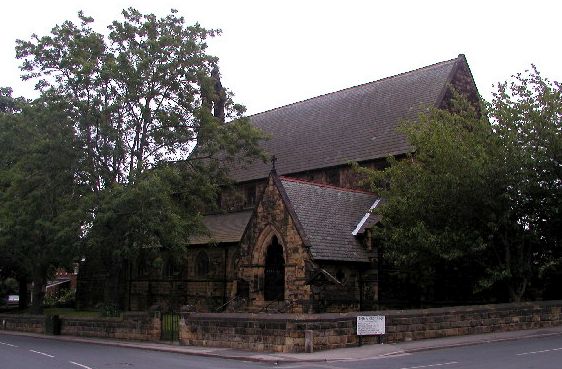
|
William, the son of James and Ellen Heesom, was born on 31 October 1765 and baptized on 1 January 1766 at St. Cuthbert's, in Ackworth, Yorkshire - from "England Births and Christenings, 1538-1975."
William Hesom married Hannah Ingham on 26 July 1789 in Pontefract, Yorkshire.
William and Hannah subsequently lived in Pontefract, Normanton, Altofts, and, by 1802, Wragby.
Their children were,
(22) James Heesom (1790), of Pontefract
(22) Mary Ann Heesom (1792), of Normanton
(22) William Heesom (c1795), of Pontefract
(23) Robert Heesom (1796)
(22) Thomas Heesom (1798), of Altofts
(22) Hannah Heesom (1802), of Wragby
(22) Elizabeth Heesom (1805), of Wragby
(22) George Heesom (1807), of Wragby
James, the son of William and Hannah Hesom, He was baptized on 13 June 1790 in Pontefract, Yorkshire.
James married Mary Ann Jackson on 23 May 1816 in Normanton, Yorkshire.
In the 1841 census of Altofts, Yorkshire as James Heesom, a 50 year old shoemaker. Living with him were his wife, Mary Ann, 45, and children Sarah, 20, James 11, and Eliza 6.
In the 1851 census of Altofts, Yorkshire as James Heesom, a 59 year old cordwainer [leather worker], born in Pontefract. Living with him was his wife, Mary, 56, and children, Sarah, a 29 year old dressmaker, and James, a 20 year old butcher, all born in Altofts.
In the 1861 census of Altofts, Yorkshire as James Heesom, a 69 year old cordwainer, born in Pontefract. Living with him were his wife, Mary Ann, 65, and a boarder, Robert Turner.
In the 1871 census of Altofts, Yorkshire as James Heesom, an 80 year old shoemaker, born in Pontefract. Living with him was his son-in-law, James Childs, 55, daughter Sarah, 45, and their child, Sophia, 13.
James died in March 1881 in Altofts, at the age of 91. Their children were,
(23) Sarah Heesom (1822), she married Joseph Child, she died in 1889
(23) James Heesom (c1830)
(23) Eliza Heesom (1833), she married John Himsworth, she died in 1907
Of Altofts. He was baptized on 19 September 1830 in Altofts, Normanton, Yorkshire, the son of James and Mary Heesom. In the 1841 census of Altofts, Yorkshire as James Heesom, 11, living with his parents, James and Mary Ann Heesom.
In the 1851 census of Altofts, Yorkshire as James Heesom, a 20 year old butcher, living at home with his parents, James and Mary.
He married Harriet Walton [aged 33?] in March 1859 at the age of 29. Another researcher calls her Harriet Bower.
In the 1861 census of Altofts, Yorkshire as James Heesom, a 30 year old butcher. He was lodging with George Priestley, a small farmer. Also living with James was George Henry, 4. There were also two Walton "step daughters," but of whom, George Priestley or James Heesom? They were Sarah Ann Walton, 9, and Harriet, 6. Where was Harriet, James' wife? And how come George was so premature?
In the 1871 census of Altofts, Yorkshire as James Heesom, a 41 year old butcher, born in Altofts. Living with him was his wife, Harriet, 42, of Carlton, and children, Geo Henry, a 14 year old Coal Screener, Louisa, a 11 year old scholar, Thomas, 9, Mary Emma, 7, Eliza, 5, and Clara, 2, all of Altofts.
In the 1881 census of Lofthouse cum Carlton, Yorkshire as James Heesom, a 49 year old butcher, born in Altofts. Living with him was his wife, Harriet, 53, of Carlton, and children, George H., a 24 year old bricklayer, Thomas, a 19 year old farm laborer, and Eliza, a 15 year old general servant, all of Altofts.
He died in 1887 in Wakefield, Yorkshire at the age of 57. In 1891 Harriet was living in Chapel street, Lofthouse cum Carlton, Yorkshire. She remained in Lofthouse in 1901, but residing at Peartree House. Harriet died in 1907 in Wakefield.
In the 1891 census of Lofthouse cum Carlton, Yorkshire as Harriet Heesom, a 63 year old widow. Living with her were children Louisa, 31, and Thomas, 29, both born in Altofts.
Their children were,
(24) George Henry Heesom (1857)
(24) Louisa Heesom (1859)
(24) Thomas Heesom (1861)
(24) Mary Emma Heesom (1863)
(24) Eliza Heesom (1866)
(24) Clara Heesom (1869), who died young
He was born two years before his parent's marriage, in about 1857 in Altofts, Yorkshire. The FamilySearch.org database says that George Henry, the son of James and Harriet Heesom, was baptized on 12 May 1861 in Normanton, Yorkshire. Perhaps the baptism waited on his parents finally getting married. In the 1861 census as George Henry Heesom, 4, of Altofts.
In the 1871 census of Altofts, Yorkshire as George Henry Heesom, a 14 year old Coal Screener, living at home with his parents, James and Harriet. He was born in Altofts.
In the 1881 census of Lofthouse Cum Carlton, Yorkshire as George H. Heeson [sic], a 24 year old bricklayer, living with his mother and father, James and Harriet.
George Henry Heeson [sic] married Elizabeth Swan [Swann] on 4 December 1887 in New Malton, North Yorkshire.
In the 1891 census of Leeds, Yorkshire as George H. Heesom, a 34 year old bricklayer, born in Altofts. Living with him were his son, Thomas H., 5, born in Leeds, and two boarders, Thomas R. Swann, a 20 year old fishmonger, and Johanna Swann, a 10 year old tailoress. These must be his in-laws, but where was Elizabeth?
I have a George Heesom, born to George Henry Heesom, brick layer, and Elizabeth Heesom, on 29 April 1895 and baptized on 20 June 1895 in Leeds, St John the Baptist, Yorkshire. I also have a death notice for George Heesom, born in about 1895 and died in the 2nd Quarter 1895, or just after his baptism.
In the 1901 census of Armley parish, Leeds borough, Yorkshire as George Hny Heesom, a 44 year old bricklayer, of Altofts, Yorkshire. Living with him were his wife, Elizabeth, 36, and children, Thomas Hy [Henry], a 15 year old Currier's [?] apprentice, Elizabeth, 4, and Amy, 3 months, all of Leeds.
In the 1911 census of Altofts, Yorkshire as George Henry Heesom, a 54 year old bricklayer. Living with him was his wife, Elizabeth. I have Amy, 10, Eva, 8, and Harry, 5, in Armley, Yorkshire.
Their children were,
(25) Thomas Henry Heesom (c1886)
(25) George Heesom (1895), who died young
(25) Elizabeth Heesom (1897), she married John Stead on 29 January 1916 at St Peters, Leeds.
(25) Amy Heesom (1900)
(25) Eva Heesom (1902)
(25) Harry Heesom (1906), did he survive?
He was born in 1887. In Leeds and Armley, Yorkshire, in 1891, 1901 and 1911, aged 5, 15, and 25, living with his parents, George and Elizabeth Heesom. Beware, there is also a Thomas Henry Heesom, born in about 1884 [1887] in Warrington, Lancashire. His wife was Annie. Our Thomas married Ethel Elizabeth Ginn in 1910. He was a screw maker.
Thomas H. Heesom, who was born in about 1887, died in 1955 in Leeds, Yorkshire. Thomas and Ethel had two children,
(26) Living Heesom (c1910),
(26) Leonard Heesom (1911), was born on 22 February 1911, in Bramley, Leeds. Not to be confused with Leonard Melville Heesom of Horbury, Yorkshire who was born in 1910 [I think]. In the 1911 census of Armley and Bramley, Yorkshire as Leonard Heeson, aged 0. He married May Bell in 1936 in Leeds North. They had two children. He may have married again, to Margaret M. Illingworth, in 1956. Leonard Heesom died in 1983 in Leeds, Yorkshire.
- (27) Living Heesom (c1935)
- (27) Shirly Margaret Heesom (1936-1988)
Louisa, the daughter of James and Harriet Heesom, was baptized on 12 May 1861 at the Church of Normanton, Yorkshire.
In the 1871 census of Altofts, Yorkshire as Louisa, a 11 year old scholar, born in Altofts. living at home with her parents, James and Harriet. In the 1881 census of Lofthouse cum Carlton, Yorkshire . . . where was Louisa? In the 1891 census of Lofthouse cum Carlton, Yorkshire as Louisa, 31, living at home with her mother, Harriet, and borhter, Thomas.
In the 1901 census of Potter Newton, Yorkshire as Louisa Heesom, a 40 year old servant, born in Altofts. I don't see Louisa in the 1911 census.
She died in December 1947 in Leeds, aged 87, and shares a headstone with her younger brother, Thomas.
(24) Thomas Heesom (1861)Thomas, the son of James and Harriet, was baptized on 8 September 1861 in Normanton, Yorkshire. In the 1871 census of Altofts, Yorkshire as Thomas Heesom, 10. In the 1881 census of Lofthouse Cum Carlton, Yorkshire as Thomas Heesom, a 19 year old farm laborer.
In the 1891 census of Lofthouse cum Carlton, Yorkshire as Thomas Heesom, a 29 year old farm laborer. He was living with his mother, Harriet, and sister, Louisa.
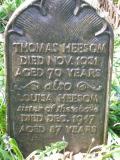 The ROYALIST, a fishing trawler owned by George Walton of Hull, was in the news in January 1900. In October 1899 Icelandic authorities attempted to arrest the ship and crew for fishing in Icelandic territorial waters. In the encounter three Icelanders were drowned when their boat overturned. T. Heesom was listed as Fourth Hand, the most junior of the crew. Was this our Thomas? Could George Walton be a Thomas' uncle, the brother of Harriet Walton, his mother?
The ROYALIST, a fishing trawler owned by George Walton of Hull, was in the news in January 1900. In October 1899 Icelandic authorities attempted to arrest the ship and crew for fishing in Icelandic territorial waters. In the encounter three Icelanders were drowned when their boat overturned. T. Heesom was listed as Fourth Hand, the most junior of the crew. Was this our Thomas? Could George Walton be a Thomas' uncle, the brother of Harriet Walton, his mother?
In the 1901 census of Peartree House, Lofthouse cum Carlton, Yorkshire as Thomas Heesom, 40.
In the 1911 census Leeds, Yorkshire as Thomas Heesom, 58 [1853].
Per his tombstone, he died in November 1931 at the age of 70. His sister was Louisa. She died in 1947 at the age of 87. They were both buried at the church of St. John the Baptist Church in Adel, Yorkshire. Adel is a suburb of Leeds.
(24) Clara Heesom (1869)Clara Heesom was born in 1869 in Altofts, Yorkshire, the daughter of James Heesom and Harriet Bower.
(22) Mary Ann Heesom (1792)She was baptized on 9 December 1792 in Normanton. Mary Ann Heesom, aged 21 [1795], married John Lazenby, aged 21, on 31 August 1816 in Pontefract, Yorkshire. Their son, Thomas, was baptized in September 1817 in Pontefract. She died on 3 September 1865 in Old Crown Yard, Wakefield, Yorkshire.
(22) William Heesom (c1795)He was born in about 1795 in Pontefract, Yorkshire. He fits as a son of William Heesom and Hannah Ingrham in Pontefract.
In the 1851 census of Leeds, Yorkshire as William Heesom, a 57 year old bricklayers labourer, of Altofts. Living with him were his wife, Ann, a 56 year old laundress, of Kirkby, and children, Eliza, a 20 year old laundress, Thomas, a 15 year old labourer, and James, a 13 year old labourer, all of Leeds.
In the 1861 census of Leeds, Yorkshire as William Heeson, a 67 year old laborer, born in Pontefract, Yorkshire. Living with him were his wife, Ann, 66, and sons James, a 23 year old Quarry Man, of Leeds, and Williamson, a 16 year old Warehouse Boy, of Leeds. They lived at 38 Woodhouse [street?]. This is in the northern part of Leeds, near Hyde Park. Pontefract is about 4 miles east of Altofts.
William Heesom, born in about 1794, died and was buried on 30 June 1861 at the age of 67 at St. Mark's church, in Woodhouse parish. Ann died and was buried on 9 May 1865 at St. Mark's church, Woodhouse parish.
His children were,
(23) Eliza Heesom (1831)
(23) Thomas Heesom (1835), he died a young man
(23) James Heesom (c1838), he never married
(23) Williamson Heesom (1844), he never married
Thomas, the son of William and Nancy Heesom, was born on 10 June 1835 and baptized on 26 February 1843 at St. Mary's church, Woodhouse parish, Yorkshire. Why the 8 year wait?
In the 1851 census of Leeds, Yorkshire as Thoms Heesom, a 15 year old labourer, of Leeds. He was living with his parents, William and Ann Heesom.
Thomas died in 1859 and was buried on 31 May 1859 at St. Mary's church, Woodhouse parish at the age of 23. He apparently never married.
(23) James Heesom (c1838)In the 1851 census of Leeds, Yorkshire as James Heesom, a 13 year old labourer, of Leeds. His parents were William and Ann Heesom. In the 1861 census of Leeds, Yorkshire as James Heeson, a 23 year old Quarry Man, of Leeds. He lived at 38 Woodhouse [street?] with his parents, William and Ann.
In the 1871 census of Holbeck, a suburb south of Leeds, Yorkshire as James Heesom, a 33 year old unmarried stone mason, born in Leeds. He was a boarder living with Mary Thompson, a 39 year old widow, a seamstress, at 21 Brittain Court.
In the 1881 census of Holbeck as James Heesom, a 41 year unmarried old stone mason, born in Woodhouse, Yorkshire. He was unmarried and still boarding with Mary Thompson, but now at 21 Woolwich street.
I have a James Heesom, born in about 1838, who died in the second quarter of 1886, in Leeds. He was 48 years old. He apparently never married and had no children.
(23) Williamson Heesom (1844)He was born in July 1844 in Leeds, Yorkshire.
In the 1851 census of Leeds, Yorkshire, as William H. Heesome, 6. I haven't been able to get into this census to see who he was living with. In the 1861 census of Leeds, Yorkshire as Williamson Heeson, a 16 year old Warehouse Boy, of Leeds. He lived at 38 Woodhouse [street?] with his parents, William and Ann.
In the 1871 census of . . .
In the 1881 census of Leeds, Yorkshire as William Heesom, a 36 year old Stuff [flax, I believe] Warehouseman, out of employ. He was boarding with Mary Garth, 53.
In the 1891 census of Leeds, Yorkshire as William Heesom, a 46 year old Cloth Warehouseman, born in Leeds. He was boarding with Mary Garth, 65.
William H. Heesom, born in about 1843, died in October 1915 in Leeds, Yorkshire, at the age of 72. He apparently never married and had no chidren.
(22) Robert Heesom (1796)This may be a son of (21) William Heesom (1765). Some have claimed that this was actually (22) William Heesom (c1795), above, despite the fact that the 1841 clearly shows this to be "Robt." However, some of his children and their dates of birth do seem to replicate those of William. I also don't find Robert in later censuses.
In the 1841 census of Leeds, Yorkshire as Robt Heesom, a 45 year old labourer. Living with him were his wife, Ann, 45, and children, William, a 20 year old wool dyer, John, a 15 year old labourer, Harriet, 13, Eliza, 11, Hannah, 9, Thomas, 5, and James, 3.
In the 1851 census . . .
I have a Robert Heesom who died in 1854 in Hunslet, Yorkshire. This is a suburb of Leeds, just to its south. I have an Ann Heesom who died in 1865 in Leeds, but this is probably William Heesom's wife, above.
Their children were,
(23) William Heesom (1821)
(23) John Heesom (1826)
(23) Harriet Heesom (1828)
(23) Eliza Heesom (1830)
(23) Hannah Heesom (1832)
(23) Thomas Heesom (1836)
(23) James Heesom (1838)
A William Heesom, the son of William [see comments above] and Ann, was born on 25 April 1820 in Ledsham, Yorkshire.
In the 1841 census of Leeds, Yorkshire as William Heesom, a 20 year old wool dyer. He was living with his parents, Robt and Ann Heesom.
He married Dinah Lee. In 1841 Dinah, a 20 year old "worsted twister," was living with a Ann Smith, 70, in Leeds.
In the 1851 census of Woodhouse, Yorkshire as William Hesome, a 30 year old "stuff linger" [stuff singer : one who singes (burns) coarse flax before it is dyed], residing on Nesby court. Woodhouse is near Leeds. Living with him was his wife, Dinah, 30. She was from Woodhouse, he from Faven [Farburn?], in Yorkshire.
In the 1861 census of West Leeds, Yorkshire as William Heesom [Heeson in Ancestry.com], a 40 [he begins exagerating his age at this point] year old laborer, of Farburn. Living with him were his wife, Dinah, 40, and children, Henry, 9, and Thomas, 8. of Leeds. William appears to have "aged" to match his wife's years.
In the 1871 census of West Leeds as William Heesom [Hasom in Ancestry.com], a 49 year old dyer, of Fair Bourne. Living with him were his wife, Dinah, 53, of Bramely, and sons, Henry, a 19 year old warehouseman, and Thomas, an 18 year old mason, of Woodhouse.
Dinah Heesom died on 15 June 1876 in Leeds. In the 1881 census of West Leeds as William Heesom, a 61 [?] year old laborer, of Farburn, Yorkshire. Living with him was his new wife, Mary, 59, of Leeds.
William Heesom, 64 [1821], died in April-June 1885 in Leeds, Yorkshire.
Their children were,
(24) George Heesom (1847-1848)
(24) Henry Heesom (1851)
(24) Thomas Heesom (1852)
(24) Alfred Heesom (1861-1861)
Henry was born in 1851 in Leeds, Yorkshire, the son of William and Dinah Heesom.
In the 1861 census of West Leeds, Yorkshire as Henry Heesom [Heeson in Ancestry.com], 9, of Leeds. In the 1871 census of West Leeds as Henry Heesom [Hasom in Ancestry.com], a 19 year old warehouseman, of Woodhouse, living at home.
In the 1881 census . . . a 29 year old.
In the 1891 census of Bradford, Yorkshire as Henry Heesom, a 39 year old woolen warehouseman, of Leeds. He resided on 21 Airedale road. Living with him were his wife, Ann, 35, and children, Harriet, 7, Edith, 5, Amy, 3, and Harold, 1, of Leeds.
In the 1901 census of Headingley cum Burley, Yorkshire as Henry Heesom [Heeson in Ancestry.com], a 49 year old electric [garbled] car driver. Living with him were his wife, Ann, 46, and children, Harriet Ann, a 17 year old woolen cloth knitter, of Leeds, Edith, a 15 year old domestic nurse, Amy, a 13 year old linen weaver, Harold, 11, and Ada, 4, of Bradford.
In the 1911 census of Leeds, Yorkshire as Henry Heesom, 59. Living with him were his wife, Ann, 56, and children Edith, 25, Amy, 23, Harold, 21, and Ada, 14.
Henry died on 14 April 1924 in Leeds. His children were,
(25) Harriet Heesom (1884)
(25) Judith Heesom (1886)
(25) Amy Heesom (1888)
(25) Harold Heesom (1890)
(25) Ada Heesom (1887)
He was born in the 2nd Quarter of 1889 in Bradford. In the 1891 and 1901 census of Bradford, Yorkshire.
In the 1911 census of Leeds, Yorkshire as Harold Heesom, 21.
I have a Harold Heesom who married Clara Walker in the 2nd Quarter of 1912 in Leeds. A Harold W. Heesom was in the Medical Corps in World War I.
(24) Thomas Heesom (1852)Thomas was born in the 3rd quarter 1852 in Leeds, Yorkshire, the son of William and Dinah Heesom.
In the 1861 census of West Leeds, Yorkshire as Thomas Heesom [Heeson in Ancestry.com], 8, of Leeds. In the 1871 census of West Leeds as Thomas Heesom [Hasom in Ancestry.com], an 18 year old mason, of Woodhouse, living at home with his parents, William and Dinah Heesomm.
Thomas, a 22 year old dyer, the son of William Heesom, dyer, married Elizabeth, 21, the daughter of Edward Child, crabber, on 22 November 1874 at St. Mark's Church, Woodhouse parish, Leeds, Yorkshire. Witnesses were Henry Heesom, Thomas' brother, and Ann Hannam.
In the 1881 census of West Leeds, Yorkshire as Thomas Heesom, a 28 year old dyers laborer, of Leeds. Living with him were his wife, Elizabeth, 27, and children, Edwin, 3, and Harriet, 5 months, all of Leeds.
In the 1891 census of Leeds, Yorkshire as Thomas Heesom [Husom in Ancestry.com], a 38 year old dyers labourer. Living with him were his wife, Elizabeth, 37, son, Edward, 13, and in-laws, Joseph Childs, Edward Childs, 19, and Emma J. Childs, 19.
In the 1901 census of Leeds, Yorkshire as Thomas Heesom [Hersom in Ancestry.com], a 48 year old Tramways labourer. Living with him were his wife, Elizabeth, 47, children, Edward, a 23 year old Currier's Sable [garbled], and William, 7, and sister-in-law, Emma Jane Child, a 26 year old weaver.
In the 1911 census of Leeds, Yorkshire as Thomas Heesom, a 58 year old coach painter's labourer, of Tramways Corporation. Living with him were his wife, Elizabeth, 57, son, William, a 17 year old tailor cutter, and his sister-in-law, Emma Jane Childe, a 36 year old cloth weaver in the woolen mill.
Thomas Heesom died in 1935 at the age of 82 [1853]. His children were,
(25) Edward Heesom (1878)
(25) William Heesom (1894)
Edward was born in the 3rd quarter 1877 in Leeds. In the 1881 census of Leeds, Yorkshire as Edwin Heesom, 3, the son of Thomas and Elizabeth Heesom. In the 1891 census of Leeds, Yorkshire as Edward Heesom [Husom in Ancestry.com], 13. In the 1901 census of Leeds, Yorkshire as Edward Heesom [Hersom in Ancestry.com], 23 year old Currier's Sable [garbled]. He was still living with his parents, Thomas and Elizabeth Heesom.
In 1909 Edward Heesom married Alice Slater in Leeds, Yorkshire. I believe Alice was born in 1878.
In the 1911 census of Leeds, Yorkshire as Edward Heesom, a 32 year old coach painters labourer [just like his father]. Living with him was his wife, Alice, 32.
Edward died in the 4th quarter 1958 in Leeds at the age of 81. Alice died in the 4th quarter 1960 in Leeds at the age of 82.
(25) William Heesom (1894)William was born in the 1st quarter 1894 in Leeds. In the 1901 census of Leeds, Yorkshire as William Heesom [Hersom in Ancestry.com], 7. He was living with his parents, Thomas and Elizabeth Heesom. In the 1911 census of Leeds as William Heesom, a 17 year old tailor cutter, living with his parents, Thomas and Elizabeth Heesom.
I have a William Heesom who married May Campbell in the 4th quarter 1927 in Leeds. I believe May was born on 1 June 1895.
William Heeson [sic], born circa 1894, died in the 1st quarter 1972 in Staincliffe, Yorkshire. Staincliffe is about 5 miles southwest of Leeds. May Heesom died in the 2nd quarter 1971 in Pontefract, Yorkshire.
(24) James Heesom (1838)Of Woodhouse, which is a residential area just north of the city center of Leeds. Here's an odd reference, though not necessarily our J. Heesom.
"Report on Crime and Punishment In the Royal Navy, in the Year 1864An unnatural crime in the Navy was buggery. HMS EXCELLENT was, after 1835, a shore establishment housed in a hulk in Portsmouth. In 1864 the hulk was the ex-HMS QUEEN CHARLOTTE, a 104-gun 1st rate, renamed HMS EXCELLENT. HMS EXCELLENT was a gunnery school and a test site for the evaluation of new weaponry.
. . .
Robert Bertie and J. Heesom, servants, H.M.S. Excellent; for an unnatural crime, 10 years each." - from Parliamentary Papers" of 18
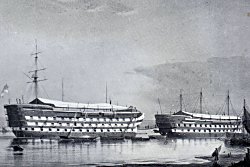
Thomas, the son of William and Hannah Hesom, was christened in December 1798 in Altofts, Normanton, Yorkshire. Thomas Heesom married Sarah Lucey or Livesey, the daughter of Betty Livesey, on 10 February 1823 in Whitkirk, Yorkshire.
The following is an amazing, and sad, story about Thomas and his daughter, Hannah [named for his mother?], who was 5 years old when she died.

"If Only They'd Listened: The Sad Tale of Hannah HeesomJustice Room, Wakefield
Before Benjamin Dealtry, Esq. and Daniel
Gaskell, Esq.Trial of Thomas Brown, for stealinng a dead body at Whitkirk.--The prisoner was charged with disinterring the body of Hannah Heesom, the daughter of Thomas Heesom, from a grave in the church yard at Whitkirk, and taking it away on the night of 31st December [1828].
New Year's Eve, 1828, was a sad day for Thomas Heesom. Not only did he bury his daughter, 5 year old Hannah, but that evening, her body was snatched not having been in the ground 24 hours.
The strict instructions given by Mr Heesom, to place alternate layers of straw and soil in Hannah's grave when filling it back up were ignored, the straw being 'dumped' directly on top of the coffin before the last layer of soil was replaced.
If the Sexton had listened to Thomas Heesom that day, Hannah may still be in her final resting place. However, less than 24 hours later, Hannah, together with her coffin, were removed from Whitkirk church by the body snatcher Thomas Brown.
A body was destined to be snatched that night regardless. Brown had had an 'order' for a 'small one, either male or female' and like many Resurrection Men, Brown was determined to deliver.
The notorious body snatcher William Yeardley was the one to alert Thomas Heesom that his daughter's body had been snatched from her grave, a mere four hours after it had been interred. Accompanying a constable to a public house in Hull, Brown was arrested and brought back to Leeds to stand trial.
Brown would probably have been caught away, he was disturbed a number of times whilst trying to secure a 'subject' that night, and it was his lack of care on removing Hannah's body and his failure to 'make the grave up' that led to his arrest. Yeardley just pointed the authorities in the right direction.
Brown was sentenced to one month imprisonment with hard labour. William Yeardley was not imprisoned on this occasion despite his obvious involvement.
Incidentally, Brown's lack of care when removing Hannah's body was done so badly that when standing in the witness box Yeardley stated that: 'it would prevent them from doing anything in that way, in the neighbourhood, for a year'
Just as well he claimed the £10 reward offered by Thomas Heesom then."
- from The Untold Stories of Britain's Resurrection Men

In the 1841 census of Halton, Whitkirk parish, Yorkshire as Thomas Heesom [Hessom in Ancestry.com], a 40 year old Hay Dealer. Living with him were his wife, Sarah, 40, and children, John, 15, James, 12, William, 10, Thomas, 8, George, 2, and, I presume, his mother-in-law, Betty Livesey [Lucey], a 70 year old widow.
In the 1851 census of Halton, Yorkshire as Thomas Heeson [sic], 52, of Altofts, Yorkshire. Living with him were his wife, Sarah, 50, and children, James, 22, William Henry, 20, Thomas, 17, George Frederic, 11, all of Halton.
In the 1861 census of Healton [Halton?], Whitkirk parish, which is near Leeds, in Yorkshire as Thomas Heesom, a 61 year old farm laborer, of Shaner [?], Yorkshire. Living with him were his wife, Sarah, a 60 year old laundress, grand-daughter, Hannah, 12, and sister-in-law, Elizabeth Livsey [Lucey], a 58 year old laundress, all of Whitkirk.
In the 1871 census of Halton, Yorkshire as Thomas Heesom, a 71 year old road laborer. Living with was Sarah, his wife, 70.
A Thomas Heesom, born in about 1799, died in July 1878 in Hunslet, Yorkshire.
His children were,
(23) Hannah Heesom (1823), see her story above
(23) John Heesom (1825)
(23) James Heesom (1829)
(23) William Henry Heesom (1831)
(23) Thomas Heesom (1833)
(23) George Frederic [Frederick] Heesom (1839)
John was baptized on 24 April 1825 in Whitkirk, Yorkshire, the son of Thomas and Sarah Heesom.
In the 1841 census of Halton, Whitkirk parish, Yorkshire as John Heesom [Hessom in Ancestry.com], 15, living with his parents, Thomas and Sarah.
John Heesom married Mary Ann Ackroyd in 1850 in Leeds.
In the 1851 census of Leeds, Yorkshire as John Heesome, a 28 year old Stuff Singer [one who singes (burns) coarse flax before it is dyed], born in Leeds. Living with him was his wife, Mary A., 28, and his son, William H., 6, all of Leeds.
In the 1861 census of Leeds, Yorkshire as John Heesom, a 38 year old Stuff Singer, born in Dodworth. Living with him were his wife, Maryann, 38, and daughter, Sarah, 3, both of Leeds. Did William H. die young?
In the 1871 census of Leeds, Yorkshire as John Heesom, a 48 year old "stoner" [stone mason?]. He was residing at 2 Peel Court. Living with him were his wife, Mary Anne, a 48 year old housekeeper, and children, Sarah, a 13 year old mill girl [love that child labor], and James, 9 [1862]. All were of Leeds.
In the 1881 census of West Leeds, Yorkshire as John Heesom, a 58 year old dyer, of Dodworth, Yorkshire. Living with him were his wife, Mary A., 55, and children, James, a 19 year old Stuff Tenterer (?), James H. Thackwray, a 24 year old bricklayer [I assume he's a son-in-law], and Sarah Thrackway, a 23 year old weaver.
A John Heesom, born in about 1823, died in January 1883 in Wakefield, Yorkshire.
Their children were,
(24) William H. Heesom (1845), in the 1851 census of Leeds, Yorkshire as William H. Heesome, 6, living with his parents, John and Mary A. Heesom. He was not in the 1861 census, apparently dying young.
(24) Sarah Agnes Heesom (1860), in the 1861 census, she married James H. Thackwray. Living wih her parents and husband in the 1881 census.
(24) James Heesom (1861)
| (24) Benjamin Atkinson Heesom (1849)
A stray? He was baptized on 30 September 1849 in Whitkirk, Yorkshire, the son of John and Mary Heesom. In the 1861 census of Leeds, Yorkshire as Benjamin Heesom, 11, living with Priscilla Heesom, a 36 year old washerwoman, the sister of Robert Carter, and Sarah, 1, all born in Whitkirk. |
James was born on 15 July 1861 in Leeds, Yorkshire, the son of John Heesom and Mary Ann Ackroyd. He was baptized on 11 August 1861 at St. Mark's church, Woodhouse parish, in Leeds. In the 1871 census of Leeds, Yorkshire as James Heesom, 9, of Leeds, living at home with his parents, John and Mary Anne. In the 1881 census of West Leeds, Yorkshire as James Heesom, a 19 year old Stuff Tenterer [?], living at home with his parents, John and Mary A. Heesom.
James, a 22 year old labourer, the son of John Heesom, deceased, married Harriet Hannah, 23, the daughter of George Miller, tailor, on 17 November 1883 at St. Mark's church.
In the 1891 census of Leeds, Yorkshire as James Heesom [Husom in Ancestry.com], a 29 year old general labourer. Living with him were his wife, Harriet H., a 31 year old weaver, child, Clara, 3, and mother-in-law, Ann Miller, a 62 year old widow.
Harriet died in October 1900 in Yorkshire.
In the 1901 census of West Leeds, Yorkshire as James Heesom, a 39 year old dyer laborer, of Leeds. He was a widower. Living with him were his children, Clara, 13, Lily, 9, and William, 5, all of Leeds.
James married Sarah Ann Atkinson on 2 May 1904 in Leeds.
In the 1911 census of Leeds, Yorkshire as James Heesom, a 49 year old labourer in the Stuff Dyehouse. Living with him were his wife, Sarah ann, 31, and children, Lily, a 19 year old machinist in a tailor's shop, William, a 15 year old office boy at the coal depot, Albert, 4, and Ernest, 2.
James died in the 1st quarter 1938 in Leeds. Sarah died in 1953. His children were,
(25) Clara Heesom (c1887), she married James White
(25) Lily Heesom (c1891)
(25) William Heesom (1896)
(25) Harry Heesom (1904), he died in 1905
(25) Albert Heesom (1906), baptized on 17 October 1906 at Wrangthorn, St. Augustine, Yorkshire, he died in 1922 at the age of 16.
(25) Ernest Heesom (1909), born on 10 March 1909 in Leeds and baptized at St Augustine, Woodhouse parish, Wrangthorn, Leeds. He married Ellen Donkin in the 4th quarter 1930. He died in the 4th quarter 1992 in Leeds.
- (26) Ann Heesom (1938), mother's maiden name Donkin
- (26) Alan Heesom (1954), born 4th quarter 1954, mother's maiden name Donkin
(25) James Heesom (1912), was born on 29 October 1912 in Leeds, mother's maiden name Atkinson, he married Vesta Cole in 1937 in Leeds. Vesta Cole, the daughter of Leonard Cole and Susannah Maw, was born on 30 December 1914 in Leeds. James died on 27 May June 1957 in Leeds. Vesta died in August 1987. No children are indicated.
(25) Walter Heesom (1919), was born in the 4th quarter 1919 in Leeds (15 November 1919 per another researcher), mother's maiden name Atkinson, Lance Corporal Walter Heesom, 25th Dragoons Royal Armoured Corps, died on 7 February 1944 and was buried at the Taukkyan War cemetery in Htuak Kyant, Yangon [Rangoon] Region, Burma. Walter probably died as the Japanese attacked a region known at the Admin Box in two thrusts on 7 February, and immediately the British were pushed back. See more about the battle below and at The Battle That Turned the War in the Far East.
| 25th Dragoons
The 1941 regiment was raised in Sialkot, India, in February 1941 from a cadre of personnel taken from the 3rd Carabiniers along with volunteers from infantry regiments. It was initially assigned to the 4th Indian Armoured Brigade (which later became 254th Indian Armoured Brigade and, still later, the 254th Indian Tank Brigade). In 1943, it was reassigned to the Indian XV Corps and transported in great secrecy to Arakan prior to taking part in the Battle of the Admin Box, in which its M3 Lee tanks proved decisive. It spent the remainder of the war in India and Burma. It was part of the 50th Indian Tank Brigade and based in Madras and Bangalore prior to being disbanded in 1947. Admin Box The Battle of the Admin Box, sometimes referred to as the Battle of Ngakyedauk or the Battle of Sinzweya, took place on the southern front of the Burma Campaign from 5 to 23 February 1944, in the South-East Asian Theatre of World War II. Japanese forces attempted a local counter-attack against an Allied offensive with the aim of drawing Allied reserves from the Central Front in Assam, where the Japanese were preparing their own major offensive. After initial setbacks, the Allies recovered to thwart the Japanese attack, pioneering the methods which would lead to further Allied victories over the following year. The battle takes its name from the "administration area" of the Indian Army's 7th Division, which became a makeshift, rectangular defensive position for Major-General Frank Messervy and his staff after their divisional headquarters was overrun on 7 February. Bryan Perrett, in his book, Tank tracks to Rangoon, says of the 25th Dragoons,"they will always be remembered by anyone who fought in the Arakan as having been a major factor in smashing the myth of Japanese invincibility". The history of the 5th Indian Division comments: "The debt owed to those tanks (of the 25th Dragoons) and their crews cannot be over-emphasized. It was their accurate, high velocity, close-range blasting which put our infantry back whenever the Japanese penetrated our defences or captured any vital position."- taken in part from Wikipedia. |
The son of James and Sarah.
(23) James Heesom (1829)James was baptized on 19 April 1829 in Whitkirk, Yorkshire, the son of Thomas and Sarah Heesom. In the 1841 census of Halton, Whitkirk parish, Yorkshire as James Heesom [Hessom in Ancestry.com], James, 12. This is not the James Heesom, born circa 1830 in Altofts & Lofthouse, who also married a woman named Harriet.
In the 1851 census . . .
James married Hannah Williamson in June 1854 in Keighley, Yorkshire.
In the 1861 census of 48 Higham street, Manchester, St. John parish, Lancashire, England as James Heesom, a 32 year old iron moulder, born in Halton, Yorkshire. Living with him was his wife, Hannah, 31, born in Guisley [?].
I have a James Heesom, born in about 1829, who died in 1890, and was buried on 1 December in London, at the age of 61.
James and Harriet's children were,
(25) George Frederick Heesom (1855), perhaps
In 1855 a George Frederick Heesom, was born to James and Hannah Heesom in Bradford, Yorkshire. This might be the George Heesom that went into service with the Palmer family in Wrexham. In the 1861 census of Welton, Yorkshire as George Heesom, a 6 year old scholar.
In the 1871 census . . .
(23) William Henry Heesom (1831)William Henry Heesom was baptized on 3 April 1831 in Whitkirk, Yorkshire, the son of Thomas and Sarah.
In the 1841 census of Halton, Whitkirk parish, Yorkshire as William Heesom [Hessom in Ancestry.com], 10, living at home with his parents, Thomas and Sarah.
In the 1851 census of Halton, Yorkshire as William Henry Heeson [sic], 20, of Halton, living at home with his parents, Thomas and Sarah.
I have a William Henry Heesom who married in April 1855 in Bradford, Yorkshire. Bradford is near Leeds.
(23) Thomas Heesom (1833)Thomas Heesom, the son of Thomas and Sarah, was born on 8 May 1833, and baptized on 1 September 1833 in Whitkirk, Yorkshire.
In the 1841 census of Halton, Whitkirk parish, Yorkshire as Thomas Heesom [Hessom in Ancestry.com], 8.
In the 1851 census . . .
(23) George Frederic Heesom (1839)George Frederic was baptized on 30 June 1839 in Whitkirk, Yorkshire, the son of Thomas and Sarah Heesom.
In the 1841 census of Halton, Whitkirk parish, Yorkshire as George Heesom [Hessom in Ancestry.com], 2.
In the 1851 census of . . . as George Frederick Heeson [sic], 11. Apparently he died in December 1852 in Leeds, Yorkshire, at the age of 13.
(22) Hannah Heesom (1802)Hannah, the daughter of William and Hannah Heesom born on 10 May 1802 and baptized on 6 June 1802 in Wragby, Yorkshire.
(22) Elizabeth Heesom (1805)In the 1841 census of Hessle Cottage, Wragby parish, Yorkshire as Elizth Heesom, a 36 year old "F. L.," probably meaning female laborer. The "L" could be an "S" changing the meaning to female servant. She was living in the household of Charles Fox, a 40 year old farmer. Hessle is just west of Ackworth.
Elizabeth, the daughter of William Heesom, married Charles, the son of Charles Fox on 18 September 1843 at St. Michael's, Wragby Grange. Charles was a widower/farmer. Both fathers were listed as laborers.
(22) George Heesom (1807)George, the son of William and Hannah Hesom, was born on 24 June 1807 and baptized on 9 August 1807 in Wragby, Yorkshire.
(21) Thomas Heesom (1770)Thomas Heesam, the son of James and Ellen Heesam, was born on 1 May 1770 and baptized on 8 July 1770 in Ackworth, Yorkshire - from "England Births and Christenings, 1538-1975." Thomas Heesom married Jane Hopking [Hobkin] on 18 November 1790 in Sandal Magna, Yorkshire. I have a Jane Hopkin, the daughter of Samuel Hopkin, who was born on 29 November 1772 in Sandal Magna.
(19) Frances Heysom[e] (1683)Frances, the daugther of Edward Heysom, was christened on 15 April 1683 in Crofton, Yorkshire, England. She married George Hopwood on 6 April 1708 in Crofton.
(18) Richard Esum (1646)"Richard sonne of George Esum Bap[tized]: 7 June [1646]" in Crofton, Yorkshire, England. "Richard sonne of George Esume Bur[ied]: xj [11] June [1646]" in Crofton. Both citations are from "Publications of the Yorkshire Archaelogical Society."
(18) Beteres Hesum (1647)Of Crofton. The daughter of George Hesum. She was christened on 30 May 1647 in Crofton, Yorkshire, England.
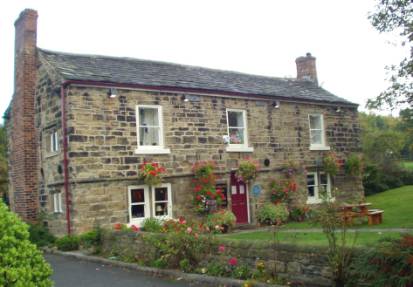
 My G-G-G-G-G-G-G-Grandfather. John, the son of George Esume, was baptized on 17 March 1650 in Crofton, Yorkshire, England - from the Parish register of Crofton.
My G-G-G-G-G-G-G-Grandfather. John, the son of George Esume, was baptized on 17 March 1650 in Crofton, Yorkshire, England - from the Parish register of Crofton.
"John sonne of George Esume Bap: 17 Mar 1649 [Julian calendar]" in CroftonJohn's father died in 1657, when John was only 7 years old. At this point the eldest son, William, who was 20 years older than John, would have become the head of the family, owner of it's lands, and John's guardian. John's mother probably survived until at least 1672.
Crofton was, in the 17th century, predominantly a farming community. John's brothers, William and Edward, were, in their turn, church wardens, meaning they were well respected men, probably prosperous farmers. John, the youngest son, was, as was usual in such situations, given a trade, apprenticed as a carpenter. That may have occurred in 1664 or 1666, when John was 14 to 16 years old, though it may have occurred as late as 1668. He would have remained a carpenter's apprentice for 7 years, becoming a journeyman in about 1673, at the age of 23. As a journeyman he probably continued to work for his old master, sharpening his skills in hopes of one day becoming a master craftsman himself. To do that he would have to pass an exam administered by the carpenter's guild, one of the goals of which was to limit competition for the current masters.
John's eldest brother, William, died in 1678, when John was 28 years old. In the same year John's brother Edward, aged 34, was, for the first time, listed as one of two churchwardens for Crofton, apparently taking William's place. I assume this means he took William's place as head of the family as well. If I've interpreted the records correctly, Edward had an elder brother, George, who had, by 1678, moved to the neighboring village of Wragby. This may have put him out of the running to succeed to William's place in Crofton. In fact, George had probably already received his share of his father's estate in a cash settlement which allowed him to buy the farm in Wragby.
As the youngest son, with limited prospects for inheriting the family farm and years to go before he could think of opening his own shop, there would have been adequate reason for John to seek his fortune outside of Crofton.
I believe that John Esume (Hesom) of Crofton was the John Heesom who settled in the Quaker colony of Burlington, West Jersey, in America, circa 1686.
Why do I think this?I would be happier, however, if George, the name of John's father and elder brother, had been a family name in America, which it was not. Nor was Edward or Richard, more of his brothers, though William was. I would assume that a son would have tried to honor his father, or the brothers who raised him, in this way.
(1) As explained elsewhere, DNA studies show that the Hissem family of America and the Heesom family of East Yorkshire share a common ancestor about 12 generations ago. That would be at about generation (15).
(2) There were no Heesom's living in East Yorkshire in the 17th century, but there was a family living not far to the west in the villages of Crofton, Wragby, and Ackworth.
(3) This family used the Heesom spelling, amongst many other variations, and were the only family of that name in Yorkshire.
(4) The East Yorkshire family can trace their descent with accuracy to (21) Thomas Heesom (1744) of Swanland, which is near Hull, in East Yorkshire. While we don't know who his father was exactly, we do know that his name was also Thomas.
(5) A "Thomas son of Thos Heesom" was baptized on 02 September 1744 in Carlton juxta Snaith, just west of Swanland. His father was (20) Thomas Heesome (1713), of Ackworth. This would make young Thomas the great-grandson of John Esume's elder brother, Edward.
(6) By this descent the two families share a common ancestor at generation (17), with George Hesom, or 10 generations ago.
(7) And finally, if that is not convincing, John Esume/Hesume is the only man of that given name, born in the right period, in approximately the right place to be our John.
When John Heesom appeared in Burlington, New Jersey he had enough money to invest in real estate, including in the region's earliest grist mill. I suspect that John was sent off to America by his brother, Edward, with a small patrimony to ease his way. In Burlington he mixed with the more successful tradesmen and land speculators of the region. I also believe that John could read and write, unlike some of his descendents, since he witnessed several land deals in Burlington.
See John in America, (18) John Heesom (c1650).
Was John a Quaker? He settled in a Quaker colony in America and Quakerism was strong in Northern England. Is it strange that John, the brother of two churchwardens for the Anglican church, should settle in a colony of Quakers, when that religion was so offensive to the Church of England?
The male line of John's eldest brother, William, had died out by 1693. The male line of his next brother, George of Wragby, died out in 1732. The next brother was Edward; his descendants are the surviving line of this family in England. Another brother, Richard, died in infancy.
(18) Jane Heysom (c1654)Jane Heysom married John Marshall on 10 February 1676 in Crofton. A John Marshall later married Francis Astick in Crofton on 8 November 1690. This may indicate an early death for Jane.
(16) John Hisome (1578)John, the son of Raphe Hisome, was baptized on 13 April 1578 at Saint Mary, Barnsley, Yorshire.
(16) John Esum (1580)John, the son of Raphe Esum, was baptized on 22 July 1580 at Saint Mary, Barnsley, Yorshire. He died on 24 July 1580.
(16) John Esume (c1585)
John Esume married Dyones Browne on 19 July 1615 at Saint Mary, Barnsley, Yorshire. Their children were,
(17) Grace Esom (1616)
(17) Raph Esom (1618)
(17) John Esam (1619)
Grace, the daughter of John Esom, was baptized on 8 July 1616 at Saint Mary, Barnsley, Yorkshire, England.
(17) Raph Esom (1618)Raph, the son of John Esam, was baptized on 6 September 1618 at Saint Mary, Barnsley, Yorkshire, England.
(17) John Esam (1619)John, the son of John Esam, was baptized on 13 February 1619 at Saint Mary, Barnsley, Yorkshire, England.
The followig may fit here.
Worsbrough StraysThere is no logical link, except geography, for the following Heesom's. Worsbrough is just south of Barnsley.
(17) Thomas Heesome of Worsbrough (c1620)The following, from the papers of the Verson-Wentworth family of Wentworth castle, relates to the Rockley Hall estate, where Thomas had a close.
27 October 1690. "John Hatfeild of Hatfeild, esquire, and Frances, his wife, administratrix of the goods and chattels of Thomas Westby late of Fursby, deceased, to Thomas Wainwright of Sandall Magna, yeoman. A judgment of £2,520 (and costs) which Thomas Westby obtained in 1656 against Francis Rockley together with half the capital messuage called Rockley Hall with appurtenances, occupied by George Auden, Edward Snowden and William Tingle in Worsbrough, named closes occupied by George Auden in Worsbrough and Stainbrough, Friertayle Wood occupied by Edward Snowden, Robert Froggett and William Tingle, Old Parke Wood occupied by William Ashmore, several closes (named) occupied by Thomas Wood and Thomas Saunderson, a close and Smithy Wood occupied by William Irish, an iron furnace called Rockley Furnace and a close occupied by Dennis Hayford, gentleman, a messuage with named closes occupied by William Irish, a messuage and named closes occupied by Joseph Shawe, a messuage and named closes occupied by James Burnley, named closes occupied by Thomas Heesome, a messuage and named closes occupied by Thomas Wood and Anne Wood, a messuage and named closes occupied by Thomas Wildsmith, a close occupied by Anthony Robinson, a cottage and close occupied by Elizabeth Hawksworth, a water corn mill called Lewden Mill and a close occupied by James Burnley, named closes occupied by Joseph Shaw and James Ownsworth, a messuage and close occupied by William Ashmore and William Guest, half a messuage and half a close occupied by Michael Crookes, two closes occupied by Robert Tottington and several named closes occupied by Toby Holland, all in Worsbrough. The deed recites that the above property of Francis Rockley was valued by a jury at £150 p.a. and delivered to John and Francis Hatfield at that price until Francis Rockley had discharged his debt. For the consideration named in a mortgage deed of even date." - from the "Vernon-Wentworth Muniments, Sheffield Archives"This implies that Thomas was a farmer. Note the references to furnaces, part of the extensive iron-works already existing in the county at this time. I'm not certain if Thomas held his land at the time of the first judgement, in 1656, or the second, in 1690. I think the earlier date is indicated.
| Worsbrough
Worsbrough parish is just south of Barnsley. It is some 3,500 acres in extent and consists of Worsbrough Village, Worsbrough Bridge, Worsbrough Dale, Worsbrough Common, Rockley, Blacker Hill, and Birdwell. The village is separated from the Bridge and the Dale by a small valley through which runs the River Dove, which eventually finds its way into the River Dearne. Rockley HallThe Rockley family of Leeds settled in the valley of the Dearne river soon after the Conquest and had their seat near Worsbrough as early as 1290. Henry Rockley built Rockley Hall, a timber building on the Head Row, in the 14th century. The hall was torn down in the 19th century. A note in "A Genealogical and Heraldic History of the Commoners of Great Britain and Ireland, Enjoying..." by John Burke indicates the family was driven from their estates "by the effects of the civil wars, and by some extraordinary misfortunes which fell upon Francis Rockley, the last male in the eldest line." Francis was the son of Robert Rockely, of Rockley, who died in 1642. Francis was the subject of several judgements for debt. In 1656 a judgment of £2,520 and half of his estate at Rockley Hall was given against him for the debt owed to John Hatfield of Hatfield. "Francis Rockely, of Rockley, 'the unforutnate,' died in 1679. He married for his second wife, Catherine, daughter or sister of Colonel William Gayner, and she remarried James Hacket, esq." - from "Yorkshire Diaries and Autobiographies in the Seventeenth and Eighteenth Centuries." By 1854 Rockley Hall had been demolished. |
 (17) William Heesome of Worsbrough (c1620)
(17) William Heesome of Worsbrough (c1620)"Heesome, William, Worsbrough, linnen weaver, Jan. 28, 23 Chas. II. 3 Mar. 15, 1679." - from "Index of Wills in the York Registry" by Francis Collins and Ely Wilkinson Crossley. Silas Marner, of the eponymous novel, was a linen weaver, living his lonely life.
Thomas Heesome married Jane Ellis on 10 December 1733 in Worsbrough, Yorkshire, England.
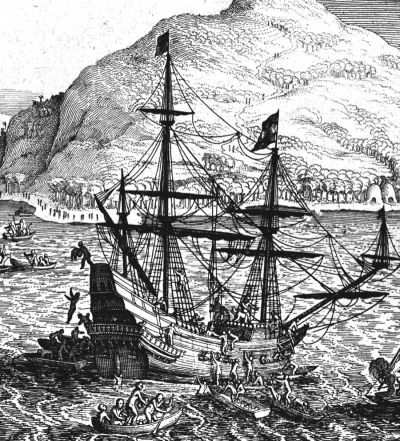 (16) Raphe Esum (1581)
(16) Raphe Esum (1581)Raphe, the son of Raphe Esum, was baptized on 1 January 1581 at Saint Mary, Barnsley, Yorkshire, England. I have a Raphe Hesam who was a sailor with the East India Company, making his second voyage with them in 1614.
Jan. 15. 1614. East Indies Colonial Papers. "Petition of Raphe Hesam and Wm. Warrey, sailors entertained "for this second joint voyage," to have 5l. [pounds] each given them, for which they agree to resign all their right to wages and goods due to them on the purser's books should they die on the voyage, but if they return home, the money was advanced to be freely given them; the Company willing to perform the bargain and to do the same for others who may desire it." - from "Calendar of State Papers"1614 was an early date in the history of the East Indies company, which had only been established in 1600 as a joint stock association of merchants trading in Asia. Visits of the first Company ships, such as those commanded by James Lancaster, were exploratory with a view to establishing connections and obtaining permission for merchants to settle and set up factories (warehouses). Factories were run by a chief factor and a council of factors. If an area was particularly successful a group of factories was established known as settlements and governed by an agent and a council. Settlements might then develop into centres known as presidencies administered by an agent. The first factory established by the Company was at Bantam, with several voyages there taking place between 1604 and 1613. The kingdom of Bantam covered most of western Java and southern Sumatra. The major warehouses of the company were in India, at Surat, Madras, Bombay and Calcutta.
A Ralph Heasome died and was buried on 12 February 1636 in Barnsley, Yorkshire. Could the sailor have returned home to retire after his voyages?
(16) Dorythie Esum (1585)Dorythie, the daughter of Raphe Esum, was christened on 11 July 1585 at Saint Mary, Barnsley, Yorkshire, England. Dorythie Esom [Esum] married Thomas Spiuie [Spivie] on 24 January 1606 at Saint Mary, Barnsley, Yorkshire, England. Thomas, the son of William Spivie (1555) and Elyzabeth Rysforth, was baptized on 22 December 1583 at Saint Mary, Barnsley, Yorkshire.
The Spiviey's were originally from Wakefield and moved to Barnsley about 1563. There are Spivey's living in Barnsley today. The children of Thomas and Dorythie were,
(17) Issabell Spivye (1607), of Barnsley
(17) John Spivie (1610), of Barnsley
(17) Elizabeth Spivye (1613), of Barnsley
(17) Easter [Esther] Spivye (1614), of Barnsley
(17) Thomas Spivye (1617), of Barnsley
(17) George Adolphus Spivey (1622 or 1612), of Barnsley. He immigrated circa 1643 to Lower Norfolk County, Virginia. He was transported by Thomas Der, who was granted 450 acres for transporting nine persons: George Speevy, William Broughton, Robert Leming, Samuel Jeffery, Henry Brown, John Corne, and Elizabeth Tockwood. George married Margaret Matthews. He died circa 1690 in the Virginia colony.
Sara, the daughter of "Ralph Hesum.", was christened on 15 August 1587 at Saint Mary, Barnsley, Yorkshire, England. The period at the end of the name Hesum is interesting. Does this mean it was a contraction? Sara Esam married John Gaunt on 20 July 1609 in Barnsley. Sara Esam died and was buried on 29 March 1611 in Barnsley.
There's a break in the descent here, with no logical father for (19) George Hesome, below.
(19) George Hesome (c1660)
Of Barnsley. His children were,
(20) William Heesom (1680)
(20) Ann Heesom (16803
(20) George Hesome Jr. (1686)
The son of George Heesom. He was christened on 18 September 1680 at Saint Mary, Barnsley, Yorkshire, England.
(20) Ann Heesom (16803The daughter of George Heesom. She was christened on 25 March 1683 at Saint Mary, Barnsley, Yorkshire, England.
(20) George Hesome Jr. (1686)The son of George Hesome, or Hesom. He was christened on 3 December 1686 at Saint Mary, Barnsley, Yorkshire, England.
(19) Sarah Heesome (c1674)She might be the sister of George. She was born in about 1674 in Barnsley. She married Samuel Kershaw on 4 February 1695. This was one of the earliest uses of the double-e spelling of the name in the Yorkshire family.
John Hesome (c1730)John Hesome married Martha Denton on 7 September 1761 at St Mary church, in Barnsley, Yorkshire.
| The Advent of Double-E Spelling in Our Name
While the double-e was used once in the 13th century, in the spelling of the name of Vivian de Heesam, in the modern era the family in Lancaster first used the double-e spelling, in Heesham, in 1629 and, in Heesom, in 1664. Those of Yorkshire first used the spelling, in Heesom, in 1672. Those of Chesire used the spelling, in Heesom, as early as 1552, but more generally starting in 1664. Today we generally accept that double-e ought to be pronounced as a long e, as in sheep, which would align the pronunciation of Heesom with today's Heysham, which is pronounced Hee-sham. However, the Heesom families of both Yorkshire and Cheshire today pronounce the first vowel as either a short e or short i, as in hem or him. Does this mean the names are not related or is there a way to save my theory and explain how this pronunciation change could have occurred? The Great Vowel Shift and the Birth of Modern EnglishThe English language underwent a significant change in the pronunciation of long vowels beginning in the 15th century. The vowel shift began in the time of Chaucer and was mostly complete by the time of Shakespeare. The change occurred quickly enough for people to notice. The English printer, William Caxton, said in 1490 that, "Certainly our language now used varyeth far from that which was used and spoken what I was borne." There are many theories why this change occurred, and why it happened so quickly, but note that early in the 15th century Henry V ordered his chancery to begin using English rather than French or Latin, as they had in the past. The resulting "Chancery Standard" dialect was based on London and East Midland dialects. Every time a language experiences a change in pronunciation there will be some who are quick to adopt the new ways and others who resist them. The most attuned to such change will be the young, the urban and the upwardly mobile if the pronunciation is perceived as a marker of higher-status speakers. Chancery Standard quickly became a dialect no longer tied to a region, but to a class, to education and to wealth. As a result of this shift, today's vowels are articulated higher up and further toward the front of the mouth than they were in earlier times. For instance, the vowel sound of the word feet used to be pronounced like fate; that of sweet like set. More to the point, the sound [ay] in the Medieval pronunciation of Hesham became the [ee] of Heysham. So, today's pronunciation of Heesom in Yorkshire and Cheshire is more similar to Middle English, while that of Heysham aligns with Chancery Standard. Note that the Heysham spelling, which only became common after 1700, can be tied to the rise of Giles, Robert and William Heysham, brothers from Lancaster who relocated to London, became rich merchants and entered Parliament. Did these brothers, social climbers that they were, also introduce upper-class London pronunciation to the name? Modern English- e, which had been pronounced as [ay], became [ee], as in see. - a, which had been pronounced as [ah], became [ ], as in at. Heysham is pronounced something like Hee-sham The effects of the shift were not entirely uniform, and differences in degree of vowel shifting can sometimes be detected in regional dialects both in written and spoken English. In Northern English the long back vowels remained unaffected. As a caution, the North of England is a particular hotspot for linguistic inconsistency and English speakers north of the Humber river preserved the pre-vowel shift pronunciations the longest. |
Halifax is about 30 miles west of Wakefield.
(15) Agnes Haysome (c1550)She was born in Halifax, West Riding, Yorkshire, England. She married William Whittaker on 6 November 1580 in Halifax, Yorkshire, England. She would have been a contemporary of Raphe Hesome of Barnsley and Richard Esom of Royston.
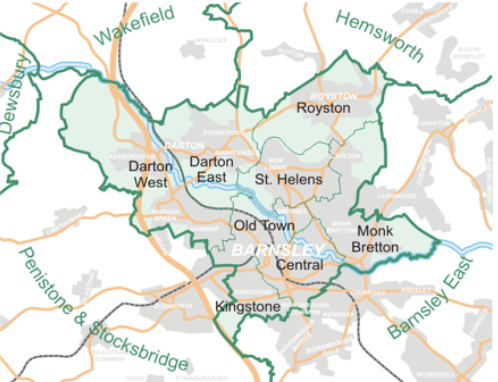 Royston is just a few miles north of Barnsley and is today a suburb of that town. Originally a farming village, in the late 18th century a canal was built which brought the area into the industrial revolution. It had mine, clay and brick works. A coke works is still in operation today.
Royston is just a few miles north of Barnsley and is today a suburb of that town. Originally a farming village, in the late 18th century a canal was built which brought the area into the industrial revolution. It had mine, clay and brick works. A coke works is still in operation today.
The parish church of St John the Baptist was built about the year 1234. The earliest parish records of birth, death and marriage for Royston are dated 1557.
(15) Richard Esom (c1560)Ric. Esom married Mgret. Pey on 13 April 1589 in Royston, Yorkshire, England. Pey might also be rendered as Pye. The following work as Richard's children if we assume his marriage to Margaret was his second.
(16) Thomas Hesome (1580)Thomas Hesome was christened on 16 September 1580 in Royston, Yorkshire, England. No parents were named.
(16) Robert Hesome (1583)Robert Hesome was christened on 13 April 1583 in Royston, Yorkshire, England. No parents were named.
(16) Alice Esome (1591)Alice Esome was baptized on 11 March 1591 in Royston, Yorkshire, England. I also have this as "Alice Hesome was baptized on 11 March 1591 in Royston, Yorkshire."
Later Hesom's of RoystonHere is another break in the descent with no logical father for John and William Hesom, below.
(21) John Hesom of Royston (c1735)
The father of,
(22) Jane Esom (1762), the daughter of John, was baptized on 3 May 1762 in Royston, Yorkshire.
(22) Rose Esom (1764), the daughter of John, was baptized on 11 July 1764 in Royston, Yorkshire.
(22) Mary Hesom (1766), the daughter of John, baptized on 14 November 1766 in Royston, Yorkshire. Mary Hesom married William Littlewood on 4 June 1798 in Royston.
(22) John Esom (1772), the son of John, was baptized on 27 December 1772 in Royston, Yorkshire.<
(22) Richard Esom (1777), the son of John, was baptized on 15 October 1777 in Royston, Yorkshire.
William married Mary Broadhead on 16 December 1765 in Royston. His children were,
(22) Thomas Hesom (1766)
(22) Neddy Esom (1769), the son of William, baptized on 1 June 1769 in Royston, Yorkshire.
(22) Mary Esom (1772), the daughter of William, was baptized on 7 August 1772 in Royston, Yorkshire
Thomas, the son of William Hesom, was baptized on 11 October 1766 in Royston, Yorkshire. He may have maried Jane.
(23) William Hesom of Royston (1791)William, the son of Thomas and Jane Hesom, was baptized on 9 October 1791 in Royston, Yorkshire.
Elizabeth Esum married John Ellice on 29 August 1585 in Barnsley, Yorkshire. She may have been a sister of Raphe and Richard, above,
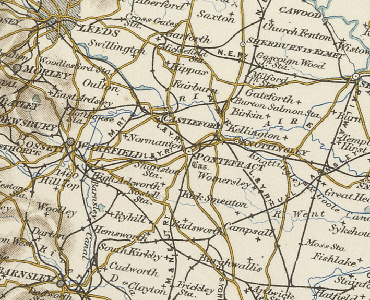 North of the villages of Barnsley, Royston, Crofton and Normanton. It was on the Aire river near where the Calder river joined it.
North of the villages of Barnsley, Royston, Crofton and Normanton. It was on the Aire river near where the Calder river joined it.
(17) Auston Esom (1609)
Auston Esom, the son of Thomas Esom, was baptized on 25 May 1609 at St. Giles and St. Mary church, Pontefract, Yorkshire.
Probably a wife. She died in 1648, so she may have been a generation older than I show. "July 4, 1648. Hesom, Dorothy, Pontefract, fol. 121, Pontefract"- from "Index of Wills in the York Registry."
Thomas Easome married Alice Wright on 27 November 1636 in Pontefract, Yorkshire, England.
(18) Elizabeth Eosome (1637)Elizabeth, the daughter of Thomas Eosome, was baptized on 5 November 1637 in Pontefract, Yorkshire, England.
(18) Dorithie Easome (1642)Dorithie, the daughter of Thomas Easome, was baptized on 8 February 1642 in Pontefract, Yorkshire, England. Pontefract is north of Crofton.
John Heesome (c1800)"Matthew Hutchinson, Pontefract, York, maltster, and John Heesome, of Pontefract, joiner, and Martha Nodder, of Monkhill, as executors and executrix of John Nodder, deceased. Seal. Dec. 8. . ." - from "The Law Advertizer" of 1828.
In the Domesday book as Ferestane, meaning four-stones. The town is located about 2 miles southwest of Pontefract.
(19) George Heesome (c1680)George Heesome married Elizabeth England on 30 November 1706 in Featherstone, Yorkshire. Elizabeth, the wife of George Heesome, died and was buried on 25 February 1717 in Featherstone. Mary, the wife of George Hesom, who died and was buried on 15 September 1744 in Featherstone, Yorkshire. George Hesom died and was buried on 9 September 1745 in Featherstone, Yorkshire. I haven't found any children for George.
(19) William Hesom (c1693)Mary, the wife of William Hesom, was buried on 14 April 1730 in Featherstone, Yorkshire. William Hesom died and was buried on 27 May 1740 in Featherstone, Yorkshire.
(20) Elizabeth Heesom (1723)Elizabeth, the daughter of Willm. Heesom, was christened on 19 March 1723 in Featherstone, Yorkshire. She died and was buried on 29 March 1723 in Featherstone, Yorkshire.
(20) Edward Hesom (c1730)Edward, the son of Will. Hesom, died and was buried on 12 November 1733 in Featherstone, Yorkshire.
(19) John Hesom (c1710)John Hesom married Ann Holland on 30 October 1732 in Featherstone, Yorkshire.
(20) Edward Hesom (c1735)Edward, the son of John Hesom, died and was buried on 22 August 1736 in Featherstone, Yorkshire.
(20) John Hesom (1736)John, the son of John Hesom [or Heson, Hisom], was christened on 5 April 1736 in Featherstone, Yorkshire. John Hesom, aged 32 [1736], died and was buried on 16 November 1768 in Featherstone.
(20) Mary Hesom (1738)Mary, the daughter of John Hesom, was christened on 5 April 1738 in Featherstone, Yorkshire. She died on 21 February 1739 in Featherstone.
(20) William Hesom (1740)William, the son of Jo. Hesom, was christened on 27 July 1740 in Featherstone, Yorkshire. William Hesom married Sarah Atack on 12 April 1772 in Featherstone, Yorkshire.
(20) Ann and Elizabeth Hesom (1743)Ann and Elizabeth, the daughters of Jo. Hesom, were christened on 12 May 1743 in Featherstone, Yorkshire.
(20) Mary HesomMary, the daugthter of John Hesom, died and was buried on 25 February 1739 in Featherstone, Yorkshire.
(20) William Hesom (c1735)Sarah, the 72 year old widow [1734] of William Hesom, died on 18 September 1806 and was buried on 21 September 1806 in Featherstone, Yorkshire.
(20) Unknown Hesom'sThere are two unknown Hisom's buried in Featherstone, one in 1740 and the other in 1742.
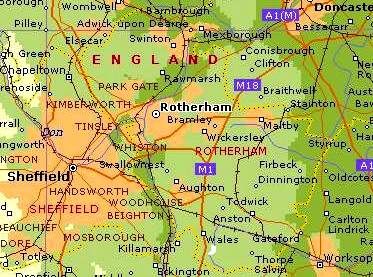 Rotherham lies on the river Don, just six miles from the Sheffield city center. Wath in 5 miles north of Rotherham, on the river Dearne. Whiston is a village lying between Rotherham and Sheffield. Broom, or Broome, is in the parish of Whiston, about a mile southeast of Rotherham.
Rotherham lies on the river Don, just six miles from the Sheffield city center. Wath in 5 miles north of Rotherham, on the river Dearne. Whiston is a village lying between Rotherham and Sheffield. Broom, or Broome, is in the parish of Whiston, about a mile southeast of Rotherham.
"Matthias Ledgiard, house painter, & Martha Heesome, both of R[otherham] 14 Aug. [1727]" - from "Yorkshire Marriage Registers, West Riding."
Richard Hesom (1720)Of Wath-upon-Dearne. "Richard Hesom & Sarah Armstead" were married on 5 December 1751 in Wath-upon-Dearne, Yorkshire. - from the Parish Register of Wath.
Elizabeth Heesom (c1800)Joseph Kitson married "Eliz. Heesom [signs 'Hosom'] 13 Oct." in Rotherham 1822 - from Rotherham Marriages 1798 to 1837, "Yorkshire Marriage Registers, West Riding."
William Heesom (c1840)Of Broom. "Rotherham Polling District, Whiston Township, . . . Heesom, William, Broom " - from "West-Riding Election. The Poll for Two Knights of the Shire" of 1841.
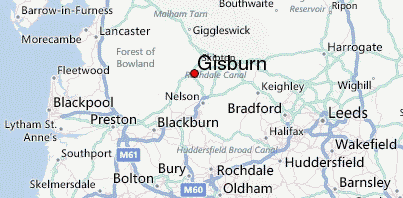 (17) Katherina Heesom (c1610)
(17) Katherina Heesom (c1610)
Katherina Heesom married Thomas Lawkeland on 20 August 1629 at St. Mary's church, in Gisburn, Yorkshire, England. Gisburn is located on the Ribble river, just east of the Forest of Bowland, at the western end of the Aire Gap. It would be a good stopping off point if you had gone south around Bowland Forest enroute to the Aire Gap and into Leeds and Wakefield. It is now part of Lancashire. It is about 30 miles southeast of Heysham.
I do have a Katheren Heisam, the daughter of Johannis Heisam, who was born on 13 February 1610 in Halton, Lancashire. If the bride was a little older, I have a Catherine Heisham, the daughter of Nicholas Heisham, who was born on 7 August 1598 in Caton, Lancashire.
Thomas Lawkeland, the son of Thome Lawkeland, was baptized on 15 April 1590 at St. Mary's church, in Gisburn. However, I believe this child died young. Another Thomas Lawkeland, also the son of Thome Lawkeland, was baptized on 18 February 1599 in Gisburn.
Thomas Lawkeland died and was buried on 30 December 1643 at St. Mary's church, in Gisburn. His father, Thomas Lawkeland Sr., had died in 1630.
